Annual Report 2016-2017
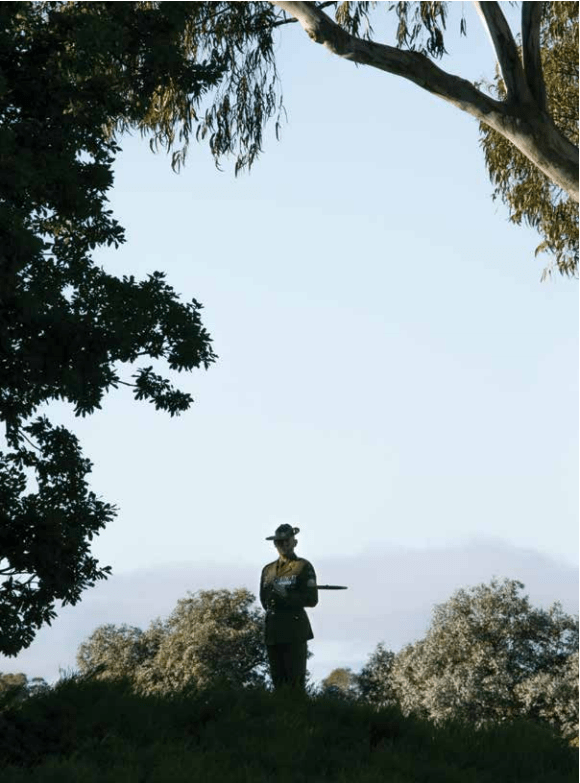
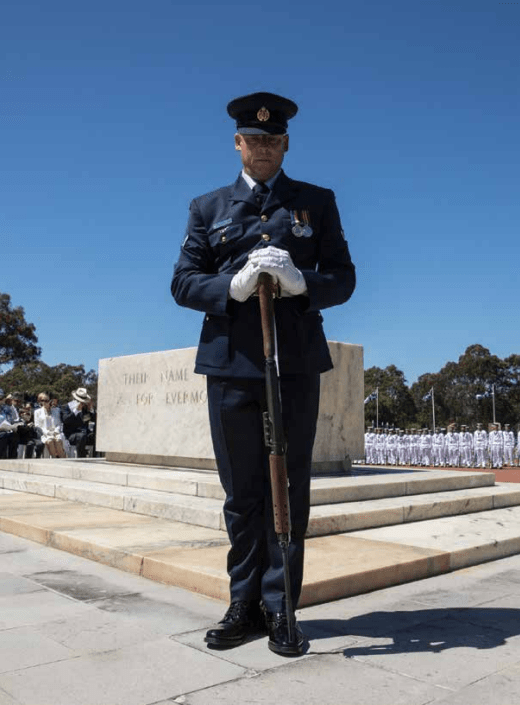
Contents
- TABLE OF CONTENTS
- INTRODUCTION TO THE REPORT
- HIGHLIGHTS
- GOVERNANCE
- Chairman’s Address
- GOVERNANCE STRUCTURE
- Council of the Memorial
- Council performance
- Council Committee membership 1
- Council performance
- Finance, Audit and Compliance Committee (FACC)
- Finance, Audit, and Compliance Committee membership
- Remuneration Committee
- Remuneration Committee membership
- Roll of Honour Committee
- Roll of Honour Committee Membership
- Council of the Memorial
- CORPORATE OPERATIONS
- Director’s Address
- CORPORATE SUMMARY
- Purpose
- Mission
- Vision
- Values
- Planning and Reporting Framework
- Location
- Organisation Chart and senior staff
- Branch Descriptions
- National Collection
- Public Programs
- Corporate Services
- SPOTLIGHT
- ANNUL PERFORMANCE STATEMENTS
- Outcome and Outputs Structure
- Overall performance against the outcome
- Commemoration performance indicator
- Accessibility performance indicator
- Knowledge and understanding performance indicator
- Program Component 1.1 – Commemorative Ceremonies
- Program Component 1.2 – The National Memorial and Grounds
- Program Component 1.3 – The National Collection
- Program Component 1.4 – Exhibitions
- Program Component 1.5 – Interpretive Services
- Program Component 1.6 – Promotion and Community Services
- Program Component 1.7 – Research, Information and Dissemination
- Program Component 1.8 – Visitor Services
- Program Component 1.9 – Corporate Governance
- Program Component 1.10 – Executive Strategic Management
- Program Component 1.11 – Resource Management
- Program Component 1.12 – Revenue Generation
- Program Component 1.13 – Team Management
- LEGISLATIVE FRAMEWORK AND EXTERNAL SCRUTINY
- Enabling legislation
- Functions and powers of the Memorial
- Effects of ministerial directions
- Responsible minister
- Internal and external audits
- Indemnities and insurance premiums
- Legal actions
- Ombudsman
- Social justice and equity
- Advertising and market research expenditure
- Freedom of Information
- Energy consumption and environmental management
- Workplace health and safety
- PART 6 – ANNUAL FINANCIAL STATEMENTS
- Report by the Auditor-General
- Annual Financial Statements
- PART 7 – APPENDICES
- Appendix 1 – Council profiles
- Appendix 2 – Senior staff profiles
- Appendix 3 – Selected VIP visits, events, and ceremonies
- Appendix 4 – Staff lectures and publications
- GLOSSARY
- COMPLIANCE INDEX
- INDEX
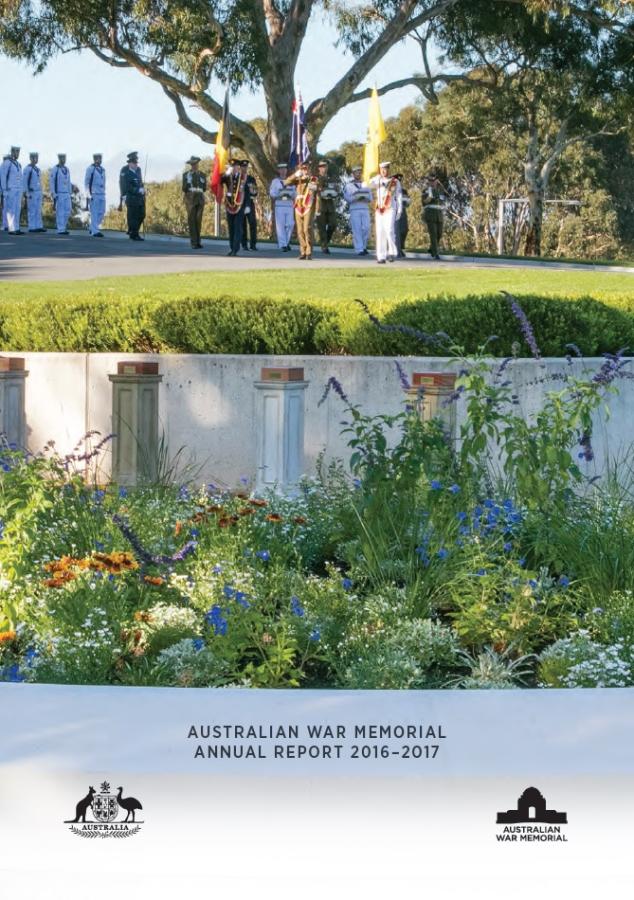
Australian War Memorial Annual Report 2016–2017
Annual report for the year ended 30 June 2017, together with the financial statements and the report of the Auditor-General
Copyright © Australian War Memorial
ISSN 1441 4198
This work is copyright. Apart from any use as permitted under the Copyright Act 1968, no part may be reproduced, copied, scanned, stored in a retrieval system, recorded, or transmitted in any form or by any means without the prior written permission of the publisher.
NOTE: Readers of Aboriginal and Torres Strait Island descent are warned that this publication may contain images of deceased Indigenous people.
For enquiries regarding this report, please contact:
The Executive Officer
Corporate Services
Australian War Memorial
GPO Box 345
Canberra ACT 2601
Phone: (02) 6243 4290
Email: executive@awm.gov.au
A copy of this report can be found on the Memorial’s website at www.awm.gov.au/about/organisation/corporate
Cover and title: Flanders Memorial Garden Dedication
Australian War Memorial
GPO Box 345
Canberra, ACT 2601
Australia
www.awm.gov.au
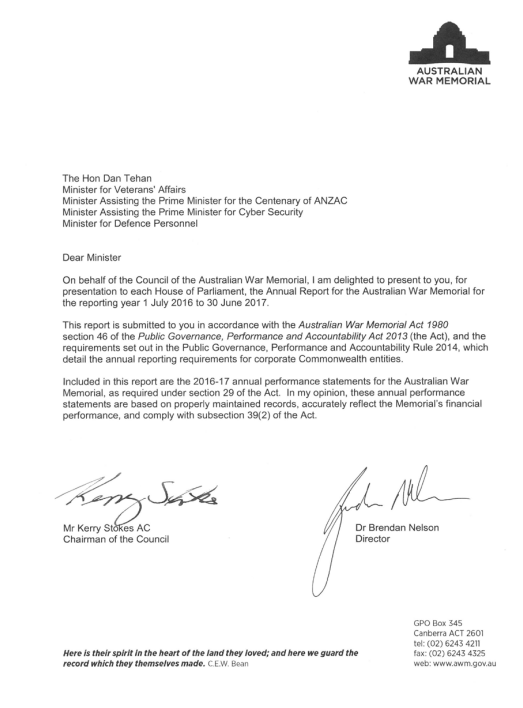
Introduction to the Report
The Annual Report of the Australian War Memorial for the year ended 30 June 2017 was produced in the format for an annual report for a corporate Commonwealth entity under the Public Governance, Performance and Accountability Act 2013 (the PGPA Act).
To assist entities to understand and comply with their obligations under the PGPA Act, the Department of Finance has issued the Public Governance, Performance and Accountability Rule 2014 (the Rules), and Resource Management Guide (RMG) No. 136 Annual reports for corporate Commonwealth entities. The following report is prepared in accordance with the Act, the Rules and RMG 136.
In keeping with the intention of these documents, this report aims to provide a report into the operations of the Australian War Memorial, providing clear linkages between its Portfolio Budget Statements, Corporate Plan, and day-to-day operations.
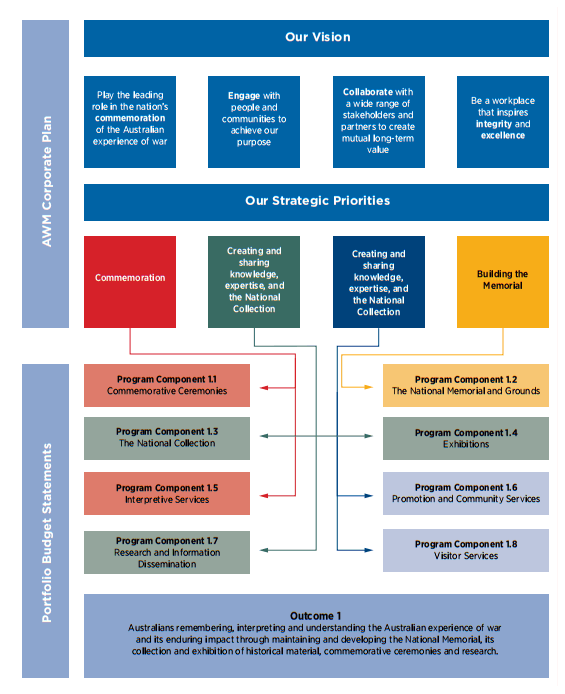
In support of these program components, the Memorial has determined a suite of internal objectives:
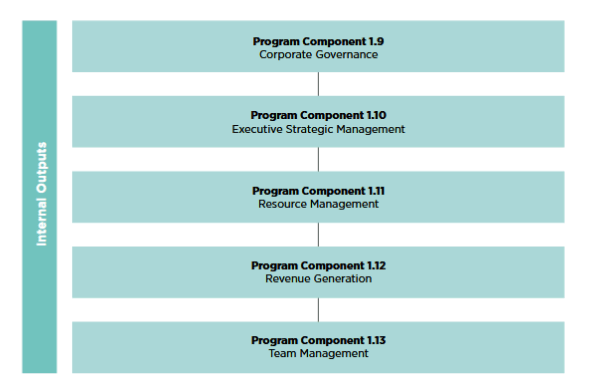
This report is organised into seven part
PART ONE
Governance includes the Chair’s Address and details of the Council, its operations and performance
PART TWO
Corporate Operations includes the Director’s Address and overview of the Memorial’s performance during 2016–17.
PART THREE
Corporate Summary provides information on the structure and reporting framework of the Memorial.
PART FOUR
Annual Performance Statements details the Memorial’s performance information against the Memorial’s outcome and against external and internal outputs.
PART FIVE
Legislative Framework and External Scrutiny provides detailed information about the Memorial as required for reporting.
PART SIX
Financial Statements includes the report by the Auditor-General and Financial Statements
PART SEVEN
Appendices provide additional information about the memorial, including staff profiles, collection acquisitions and disposals, and major sponsors.
HIGHLIGHTS THE YEAR AT A GLANCE
VISITORS
Almost 1.12 million visitors came to the Memorial, its storage facility in Mitchell, and its touring exhibitions
1.10 million visitors to the Memorial and the storage facility in Mitchell
14,454 to touring exhibitions
145,927 school students and accompanying adults visited the Memorial
More than 19,840 visitors attended Memorial public programs, facilitated programs, and special events
Daily, at least 12 free highlight tours were conducted by voluntary guides
Media coverage to an audience of more than 36.1 million during the Remembrance Day period and more than 24.4 million during the Anzac Day period
More than 300,600 visitors made their first visit to the Memorial
STRONG ATTENDANCE AT CEREMONIES
143,016 at Last Post ceremonies
38,000 at the Anzac Day Dawn Service
7,000 at the Anzac Day National Ceremony
RESEARCH AND ONLINE ACCESS
More than 5.6 million visits to the website
Almost 100,000 followers on Facebook
Over 3.4 million Flickr views
COLLECTION
More than 45,800 visitors to the Reading Room accessed 15,549 collection items
15,757 research enquiries answered
More than 426,930 National Collection items can be accessed via online public databases
EDUCATION
Memorial Boxes loaned to 377 schools and community groups across the country and used by more than 45,000 students
6,747 students participated in school wreathlaying ceremonies
Professional development sessions provided to 70 school teachers and librarians, representatives of other cultural institutions, and tourism industry professionals
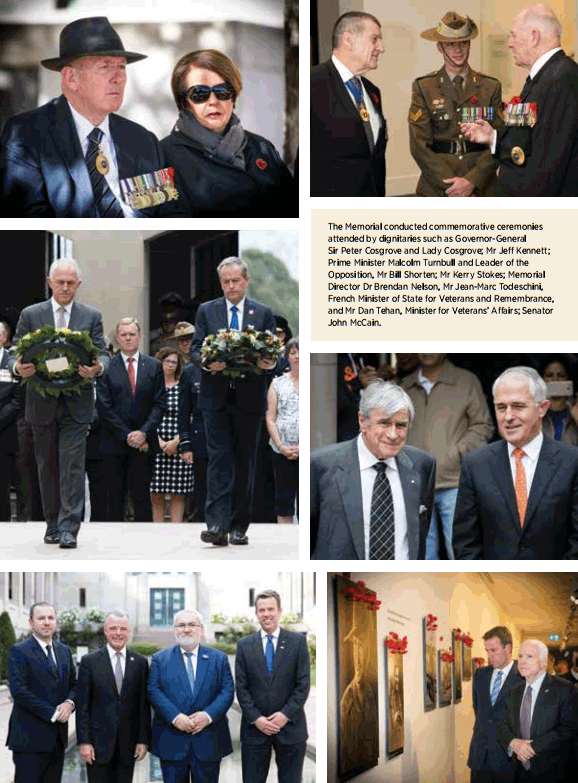
Governance
CHAIRMAN’S ADDRESS
The profile and place of the Australian War Memorial in Australian life goes from strength to strength. Its embrace by Australians from all backgrounds, of all ages, and from all parts of the nation is perhaps the most rewarding aspect of the work of Council members, staff, and volunteers.
On a crisp and clear Canberra morning on 4 April, I was privileged to participate with other Council members in the dedication of the Flanders Memorial Garden in the Memorial grounds. We watched with quiet reverence as sacred soil from Flanders was mixed with soil from significant locations and military heritage sites from each Australian state and territory and placed in the garden. This important ceremony was a fitting and solemn tribute to the men of the Australian Imperial Force who lost their lives or became casualties in the fighting around Passchendaele in 1917. The previous evening, the sacred soil had been marched past the names listed on the First World War Roll of Honour by Australia’s Federation Guard and placed in the Hall of Memory, adjacent to the Tomb of the Unknown Australian Soldier.
The Australian War Memorial safeguards the memory of those who served and died, and whose sacrifice defines what it means to be Australian. The Flanders Memorial Garden ceremonies demonstrated the continuing importance of the Memorial’s role as the soul of our nation, and the national place for commemorating Australia’s experience of war.
As the Memorial reached its 75th year, Council focused on ensuring that the stories of the last 100 years were told and that those of the next 100 years could be realised.
The centenary of the First World War is a priority for Council, with one of the most important initiatives being the delivery of the Spirit of Anzac Centenary Experience. Touring Australia, with the support of the Department of Veterans’ Affairs, the Commonwealth Bank, and Telstra, SACE reached 23 locations and more than 368,016 people across the country. The connection to our history and culture felt by the visitors was evident from the many glowing expressions of appreciation the Memorial received from each local community.
The reach of our commemorations of Australian sacrifice extended internationally with the loan of the Menin Gate lions to the City of Ieper. The dedication ceremony of the lions at the Menin Gate on the eve of Anzac Day reinforced the enduring relationship between Australia and Belgium, and in particular the people of Flanders, because of our shared history as allies in the First World War, and the extent of sacrifice in the Third Battle of Ypres in 1917.
As we move towards the end of the centenary period, the Memorial is focused on ensuring Remembrance Day 2018 presents an opportunity for Australians to remember and reflect on the Armistice and all that came before it – to remember the 62,000 lives that were lost during the First World War.
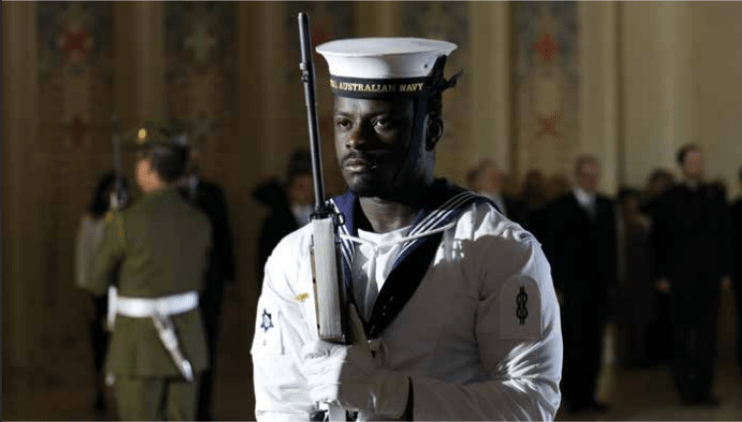
Looking to the future, it is essential that the Memorial offers past and present service personnel and their families and friends a place to reflect on their service and sacrifice, today – they should not have to wait a generation to see their stories told. Every member of Council is committed to ensuring we honour their service, preserve their heritage, and tell the stories of our Australian forces in accordance with Charles Bean’s vision for a world-class memorial, museum, and archive.
Council has a bold plan for the Memorial’s long-term future, to ensure it can continue to deliver on its mission and purpose, and we welcome the government’s approval in the May budget of funding for a business case to allow us to continue telling the stories of those who have served.
The redevelopment concept will see increased and improved exhibition space, collection storage, and visitor amenities, as well as new galleries, an education centre for school visitors, a larger theatre, orientation space, and room for large technology from contemporary conflicts and operations.
Council is committed to the development of the Memorial’s long-term collection storage needs at Mitchell. Development of the Mitchell site enables the Memorial to collect significant artefacts from a generation of service as the Australian Defence Force replaces its technology on land, sea, and in the air. This investment will safeguard our priceless National Collection, and ensure that the stories of our current serving personnel and veterans are preserved and can be told.
During the 2016–17 financial year, Council oversaw the Memorial’s advancement of its strategic purpose and direction as outlined in the Corporate Plan.
We have seen developments in the digital arena as we move to ensure the Memorial’s stories are accessible to every Australian, and are internationally available. Council approved the Digital Engagement Strategy in November 2016 and has been pleased to see the popular and moving Last Post Ceremony broadcast daily to up to 200,000 viewers.
The launch of the For Country, for Nation exhibition in September 2016 was an opportunity for all Memorial visitors o hear the stories of service and sacrifice of Aboriginal and Torres Strait Islander peoples told in their own voices. This reflects the Memorial’s commitment to reconciliation through its Reconciliation Action Plan, and work done over the last decade and more to identify Aboriginal and Torres Strait Islander service personnel whose stories have not been told.
Three important official history projects have progressed over the past 12 months. Volume V, The good neighbour: Australian peace support operations in the Pacific Islands, 1980–2006 of the Official history of Australian peacekeeping, humanitarian and post-Cold War operations, was officially launched on 5 July 2016 by the Hon. John Howard OM AC at the Australian War Memorial.
The official histories of East Timor, Iraq and Afghanistan project is underway, and will document the history of Australia’s involvement in recent conflicts.
The Memorial has commissioned a history of the medical legacies from the Vietnam War, which will document medical issues, both physical and psychological, related to this conflict.
Through the Memorial’s focus on public engagement and outreach, the past year has seen continued interest in commemorating the sacrifice of those Australians who have served, with strong attendance at the national ceremonies of Anzac Day and Remembrance Day.
Continued engagement, support, and recognition of serving personnel and veterans is essential in allowing us to properly tell their stories.
From 16–18 August 2016, the Memorial shared a significant milestone with Vietnam veterans, helping them to commemorate the 50th anniversary of the battle of Long Tan and Vietnam Veterans Day. Over these two days one of the most special events was a private performance given by John chumann of his iconic song, I was only 19, to the veterans in the Hall of Memory.
A personal highlight of the year was the opportunity for me to meet our Memorial volunteers at their annual meeting in November 2016. The Australian War Memorial is blessed to have these many selfless men and women who volunteer their time to ensure this wonderful institution remains relevant to each and every Australian.
On behalf of Council I want to thank retiring Council member, Ms Jillian Segal AM, for her service as Chair of the Council’s Finance, Audit and Compliance Committee.
The Council has welcomed Ms Margaret Jackson AC, who has been appointed for a three-year term from June 2017, and we were pleased to see the reappointment of longstanding member, Mr Les Carlyon AC, who has received a further three-year term on Council, also from June 2017. I was also honoured to accept a further three-year appointment.
Council also gratefully acknowledges the three service chiefs (ex officio): Vice Admiral Tim Barret AO CSC RAN; Lieutenant General Angus Campbell AO DSC; and Air Marshal Leo Davies AO CSC for their contribution to Council. Their steadfast support to the Memorial is generously given and very much appreciated.
Finally, Council would like to thank the Memorial management, Leanne Patterson, Anne Bennie, Tim Sullivan, and Brendan Nelson. In an environment of fiscal restraint and challenge, they continually prove their dedication to the Memorial and their professionalism. I would also like to thank the staff of the Memorial and the information officers who volunteer their time. Their tireless efforts and dedication to this wonderful Memorial is truly inspiring.
Mr Kerry Stokes AC
Chairman
Mr Kerry Stokes, Chairman of the Council of the Memorial, and Ms Anita Herczegh attend a Last Post Ceremony commemorating Lance Corporal Luke Nathan Gavin.
Mr Lee Hsien Loong, Prime Minister of the Republic of Singapore, and Mrs Lee Helen Loong visit the Australian War Memorial escorted by Dr Brendan Nelson and Mr Kerry Stokes.
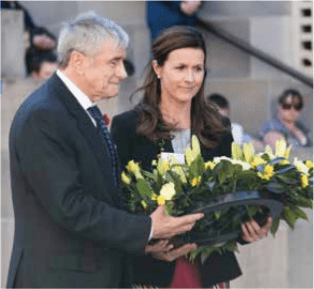
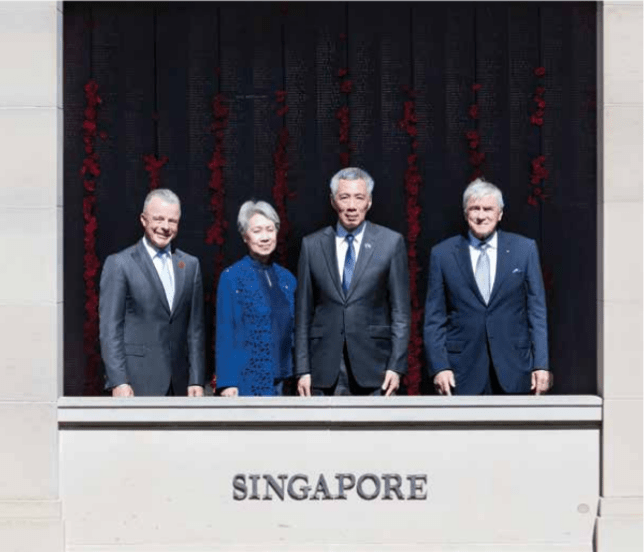
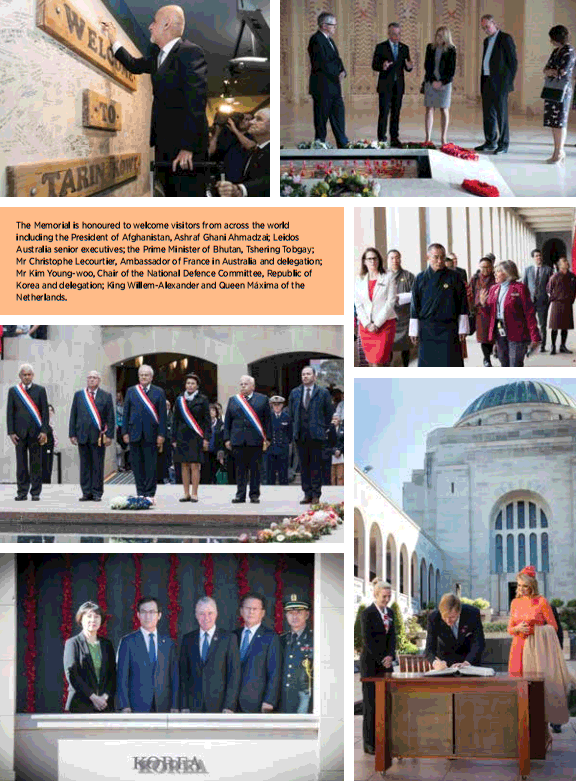
Governance Structure
The Australian War Memorial was established as a statutory authority under, and draws its authority from, the Australian War Memorial Act 1980 (the Act). The Act allows for the appointment of a Council and a Director as Chief Executive Officer of the Memorial.
The performance of the Memorial and the accountability of its Council and management are subject to the Public Governance, Performance and Accountability Act 2013, which imposes key reporting, financial, and pecuniary obligations on the Memorial and its Council members. Many of these are modelled on provisions which apply under corporations’ law, particularly those for directors.
The Memorial is subject to other acts that bear on its operation, and is accountable to the government through the Minister for Veterans’ Affairs. It has a strong link to the Department of Finance for budgetary processes, appropriations, grants, and financial management processes, and it follows the advice and guidance provided by the Australian National Audit Office (ANAO). The Memorial adheres to Australian accounting standards in the preparation of its financial reports and follows best practice in its financial management.
COUNCIL OF THE MEMORIAL
The Council of the Australian War Memorial is established by section 9 of the Act.
The Council is responsible for the conduct and control of the affairs of the Memorial, and the policy of the Memorial with respect to any matters as determined by the Council. In particular, the Council:
- establishes the strategic direction and vision of the Memorial
- approves the goals and key objectives of the Memorial
- approves the annual budget and monitors expenditure and financial reporting, including for major projects
- ensures agreed corporate objectives are met
- adopts a strategic plan, which includes a business plan with objectives and key reporting measures
- ensures the Memorial has adequate financial resources to meet known and planned future commitments
- ensures that systems, processes, and internal controls are in place for effective management and monitoring of the principal risks to which the Memorial is exposed
- ensures that satisfactory procedures are in place for auditing the Memorial’s financial affairs and that the scope of internal and external audit is adequate

- ensures decisions made are consistent with the ethos of the Memorial
- ensures that the Memorial communicates effectively with the public and key stakeholder
- monitors and evaluates the performance of the Direct
Council performance
Council reviews its performance at least once a year in terms of the achievement of targets associated with the outputs specified in the Business Plan. A report on Council activities is included under Internal Output 1.9, on .
New Council members are expected to undertake orientation training before attending a Council meeting, and all are provided with a manual outlining the functioning of the Council in terms of applicable acts and members’ responsibilities.
Section 18 of the Act empowers Council to constitute committees to assist Council in the execution of its functions and responsibilities. Accordingly, Council has established three Committees: the Finance, Audit and Compliance Committee (FACC); the Remuneration Committee; and the Roll of Honour Committee.
Council Committee membership
The Chief of Navy, the Chief of Army, and the Chief of Air Force (ex officio members of Council) are usually not formally Committee members, but are invited to attend all Standing Committee meetings other than Remuneration.
Council membership
| Attended | ||
|---|---|---|
| Chair Members: | Mr Kerry Stokes AC | 4 |
| Vice Admiral Tim Barrett AO CSC RAN | 3 | |
| Wing Commander Sharon Bown (Retd) | 3 | |
| Lieutenant General Angus Campbell AO DSC | 3 | |
| Mr Les Carlyon AC | 4 | |
| Brigadier Alison Creagh CSC (Retd) | 4 | |
| Air Marshal Leo Davies AO CSC | 3 | |
| Rear Admiral Ken Doolan AO RAN (Retd) | 4 | |
| Ms Margaret Jackson AC | 0 | |
| Corporal Daniel Keighran VC | 3 | |
| Mr James McMahon DSC DSM | 4 | |
| Major General A. Greg Melick AO RFD FANZCN SC | 4 | |
| Ms Jillian Segal AM | 4 | |
| Mrs Josephine Stone AM | 4 |
Outgoing members
Ms Jillian Segal AM – term concluded 18 June 201
Incoming members
Ms Margaret Jackson AC – appointed 27 June 2017
Profiles of Council Members can be found in Appendix 1.
FINANCE, AUDIT AND COMPLIANCE COMMITTEE (FACC)
Constituted by a mix of Council members and independent members, the Finance, Audit and Compliance Committee (FACC) is established as an advisory committee to provide independent assurance and advice to Council on:
- the Memorial’s risk, control, and compliance framework
- finance statement responsibilities
- legislative and policy compliance
- internal and external audit activities
- To assist FACC in its responsibilities, the following sub-committees are established:
- Audit and Risk Sub-committee
- Finance and Budget Sub-committee
Finance, Audit, and Compliance Committee membership
| Attended | ||
|---|---|---|
| Chair Members: | Ms Jillian Segal AM | 4 |
| Brigadier Alison Creagh CSC (Retd) | 4 | |
| Mr James McMahon DSC DSM | 4 | |
| Major General A. Greg Melick AO RFD FANZCN SC | 4 | |
| Mrs Josephine Stone A | 4 | |
| Guests: | Dr Brendan Nelson AO, Director, Australian War Memorial | |
| Ms Leanne Patterson, Assistant Director, Corporate Services, Chief Finance Officer | ||
| Mr Kerry Stokes AC | ||
| Wing Commander Sharon Bown (Retd) | ||
| Mr Matthew Broadfoot – Independent member |
Other invited guests for relevant portions of the meeting
Representatives from Australian National Audit Office
Representatives from Internal Audit (PricewaterhouseCoopers)
REMUNERATION COMMITTEE
Constituted wholly by members of Council, the Remuneration Committee is established to:
- on behalf of Council, agree annually on the measures for and undertake appraisal of the performance of the Memorial’s Director.
- communicate as necessary with the Remuneration Tribunal in relation to the remuneration arrangement for the Director.
- consider and pursue other matters as referred by Council in relation to the remuneration and other conditions of service for the Director or other senior managers of the Memorial.
REMUNERATION COMMITTEE MEMBERSHIP
| Attended | ||
|---|---|---|
| Chair Members: | Mr Kerry Stokes AC | 1 |
| Brigadier Alison Creagh CSC (Retd) | 1 | |
| Major General A. Greg Melick AO RFD FANZCN SC | 1 | |
| Mr James McMahon DSC DSM | 1 | |
| Mrs Josephine Stone AM | 1 |
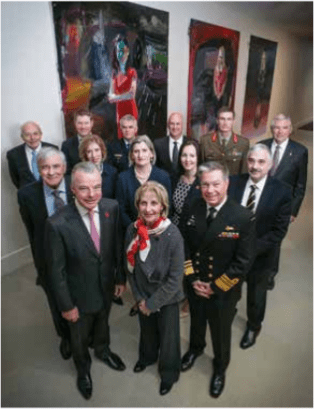
ROLL OF HONOUR COMMITTEE
Constituted by members of Council and augmented by the inclusion of Bruce Legge CSC, RAN, and with Professor Alexander McFarlane as Advisor, the Roll of Honour Committee is established as an advisory committee to research, establish policy, and provide recommendations to Council on:
- whether members of the Australian Defence Force (ADF), whose deaths have resulted from suicide following deployment on operational service, be included on the Roll of Honour
- alternatives for recognition if these personnel are not to be included on the Roll of Honour.
ROLL OF HONOUR COMMITTEE MEMBERSHIP
| Attended | ||
|---|---|---|
| Chair: | Major General A. Greg Melick AO RFD FANZCN SC | 1 |
| Members: | Wing Commander Sharon Bown (Retd) | 1 |
| Corporal Daniel Keighran VC | 1 | |
| Mrs Josephine Stone AM | 1 |
Biographies of Council and committee members can be found in Appendix 1.
Council of the Australian War Memorial: Front Row (L-R) Dr Brendan Nelson AO (Director), Ms Jillian Segal AM, Vice Admiral Tim Barrett AO CSC RAN; Second Row (L-R) Mr Kerry Stokes AC (Council Chairman), Brigadier Alison Creagh CSC, Mrs Josephine Stone AM, Wing Commander Sharon Bown (Ret’d), Major General Greg Melick AO RFD FANZCN SC; Back Row (L-R) Mr Les Carlyon AC, Corporal Dan Keighran VC, Air Vice-Marshal Gavin Turnbull AM (representing ir Marshal Leo Davies AO CSC (Chief of Air Force)), Mr James McMahon DSC DSM, Lieutenant General Angus Campbell AO DSC, Read Admiral Ken Doolan AO RAN (Ret’d).
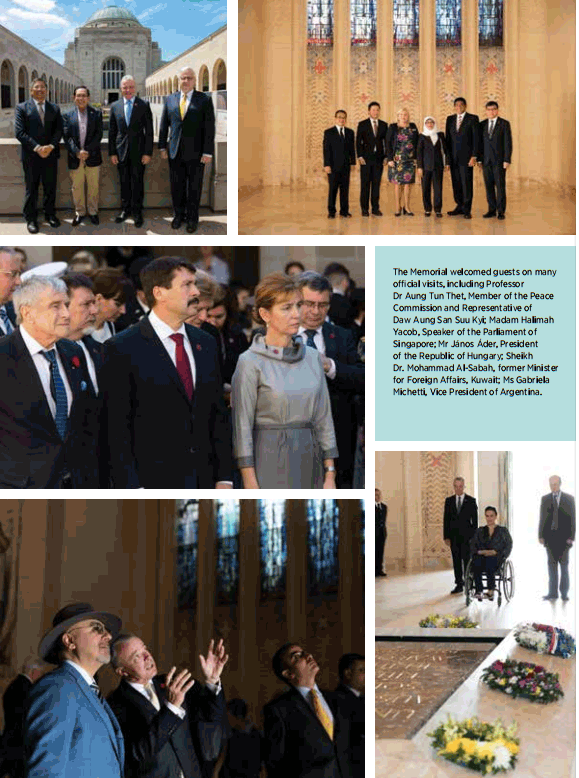
Corporate Operations
DIRECTOR’S ADDRESS
In July 1916, during the bloody fighting around Pozières a mortally wounded Australian soldier asked Australia’s officialFirst World War Historian Charles Bean a simple but importantquestion:
“Will they remember me in Australia?”
Those words would inspire Bean to conceive the Australian War Memorial and resolve that at the war’s end he would build the finest museum and memorial to the men of the Australian Imperial Force and nurses, an ambition he achieved when the Memorial was officially opened on Remembrance Day 1941.
In 2016–17, as we marked the 75th anniversary of that opening, we continued to keep Bean’s promise to remember that digger and his mates. One hundred years on from that terrible battle at Pozières, on 23 July 2016, we told the story of one of those killed there, Captain Ivor Margetts, at the Memorial’s daily Last Post Ceremony.
The hundreds in attendance, including His Excellency Mr Christophe Lecourtier, French Ambassador to Australia, and Her Excellency Mrs Menna Rawlings CMG, British High Commissioner to Australia, listened raptly as Australian Army Warrant Officer Class One Joanne Davey told Margetts’s story.
Importantly she shared more with the audience than simply Margetts’s time on the battlefield.
Through the diligent efforts of the Memorial’s Military History and Last Post Ceremony teams Warrant Officer Davey was able to share with them his life before the war - his football prowess, his studies at Hobart University, and his work as a teacher at Hutchins School in his home state of Tasmania– and to bring him to life as someone we can understand and know today, one hundred years on and living in a vastly different world.
I am sure that the unknown digger who inspired Bean’s vision of the Memorial would be comforted by the knowledge that we do remember him and his comrades. I am certain too that he would particularly appreciate that we remember them not as faceless individuals or simply names on a wall, but as men and women with loved ones, friends, family, and a life given for us, our freedoms, and in the hope of a better future.
No doubt Charles Bean would also be proud that his idea, conceived on the battlefield where Margetts and so many others died, has grown into a world renowned institution and a place of national pilgrimage for Australians of all ages and backgrounds.
In celebrating our 75th year the Memorial has undertaken a number of important and powerful initiatives. In September 2016 we officially opened For Country, for Nation, an exhibition dedicated to Indigenous Australians and their service to this country.
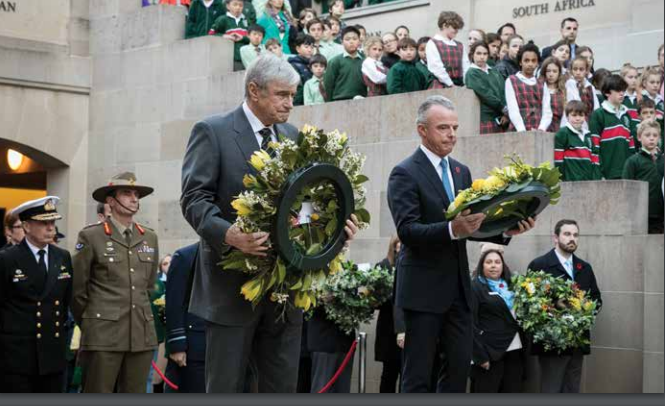
Created with the assistance of the Memorial’s Elders and Knowledge Holder Guidance Group and featuring works by Indigenous and Torres Strait veterans and artists For Country, for Nation tells the stories of the more than 7,600 Indigenous Australians to have served in war and on operations over the last hundred years.
The Memorial has worked hard to recognise these men and women who, just four or five generations after the First Fleet arrived, living in a desperately unequal Australia, not allowed to enlist to fight for the young country that had taken so much from their people, denied their own aboriginality to sign up and defend it. They found in the Australian Imperial Force, many for the very first time, a sense of equality. And then, having served, returned to desperate social inequality which to a large degree continued to exist through to and including the Second World War.
The recognition of Indigenous service has also been strengthened throughout the year by the acquisition of several important Indigenous paintings, notably Rover Thomas’s Ruby River Massacre 1 and Queenie McKenzie’s Horso Creek Killings, both of which provide much needed context for the service of subsequent generations of Aboriginal and Torres Strait Islanders.
For Country, for Nation remains on display until September 2017 when a new exhibition focusing on Australia’s elite special forces, from the Second World War Z force to today’s SAS and commandos, is opened.
The Memorial also conducted many important commemorative events throughout the financial year 2016–17. Prime amongst them were Remembrance Day 2016, the 75th anniversary of the opening of the Memorial, Anzac Day 2017, and the dedication of the Flanders Memorial Garden.
Remembrance Day saw 3,700 attendees, including the Governor-General and Prime Minister, gather to mark the anniversary of the end of the First World War. The Honourable Jeff Kennett AC, himself a national serviceman in the 1960s, gave the commemorative address focusing on the critical issue of taking care of our veterans after they have returned home.
On the evening of Remembrance Day 2016 the Memorial held a dinner to mark its 75th anniversary. The Honourable Kim Beazley AC delivered an address on the history and the place of the Memorial. He opened with the famed words of the funeral oration given by the Greek general Pericles for his fallen men:
“They gave their lives. For that public gift they received a praise which never ages and a tomb most glorious – not so much the tomb in which they lie; but that in which their fame survives, to be remembered for ever when occasion comes for word and deed…”
These words were first used on the Memorial’s stationery, including certificates given to those making donations to the Memorial during its construction, in the 1930s. Those words remain as true today as they did 75 years ago.
“We, as a country, owe our veterans the best possible care in return for their willingness to lay down their lives for our country and our freedoms.”
The Memorial also proudly conferred Fellowship status on three highly deserving individuals at the 2016 Dinner– Rear Admiral Ken Doolan AO RAN (Retd), Mr Lee Kernaghan OAM, and Mr Garth Porter.
The Memorial is grateful for their efforts on our behalf and to Mr Kennett and Mr Beazley for their generous words on what was a very important day in the Memorial’s history.
On Anzac Day 2017 too those in attendance were privileged to hear a speech, of a very different kind, but also of the highest calibre, as Sapper Curtis McGrath OAM, Afghanistan veteran and Paralympian, told of his own experiences as an army combat engineer.
An audience of over 38,000 stood in the dark, doing their best to ignore the cold and light rain, as Sapper McGrath shared with them the experience of losing his legs to an IED blast and the importance of the quality of the care he received to his recovery. In a speech none present will forget, as the rain stopped and the dawn sky lightened, he outlined and praised the care he received at every stage, from the battlefield first aid he gave himself to his ‘DUSTOFF’ to surgery in a field hospital to rehabilitation to the ongoing love and support of his comrades in arms, his friends, and his family.
His courage and his Dawn Service address, like Jeff Kennett’s words on Remembrance Day, provide a timely reminder that we, as a country, owe our veterans the best possible care in return for their willingness to lay down their lives for our country and our freedoms.
Vice Admiral Ray Griggs AO CSC, Vice Chief of the Defence Force, gave the National Ceremony Commemorative Address before veterans and current serving members marched in the traditional Anzac Day March. Thousands of members of the public stood, once more in the rain and the cold, to pay their respects as the men and women who had served marched past.
The dedication of the Flanders Memorial Garden occurred, in contrast to the Dawn Service, on a bright and sunny April morning. Made possible with the generous support of the Government of Flanders, it now stands in the Memorial’s grounds as a reflection of the enduring partnership between Australia and Belgium, and a moving monument to those who lost their lives in the fields of Flanders 100 years ago.
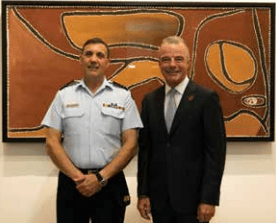
Mr Gary Oakley, national president of the Aboriginal and Torres Strait Islander Veterans and Services Association and Memorial Director Dr Brendan Nelson attend the unveiling of the newly-acquired Rover Thomas painting, Ruby Plains Massacre 1.
Inscribed with the words of John McRae’s famous poem In Flanders fields it is constructed from Portland stone, the same material used at the Menin Gate in Belgium. The garden contains soils from five key battle sites in Flanders and 20 sites of significant military heritage from each Australian state and territory, and features symbolic flowers such as the Flanders poppy.
Other major commemorative events to occur this year include plaque dedications for the Dominion Yachtsmen Scheme, the Australian Army Training Team – Iraq, Z Special, the 50th anniversary of the battle of Long Tan and Vietnam Veterans Day: Stand-to service, and the 75th anniversary of Bomber Command.
Beyond these major ceremonies, many visitors make the pilgrimage to the Memorial, often travelling to Canberra for the primary purpose of doing so. In the financial year 2016–17 some 1.1 million visitors made that trip and a further 5,614,989 visited our website to plan their trip, learn about our military history, or research the service of family members.
The Memorial’s volunteer education and visitor services teams continued to provide outstanding service to this ever-increasing audience. Our education program continued to engage with our younger generation, with 118,338 students attending on-site programs and a further 45,000 participating in our outreach programs.
Our front of house staff also supported our other key activities including new and temporary exhibitions. Amongst the latter this financial year has been The deceiving eye which shows how Australian troops were educated in the use of camouflage in the Second World War. The exhibit features one of the most generous Cultural Gifts Programs donations given to the Memorial in a number of years – the eX de Medici work Cure for pain donated by Erika Krebs-Woodward.
In addition to sharing stories of service, it is also the responsibility of the Australian War Memorial to stimulate and challenge visitors, Australian and international, to see the world through the eyes of others. To this effect we proudly opened the Witnesses and survivors permanent exhibition on 30 November 2016 in our Second World War gallery.
Through the work of war artist Alan Moore and using the words, images, and artefacts of some of the survivors who later emigrated to Australia, this important exhibition tells the story of Australia’s connections to the Holocaust. Known as the Shoah to the Jewish community it was the worst genocide of the 20th century in which some six million people, mostly Jews, Roma, gypsies, the disabled and political prisoners, were ruthlessly exterminated by Nazi Germany, and it is time this story was told here where our national soul is revealed.
This year also saw the Memorial’s Spirit of Anzac Centenary Experience (SACE) complete the final year of its threeand-a-half-year program. Over that time SACE, serving as the flagship of national commemoration and generously supported by the Federal Government, Commonwealth Bank, and Telstra, visited 23 locations, from capital cities to regional centres, and was experienced by 368,016 visitors. I wish to thank Brian Dawson, the SACE Project Executive Manager, and his team of Memorial staff for their outstanding efforts over this time. The success of this exhibition is largely due to their dedication and hard work.
The Memorial also produced a number of notable works in other mediums from Dr Karl James’s latest book, Double diamonds, a history of Australian commandos in the Pacific, to the documentary Afghanistan: the Australian story on DVD.
Original research of this nature, based on rigorous historical study and conducted by leading experts on Australian military history, informs all of the Memorial’s public engagement programs and is an important part of how we engage with the community in its own right.
Our National Collections branch has had another strong year, in addition to the acquisition of high profile artworks by artists such as Rover Thomas and eX de Medici, the branch has continued our highly successful Victoria Cross Centenary Project. Under this project the Memorial has been able to display 82 of the 100 Victoria Cross medals awarded to Australians in the Hall of Valour. We are grateful to the families, associations, museums, and other groups who have generously loaned medals to the Memorial for display during this period and enabled millions of Australians to see these important national icons.
Behind the scenes our conservators and Military Heraldry and Technology teams have also accomplished some amazing feats this financial year, particularly in completing the four year restoration of the Memorial’s Lockheed Hudson Mark IV bomber.
The Hudson, one of the RAAF’s workhorse aircraft in the Second World War, performing roles as diverse as bomber, transport, and trainer, has been fully restored to wartime configuration and is on display at Canberra Airport until 2018. The support of Canberra Airport and Virgin Australia has been invaluable in making this possible and we are grateful to them for their generosity.
May 2017 saw the Memorial take a major step forward with a completely revamped website. The new site is much more accessible, especially on mobile devices, easier to use, and the systems behind it will support our long-term strategy of digitising our collections, including future projects such as 3D scanning of artefacts that we don’t have the space to display in the galleries. The website is supported by the excellent work of our social media team, who have connected and engaged with millions of people throughout the world through platforms such as Facebook, Flickr, and Twitter, enabling us to share stories of service and have stories shared with us in return.
I would also like to highlight the Memorial’s new brand campaign – …for we are young and free. This campaign, produced by our Communications and Marketing team, acknowledges that we are still a young country, and one that is free in large part due to the sacrifice of the men and women honoured here.
The Memorial has carefully sought to manage its operations under sound financial management principles and practices, and to conduct its activities within the available funding. We continue to seek support from government and nongovernment sources and are grateful to those companies and individuals who have invested in the Memorial’s vision over this financial year.
We are particularly grateful to our generous supporters and partners, including BHP Billiton Sustainable Communities, Mr Kerry Stokes AC, Seven Group Holdings, the Seven Network, Boeing Australia, Qantas, Lockheed Martin, BAE Systems, Thales Australia, Kingold, RSL Victoria, RSL Queensland, RSL New South Wales and Services Clubs, Virgin Australia, Canberra Airport and individual generous support from Steve and Ruth Lambert. I also thank the Commonwealth Government, the Department of Veterans’ Affairs, and the Honourable Dan Tehan MP, Minister for Veterans’ Affairs, for their ongoing support.
My deep appreciation goes to Mr Kerry Stokes AC in his role as Chair of the Australian War Memorial Council. Mr Stokes has been very active in Memorial events and ceremonies, and his leadership and support to management is deeply appreciated. I thank him and all members of Council for their leadership, oversight, strategic direction, and guidance. I am also grateful to the partners and families of our Council who have supported them, including attending many Memorial events themselves, over this past year.
All that has been achieved this year would have been impossible without the hard work, enthusiasm, skills, and knowledge of the Memorial’s volunteers and staff. Their dedication in delivering higher numbers and a higher standard of service to our community this past year has been outstanding, and I thank them for their professionalism and personal engagement with the Memorial’s mission.
The leadership and support of my Assistant Directors – Leanne Patterson in Corporate Services, Tim Sullivan heading the National Collection branch, and Anne Bennie overseeing Public Programs – has been the final ingredient in making 2016–17 such a success. Their hard work and expertise has delivered extraordinary results this year and prepared us well for financial year 2017–18.
We have well-developed plans for the final period of the centenary of Anzac and for the Memorial’s long-term future, and hope to develop both throughout the next financial year.
Brendan Nelson
Director
Corporate Summary
PURPOSE
The purpose of the Australian War Memorial is to commemorate the sacrifice of those Australians who have died in war or on operational service.
MISSION
The mission of the Australian War Memorial is to assist Australians to remember, interpret, and understand the Australian experience of war and its enduring impact on Australian society.
VISION
Our vision is for the Memorial to:
- play the leading role in the nation’s commemoration of the Australian experience of war
- engage with people and communities to achieve our purpose
- collaborate with a wide range of stakeholders and partners to create mutual long-term value
- be a workplace that inspires integrity and excellence.
VALUES
The Memorial is committed to the Australian Public Service (APS) values:
Impartial
The APS is apolitical and provides the government with advice that is frank, honest, timely, and based on the best available evidence.
Committed to service
The APS is professional, objective, innovative, and efficient, and works collaboratively to achieve the best results for the Australian community and the government.
Accountable
The APS is open and accountable to the Australian community under the law and within the framework of ministerial responsibility.
Respectful
The APS respects all people, including their rights and their heritage.
Ethical
The APS demonstrates leadership, is trustworthy, and acts with integrity in all that it does.
PLANNING AND REPORTING FRAMEWORK
The Memorial is a statutory authority within the Department of Veterans’ Affairs portfolio, and is responsible for functions in accordance with the requirements of the Australian War Memorial Act 1980, the Public Governance, Performance and Accountability Act 2013, and other applicable acts. The Memorial’s strategic direction and policies are set by its Council.
Management and implementation of strategies and policies are the responsibility of the Director, who is a statutory appointee under the Australian War Memorial Act 1980.
The strategic direction for the Memorial over 2016–17 is articulated in the Memorial’s Corporate Plan. The plan includes, among other things, the outcomes to be achieved by the Memorial, as well as its vision, corporate priorities, and values. The Corporate Plan, approved and regularly reviewed by Council, provides the framework for developing the annual Business Plan and its related budget. All Memorial activities are linked directly to the corporate priorities and associated performance targets. Performance information related to these outputs is contained in Part 4 of this report.
The Memorial has a number of other plans that focus on particular activities including collection development; collection documentation; collection conservation; gallery and site development; audit; business risk; business continuity; budget; fraud control; information technology; workplace diversity; and security of physical assets, people, and information.
Further details of applicable legislation, functions, and powers can be found in Part 5.
LOCATION
The Memorial’s main site is located at the northern end of Anzac Parade, in Campbell in the Australian Capital Territory, with storage and collection facilities approximately nine kilometres away in the northern Canberra suburb of Mitchell.
Pictured here with his Australian War Memorial Long Service Medallion, Mr Peter Burness joined the Memorial as a curator in 1973, and until his retirement in December 2016 was its longest-serving employee. In recognition of his outstanding service, he was appointed a Fellow of the Australian War Memorial in 2015. He was appointed a Member of the Order of Australia in 2017, and continues to work with the Australian War Memorial in a volunteer role.
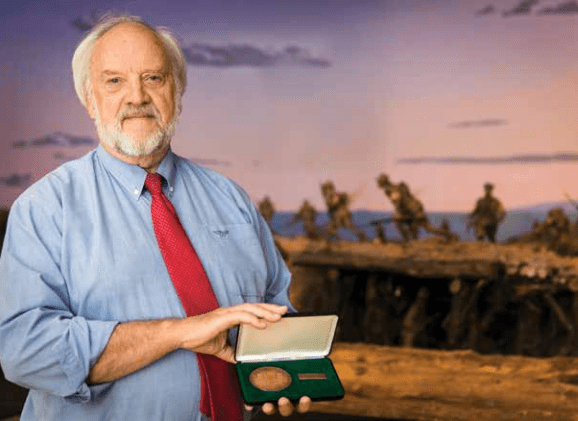
ORGANISATION CHART AND SENIOR STAFF
The day-to-day corporate operations are conducted in accordance with the policies and strategic direction set by the Council of the Memorial and its management team. The management structure of the Memorial comprises three branches based on functional responsibilities with outputs achieved by cross-branch activities.
Project teams for particular tasks are established as required. These draw on staff from sections across the Memorial and are managed and coordinated by the Memorial’s senior executive committee, the Corporate Management Group (CMG), which comprises the Director and the three Assistant Directors. Meeting weekly, CMG is responsible for the overall leadership, management, and implementation of strategies and policies, and for the regular review of performance. For all financial matters, the Chief Finance Officer attends CMG and also has direct access to the Director as necessary
Profiles of senior staff are at Appendix 2.
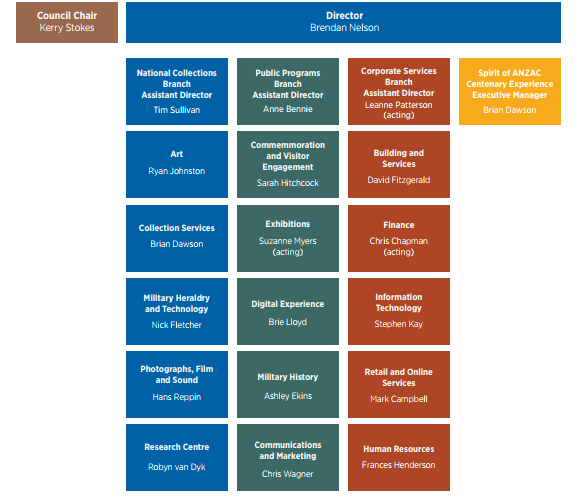
BRANCH DESCRIPTIONS
National Collection
The National Collection branch develops, manages, conserves, researches, and interprets the National Collection and makes it accessible through an extensive range of programs.
The Memorial’s collection is an invaluable resource comprising the historical and cultural artefacts of Australia’s experience of war and our involvement in peacekeeping, humanitarian, and other operational service. It underpins the Memorial’s capability to tell the stories of Australian service in exhibitions and other public programs, to educate and inform its visitors, and to meet the information needs of public enquiries, researchers, and academic and official organisations.
Each section of the branch manages a particular collection type and provides management information services to provide the essential historical and cultural contact of the collection. The National Collection branch is comprised of Art; Military Heraldry and Technology; Photographs, Film and Sound; the Research Centre; and Collection Services. Curators in these areas are responsible for researching and developing the collection; ensuring that it is accessible, well documented, and appropriately stored and conserved; and that its significance is understood. National Collection’s staff provide intellectual input to the curatorial development and interpretation of exhibitions and public programs, deal with public and official enquiries, engage in archival research and access, and make collection material available online. Collection Services staff provide expert services in conservation, storage, movement, and physical handling of the collection, as well as management of the collection management system. The branch also manages the Roll of Honour and Commemorative Roll, national and international loans of Memorial material, and donations of historically significant material.
The Branch maintains liaison with the Australian Defence Force and its history and heritage units through the Collections Coordination Group (CCG), which enables the Memorial to maintain its traditions of collection in the field during current operations.
Public Programs
The function of the Public Programs branch is to engage all Australians and international visitors to the Memorial in commemoration through ceremonies, exhibitions, education, interpretation, digital engagement, and marketing services.
The branch develops and undertakes activities to enhance commemoration at the Memorial and throughout the Australian community. It does this by conducting major and minor ceremonies to mark anniversaries relating to Australia’s experience of war, in particular Anzac Day and Remembrance Day, and by producing and conducting the daily Last Post Ceremony to remember those individuals who lost their lives in conflict. Through the exhibitions program the branch contributes to the remembrance and understanding of the Australian experience of war by developing and maintaining world-class museum exhibitions incorporating audio-visual and interactive displays, relics, photographs, and works of art. The Memorial’s goals are further supported through a program of changing temporary displays and exhibitions in the Special Exhibitions Gallery. The Memorial’s Touring Exhibition program has been able to continue due to much-appreciated support from sponsors.
The Public Programs branch conducts research to identify the needs and expectations of visitors and major interest groups, and evaluates the extent to which those needs are being met. It conducts a program of public events and a range of visitor services, including those provided by the Memorial’s volunteers and historians. The branch develops and implements education programs that are linked with national education curriculum, both for delivery on site and as part of its outreach strategy.
A focused digital experience strategy provides a deeper and more connected Memorial experience through further development of the website and use of social media channels.
The branch is also responsible for seeking, managing, and servicing fundraising and sponsorship opportunities; developing and coordinating marketing initiatives across the Memorial; providing public relations direction and support; supplying authoritative historical research and interpretation; and researching and writing the official history of Australia’s involvement in peacekeeping, humanitarian, and post–Cold War operations.
The Public Programs branch has had the responsibility for coordinating many Memorial activities relating to the centenary of Anzac.
Corporate Services
The Corporate Services Branch is responsible for the delivery of a range of internal and external governance, compliance, and resource management functions. Implementation of government reforms relevant to the Memorial is also coordinated by the branch.
The branch facilitates the management of the Memorial’s resources, including staff, finances, facilities, information technology, and office services. It provides grounds and property management, and security and records management services. It is responsible for corporate planning and issues relating to administrative law, public liability, fraud control, risk management, and ethics. Corporate Services also manages procurement and contract advisory functions, financial policy, internal audit, and asset management. The branch is also responsible for management of the Memorial Shop and e-Business.
Executive functions and ministerial and parliamentary liaison are coordinated in this branch.
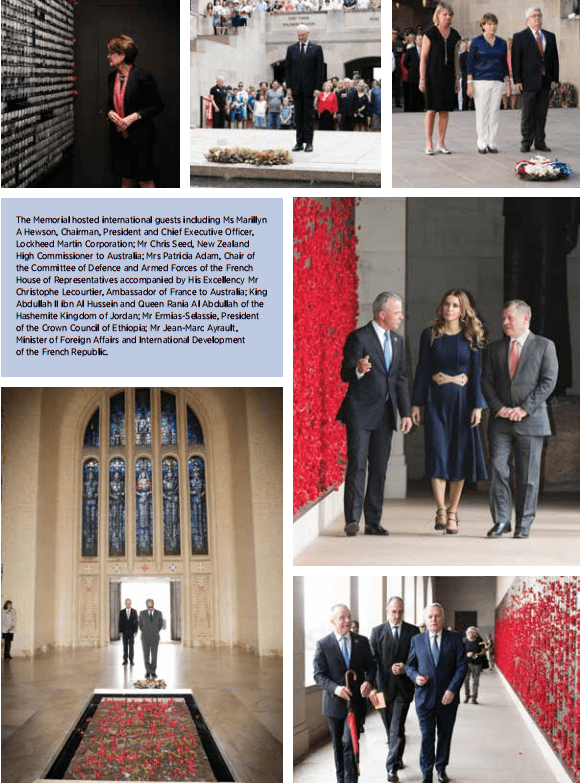
SPOTLIGHT
Conservation of the Hudson Bomber A16-105
Growing up as a kid in Canberra and going to the Memorial on a school trip for the first time left many lasting impressions printed in my mind. One that stood out the most was “Somebody actually flew that aircraft in the war”.
While working on the Hudson project, fitting parts that I manufactured into the cockpit, I had the opportunity to sit in the cockpit seat of the Hudson Bomber to adjust an instrument into the correct position. Sitting there in the cockpit seat thoughts I had as a kid 20 years ago came back to my mind: “Someone actually sat in this seat and flew this airplane during the war”. But this time I had these thoughts as someone who had the opportunity to work on the Hudson as a qualified tradesperson. A lot can happen in 20 years, but the feeling felt a day old.
“Sitting there in the cockpit seat thoughts I had as a kid 20 years ago came back to my mind”
It was a great honour to utilise the skills I had developed as a tradesperson to contribute to getting this aircraft to the spectacular standard it is in today. I’m sure the guys that flew the aircraft would be very happy with the job we have done.
Martin Tanti
Fitter and Turner
Collection Conservation Team
I began working on the A16-105 in mid-2009. The first step in what was to be the next six years of my working life at the Memorial began with the restoration of the Boulton Paul turret, piecing together the structure from components spread across several pallets and two large flatbed trolleys. This was followed by a two-week research trip to New Zealand with a curator, gathering information and components to complete the internal fitout of the Hudson. Several institutions and private owners allowed us full access to their aircraft and spares holdings, making it a successful and informative visit. We returned full of enthusiasm and began the challenging task of the full restoration, moving the aircraft from the store into the workshop, and taking on Kim “Woody” Wood for his expertise in aero structures.
“It is inside where the countless hours of work have gone, returning this airplane to what it was like in 1943.”
As the project went on we found original design blueprints, allowing the in-house manufacture of a lot more of the missing items, and a higher level of detail and completion than we had initially hoped for. Working through the various stages of the interior was challenging, but enjoyable. Of all the aircraft projects I have been a part of during 15 years at the Memorial, A16-105 is probably the one which the most work has gone into, and which I am most proud of. From the outside, apart from the new paint and Boulton Paul turret, it appears that not a great deal has changed. It is inside where the countless hours of work have gone, returning this airplane to what it was like in 1943. To be a part of a team working on such a great project was a highly rewarding experience, and one which is now proving to be a great ambassador for the Memorial in the lobby of the Canberra Airport.
Jamie Croker
Senior Large Technology Object Conservator and Aircraft Maintenance Engineer
Collection Conservation Team
Half a decade ago I was working as the production manager in a large hanger in Wangaratta, Victoria, restoring and completely rebuilding warbirds for wealthy customers all over the world. It was a demanding role, balancing the personal requests of customers and the aviation regulatory authorities in order to once again fly aircraft such as Hawker Sea Furys, P40 Kittyhawks, P39 Aerocobras and many more.
Eventually the opportunity presented itself to seek a position at the Australian War Memorial and ply my trade as a licenced aircraft maintenance engineer and specialist in aero structures, restoring Australian aircraft for display into the future. My main project was the Memorial’s Hudson Bomber now on display at the Canberra Airport.
“I am very happy that the Hudson is now on display in a space that provides access to many people and tells a little piece of the story that is part of our history as a nation.”
I am very happy that the Hudson is now on display in a space that provides access to many people and tells a little piece of the story that is part of our history as a nation.
The greatest sense of pride for me is knowing that there are people in our community who once served this country using this equipment that can catch a moment of their youth and reflect.
Rev Kim “Woody” Wood
Large Technology Object Conservator
Collection Conservation Team
Working on the Hudson was a privilege for me. Up until then I had not worked on aircraft before. This had me carrying out work that was outside my comfort zone: I had not had to fabricate parts in aluminium in such detail as was required by the supplied blueprints. It also gave me the opportunity to tune in to some upholstery skills that I had not used in quite some time, and to carry out paintwork on such a large scale was a challenge that I thoroughly enjoyed.
The interest in the aircraft shown by people is awesome. Talking to family and friends about the project has brought out a lot of interest and a number of stories about Hudsons and aircraft in general. It has got regular people talking and reflecting, and through this people have been motivated to re-visit the Memorial to look over the collection. It has been good to hear that people had been out to the airport to look at our Hudson. Most were impressed by the team’s workmanship and the logistics of how it ended up in there
I am hopeful that we will be able to recreate this kind of public feeling in the future on other projects
Mark Aitken
Workshop Manager Collection Services
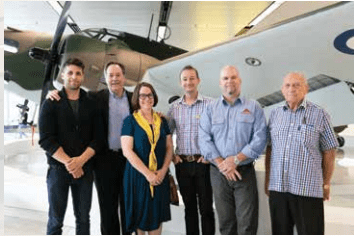
The Memorial’s Lockheed Hudson Mark IV Bomber was unveiled at Canberra Airport in December. The aircraft, which had been in the workshop for four years as Memorial conservators worked to restore its December 1942 wartime configuration, was delivered in sections and put together by the Memorial's Large Technology team.
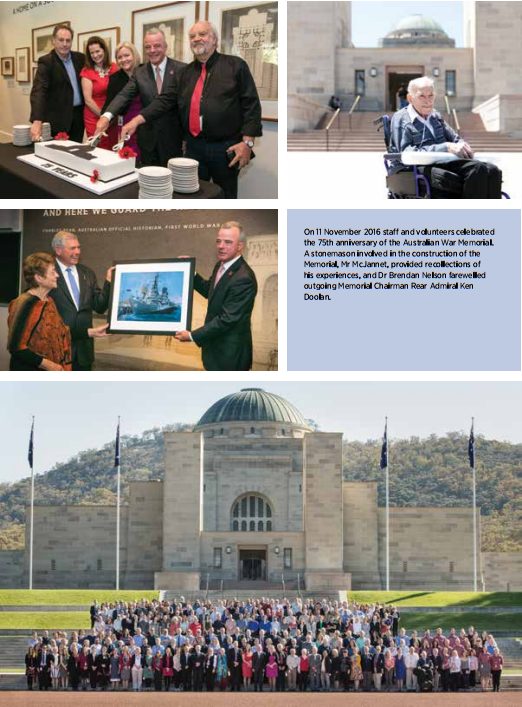
Annual Performance Statements
OUTCOME AND OUTPUTS STRUCTURE
All Australian government departments and agencies are required to measure their performance in terms of Outcomes. These are the results, impacts, or consequences of their actions on the Australian community. The performance of the Australian War Memorial is expressed in terms of a single Outcome:
Outcome 1
Australians remembering, interpreting and understanding the Australian experience of war and its enduring impact through maintaining and developing the National Memorial, its collection and exhibition of historical material, commemorative ceremonies and research.
The Memorial’s Outcome will be achieved through the maintenance and development of the national memorial and a national collection of historical material, through commemorative ceremonies, exhibitions, research, interpretation, and dissemination.
The Memorial delivers 13 programs, five of which are internally generated, to achieve the Outcome.
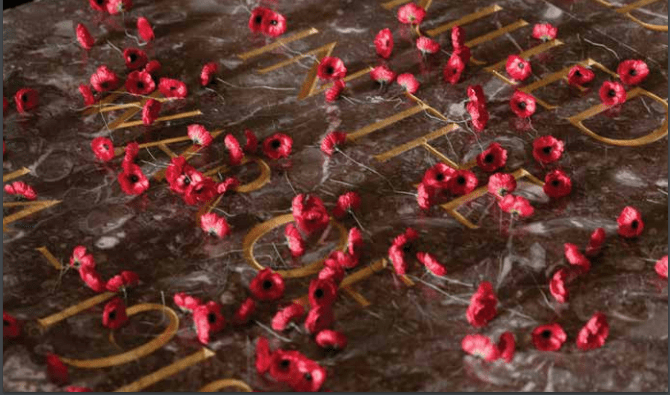
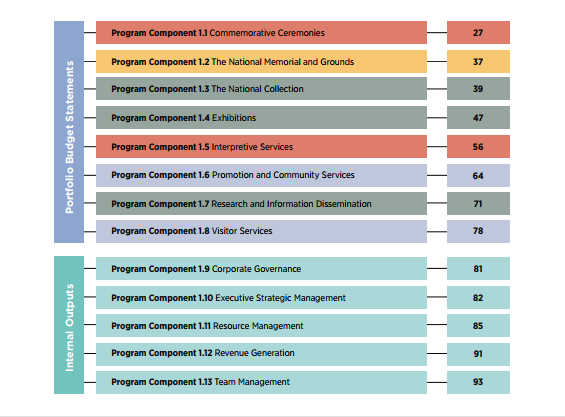
OVERALL PERFORMANCE AGAINST THE OUTCOME
This financial year the Memorial continued to operate in the 2014–2018 First World War centenary period. In July and August of 2016 the Memorial commemorated the centenary of Australian service on the Western Front at the battles of Fromelles, Pozières, Romani, and Mouquet Farm. August 2016 included the 50th anniversary of the battle of Long Tan. These events were primarily commemorated on-site through a number of commemorative events, under “Other Commemorative Activities”.
The Memorial grounds have been enhanced with the unveiling of the new Flanders Memorial Garden which was dedicated on April 2017.
International relations were reinforced with the loan of the Menin Gate lions to their original hometown of Ieper (Ypres) in Belgium.
The Memorial farewelled the Mephisto A7V tank in June 2017. This rare German tank, on display in Anzac Hall, was on loan from the Queensland Museum from July 2015 as part of the centenary of the First World War program.
Attendance by the general public was maintained, with 884,177 general visitors entering through the front gates. While numbers attending regular ceremonies and programs fluctuated in comparison to last year, already high satisfaction ratings for many galleries and activities increased by 2–6 per cent. The average time spent at the Memorial by general visitors has been increasing steadily during this period from 2 hours 9 minutes in 2014–15, to 2 hours 20 minutes in 2015–16, to 2 hours 27 minutes this year. The Memorial diversified its offerings with an increase in smaller, tailored events and programs. Programs and tours tailored to meet the needs of specific audience groups have been gaining traction.
Preparations are underway and expectations are high for the commemoration of Remembrance Day 2018, the 100-year anniversary of the end of the First World War. Memorial preparations for the post-centenary period has commenced with the release of a new branding campaign and new website. New audience research was concluded to inform these projects and assist in tailoring them to the needs of the Memorial’s audience.
COMMEMORATION PERFORMANCE INDICATOR
Whether people were actively involved in commemoration by attending the national Anzac Day and Remembrance Day ceremonies and other commemorative ceremonies held at the Memorial.
The Memorial’s Anzac Day 2017 Dawn Service and National Ceremony was attended by a combined total of 45,000 members of the public. An estimated 38,000 attended the Dawn Service and 7,000 attended the National Ceremony. Numbers for the National Ceremony were down from 2016 figures due to inclement weather. Visitors to the Memorial on Anzac Day were polled as part of on-site survey conducted throughout April as part of an audience segmentation profile project. The results showed that the audience profile for April 2017 was different from the typical annual profile, with more local visitors and including a broader, more representative ratio of demographic groups such as younger families and retirees.
The Remembrance Day 2016 ceremony was attended by 3,700 members of the public. The Last Post Ceremony has been becoming increasingly responsive to the needs of veterans, families and other stakeholders. Last Post ceremonies were attended by 143,016 people, down 7 per cent on figures from the previous financial year.
Wreathlaying ceremonies had a 15 per cent increase in attendance, with a total of 11,032 people – including 7,038 students attending school wreathlaying ceremonies, a 35 per cent increase; 1,087 more than last year.
ACCESSIBILITY PERFORMANCE INDICATOR
Whether a significant number of Australians visited or had access to the Australian War Memorial and its services, including exhibitions, touring exhibitions, collections, website, Research Centre, and research and interpretive programs.
The Memorial’s audience profile has continued to evolve. While the percentage of first time visitors to the Memorial was similar – 34 per cent in 2016–17 and 35 per cent in 2015–16 – there was an 8 per cent increase in the recent under-twoyear repeat visitor groups (4 per cent for both “less than 12 months” and “1–2 years”) and a 7 per cent decrease in the longer-term repeat visitor groups of “5–10 years” and “10 years and over” (also 4 per cent each).
The Memorial’s domestic profile was comparable to that of 2015–16 with slight increases in Victorian and Queensland visitors and increases in retirees over 65 years.
Of those interstate visitors surveyed, the following were the main motivations expressed for visiting the Memorial:
- holiday or leisure (34 per cent)
- specifically to visit the Memorial (23 per cent)
- as part of a visit to friends and relatives (21 per cent).
General public front gate attendance showed a 5 per cent increase this year, program and event attendances fluctuated while satisfaction and engagement levels were equal to or higher than the 2015–16 reporting year.
The Memorial’s touring exhibition attendances have been lower as the program restarted in December 2016 with new funding for a number of exhibitions including For Country, for Nation.
Overall, a combined estimated total of just under 1.105 million people visited the Memorial’s Campbell site or storage facility at Mitchell. A further 14,454 visitors attended the Memorial’s touring exhibitions at other venues.
Figure 1: Domestic Visitors - Percentage by State
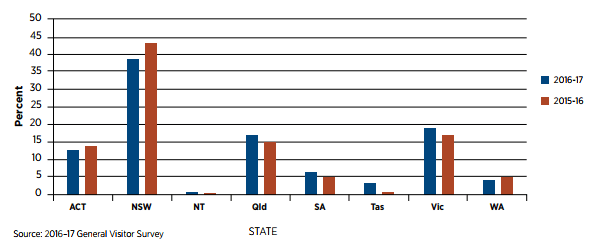
Figure 2: Overall Visitation, 2016–17
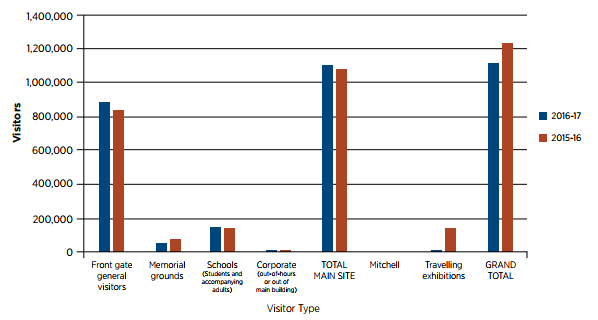
KNOWLEDGE AND UNDERSTANDING PERFORMANCE INDICATOR
Visitors and clients had an increased level of knowledge and understanding of the Australian experience of war and its enduring impact on our society as a result of their contact with the Memorial.
The Memorial continues to track visitor perceptions of the importance of the Australian experience of war in creating and shaping the Australian identity during the centenary period. This year there was a marginal decrease in visitors believing that this was “very important” or “extremely important”, from 83 to 81 per cent.
Learning measures are included in all of the Memorial’s dedicated exhibition exit surveys. The Reality in flames modern Australian art and the Second World War exhibition pushed the comfort zone of the Memorial’s typical visitors with the inclusion of modern and abstract art. It successfully used modern art to provide a different viewpoint on the Second World War. Around half of the visitors who visited the exhibition were surprised to learn that the Memorial holds these artworks in its collection. Of those interviewed upon exiting the exhibition, 97 per cent found the information interesting overall. Visitors were asked what they thought were the most striking impacts of the Second World War on Australian society. The largest categories of many and varied answers were:
- 15 per cent: loss of life and death
- 9 per cent: the effect it had on Australians at home
- 8 per cent: changing gender roles and role of women in particular
- 4 per cent each for: attack on home soil; violence intensity and destruction of it all; and the impact on Australia’s relationship with America and the United Kingdom.
“Touched home physically, more literature and art and recordings on the home front. Much more dominant. Not a choice, this was a worthy war.”
“From the artwork I would conclude it [the Second World War] reinforced Australian identity.”
“Psychological impact of servicemen and women and their families. Constant fear of threat and closer to home.”
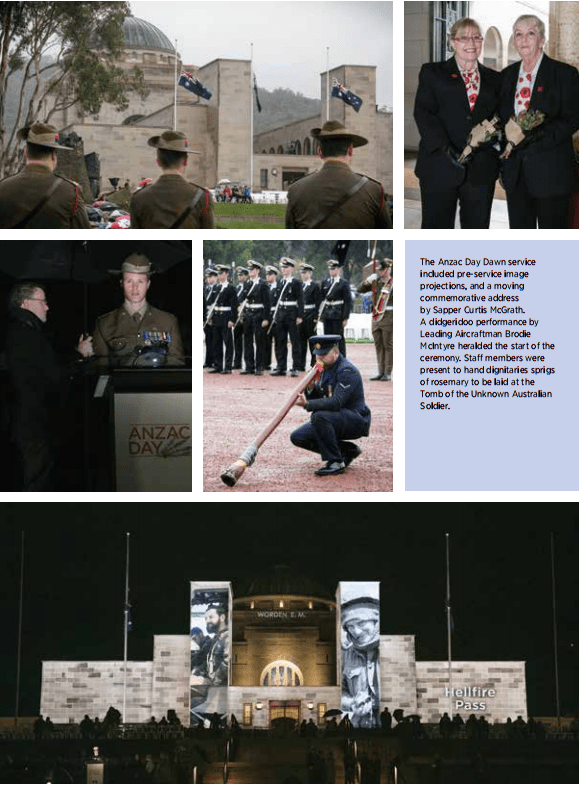

CORPORATE PLAN
STRATEGIC PRIORITY:
Commemoration of the Australian experience of war.
PORTFOLIO BUDGET STATEMENTS
PROGRAM COMPONENT 1.1
COMMEMORATIVE CEREMONIES
assist Australians remember the Australian experience of war and its enduring impact on society.
Major national ceremonies, particularly Anzac Day and Remembrance Day, and other commemorative ceremonies are conducted in an engaging, dignified, and appropriate manner, with assistance provided to organisations conducting commemorative ceremonies.
OVERVIEW
Commemoration to mark special dates and events takes many forms. The Memorial delivers a comprehensive program that includes the major national days of commemoration, such as Anzac Day and Remembrance Day, other significant dates and events in Australian military history, and smaller, more intimate ceremonies such as the Last Post.
The Last Post Ceremony was first introduced to commemorate significant military anniversaries and events. Since its inception in 2013, the ceremony has evolved into one of the Memorial’s most poignant and venerated traditions. Now a daily event, the Last Post Ceremony tells the personal story of one of the more than 102,000 Australian men and women who died in service of their country and whose names appear on the Roll of Honour.
The commemorative program continues to receiving an increase in enquiries. These requests are often accompanied by further specific and meaningful elements, in particular for the Last Post ceremony. Since the inception of the Last Post Ceremony in 2013, over 900 requests have been received to commemorate individuals whose names appear on the Roll of Honour.
In 2016, the Remembrance Day National Ceremony attracted a comparable audience to that of the previous year. The Commemorative Address was delivered by the Honourable Jeff Kennett AC and explored the issues of mental illness, including post-traumatic stress in the Defence environment and the resources required to support it. Almost 1,000 students and teachers attended the National Ceremony, and 102 students from schools across Australia laid poppies in honour of the more than 102,000 Australian servicemen and women who lost their lives in wartime.
On Tuesday 25 April 2017, the 102nd anniversary of the ANZAC landings was commemorated with the Dawn Service, National Ceremony, and a special Last Post Ceremony. Poor weather threatened the Dawn Service at which Sapper Curtis McGrath OAM delivered a moving commemorative address regarding his experience in Afghanistan and the commitment of service personnel to the concept of a DUSTOFF: Dedicated Unhesitating Service to Our Fighting Forces. The heavens opened up for the National Ceremony affecting audience attendance and march participation. The Commemorative Address delivered by Vice Admiral Ray Griggs AO CSC RAN highlighted many of the events of the Second World War and their impact on Australia and Australians. Students and teachers from Australia and from New Zealand attended the ceremony.
PORTFOLIO BUDGET STATEMENTS
PERFORMANCE TARGET
Three major ceremonies: the Anzac Day Dawn Service; the Anzac Day National Ceremony; and the Remembrance Day Ceremony.
RESULT Met
Attendance at and participation in a commemorative ceremony is an explicit act of remembrance.
Just over 210,460 people attended commemorative ceremonies during 2016–17
Attendance at the three major commemorative ceremonies held during 2016–17:
- Anzac Day Dawn Service: approximately 38,000 visitors (55,000 last year)
- Anzac Day National Ceremony: 7,000 visitors (11,500 last year)
- Remembrance Day Ceremony: 3,700 visitors (3,900 last year).
PORTFOLIO BUDGET STATEMENTS
PERFORMANCE TARGET
At least ten other commemorative ceremonies.
RESULT Met
| Commemorative ceremony | Quantity | Attendees |
|---|---|---|
| Major ceremonies | 3 | 48,700 |
| Other ceremonies (incl. special commemorative events and wreathlayings) | 35 | 9,603 |
| Plaque dedications | 4 | 1,275 |
| Head of state visits | 7 | 189 |
| VIP visits (incl. tours and wreathlayings) | 101 | 949 |
| School wreathlayings | 133 | 6,747 |
| Last Post ceremonies | 364 | 143,016 |
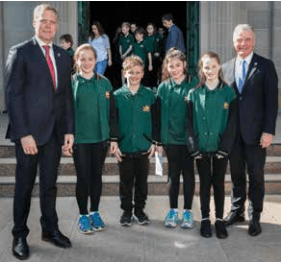
Students from Lilydale West Primary School in the Commemorative Area with the Honourable Tony Smith and Dr Brendan Nelson.
PORTFOLIO BUDGET STATEMENTS
PERFORMANCE TARGET
At least two ceremonies per week (during school terms) for the school wreathlaying program.
RESULT Met
The school wreathlaying ceremony is a unique and poignant commemorative activity for school students visiting the Australian War Memorial. Students participate in a ceremony in the Hall of Memory and have the opportunity to speak with a guest veteran about his or her personal service history and experience. The school’s federal Member of Parliament (MP) is invited to attend and participate in the ceremony
The school wreathlaying ceremony program continues to be engaging and popular. In 2016–17, 133 ceremonies were attended by 6,747 students, and 5 of these ceremonies were attended by an MP. Funding support provided by the Department of Veterans’ Affairs enables the delivery of this program.
“Students were reminded in a very poignant way, about the sacrifices made by Australians in war and the impact of war”
Endeavour College, Mawson Lakes, SA July 2016
“The participation in the ceremony reinforced the solemn and respectful way we should treat the memory of the soldiers who sacrificed so much. To be able to participate in this ceremony in such a special monument was truly an honour that enhances and sparks student learning.”
Assisi Catholic College, QLD October 2016
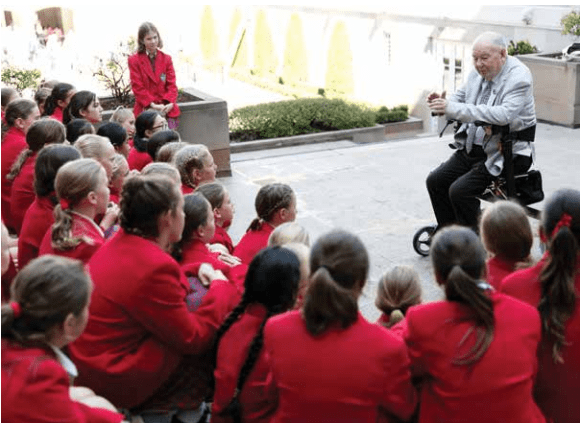
Retired Major Graham Gordon addresses students from Mentone Girls Grammer School.
“Very professionally organised by staff. Was wonderful to have the presence of a veteran. We noticed a difference in the students’ level of awareness and respect before and after the ceremony.”
St. Clement of Rome Catholic Primary School, VIC, March 2017
“A formal, sober experience for our students. The ceremony allowed students to gain further insight into our customs, traditions and history.”
Bletchington Public School, NSW, March 2017
“It improves their awareness and understanding of the importance of remembering the sacrifice that men and women gave throughout all conflicts. It reinforces the knowledge gained from experiencing the museum. The students connect more when things are ‘real’. Having Ray speak with us and share his experiences help the girls connect their knowledge and empathy, developing a deeper respect for all people.”
Lauriston Girls School, VIC March 2017
PORTFOLIO BUDGET STATEMENTS
PERFORMANCE TARGET
The Last Post Ceremony on a daily basis.
RESULT Met
The Last Post Ceremony was delivered in all weather conditions on each of the 364 days the Memorial opened. Incorporated into the scheduling were more than 160 family requests and ten association requests. Over 60 ceremonies commemorated significant military anniversaries or annual dates of remembrance.
There have been many memorable occasions at the Last Post Ceremony over the past 12 months. Examples include the 50th anniversary of Vietnam Veterans Day the visit from His Excellency János Áder, President of the Republic of Hungary and the First Lady, which coincided with the ceremony to honour a casualty in Afghanistan, Private Luke Gavin. The ceremony was an extremely moving experience for the visiting dignitaries, family members, and others present.
The Australian Defence Force continues to support the ceremony through the voluntary commitment of Defence personnel to read the stories each evening. Of particular note is the regular involvement of Australia’s Federation Guard which brings a special ceremonial element to the ceremony twice a month and on significant anniversaries.
In the past 12 months, the Memorial has begun live-streaming Last Post ceremonies for online viewers through YouTube and Facebook, providing increased accessibility and broadening audience reach.
The Last Post Ceremony is a culmination of effort from various teams across the Australian War Memorial. Through their hard work and dedication the ceremony is delivered daily in a professional and dignified manner that ensures continual meaningful engagement with visitors and the Memorial’s digital audience.
OTHER COMMEMORATIVE ACTIVITIES
50th anniversary of Vietnam commemorations
August 2016 marked the 50th anniversary of the battle of Long Tan and Vietnam Veterans’ Day. The Memorial held a special commemorative program over the period 16–18 August to honour and acknowledge those who served in Vietnam.
On the evenings of 16, 17, and 18 August 2016, photographic images from the Vietnam War were projected onto the façade of the Memorial. Also projected were the names of the key theatres of the war, and the names of the 521 personnel listed on the Vietnam Roll of Honour.
On Wednesday 17 August, a special performance of I was only 19 was conducted by Mr John Schumann and the late Mr Hugh McDonald in the Hall of Memory for a group of veterans nominated by Vietnam veteran associations and federations from around Australia. This unique performance gave the veterans the opportunity to gather beside the Tomb of the Unknown Australian Soldier, in memory of men and women who served this nation in the Vietnam War, and to remember those that did not come home. This special performance was filmed and streamed live for public viewing on screens in the forecourt of the Memorial. Mr Schumann and Mr McDonald performed the song again at the day’s Last Post Ceremony to all veterans, their families, general visitors, and school students to commemorate this significant anniversary.
At 5.30 am on the morning of 18 August 2016, the Memorial’s Commemorative Area opened to the public where cadets from the Australian Defence Force Academy and the Royal Military College Duntroon recited the 521 names on the Vietnam Roll of Honour. During this time, visitors were able to enter the Commemorative Area and place poppies to remember the fallen.
Following this, a stand to service was held at 7 am on the Memorial’s Parade Ground. Approximately 600 veterans, families, visitors, and invited dignitaries gathered in the stillness of the morning to commemorate those who served in Vietnam. The ceremony included an address by the Governor-General of the Commonwealth of Australia, His Excellency General the Honourable Sir Peter Cosgrove AK MC (Retd), who laid a wreath at the Stone of Remembrance with Her Excellency Lady Cosgrove. Wreaths were also laid by representatives of the veterans of the battle of Long Tan and the families of those that were killed in this action. Wreaths were also laid by the Presidents of the Vietnam Veterans Association of Australia, Vietnam Veterans Federation of Australia, and the New Zealand Vietnam Veterans Association. The Last Post Ceremony story on this day was of Private Kenneth Gant, a Long Tan casualty, and included a recording of him singing Oh, Danny Boy, a gift for his mother before he departed for Vietnam almost 50 years earlier.
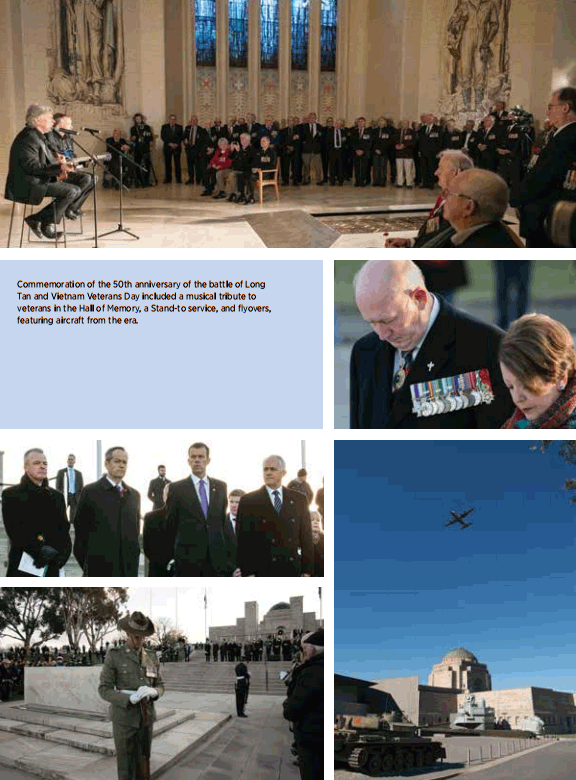
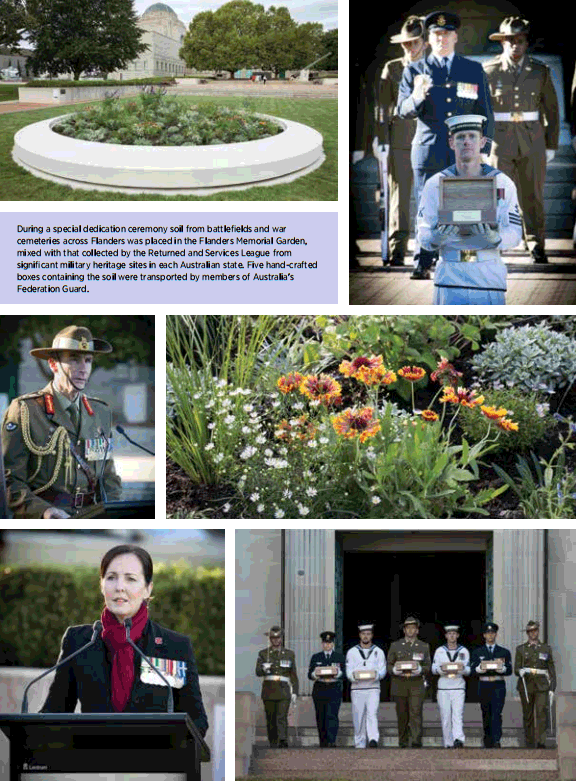
For Country, for Nation exhibition launch
On 22 September 2016, the launch of the exhibition For Country, for Nation was held. Displayed for 12 months, this unique exhibition presents the story of Australia’s experience of war from the perspectives of Aboriginal, Torres Strait and Pacific Islander peoples.
Approximately 200 people attended the launch, including a number of dignitaries, members of the Memorial Elders nd Knowledge Holders Guidance Group, and members of Indigenous communities. The launch commenced with a traditional smoking ceremony to welcome guests prior to a Welcome to Country by Mrs Roslyn Brown, Chairperson of the United Ngunnawal Elders Council. The Chief of Navy supported the launch with the participation of the Royal Australian Navy Indigenous Group, Bungaree. This group, comprised of officers and sailors of the Royal Australian Navy, represents clans and nations from as far afield as the Torres Strait and the Western Plains of New South Wales. The members assisted in leading guests to the launch from the Last Post Ceremony and performed as part of the official proceedings wearing a mix of traditional dress and naval uniform, representing their traditional and military heritages.
Senator the Honourable Arthur Sinodinos AO representing the Prime Minister and the Leader of the Opposition, the Honourable Bill Shorten MP, provided remarks prior to the exhibition being officially launched by Squadron Leader Gary Oakley, National President of the Aboriginal and Torres Strait Islander Veterans and Services Association, and member of the Gundungurra tribe from the Blue Mountains region of New South Wales. The formalities concluded with the performance of On Every Anzac Day by Mr John Schumann and Mr Rohan Powell. Mr Schumann was commissioned in 2015, by the then Chief of Army, Lieutenant General David Morrison AO, to write this song to commemorate Australia’s Indigenous soldiers.
Flanders Memorial Garden dedication ceremony
On 4 April 2017, a ceremony was held to officially dedicate the Flanders Memorial Garden. Developed with the support of the Government of Flanders, the garden reflects the enduring relationship between Australia and Belgium, and is a significant addition to the Memorial’s commemorations of the centenary of the First World WarOn 4 April 2017, a ceremony was held to officially dedicate the Flanders Memorial Garden. Developed with the support of the Government of Flanders, the garden reflects the enduring relationship between Australia and Belgium, and is a significant addition to the Memorial’s commemorations of the centenary of the First World War
The evening before the dedication ceremony, members of Australia’s Federation Guard transported five hand-crafted boxes containing soil from battlefields and war cemeteries across Flanders, from the Memorial forecourt into the Commemorative Area. The boxes were brought past the names listed on the First World War Roll of Honour and placed in the Hall of Memory. Resting adjacent to the Tomb of the Unknown Australian Soldier, they remained in symbolic vigil overnight.
The following morning the boxes were collected by Australia’s ederation Guard and taken to the official dedication ceremony, where the soil was placed in the garden by the Governor-General of the Commonwealth of Australia, His Excellency General the Honourable Sir Peter Cosgrove AK MC (Retd), the Secretary General of the Flanders Department of Foreign Affairs, Mr Koen Verlaeckt, the Chief of Army, Lieutenant General Angus Campbell DSC AM, the Regimental Sergeant Major of the Army, Warrant Officer Don Spinks OAM, and junior Legatees Thomas and Katherine Grice.
Soil collected from key First World War heritage sites in each state and territory of Australia was placed in the garden by branch representatives of the Returned and Services League of Australia.
The dedication included a traditional smoking ceremony, conducted by Ngunnawal Elder Ms Tina Brown to cleanse the foreign soil, enabling the spirits within to rest easy on Ngunnawal country within the grounds of the Memorial. Council member Wing Commander Sharon Bown (Retd) recited the commemorative poem by John McCrae In Flanders fields, the words of which are inscribed on the Flanders Memorial Garden. Adjacent to the garden is an interpretive panel which features a quote from British Field Marshal Lord Plumer who dedicated the Ieper (Menin Gate) Memorial, in 1927:
“It can be said of each one in whose honour we are assembled here today: He is not missing; he is here.”
VIP visits
The Memorial conducted over 100 VIP visits in 2016–17 including visits by Their Majesties King Abdullah Il bin Al-Hussein and Queen Rania Al Abdullah of the Hashemite Kingdom of Jordan, and Their Majesties King WillemAlexander and Queen Máxima of the Netherlands.
A complete list of VIP visits and ceremonies is provided at Appendix 3.
PLAQUE DEDICATION PROGRAM
To date, 220 commemorative plaques have been installed in the Memorial’s grounds. All commemorative plaque records are released to the Memorial’s website, with each record including a site map featuring a photograph and description of the plaque, along with its general location within the grounds.
The program was closed in June 2015 with all current applications from that time progressed. With so many plaques now installed, only new requests from more recent conflicts are considered.
Four commemorative plaques were installed during the year:
Z-Special
On 1 August 2016, a plaque dedication ceremony was held commemorating the service and sacrifice of members of Z Special Unit, Special Operations Australia. The Z Special Unit was a secret element of the Australian military forces, and an administrative and holding unit for Australian soldiers serving with Special Operations Australia during the Second World War.
The plaque dedication attracted an audience of 1,100 including Z Special veterans, widows, siblings and other family members who had travelled from around Australia and New Zealand to attend this significant ceremony. During the proceedings, Air Chief Marshal Mark Binskin AC, Chief of the Defence Force, read a message on behalf of the Governor-General of the Commonwealth of Australia, His Excellency, General the Honorable Sir Peter Cosgrove AK MC (Retd) paying special tribute to the dedication and sacrifice of the men of Z Special Unit. The commemorative plaque was unveiled by Z Special veterans Mr Jack Tredea MM and Mr Jim Ellwood.
Dominion Yachtsman Scheme
On 4 May 2017, a plaque dedication ceremony was held commemorating the service and sacrifice of members of the Dominion Yachtsman Scheme. Recruited to the Royal Australian Navy Volunteer Reserve through yacht clubs, roughly 500 Australian volunteers served over a period of 60 years in the Atlantic and Arctic seas on convoy duty, and in the Mediterranean and Persian Gulf on special operations and bomb disposal.
Seventy family members of those who served in the Dominion Yachtsmen Scheme travelled from around Australia to attend this plaque dedication ceremony.
Special Operations Command
On 29 May 2017, a plaque dedication ceremony was held commemorating the service and sacrifice of members of the Special Operations Command units. The plaque commemorates the service of the Special Operations units which formed the foundation of Australia’s National Mission forces, including; 1 Commando Regiment; SAS Regiment; 2 Commando Regiment; Special Operations Engineer Regiment; Special Operations Logistics Squadron; Special Forces Training Centre; Parachute Training School; and 6th Aviation Regiment.
Fifty serving members of Special Operations Command attended this important ceremony. During the proceedings, Major General Jeffrey Sengelman DSC AM CSC, Special Operations Commander Australia, delivered the Commemorative Address and unveiled the commemorative plaque in acknowledgement of the service and sacrifice of all those who are a part of Special Operations Command.
Australian Army Training Team Iraq
On 1 June 2017, a plaque dedication ceremony was held commemorating the service and sacrifice of members of the Australian Army Training Team Iraq (AATTI). Between 2004 and 2008, 485 members of the Australian Army and Royal Australian Air Force deployed and contributed to the training of over 33,000 Iraqi Army soldiers.
Thirty members of the AATTI Association attended this plaque dedication ceremony. Notable members of the association in attendance included Major General Mark Kelly AO DSC (Retd), Commissioner – Department of Veteran Affairs and Mr Jeremy Hanson CSC MLA, ACT Shadow Minister for Veterans Affairs. The commemorative plaque was unveiled by Colonel Iain Cruickshank CSC DSM, President of the AATTI Association, and Colonel Kerry Gallagher AM, National President of the Australian Army Training Team Vietnam Association. Colonel Cruikshank also delivered the Commemorative Address during the proceedings.
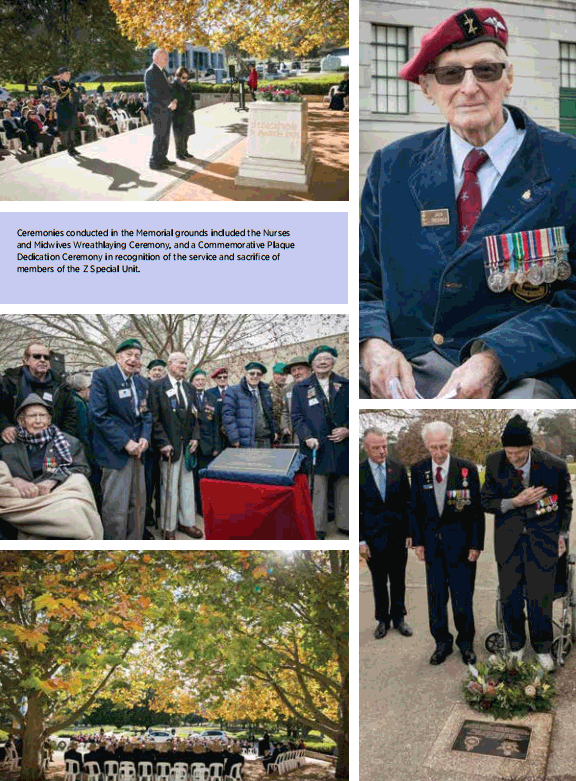
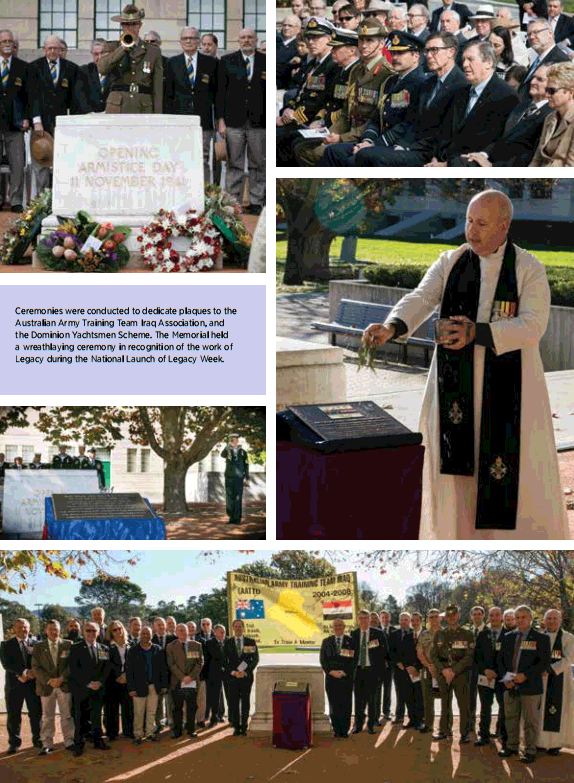
CORPORATE PLAN
STRATEGIC PRIORITY:
Building the Memorial.
PORTFOLIO BUDGET STATEMENTS
PROGRAM COMPONENT 1.2
THE NATIONAL MEMORIAL AND GROUNDS
assists Australians remember the Australian experience of war and its enduring impact on society.
The Memorial building and grounds are conserved and developed as a national memorial to Australians who served and died in war.
OVERVIEW
The Memorial buildings and grounds are maintained as important commemorative areas.
The Flanders Memorial Garden was installed in a location in the Western Precinct Sculpture Garden and within the Campbell precinct Site Development Plan (SDP). The garden included soil sourced from the First World War cemeteries in Flanders in which many soldiers found their resting place, and from locations around Australia. A full report of the Flanders Memorial Garden is at page 33, under “Other Commemorative Activities”
A sculpture has been commissioned to commemorate General Sir John Monash and his significance as an outstanding Australian commander and general of the First World War. Planning for a families sculpture dedicated to recognising the families of Australians who have served in war, peacekeeping, and humanitarian operations is in the design stages, and is expected to be dedicated in July 2018.
Tarin Kowt and Camp Holland memorials from Defence bases in Afghanistan have been installed as permanent structures in the western grounds.
The five-year cycle for an update of the Campbell Site Development Plan has commenced, with the Johnson Pilton Walker review to be completed in 2017.
Four new dedication plaques were placed in the western and eastern precincts, and a new plaque plinth has been proved for construction alongside the western access path to accommodate new plaques. See page 34 for further details.
Enhancements to the Roll of Honour, with the additions of names previously not included or misspelled, have been implemented. Improvements to the way-finding and presentation of the Commemorative Roll was completed late 2016.
Heritage and aesthetic considerations of the Commemorative Area remain important, as they enhance the visitor experience. These considerations are carefully managed in alignment with the Memorial’s Heritage Management Plan.
PORTFOLIO BUDGET STATEMENTS
PERFORMANCE TARGET
The Memorial heritage building, Commemorative Area, and surrounding grounds maintained and presented to the highest standard.
RESULT Met
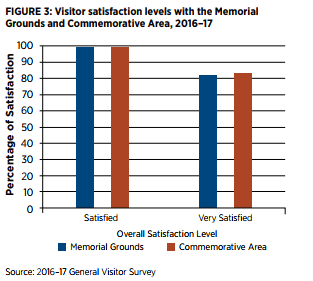
High-quality building, garden, and grounds presentation remains a top priority for the Memorial. The ongoing maintenance program ensures that the grounds and buildings are presented to the highest possible standard. Replacement of trees and other plantings was undertaken as required, as was maintenance of all sculptures and memorials, buildings, and the Pool of Reflection
A major refurbishment of the Commemorative Area has been completed. The original, badly weathered sandstone stringcourse and carved figures have been replaced to preserve the appearance and heritage value of the site. The project was generously supported by the Department of Environment through a $1 million grant from the Protecting National Historic Sites program. The works also included replacement and waterproofing of the Commemorative Area garden beds and re-grouting of the Christmas Bush granite flooring and the Pool of Reflection.
As part of the Commemorative Area reconstruction project, new drainage and planter boxes have been installed. This will reduce the risk of damage to the building due to failing waterproofing and inadequate drainage.
Detailed garden maintenance of the Commemorative Area and the Memorial courtyard on a weekly basis continues to keep these high-profile formal gardens at their best. The maintenance regime for the Pool of Reflection in the Commemorative Area and for the National Service Memorial Fountain in the courtyard continues at a high standard and has reduced conservation requirements.
PORTFOLIO BUDGET STATEMENTS
PERFORMANCE TARGET
Access to the Memorial and visitor facilities of the highest standards.
RESULT Met
The implementation of the Campbell Site Development Plan continued this year, along with various minor new site developments for visitor amenities. A full width access platform was installed in the Commemorative Area entrance, using Christmas Bush granite sourced from the original quarry to ensure the works were sympathetic to the heritage aesthetic of the area. The work was designed in line with heritage and building code requirements.
Design and documentation has commenced on the southern commemorative area stairs to upgrade the handrails, improve lighting for evening and night events, and meet safety and legislated requirements.
Sixteen additional light poles have been installed across the Campbell Site, providing increased security and safety for the public, as well as many being fitted with power and data outlets to improve facilities for events.
PORTFOLIO BUDGET STATEMENTS
PERFORMANCE TARGET
Building works that comply with relevant standards, codes, and regulations.
RESULT Met
All building works undertaken at the Memorial are in accordance with relevant standards, codes, and regulations.
PORTFOLIO BUDGET STATEMENTS
PERFORMANCE TARGET
Management and conservation of heritage elements using the Australia ICOMOS Burra Charter
RESULT Met
Memorial staff continue to liaise with heritage specialists as required to seek advice for building works in heritagesensitive areas.
An ongoing maintenance and conservation regime is in place to protect and repair the stonework in the Memorial building. Over the course of this year, this work included the removal of algal deposits from the sandstone; conservation and repair of chipped and damaged stone behind the Merchant Navy Sculpture; ceiling repairs above Airman and Sailor sculptures; rejuvenation of the grout in the Hall of Memory; and conservation and re-grouting of sandstone in the Hall of Valour.
A regular maintenance regime ensures the longevity of the Lone Pine tree (Pinus halepensis). A replacement Pinus halepensis, derived from a seed taken from the original Lone Pine, was planted by Their Royal Highnesses The Duke and Duchess of Cambridge on Anzac Day 2014. It is anticipated that this tree will have grown to a suitable size when the original Lone Pine reaches senescence. The new pine is in a very healthy state, assisted by the fence and bird netting which will be expanded in the coming year.
PORTFOLIO BUDGET STATEMENTS
PERFORMANCE TARGET
Timely completion of works to minimise impact on visitors.
RESULT Met
All minor works at the Memorial, including regular maintenance, cleaning, and conservation of the main building, are scheduled out of hours where possible and in consideration of significant public events. Any major works that may be disruptive are scoped and planned to ensure that intrusive elements of the work are scheduled at the most appropriate times, that alternative arrangements for visitors are made, and that the public is informed.
As noted above, the two-year Commemorative Area Reconstruction Project has been completed. The area’s significance and values have been preserved by removing deteriorating portions of sandstone, especially the string course and sculptural elements of the east and west walls, and reconstructing them with matching sandstone. Improving the drainage of the cloisters and gardens preserves their functionality as well as protecting the reconstructed stonework and the Memorial’s lower galleries from water damage.
PLAQUE DEDICATION PROGRAM
Four commemorative plaques were installed during the year.
ROLL OF HONOUR
The Memorial’s bronze Roll of Honour panels were updated for accuracy, with two in situ amendments made.
CORPORATE PLAN
STRATEGIC PRIORITY:
Creating and sharing knowledge, expertise and the National Collection.
PORTFOLIO BUDGET STATEMENTS
PROGRAM COMPONENT 1.3
THE NATIONAL COLLECTION
assists Australians remember the Australian experience of war and its enduring impact on society.
A national collection of historical material related to Australia’s military history that is developed, managed, preserved, and interpreted to make it accessible.
OVERVIEW
The centenary of the First World War and the associated theme of commemorating a century of service has generated an unprecedented level of engagement with the National Collection. As well as supporting Australians at home and overseas to understand the significance of milestones in the story of Australia in the First World War, National Collection staff have supported public engagement with the stories of significant anniversaries for the Second World War, Korea, Vietnam, the Gulf War, and peacekeeping operations.
National Collection staff are also focused on ensuring the stories and artefacts of service of current and recent conflicts and operations around the world are collected. We are grateful for the support of the ADF in enabling National Collection staff to be deployed with colleagues in the ADF’s history and heritage units into areas where Australians are serving. In the tradition of Charles Bean and John Treloar, staff are engaged in the field identifying and collecting objects and stories that relate to those operations, the people engaged in them, and their reflections on their experiences.
The Memorial is grateful for collaboration with the ADF through the Collections Coordination Group, which facilitates the liaison between the Memorial and the ADF’s branch history and heritage units. The Defence Capability Acquisition and Sustainment Group (CASG) provides technical expertise and project management in supporting the transfer of assets to the National Collection.
We have been able to regularly commission Official War Artists to travel into operational areas, which is particularly significant in the centenary of the Official War Art program, created through the efforts of Charles Bean in 1917.
Planning for a new 5,000 square metre storage facility at Mitchell is well advanced, with completion expected in December 2018. The new facility will accommodate the large technology collections, including aircraft and a number of new acquisitions relevant to contemporary and recent operations: two naval helicopters (a Seahawk and a Squirrel), an army Blackhawk, an FA18, and a P3C Orion will be acquired between 2018 and 2021. A number of land capability vehiclesfrom operations in the Solomon Islands, East Timor, Iraq, and Afghanistan have been received. The new facility will enable a review of storage of large technology at Mitchell to make the best use of available space.
The new textiles store has been operating successfully with new compactus, environmental and security controls, and new procedures to maintain its status as a clean store. Refurbishments of space in the Treloar A building and armoury have improved security and the general storage environment, and significantly reduced the risk of overcrowding.
The project to clear an accumulation of undocumented items in transit and temporary stores has been completed. New procedures for managing donations of historical material are in place to ensure timely turnaround of documentation for donors, introduction of conservation assessments to better manage risk to the collection, centralisation of documentation on the collection management system, and a significant gain in efficiency from providing guidance to potential donors before material is delivered to the Memorial. These procedures will now be extended to include all acquisitions to ensure systematic documentation, risk management, and financial compliance. The project also led to new procedures for managing radiation hazards in items such as luminous dials and watches, certain kinds of lenses and metal hardeners, and electronic equipment.
The movement of the Menin Gate Lions to their original home at the Menin Gate Memorial in Ieper was a major undertaking of conservation and logistics. The lions will stand at the Menin Gate through the centenary of the battles in Flanders in which Australians suffered so heavily in 1917. The Memorial thanks the Royal Australian Air Force, the Commonwealth War Graves Commission, the Government of Flanders, and the City of Ieper for their support in this major international collaboration.
There was a significant increase in the number of loan requests and items on loan with communities around Australia, and to overseas museums, galleries, and diplomatic posts commemorating events relating to the century of service and the First World War.
The Victoria Cross Project has sought to display as many of the 100 Victoria Crosses awarded to Australians as possible in the Hall of Valour during the Centenary. So far, with the support of private owners and other cultural institutions for loans of the medal, a total of 82 Australian Victoria Crosses are on display at the Memorial.
Linked to that project was the acquisition – courtesy of the generosity of the Department of Defence – of the weapons used by Corporals Mark Donaldson VC and Dan Keighran VC in the actions for which they were awarded the VC in Afghanistan. The Memorial already holds the weapons used by Corporals Ben Roberts-Smith VC MG and Cameron Baird VC MG, both of which are on display in the Hall of Valour. We were privileged to conduct oral histories with Keith Payne VC AM and his wife Florence Payne OAM on their careers and lives working to support veterans.
A partnership with the Anangu Pitjantjatjara Yankunytjatjara (APY) Art Collective has produced a major new work for the National Collection exploring the theme of “defence of country” from an Aboriginal Australian perspective. The work is the product of a collaboration by more than 20 of the most senior artists from communities across the APY lands.
Eight commissions with Aboriginal and Torres Strait Islander artists for the For Country, for Nation exhibition added significant new bodies of work to the Memorial’s collection relating to the service of Aboriginal and Torres Strait Islander people in or supporting the Australian Defence Force. Two major acquisitions were subsequently included in the exhibition: Ruby Plains Massacre 1 by Rover Thomas, and Horso Creek Killings by Queenie McKenzie which tell stories of the violence against Aboriginal people that occurred even as they were enlisting in the armed forces.
The first of a series of international engagements began with a reciprocal artist in residence program with the National Museum of Singapore (NMS). Australian artist Angela Tiatia and Singaporean artist Debbie Ding spent a month working together in Singapore and at the Memorial researching the collections to make new work interpreting the shared history of our countries in the Second World War to mark the 75th anniversary of the Fall of Singapore and all that it meant for our two nations. The Memorial is grateful for the support of the Anzac Centenary Arts and Culture Fund for its support of this program.
Ben Quilty was commissioned to create a new series of works on the emotional impact of war. Called The longest war, the series depicts three women directly affected by the loss or injury of a loved one in Afghanistan.
Renowned singer/songwriter, John Schumann, and his long-time friend and collaborator, the late Hugh McDonald, performed I was only 19 to Vietnam veterans in the Hall of Memory on Vietnam Veterans Day on the 50th anniversary of the Battle of Long Tan. Cinematographer Rhys Graham was commissioned to capture the performance and record video portraits with the veterans.
Charles Bean’s unfulfilled ambition to create an art gallery of the Official War Art Scheme is being brought to life –virtually. An online exhibition entitled Art of nation, is under development which will enable visitors to encounter the First World War art collection as Bean intended it to be displayed, view the paintings, click through to map views and historical images to compare landscapes and locations with their appearance today, and to track the journeys of featured artists through the theatres of the First World War.
Created in November 2015, the Operational Records Working Group (ORWG) is the principal liaison point between the Department of Defence and the National Archives of Australia, and the Memorial in managing the transfer of relevant official records to the National Collection. Digitisation of official records progresses on the basis of conservation need, demand and availability. New releases included Royal Australian Navy reports of proceedings, and army vehicle registration books containing details for tanks, assault vehicles, armoured vehicles, machine-gun carriers, 15 cwt trucks, scout cars, and jeeps between 1938 and 1993.
Official War Artist files relating to Ivor Hele, Frank Norton, Bruce Fletcher, Ken McFadyen, and Will Dyson were digitised and published online.
Work is underway to create a nominal roll for the Malayan Emergency and Indonesian Confrontation from authoritative archival sources. This will be digitised, indexed, transcribed, and published online in a searchable format.
The Anzac connections program to digitise the diaries and letters of Australians who served with the Australian Imperial Force during the First World War continued with newly digitised collections relating to doctors and musical performances, military bands and musicians. Collections related to the Battle of Hamel are being digitised and will be progressively released to the website leading up to the centenary of the battle in July 2018.
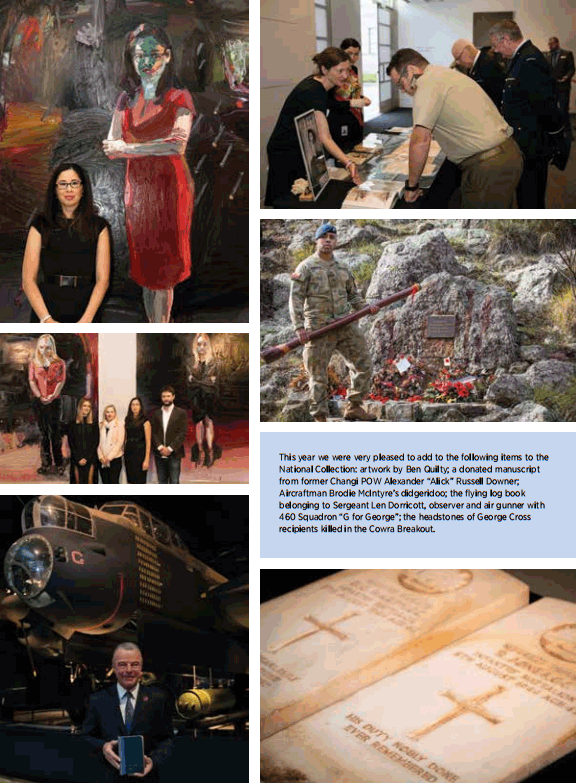
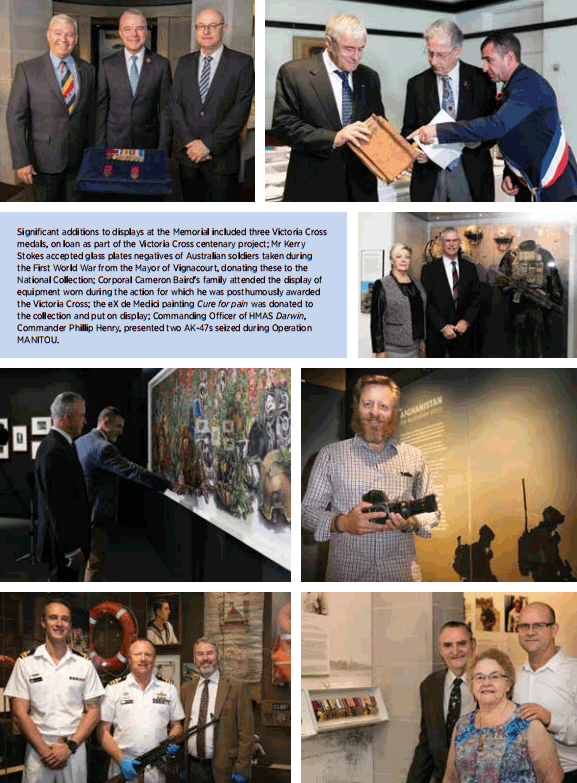
Oral histories were recorded with 7RAR during its preparation for, deployment to, and return from Iraq. Curatorial deployments to the Middle East captured more than 30 interviews with Defence personnel in theatre and 2,000 images, as well as identifying objects for future collecting. The project to capture the history and work of the Joint IED Task Force was extended to include 20 EOD Squadron.
A collaboration in an Australian Research Council (ARC) Linkage Grant with the Australian National University, researching Australians in Borneo during the Second World War is now in its third and final year. The project has involved interviews with Australian veterans, and fieldwork in Borneo with local people telling their stories about experiences with Australians in the Services Reconnaissance Department (SRD) and Z Special Unit. The project will include an exhibition opening in the first quarter of 2018, and has already produced 10,000 pages of new digitised web content, including maps, personal papers, official records, and new additions to the National Collection.
The Memorial’s first musical artist in residence, Chris Latham, was appointed with the support of the Department of Veterans’ Affairs, the Anzac Centenary Arts and Culture Fund, and a private philanthropist. Latham will record music from the Memorial’s rich collection of manuscript music. An initial suite of 100 pieces of music from the First World War will be recorded and the sheet music digitised and released online over the next two years.
We are very grateful to Canberra Airport and Virgin Airlines for displaying our magnificently restored Second World War Lockheed Hudson in the airport terminal. The restoration took five years to complete, and involved the fabrication of 5,000 parts.
In the short term, restoration projects will focus on completion of a Beaufort bomber that saw intense operational service in New Guinea; an OV-10A Bronco flown by Australian forward air controllers in Vietnam serving in USAF squadrons (with the support of a donation from Dick and Pippa Smith); and scoping work to conserve the V2 and its Meillerwagen (with technical and project management support from QinetiQ).
As well as reprogramming the systemic maintenance of the large technology collection, major conservation work was done on the Centurion tank on display outside Anzac Hall, and a Bushmaster protected mobility vehicle and an eightwheeled Australian Light Armoured Vehicle (ASLAV) were conserved for display in the grounds.
Conservation specialists have faced some intriguing challenges, including extensive consolidation treatment to conserve friable paint on artworks, and preparing works for an extended program of display. Textiles conservators have been inspecting, conserving, and repacking the collection in the new Textiles and Small Objects Store, including re-rolling thelargest flags and pennants, and conservation work on some of the oldest and most delicate banners for exhibition.
Paper conservators have been involved in restoring and cleaning a large body of works on paper in preparation for exhibitions and loans, including washing, light bleaching, and removal of adhesives and stains. The impact in revealing original colours and details is often astonishing. Photo conservators and collection managers have rehoused more than 100,000 acetate negatives to ensure their preservation, and 156 glass negatives were conserved for reproduction in a new annotated publication of Charles Bean’s Western Front diaries being written by Peter Burness AM.
Spirit of Anzac Centenary Experience
Staff from the National Collections branch travelled to the 23 locations that housed the national tour of the Spirit of Anzac Centenary Experience travelling exhibition to ensure that artefacts from the Memorial’s collection received appropriately care. All artefacts from the travelling exhibition have now been returned safely to the Memorial, demounted from their display cases, assessed by conservation staff, treated where necessary, and returned to long-term storage.
SPOTLIGHT
Contemporary art donation provides new perspectives on death and commemoration
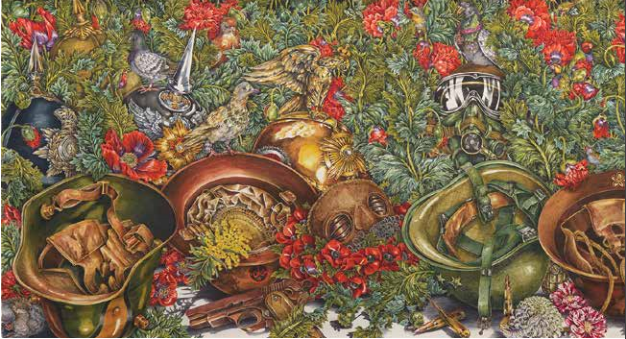
Measuring just over four metres long, eX de Medici’s painting Cure for pain appears as a lush garden composed of military helmets and masks, poppies, roses, and other flowers. Flitting among the flowers, or perched on helmets, are birds, including nightingales, finches and pigeons. Yet, far from an idyllic paradise, these symbols represent over a century of conflict in which Australia has been involved. Acknowledging both enemies and allies, Cure for pain is an expression of our common mortality, and our equality in death. Military hardware has long been a key feature of de Medici’s work, and this prompted her appointment as an official war artist to the Regional Assistance Mission to the Solomon Islands in 2009. De Medici created a body of work that responded to the legacy of colonisation, the impact of the Second World War, and the role of Australian peacekeepers. Cure for pain continues that work as an official war artist, but broadens its scope to encompass Australian military history from the colonial era to the present.
The military helmets evolved from de Medici’s earlier use of the skull, which had been a feature of her watercolours since the late 1990s. However, the proliferation of skulls in popular culture led her to a reworking of this symbol. Skulls had saturated the contemporary art world and had become SPOTLIGHT Contemporary art donation provides new perspectives on death and commemoration a useful marketing tool; from highbrow fashion to a print motif on children’s clothes in department stores, the skull had become a trite commodity. The skull had lost the force it once had as a central symbol in 17th century vanitas paintings, where it represented the transience of life and the vanity of human wishes; so de Medici was prompted to evolve the skull metaphor into the representation of a helmet. She expanded on this notion in an interview with the Memorial on 6 May 2010:
“The helmet sits at the same point as a skull. It is a skull. It is the exoskeleton of a skull. It’s a mask. It’s an instrument for other purposes that can cloak identity, for instance, which was my first use of it: the disguise of identity in aggressive situations.”
That same year, she began a series of watercolours devoted to military helmets, including Cure for pain.
The helmets signify different conflicts in which Australia has been involved, starting on the left of the work with two Australian colonial helmets, referring to frontier conflicts as well as representing Australia’s involvement in early international military conflicts. There are five helmets from the First World War, two helmets related to the Second World
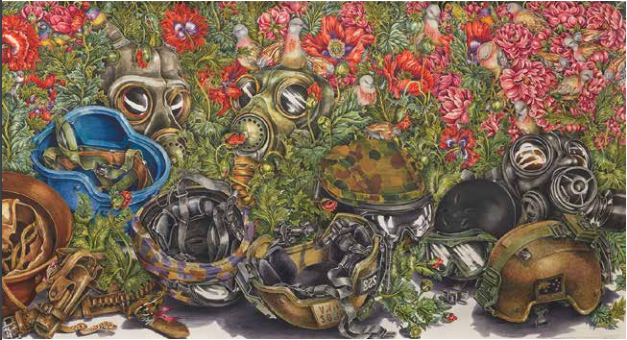
War, two gas masks, and a range of helmets and goggles related to post-1945 conflicts and peacekeeping operations.
The helmets demonstrate the evolution of combat helmet design over more than a century. Like de Medici’s moth studies at the Commonwealth Scientific Industrial Research Organisation (CSIRO), and her ongoing series portraying weapons, these helmets have the appearance of specimens. De Medici’s meticulously drawn helmets reflect her key observations that the helmet is both a mask and a metaphor for a skull, and that it serves as a contemporary vanitas representing death, violence, and commemoration.
Cure for pain was generously donated to the Memorial – through the Australian Government’s Cultural Gifts Program – by Erika Krebs-Woodward in 2016 and is on display as partof the exhibition The deceiving eye, located on the Mezzanine Gallery of Anzac Hall until 11 September 2017.
eX de Medici, Cure for pain, 2010–2011, watercolour on paper, 114 x 415 cm, ART96843
AWM Licensed copyright
PORTFOLIO BUDGET STATEMENTS
PERFORMANCE TARGET
The number of new items acquired, in accordance with the Collection Development Plan.
RESULT Met
A total of 5,366 new items were acquired in accordance with the Collection Development Plan
Memorial Integrated Collection Access (MICA)
The Memorial Integrated Collection Access (MICA) system is the collection management system used for the recording of all items accessioned to the National Collection, as well as other items such as the education collection, plaques, etc. Other Memorial systems such, as the Memorial website and the Digital Asset Management System (DAMS), rely on information from MICA to complete business functions.
An “object record” within MICA can contain numerous individual items. For example, the Memorial’s iconic “G for George” Lancaster bomber, while being a single “record” within MICA, contains many individual items, each detailing a different component of the aircraft such as its fuselage, wings, propellers, engine, etc.
2,396 object records (12,301 items) were added to MICA, and to the National Collection, in the 2016–17 financial year.
Acquisitions
Throughout the year, the Memorial continued its work in growing the National Collection and gathering artefacts and historically important items to tell the story of Australia’sexperience in war. Many interesting and unique pieces were accessioned during the year, including:
Sandakan letter
A letter written to Sandakan prisoner of war Herman “Algie” Reither by his mother in late June 1943. The letter came into the care of Sandakan death camp survivor Bill Sticpewich when Algie died after the two escaped from Ranau together. The letter was preserved in a New Testament and describes the comings and goings of different people from his extended family. It tells of his mother’s declining health, farming difficulties, and news from home.
eX de Medici artwork
The artwork entitled Cure for pain was donated through the Australian Government’s Cultural Gifts Program by Erika Krebs-Woodward.
Restored Royal Enfield
A restored Royal Enfield motorcycle originally issued to Lark Force at Rabaul was donated under the Cultural Gifts program. The motorbike is thought to have returned to Australia just weeks before the Japanese invasion.
World Trade Centre images
Two photographs of the World Trade Centre attacks on 11 September 2001 which have rarely been available on the commercial market, come from a series captured by Associated Press Photographer Richard Drew and are some of the most important images captured on that awful and portentous day. The images depict the collapse of the south tower and people falling through the air, having jumped to escape the heat from one of the burning World Trade Centre towers.
Phillip Schuler portrait
This significant portrait of Melbourne Age war correspondent and great friend of Charles Bean, Philip Schuler (1889–1917), was acquired from a private seller. As war correspondent for the Melbourne Age, Schuler enlisted following his time as a war correspondent and was commissioned as a lieutenant. Wounded in action at the battle of Messines, he died of wounds on 23 June 1917.
“G for George” log books
Log book owned by Sergeant Len Dorricott 460 Squadron, detailing flights of “G for George”.
Dioramas
In 2016, contemporary artist Richard Lewer was invited to produce a new body of work in response to the Australian War Memorial’s collection for the Art Gallery of South Australia’s exhibition Sappers and shrapnel: contemporary art and the art of the trenches. Lewer’s dioramas serve a different purpose to those initially commissioned by the Australian War Memorial in the 1920s: they focus closely on individuals or groups of soldiers, suspending moments in time to capture the daily routine of troops and their surroundings. These six dioramas serve as small sites of empathic re-enactment and present an engaging contemporary response to the topic of remembrance and how we remember Australia’s involvement in the First World War.
Sculptures
Two early sculptures by renowned sculpture and former RAAF officer Robert Klippel, No. 11 Grief and No. 9 Anguish, were made in 1944 as Klippel was transitioning from being a model maker for the RAAF to a professional artist. They represent his experience of serving in the Second World War and losing his brother in combat.
Sidney Nolan painting
The remarkable work by renowned artist Sidney Nolan depicts Simpson and his donkey. Nolan completed this work as part of a large series of paintings on the subject of Gallipoli, most of which depicted soldiers and landscapes. While other wellknown depictions of Simpson picture the soldier astride or alongside his donkey, Nolan’s work features Simpson carrying the donkey across his shoulders. This painting was generously donated to the Memorial by Margaret Favilla.
Escape map
This Belgian map was used by Lance Corporal Frederick Peachey during his escape from German captivity in 1917, during the First World War. The escape route used by Peachey is drawn onto the map and there are more annotations on the reverse side. Also included are postcards sent by the Australian Red Cross Prisoner of War Department to Peachey after his capture at Bullecourt on 11 April 1917. The postcards never reached Peachey as he escaped before internment in Germany.
PORTFOLIO BUDGET STATEMENTS
PERFORMANCE TARGET
The number of items disposed of, in accordance with the Collection Development Plan.
RESULT Met
PORTFOLIO BUDGET STATEMENTS
PERFORMANCE TARGET
Grow the number of items for which documentation has been enhanced or corrected.
RESULT Met
PORTFOLIO BUDGET STATEMENTS
PERFORMANCE TARGET
At least 80 per cent of the collection in storage that meets conservation standards for environmental conditions.
RESULT Met
CORPORATE PLAN
STRATEGIC PRIORITY:
Creating and sharing knowledge, expertise and the National Collection.
PORTFOLIO BUDGET STATEMENTS
PROGRAM COMPONENT 1.4
EXHIBITIONS
assist Australians remember the Australian experience of war and its enduring impact on society.
OVERVIEW
The project to update the Conflicts 1945 to today galleries was completed in early October 2016, as planned. The new permanent exhibition significantly enhances the Memorial’s coverage of Australian involvement in the Middle East, including: the First Gulf War; Operation Habitat; Maritime Interception Force; United Nations’ weapons inspections; and the wars in Afghanistan and Iraq. In response to stakeholder feedback, changes to the First Gulf War section of the new displays were implemented. Soon after the launch of the revamped galleries, three major works by Artist Ben Quilty were installed at the entrance to the Conflicts 1945 to today galleries. The works were completed in 2016 and portray family members of Australian soldiers who were killed or suffer post-traumatic stress disorder (PTSD) as a result of their service.
AFGHANISTAN: THE AUSTRALIAN STORY
In October 2016, the Memorial launched the Afghanistan: the Australian story DVD. Directed and narrated by leading Australian journalist Chris Masters, the two-disc DVD includes a 50-minute feature documentary and extracts of the 38 interviews conducted with current and former Australian Defence Force personnel and their families. It also contains film and photographs drawn from the Memorial’s Afghanistan: the Australian story exhibition. The Memorial took the opportunity to include new material that has become available since the exhibition was developed in 2013, particularly through the Department of Defence. Eleven new interviews were conducted by Chris Masters, focusing on the role of Special Forces in Afghanistan, an under-represented aspect of the current exhibition. New content collected and interviews conducted during the development of the DVD are currently being used to update the gallery experience. The updated version of the audio visual experience is due for completion in July 2017.
GALLERY UPDATES
Second World War galleries
Completed at the end of 2016, recent work in the Second World War galleries includes the rearrangement of large objects to address visitor circulation issues and to reposition the LePkw Type 82 Kubelwagen and BMW motorcycle which have been subject to damage due to their open display. A new low-level two-section plinth with glass barriers for the display of large objects (the tankette; the BMW motorcycle; the Kubelwagen; the German Flak 38 anti-aircraft gun; and the Chevrolet lorry and Breda anti-aircraft gun) will be part of the changes to the galleries.
The Holocaust exhibit
A new permanent display titled The Holocaust: witnesses and survivors opened to the public in the Second World War galleries in November 2016. The exhibition tells the story of the Holocaust through the experiences of several survivors who made lives in post-war Australia. The exhibition has been developed by the Australian War Memorial with the support of the Jewish Holocaust Centre and includes over 85 collection items from both institutions. Many of these items are original documentation from Jewish men, women, and children who survived ghettos, and concentration and extermination camps.
Hall of Valour
The Victoria Cross Project has sought to display as many of the 100 Victoria Crosses awarded to Australians as possible in the Hall of Valour during the Centenary. So far, with the support of private owners and other cultural institutions, 82 Australian Victoria Crosses are on display at the Memorial. During the course of this project, the Memorial has acquired nine Australian Victoria or George Crosses for the National Collection:
- Corporal Lawrence Carthage Weathers VC
- Lieutenant Chalmers Borella VC MM
- Sergeant Samuel George Pearse VC MM
- Warrant Officer Class II Keith Payne VC AM
- Sergeant James Rogers VC
- Sergeant John Woods Whittle VC DCM
- Private Horace William Madden GC
- Lieutenant Arthur Gerald Bagot GC DSC
- Captain Lionel Colin Matthews GC MC
The Victoria Cross and medal group awarded to Private Reginald Roy Inwood VC (First World War) was demounted and returned during this period. Other changes to the space include the inclusion of the Order of Australia awarded to Keith Payne VC, and the display of the pistol belonging to Second Lieutenant Frederick Birks VC MM.
A new display featuring the uniform items and weapon of Corporal Cameron Baird VC MG alongside the uniform and weapon of Corporal Ben Roberts-Smith VC MG was unveiled in the Hall of Valour on 14 September 2016. Corporal Baird was killed in the final moments of an assault in the Afghan village of Ghawchak on 22 June 2013. The new display features items of his uniform and the damaged M4 carbine he was using during the operation. The VC for Baird’s action was the first awarded to a member of an Australian commando unit and has been on display in the Hall of Valour in 2014.
Anzac Hall
A project to update two new permanent displays in Anzac Hall commenced in early 2017. The first exhibition is centred on the Mark IV tank and focuses on the evolution of tanks during theFirst World War. The exhibition is due for completion in July 2017.
The second exhibition is related to the battle of Milne Bay. Fought between 25 August and 7 September 1942, the battle is often described as the first decisive Allied victory over Japanese forces in the Pacific. The new permanent exhibition focuses on this significant battle and will include key objects including the captured Japanese Ha Go tank and battle relics. The launch of the display is scheduled to coincide with the 75th anniversary of the battle in August 2017.
OTHER GALLERIES
Eight displays of works on paper were completed, featuring in each of the permanent galleries. Four displays were changed over in the Reading Room, one focusing on Vietnam Veterans Day, and three focused on the 75th anniversary of the Memorial. Minor works to the display infrastructure
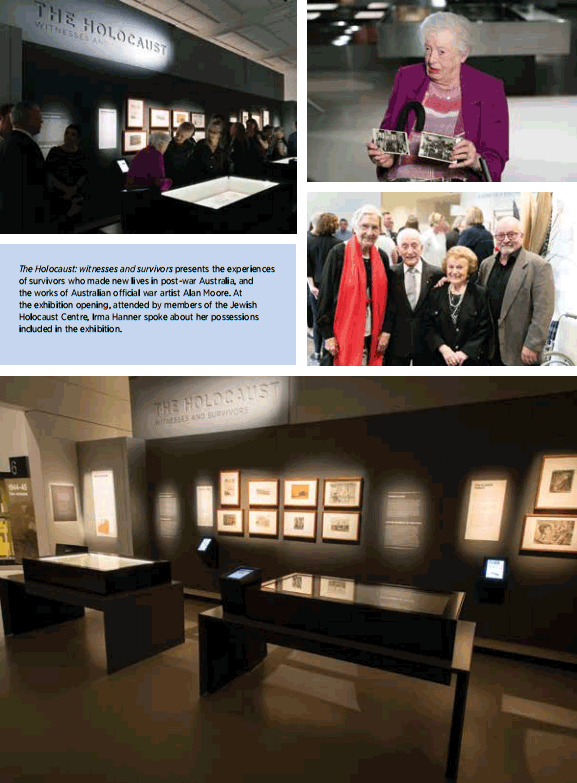
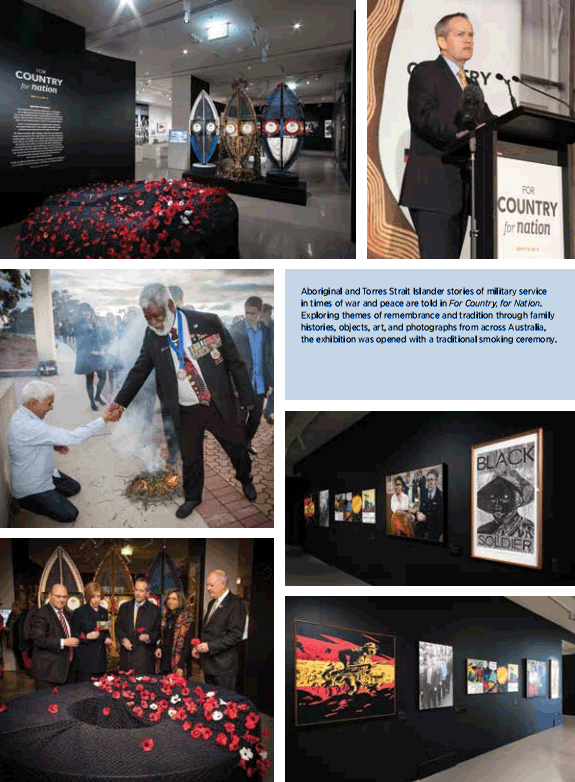
Eight displays of works on paper were completed, featuring in each of the permanent galleries. Four displays were changed over in the Reading Room, one focusing on Vietnam Veterans Day, and three focused on the 75th anniversary of the Memorial. Minor works to the display infrastructure and showcases were implemented in the Reading Room to coincide with the commencement of the 75th anniversary series of displays.
Three small displays have been installed in the Captain Reg Saunders Gallery including an art and work on paper display supporting the commencement of the 75th anniversary of the Memorial, a photographic display titled A good little chap: Herbert Baldwin which included framed photographs and a small selection of film and objects, and Badhu Koewbu Kidhal, World War story as its told. The current display includes five works by Badhulgaw Kuthinaw Mudh (Badu Art Centre) on Badu (Mulgrave Island) in the Zenadh Kes (Torres Strait) that interpret Torres Strait Islander service during the Second World War and its enduring legacy for the Badu community.The works were commissioned by the Memorial in 2016.
A strong focus on maintaining the high standard of the Memorial’s 10,000 square metre exhibition space was continued throughout the year. Minor building works included the refurbishment of the Anzac Hall link bridge, mezzanine, viewing platform, and staircase which was completed in September 2016. Refurbishment of the space included the removal of the permanent Anzac spirit exhibition to enable the space to be used for temporary exhibitions. Continued evelopment and modernisation of all gallery audio-visual infrastructure has yielded more reliable and flexible displaysand provided a platform for future development.
TEMPORARY EXHIBITIONS
Mephisto: The devil’s chariot
To commemorate the centenary of the First World War, the temporary exhibition Mephisto: the devils chariot, continued throughout 2016–17 until closing to the public on 28 May 2017. The only surviving German tank from First World War, “Mephisto” was displayed at the Memorial for two years before returning to Brisbane in June 2017. Development of a new permanent display focused on the Mark IV tank has commenced and will open to the public early in 2017–18.
WW1 Avenue of honour
The Memorial launched two temporary exhibitions in the refurbished mezzanine in Anzac Hall. The first exhibition, WW1 Avenue of honour: Trent Parke, opened on 9 September 2016, featuring a series of images photographed at the Ballarat Avenue of Honour by Australian photographer Trent Parke. In 2014 Parke was invited to participate in the international exhibition The First World War now, presented by the renowned Magnum Photos agency in Bruges, Belgium, to mark 100 years since the German army’s invasion of the city. In response, Parke produced a series of images photographed at the Ballarat Avenue of Honour, the longest avenue of honour in Australia and one of the earliest known memorial avenues planted in Victoria during the First World War.
The deceiving eye
On 21 March 2017, a new temporary exhibition, The deceiving eye, opened to the public for a period of six months. The exhibition features previously unseen camouflage photographs by Australian artist Frank Hinder that document his experiences in developing camouflage suitable for the Australian environment. The exhibition also focuses on the recently donated work Cure for pain, by artist eX de Medici, which explores Australia’s military history and demonstrates the evolution of combat helmet design and camouflage over the last century. A small selection of objects including a “Yowie suit” for camouflage is also displayed.
Reality in flames: modern Australian art and the Second World War
The Special Exhibitions Gallery featured two new exhibitions. Reality in flames: modern Australian Art and the Second World War explored Australian modernist artists’ creative responses to the Second World War featuring 90 works of art by important Australian artists including Albert Tucker, Russell Drysdale, William Dobell, and Stella Bowen. Reality in flames closed on 4 September 2016.
For Country, for Nation
For Country, for Nation opened to the public on 23 September 2016. The exhibition is the culmination of a significant body of research undertaken by the Memorial to discover the identities and stories of what are believed to be several thousand Indigenous men and women who served in our armed forces since and before Federation. The exhibition recognises the valuable and selfless military service of Aboriginal and Torres Strait Islander peoples, and their contribution to the Anzac legend.
The Memorial is the custodian of a diverse range of cultural material relating to Indigenous service. The mediums of text, story, art, objects, photographs, dance, and music are used within the exhibition. The exhibition draws heavily on the Memorial’s Indigenous art collection. A significant aspect of For Country, for Nation was the commissioning of Indigenous artists to tell their stories of family and community connections to the defence of Australia. Recently commissioned artists include Andrew Snelgar, Vicki West, Gabriel Nodea, Patrick Freddy Puruntatameri, Glenda and Marilyne Nicholls, and Clair Bates.
From the shadows: Australia’s Special Forces
Development of the special exhibition From the shadows: Australia’s special forces continues. The exhibition will cover the history and development of special forces from the Second World War to the present day, and focus on the capabilities of special forces operators, their role abroad and at home, and what they have done. The exhibition is being developed in collaboration with Special Operations Command Australia and will include a number of loaned objects from units under the command of Special Operation Command (SOCOMD), individuals, and the Memorial’s collection. The exhibition will open to the public in September 2017.
Aftermath: the consequences of war
Development of the special exhibition Aftermath: the consequences of war (working title) commenced in December 2016. Opening to coincide with the centenary of the Armistice in 2018, the exhibition will cover the past 100 years – from the end of the First World War to the present day.
A home on a southern hill exhibition series
The exhibition series A home on a southern hill was developed to mark the 75th anniversary of the opening of the Australian War Memorial on Remembrance Day 1941. Unfolding over the 75th anniversary year of the Australian War Memorial, A home on a southern hill is a series of exhibitions which tell the story of how the Memorial was brought to being, as well as exploring its history and continuing relevance. The series takes its name from a poem written by Will Dyson to accompany his 1928 cartoon, Calling them home, which depicts a ghostly bugler calling the spirits of Australia’s war dead to the yet-tobe-built Memorial.
They dreamed of leave that never came.
Now each man is a living fame.
But dreams it still. They dream of a call to a
last route march, Back to a land where the grey
gums arch. To a home on a Southern hill.
The first exhibition in the series, (November 2016 to April 2017) told the story of the Memorial building from C.E.W. Bean’s initial sketch, through the 1925 architectural competition and the set-backs and controversies of the 1930s, to its official opening on 11 November 1941. The exhibition series continues with To heal the nation (May–July 2017), which considers the ways in which C.E.W. Bean’s experiences shaped his vision for the Memorial and reflects on the nature of commemoration. The third exhibition in the series, The Memorial in landscape, which focuses on the siting and landscaping of the Memorial, will be presented from August to late October 2017, in order to coincide with Floriade 2017, before its conclusion over summer with Telling their stories, which will explore how the Memorial communicates the Australian experience of war.
TOURING EXHIBITIONS
Development of a national tour for the special exhibition For Country, for Nation is underway as part of the revitalisation of the Memorial’s Touring Exhibitions program. A national tour to capital cities and regional venues is expected to commence in April 2018.
The 2016–18 extension tour of Remember me: the lost diggers of Vignacourt commenced in December 2016. The exhibition was displayed at the Glasshouse Gallery, Port Macquarie, NSW (17 December 2016 to 5 February 2017), and the Pinnacles Gallery, Townsville, Qld (25 February 2017 to 30 April 2017). The exhibition achieved a total visitation of 14,315. Rememberme will tour to a further six venues over the next 18 months.
To Flanders fields, 1917 the second exhibition in the Australians on the Western Front 1916–1918 series was produced in two sets to tour to metropolitan and regional club venues, as part of the continuing relationship between the Memorial and the NSW RSL and Service Clubs Association.
THE SPIRIT OF ANZAC CENTENARY EXPERIENCE
The Spirit of Anzac Centenary Experience (SACE) was the flagship community event of the Australian Government’s Anzac Centenary national program. The Anzac Centenary Travelling Exhibition, which would eventually become Spirit of Anzac Centenary Experience, was first officially proposed in the report of the National Commission on the Commemoration of the Anzac centenary in March 2011. The proposal for a travelling exhibition was endorsed by the Anzac Centenary Advisory Board in its Report to Government in March 2013, noting that a travelling exhibition “could be a flagship Anzac centenary project”.
In early 2014 the Australian War Memorial contracted Imagination (Australia) Pty Ltd as the creative designer for a national travelling commemorative exhibition to tour to all states of Australia and the Northern Territory. In late 2014 Commonwealth Bank and Telstra committed significant funding and resources to further develop the project.
The SACE was delivered by a partnership between Department of Defence, Department of Veterans’ Affairs, Australian War Memorial, Commonwealth Bank, and Telstra. Governance of the project was overseen by the Spirit of Anzac Centenary Experience Executive Committee Chaired by the Envoy the Honourable Tim Fischer AC, with the Memorial represented by Dr Brendan Nelson AO. The operations of the project were managed by a Steering Group of the partners with the Memorial represented by Major General Brian DawsonAM CSC (Retd). The SACE project was funded by the deed partners in accordance with the Partnering Deed.
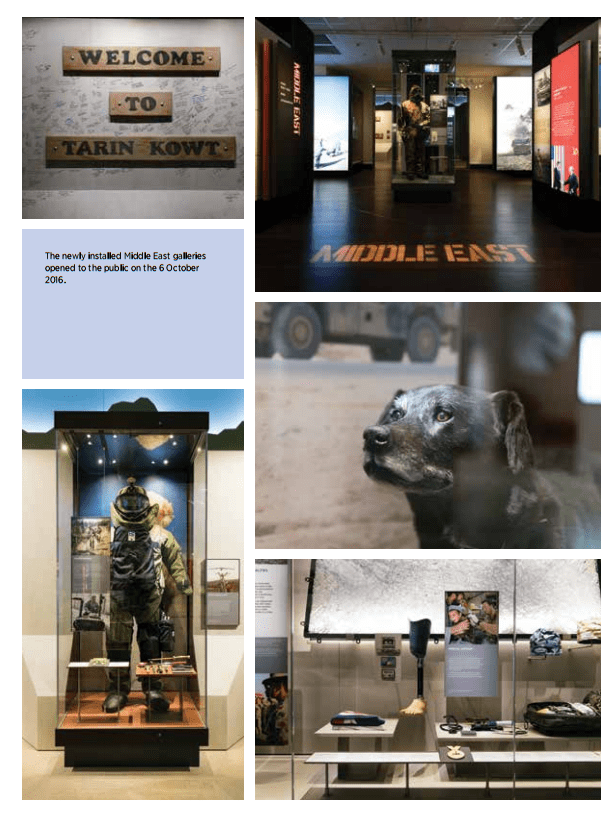
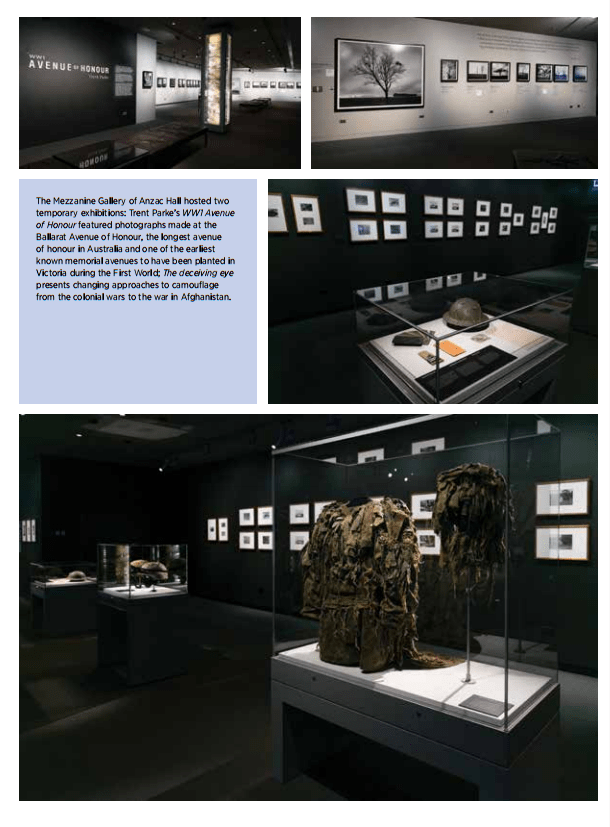
"Brilliant exhibition. Congratulations to all involved including the sponsors. This should be compulsory for all high school kids. Charles Bean would be proud."
Tim Scott, Facebook, 22 April 2017
SACE was developed by Imagination (Australia) Pty Ltd in close consultation with the Australian War Memorial over a period of 14 months. The exhibition was designed to be highly experiential, with interactive technology employed throughout, allowing Australians around the country to see first-hand over 200 First World War artefacts from the Memorial’s national collection, and interpretive materials spanning the wars, conflicts, and peacekeeping operations in which Australia has been involved.
SACE was launched on 4 September 2015 in Albury-Wodonga and over the following 19 months toured another 22 locations across Australia: Launceston, Hobart, Ballarat, Bendigo, Wollongong, Melbourne, Adelaide, Tamworth, Toowoomba, Brisbane, Mackay, Cairns, Townsville, Darwin, Port Augusta, Perth, Bunbury (Eaton), Kalgoorlie-Boulder, Geelong, Orange, Newcastle and Sydney. Across all the tour locations a total of 368,016 people attended, including 49,707 students in school groups.
Memorial staff travelled to each location to ensure the Memorial’s National Collection items were appropriately cared for, particularly during bump-in and bump-out at each of the venues. All items have been returned safely to the Memorial.
SACE was very well received, with 99 per cent of attendees who responded saying that they would recommend SACE to friends and family. Of comments received, 94 per cent were unreservedly positive, and 5 per cent were positive with suggestions or constructive criticism. SACE achieved a Net Promotor Score (NPS) of 85.
The Memorial’s financial contribution to the project was made from the $10 million seed funding provided by government in 2013.
No major incidents occurred during the life of the project. All incidents were reviewed by the Project Security and WHS Working Group, and where appropriate mitigation strategies were put in place. No claims have been made in relation to any incident and there is no reason to believe that any claim is to be expected.
PORTFOLIO BUDGET STATEMENTS
PERFORMANCE TARGET
The total attendance at Memorial exhibitions and touring exhibitions.
RESULT Met
Approximately 1.04 million people engaged with the Memorial’s exhibitions in the reporting period:
Entry point Visitors
| Main site front gate entry | 884,177 |
| Students and accompanying teachers | 145,927 |
| Touring exhibitions | 14,454 |
PORTFOLIO BUDGET STATEMENTS
PERFORMANCE TARGET
Qualitative or quantitative evidence about increases in visitors’ understanding, causing attitudinal change.
RESULT Met
The Mephisto Visitor Survey concluded with the return of the tank to Brisbane. The final survey result reinforced that the display had a strong and positive impact upon visitors.
- 99 per cent of those interviewed liked seeing such a rare object, 77 per cent strongly agreed.
- 95 per cent agreed that the display had demonstrated the dramatic impact of technology on land warfare.
- 95 per cent felt that the display had improved their knowledge about the use of the A7V tank.
- 82 per cent felt it provided a realistic insight into Australian encounters with the Mephisto tank on the Western Front.
- 72 per cent agreed or strongly agreed that the display gave them a better understanding of the Australian experience of war.
PORTFOLIO BUDGET STATEMENTS
PERFORMANCE TARGET
Permanent exhibitions developed and maintained to the highest standards.
RESULT Met
During the past year, 27 exhibitions and smaller displays were developed and implemented in the Memorial’s permanent galleries. Key exhibitions included Mephisto: the devil’s chariot, Reality in flames: modern Australian art and the Second World War, and the external display of the Bushmaster Protected Mobility Vehicle.
In addition to new exhibitions and displays, a strong focus on maintaining the high standard of presentation in the Memorial’s existing 10,000 square metre exhibition space continued. Key achievements included a renewal of external way-finding signage, the rebuild of audio and intelligent lighting systems for major sound and light shows in Anzac Hall, and the progression of the systematic installation of highly efficient LED lighting throughout the galleries.
Satisfaction ratings for the Memorial’s permanent galleries which have included development or upgrade works were as follows:
- 99 per cent “satisfied” with Commemorative Area (83 per cent “very satisfied”)
- 99 per cent “satisfied” with First World War galleries (84 per cent “very satisfied”)
- 99 per cent “satisfied” with Anzac Hall (83 per cent “very satisfied”)
- 92 per cent “satisfied” with temporary exhibitions (72 per cent “very satisfied”)
- 98 per cent rated Mephisto: the devil’s chariot exhibition as “very good” or “good” (62 per cent “very good”).
PORTFOLIO BUDGET STATEMENTS
PERFORMANCE TARGET
A minimum of one exhibition displayed per year in the Special Exhibitions Gallery.
RESULT Met
The Special Exhibitions Gallery features two displays in 2016–17; Reality in flames: modern Australian art and the Second World War and For Country, for Nation. Full details on these exhibits can be found under “Temporary Exhibitions”.
CORPORATE PLAN
STRATEGIC PRIORITY:
Commemoration of the Australian experience of war.
PORTFOLIO BUDGET STATEMENTS
PROGRAM COMPONENT 1.5
INTERPRETIVE SERVICES
assist Australians remember the Australian experience of war and its enduring impact on society.
Understanding of A ustralia’s experience of war is enhanced through provision of interactive interpretation, including school and public education programs and public events.
OVERVIEW
Staff from across the Memorial delivered a diverse range of programs, including gallery and collection talks, and behindthe-scenes curator tours. A weekly story-time program was delivered for pre-schoolers and school holiday tours, and hands-on programs were available for families. Museum theatre performances and summer film screenings continued to attract strong visitor numbers. Performer Brett Hunt returned this year to deliver his performances for school students, the First World War – themed Fightin’ the Kaiser and Vietnam-focused Dusted off.
A new online resource, A very special day, has provided young learners and their teachers with information and activities related to the symbols and ceremonies connected with commemoration. This resource has already attracted over 4,000 visitors.
Late-night openings of the Commemorative Area were undertaken on Friday and Saturday evenings in January, enabling visitors to view the illuminated Hall of Memory and pay respect to the fallen during the centenary of the First World War.
In 2016–17 145,927 school visitors (students and accompanying adults) visited the Memorial in the reporting period, with almost 89 per cent undertaking facilitated education programs linked to the Australian curriculum. These programs have been expanded to incorporate the learning statements of the new Australian curriculum: civics and citizenship. In particular, they explore Australia’s role as a global citizen, and Australians’ willingness over more than a century to serve to ensure that democratic freedom continues.
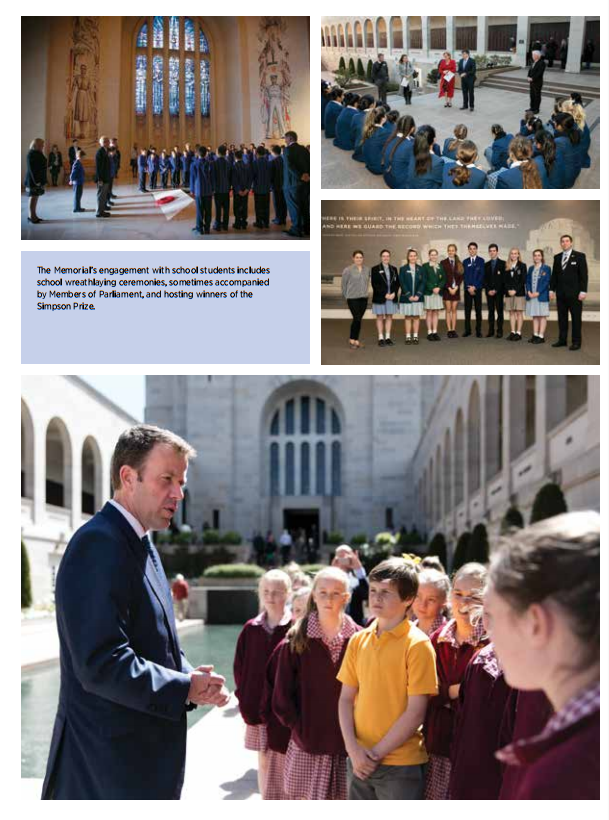
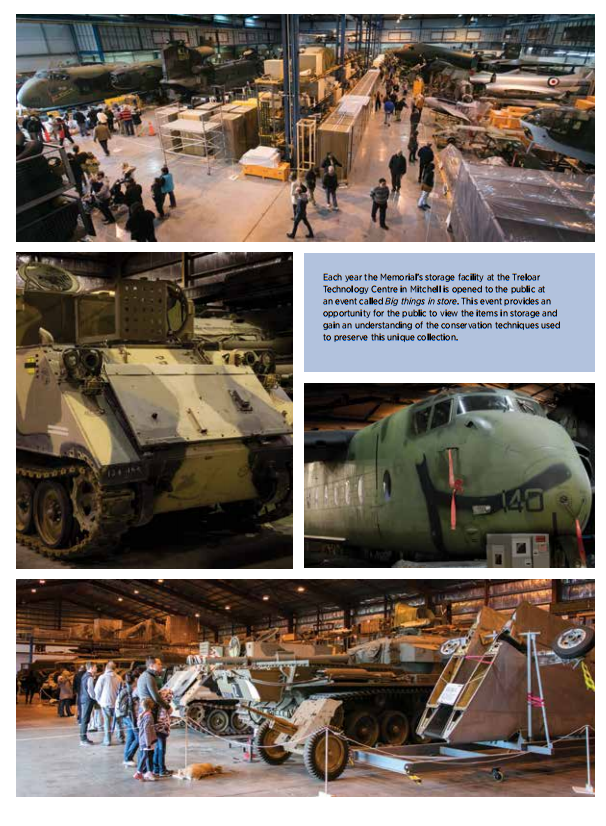
PORTFOLIO BUDGET STATEMENTS
PERFORMANCE TARGET
The total attendance figure at Memorial public programs.
RESULT Met
| Type | Quantity | Attendees |
|---|---|---|
| Education programs | 2,079 | 118,432 |
| Public programs (incl. interpretive programs, gallery talks, and tours) | 550 | 17,529 |
| Tours (incl. public highlight tours and privately conducted tours) | 4,288 | 63,023 |
| Events | 20 | 6,368 |
| Off-site programs (incl. Memorial Box loans) | 377 | 45,240 |
| Off-site tours (incl. Mitchell precinct tours) | 44 | 629 |
| Off-site events | 24 | Not available |
| TOTAL | 7,382 | 251,221 |
Each day a minimum of 12 free highlight tours of the Memorial were conducted by voluntary guides. These attendance numbers are included within “Tours”.
In 2016–17 more than 19,840 general visitors and students participated in the Memorial’s interpretive programs and events. Another 130,339 engaged with online learning resources.
PORTFOLIO BUDGET STATEMENTS
PERFORMANCE TARGET
Qualitative or quantitative evidence about increases in participants’ understanding.
RESULT Met
The Museum audience is diverse with differing needs and expectations for a memorable visit. Public programs help enliven exhibitions and provide a personal connection for those who prefer a more social and interactive learning experience.
Satisfaction ratings for Memorial interpretive programs are attained through the General Visitor Survey. Talks and presentations, theatre performances, and guided tours received the highest satisfaction ratings this year. The percentage of those satisfied or very satisfied in each category, is shown below:
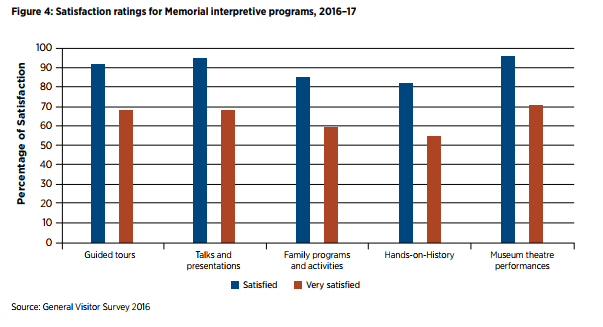
PORTFOLIO BUDGET STATEMENTS
PERFORMANCE TARGET
Qualitative or quantitative evidence of affective or attitudinal change.
RESULT Met
“Presenters were engaging. A wonderfully informative experience that brought about a deeper understanding of the sacrifices made by our troops.”
Whitsunday Anglican School, Qld, Years 7–8, 15 September 2016
“Education guide was knowledgeable and able to maintain attention of students. Engaging.”
Orana Heights Public School, NSW Years 5–6, 15 September 2016
“The educator guide was fabulous. We always come away with a feeling of sadness, pride and also optimism.”
St John the Baptist Catholic Primary School, SA, Years 7–8, 19 October 2016
“Fantastic information – connection to Blacktown was very valuable to the children’s understanding.”
Blacktown South Public School, NSW Years 5–6, 18 October 2016
“Great stories. Really helps enable students to relate personally.”
Tranby College, WA, Years 7–8, 15 August 2016
Students from Lilydale West Primary School place a wreath on the Tomb of the Unknown Australian Soldier during their School Wreathlaying Ceremony.
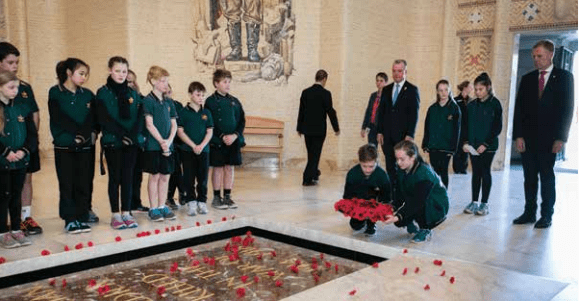
PORTFOLIO BUDGET STATEMENTS
PERFORMANCE TARGET
A range of public programs and events for visitors to the Memorial.
RESULT Met
In 2016–17, 550 public programs were delivered in the galleries to just over 17,520 visitors. The involvement of staff from across the Memorial ensured that the programs were diverse, engaging, and suitable for a variety of audiences. They included collection-based talks; curator-led tours; film screenings; behind the scenes art, research centre, and collection focused tours; and professional museum theatre performances exploring the role of women in wartime.
There was also a popular range of programs that catered for young visitors, including family tours, story time, holiday workshops, craft, and Hands-on history, an interactive activity based on the principles of haptic learning.
Hands-on history and craft is popular with kids visiting the Memorial's Discovery Zone.
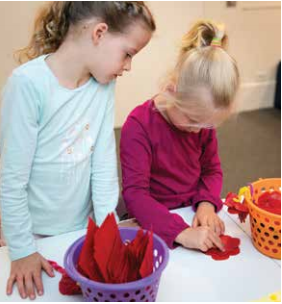
PORTFOLIO BUDGET STATEMENTS
PERFORMANCE TARGET
A series of quality, engaging, curriculum-related school education programs for on-site education programs.
RESULT Met
Facilitated learning programs at the Australian War Memorial are engaging educational activities for school students, aged from preschool to Year 12. Programs are developed according to the Australian curriculum for History, and Civics and Citizenship, and are designed to assist students to remember, interpret, and understand the Australian experience of war and its enduring impact on Australian society.
As part of the Anzac Legacy program, students participate in the centenary Commemorative Crosses project. Students write personal messages on small wooden crosses, which are sent overseas and placed on the graves of Australians who died in war and were buried on foreign soil.
In 2016–17, 132,822 students visited the Memorial, with approximately 89 per cent, or 118,338 participating in a facilitated program.
PORTFOLIO BUDGET STATEMENTS
PERFORMANCE TARGET
Memorial Boxes for schools in all Australian states and territories to borrow during the year.
RESULT Met
The Memorial Box program remains a highly-requested and well-regarded outreach learning resource. The 97 themed boxes administered by Education staff and state agents cover conflicts from the First World War to today. They contain case studies along with hands-on items such as uniforms, medals, badges, and publications. To expand the reach of the boxes, the case studies for boxes 1 and 3, which were redeveloped in 2015–16, are available on the Memorial’s website.
“Thank you so much for supporting our students. The memorial box was great. Students were surprised and moved and informed by its contents.”
St. Monica’s College, Vic, March 2017
“Great resource! The students learnt a lot from having hands on articles to see and touch.”
Kingswood South Public School, NSW April 2017
In 2016–17, 377 schools and community groups borrowed a Memorial box reaching an estimated audience of over 45,000 users. Secondary schools make up almost 45 per cent of all borrowers, with primary schools approximately 44 per cent, and community groups, such as public libraries, aged care facilities, and after-school care groups making up the remainder. A survey of Memorial Box borrowers indicated a high satisfaction rate, with an average rating of 8.8 out of 10. The program has been continued thanks to funding from the Department of Veterans’ Affairs.
PORTFOLIO BUDGET STATEMENTS
PERFORMANCE TARGET
A range of quality, engaging, curriculum-related online school education resources for teachers and students
RESULT Met
With the launch of the new website, the Memorial’s education webpages have been simplified and consolidated, making them more relevant and accessible to a wider audience. This year, the digital resource A very special day, was added to the website. This resource provides young learners and their teachers with information and activities related to the symbols and ceremonies connected with commemoration through inquiry learning, short films, interactive displays, and classroom activities. This resource has already received over 4,100 page views. The most popular online resource was Understanding Gallipoli with more than 8,900 page views. The Classroom showcase continues to be a popular site for young Australians to display their creative work. There has been a modest increase to over 130,000 visits to the Education components of the Memorial’s website. A significant component of this (almost 35 per cent) was driven from our Facebook activity. Interest in the “Education at the Australian War Memorial” Facebook page has continued to grow, with the most popular posts being the Invasion of Malaya and the Soldiers in Residence reaching almost 50,000 users.
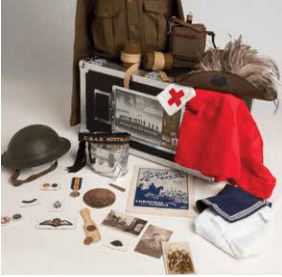
A Memorial Box, filled with uniforms, equipment, and artefacts, puts students in the place of those who served and waited for their loved ones at home.
“It was fantastic. The website is also a wonderful resource. The young students thoroughly enjoyed it.”
Sacred Heart Catholic Primary School, NT, March 2017
Other interpretive activities
The Soldiers in Residence program continued this year with four members of the Australian Army spending three weeks at the Memorial. The program allows veterans to familiarise themselves with both front- and back-of-house operations at the Memorial, and learn about commemoration and collection preservation. Of equal benefit is the soldiers’ openness to share aspects of Australian Defence Force culture and practices that enhances understanding of their experiences.
“I was lucky enough to be selected to attend this program in July with Gnr Simon Hodgson. It was an amazing experience; one I will never forget. The one thing that really struck me during my time at the AWM was how much our service is valued by the public and how interested they are in our stories. We spent time with all of the departments at the AWM. I had no idea there was so much going on behind the scenes.”
Sgt Nick Neleman, October 2016
One of the soldiers, Sergeant Nick Neleman, reflected upon his time at the Memorial in an article in Army, the soldiers’ newspaper, in October 2016. In the article, he spoke eloquently of the experience and his realisation that his service and that of his colleagues, is immensely important and respected. In collaboration with the History Teachers’ Association of Australia, the Department of Education and Training, and the Department of Veterans’ Affairs, the Memorial continued to support the annual Simpson Prize competition. This First World War-themed, national essay-writing competition is for secondary students. Staff researched links to relevant source material from the Memorial’s collection which were providedonline to assist students with their research and writing.
The sixth title in the Century of Service publications series, Comradeship: stories of friendship and recreation in wartime was developed by the Memorial’s Education staff and published in collaboration with the Department of Veterans’ Affairs in June 2017. The third book in the series, Ancestry: stories of multicultural Anzacs, (published in 2015), was runner up in the information category in the Children’s Book Council of Australia Book of the Year Awards in August 2016.
Memorial staff delivered four professional development sessions and familiarisations throughout the year, to 70 school teachers and 25 tour operators. These programsequip teachers to better use the Memorial’s collection and historical content in the classroom, and promote the learning opportunities available on-site and online.
“There is no doubt we are all proud of what our forebears did, but we should also be proud of what we are doing now. No matter how average you consider your service to be, your contribution to this nation’s proud military history is highly valued.”
Sgt Nick Neleman, October 2016
In June 2017, the Memorial hosted a successful one day performance season of Troubie Productions’ Dusted off, and Fightin’ the Kaiser performed in the BAE Systems Theatre by Brett Hunt. Over 400 students and teachers attended three shows.
The Memorial hosted the annual Legacy Youth (formerly Florance Foundation) visit of junior Legatees to the Memorial, this year facilitating 13 students on gallery tours, and at the National Ceremony on Anzac Day.
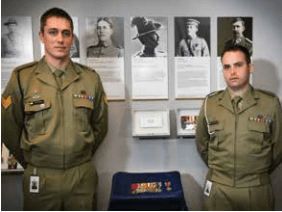
Gunner Simon Hodgson and Sergeant Nick Neleman joined the Memorial as part of the Soldiers in Residence program.
CORPORATE PLAN
STRATEGIC PRIORITY:
Increasing partnerships and organisational sustainability.
PORTFOLIO BUDGET STATEMENTS
PROGRAM COMPONENT 1.6
PROMOTION AND COMMUNITY SERVICES
assist Australians remember the Australian experience of war and its enduring impact on society.
OVERVIEW
The Memorial is focused on providing best practice communications with an emphasis on innovative and integrated digital, marketing and public relations activity. During this reporting period, the Memorial delivered two major communication outcomes: a redeveloped website and a new brand positioning campaign.
The new website is strategically focused on building new audiences for the Memorial. Through the Digital Engagement Strategy we aim to deepen the community’s connection with the service and sacrifice of those who have served our nation.
Following a year of considered development, including extensive stakeholder engagement and market testing, a new national brand positioning campaign was launched in early June. The new positioning statement is “…for we are young and free”. A subsequent campaign has been developed encourage visitation to the Memorial and its website, to reflect on the enduring impact of war.
PORTFOLIO BUDGET STATEMENTS
PERFORMANCE TARGET
An engaging website and social media presence with accurate information.
RESULT Met
The Memorial successfully launched its new website on 30 May 2017. With a large migration of existing content and a new search function that covers the collection and rolls databases, this was a significant achievement. The new site features best practice usability and a clean design and provides greater access to our vast digitised collection. Since launching, the site the Memorial has received active feedback from some users of collection and rolls databases with specific searching needs. A clear road-map for future enhancements and further improved functionality has been developed, including the delivery of advanced search functionality, and access to the previous site. This ensures our researcher user base can access data in a way that they are comfortable with.
PORTFOLIO BUDGET STATEMENTS
PERFORMANCE TARGET
High quality service to media to encourage suitable coverage in all forms of media.
RESULT Met
The Memorial continues to garner enviable media coverage for events, visits, exhibitions and commemorations. High quality content is regularly produced, carefully designed to appeal to the media and the community.
The Memorial continues to liaise closely with media outlets and relevant stakeholders, building on strong existing relationships to leverage coverage which has been overwhelmingly positive. Focus on significant military anniversaries, events and ceremonies, exhibitions, and collection items has ensured the Memorial maintains aubstantial presence across all types of media.
Regular media and public relations activity continues to help promote projects and programs to regional, national, and international audiences.
Throughout the reporting period 37 media releases were created, resulting in a high level of coverage. The media release issued on 14 September 2016, regarding the display of equipment worn by Corporal Cameron Baird VC MG generated significant local and national media interest across print, television, online, and radio. Relationships developed and fostered with media outlets resulted in the Director, as well as curators, historians, and other experts, receiving media opportunities to discuss the work of the Memorial.
Alongside traditional media activity, the Memorial continues to foster excellent working relationships with non-traditional media entities, including documentary, film and program makers, and digital content creators (including The Dead Prussian podcast). The team welcomed numerous international film crews whose content will contribute to broadcasting the Memorial’s mission and purpose to new audiences.
Remembrance Day and Anzac Day
The Memorial received extensive media attention in the leadup to Remembrance Day 2016, including significant coverage of the 75th anniversary of the opening of the Australian War Memorial. An analysis of coverage produced during 9–13 November 2016 found 872 news items, reaching a cumulative audience of 36,140,325.
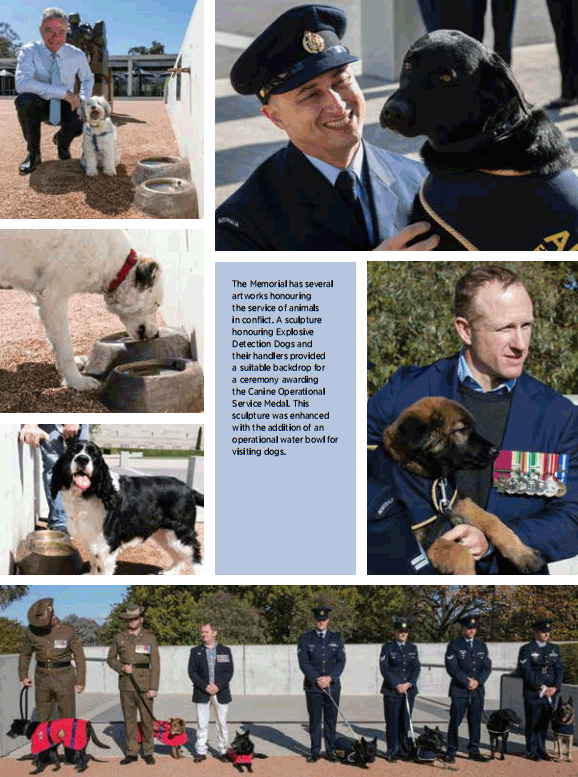
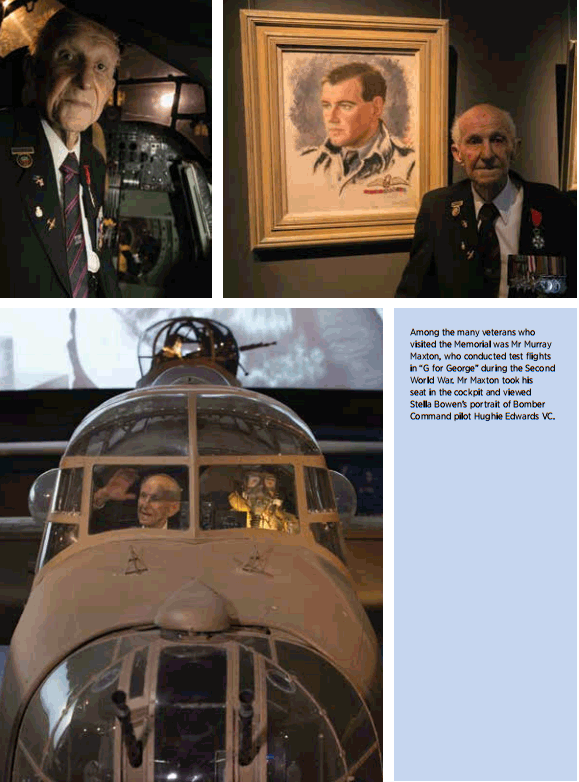
For Anzac Day 2017, media coverage during 24–26 April generated 883 news items across radio, print, television, and online, reaching a maximum cumulative audience of 24,476,835 people.
PORTFOLIO BUDGET STATEMENTS
PERFORMANCE TARGET
High quality marketing and promotional activities.
RESULT Met
During this reporting period, the Memorial embarked on a new national brand positioning campaign, aimed at assisting Australians to reflect on our nation’s experience of war and the stories of our defence force personnel. The campaign builds on the Memorial’s unique position as a place to reflect on the history of Australians in conflict and gain a deeper understanding of what it means to be Australian. A new positioning statement “…for we are young and free” was eveloped for the campaign. It tested well in focus groups and resonated with key stakeholders. The positioning statement features throughout the campaign and aims to encapsulate the Memorial’s unique goal of honouring Australia’s servicemen and servicewomen whilst encouraging audiences to find a personal connection to their stories of service and sacrifice.
The campaign encourages people to reflect on service to our nation, and utilises the imagery and stories of actual servicemen and servicewomen from Australia’s defence forces over the past 100 years. The campaign featured in print and digital and on localised television primarily through community service announcements.
Ongoing marketing and advertising activity continues to help drive visitation and promote the Memorial’s brand.
A number of integrated marketing and advertising campaigns were implemented throughout the year in support of permanent and temporary exhibitions, and to promote commemorations, anniversaries, educational programs, tours, talks, and launch events. Marketing and advertising activity supported two major commemorative days: Remembrance Day 2016 and Anzac Day 2017.
Ongoing promotion of the Memorial’s permanent exhibitions included Australia in the Great War and Middle East, which targeted a national audience via television, print, and digital channels. A summer campaign – What’s on this summer – featured the Middle East exhibition and highlighted the daily Last Post Ceremony, children’s activities, and educational programs offered during the summer period.
A major national marketing campaign promoting For Country, for Nation was launched and continues to run across numerous advertising channels driving awareness of and visitation to this exhibition.
PORTFOLIO BUDGET STATEMENTS
PERFORMANCE TARGET
Number of visits to the website
RESULT Met
Website visits increased 2.16 per cent from the previous year, with a total of 5,614,989 sessions, a marginal increase from 5,415,393. Anzac Day traffic increased substantially, with an increase of 47.66 per cent (270,038 sessions for the day, compared to 182,873 the previous year). These increases can be attributed to increased efforts to drive traffic to the website through social media channels and an integrated content marketing strategy.
The average user session duration reduced slightly to 4 minutes 6 seconds (from 4 minutes 20 seconds), with session times remaining over 4 minutes, demonstrating users are actively engaged with content.
Mobile and tablet access to the website increased, accounting for 36.14 per cent of total users (an increase on last year’s total of 35 per cent). Desktop sessions as a percentage of overall visitors reduced from 64 per cent to 60 per cent. The increase in tablet and mobile device use is consistent with global trends and the responsive design of the new website will continue to cater for this traffic.
PORTFOLIO BUDGET STATEMENTS
PERFORMANCE TARGET
Number of social media interactions.
RESULT Met
The Memorial’s social media presence continued to grow in reach and engagement.
Flickr views for the period exceeded 3.4 million views, and Facebook followers grew significantly over the reporting year to 99,650 followers – an increase of 21,145 – and is forecast to reach 100,000 by the end August 2017. Monthly reach of Facebook posts ranged from 1–3 million people per month, with peak reach in April during Anzac Day commemorations.
Launched in September 2016, the Facebook Live platform was introduced to stream the daily Last Post Ceremony. Each ceremony reaches between 50,000 and 200,000 users, with high engagement rates. This initiative allowed users who are not physically present to experience the ceremony.
A positive increase has also been experienced across other social channels. The Memorial’s Instagram account has seen a substantial increase in followers, whose engagement rate has tripled. Our followers have increased from 5,000 to 7,933, and the average ‘likes’ on posts has increased from 30–40 to 150–220.
PORTFOLIO BUDGET STATEMENTS
PERFORMANCE TARGET
Number of people to make their first visit to the Memorial.
RESULT Met
Of those who responded to the General Visitor Survey, 34 per cent stated that it was their first time at the Memorial. It is estimated that 300,620 people visited the Memorial for the first time during the reporting period.
PORTFOLIO BUDGET STATEMENTS
PERFORMANCE TARGET
Number of media items including television, radio, online and print media.
RESULT Met
A total of 18,606 media items were recorded during the year, 99.99 per cent of which were positive. This represents a 34.9 per cent increase in the total number of media items on last financial year.
OTHER PROMOTIONAL AND COMMUNITY SERVICES ACTIVITIES
Friends of the Memorial
The Friends of the Memorial membership program offers a range of benefits and member-only events. Membership is available to individuals and families, clubs and organisations. The program has approximately 1,540 active members. This reporting period saw a modest increase in the cost of membership. New membership categories for students and defence personnel were introduced.
The Friends of the Memorial program ran a variety of events during the year, the most popular a behind-the-scenes tour of the Mitchell precinct storage areas. Other events included a curator talk about the Siege of Elands River, and an anniversary presentation on the battle of Maryang San.
Friends also attend Remembrance Day and Anzac Day ceremonies. Over 500 Friends of the Memorial attended the National Ceremony on Anzac Day.
Memorial branding – Centenary of the First World War
The centenary brand continues to be widely used in support of many Memorial and non-commercial community initiatives across Australia. The brand, specifically designed for the centenary period and featuring the Memorial’s logo, adorns much of the Memorial’s marketing and media presence, enhancing the commemoration of significant First World War anniversaries throughout the remaining years of the centenary.
Roll of Honour soundscapes
The Memorial continues to focus on the Roll of Honour Soundscape project through the “Remember me” smartphone application. Designed to engage directly with primary schoolaged children throughout the centenary period, this program records students speaking the names and ages of the more than 60,000 Australians who died during the First World War. These recordings are played in the First World War section of the cloisters in the Commemorative Area of the Memorial. Further promotional activity of the project occurred this year, alongside technical upgrades, to ensure continued public engagement.
Commemorative crosses
The Memorial’s Commemorative Crosses project provides primary school-aged children with an avenue to mark their respect for those Australians who died in active service.
Students are provided with a blank cross, on which they write individual reflections on those Australians who have sacrificed their lives in war and on operations. The crosses are collected and reviewed prior to distribution to embassies, privateindividuals, and organisations for use in commemorative activities. This year, an additional 40,000 crosses were produced, to supplement the 100,000 created at the beginning of the centenary period.
During the reporting period, a total of 4,335 inscribed crosses were sent to the embassies of Egypt, France, Ghana, Iran, Israel, Japan, Korea, Malta, Myanmar, Sweden, and Turkey. Crosses were also sent to a variety of countries for nonembassy related activity. Thirty went to the United States of America, and 600 to France.
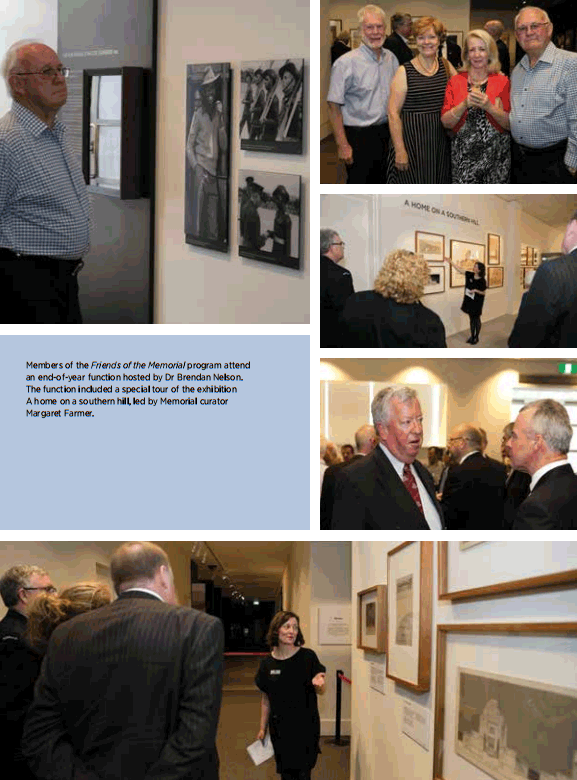
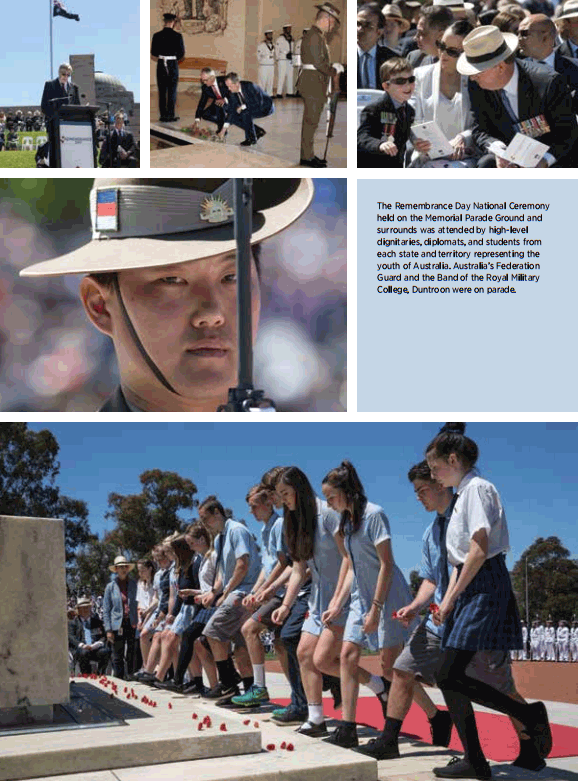
CORPORATE PLAN
STRATEGIC PRIORITY:
Creating and sharing knowledge, expertise and the National Collection.
PORTFOLIO BUDGET STATEMENTS
PROGRAM COMPONENT 1.7
RESEARCH AND INFORMATION DISSEMINATION
assist Australians remember the Australian experience of war and its enduring impact on society.
The conduct and stimulation of historical research and dissemination of knowledge and understanding of Australia’s military history.
A wide range of research and dissemination activities was undertaken during the year, including the publication of military history books and articles, media broadcasts, individual research projects, family history workshops, website provision of digitised official and private records, and the provision of military history information and research assistance through the Research Centre enquiry service and the Military History Section.
The centenary of major events of the First World War on the Western Front has continued to generate unprecedented interest in the Memorial and its collections, commemorative activities, and stories of the Australian experience of war. The Memorial has assisted enquiries in record numbers, from people using the collections to trace their families’ military history through to those performing academic research, writing books, or producing documentary films and news media.
Official Histories: East Timor, Iraq, and Afghanistan
On 1 July 2016, the full team of 13 project members began work. By November they were security-cleared and operating within a purpose-built secure environment with appropriate physical and network security infrastructure. A governance structure was established to coordinate the contributions and flow of records from all stakeholder departments and agencies: Defence; Foreign Affairs and Trade; Prime Minister and Cabinet; the Australian Federal Police; the National Archives or Australia; and the six agencies of the Australian Intelligence Community.
Research for the six volumes of the official history series consists of two complimentary strands. The first is a comprehensive interviewing program. Around 350 interviews have been conducted, supplementing pre-existing interviews sourced from a range of stakeholder agencies. Successfulresearch and interviewing visits have been conducted in Timor-Leste, the United Kingdom, the Netherlands, and North Atlantic Treaty Organisation (NATO) Headquarters at The Hague. The NATO visit yielded not only valuable interviews, but a large trove of important documents. The second area of research for the volumes consists of an examination of documentary records from stakeholder agencies and departments. Though not without ongoing challenges, an adequate flow of documents from stakeholder departments has been instituted and is being closely monitored.
The most significant challenge faced to date has been establishing an adequate flow of corporate records from theDepartment of Defence, the project’s largest supplier, and records of crucial importance from the Australian Intelligence Community. This has caused delays, resulting in the project being three to four months behind schedule in its first year. With greater active support, it is expected that material will be received from these agencies in the near future.
Independent history of the medical legacies of the Vietnam War
An independent history of the medical legacies of the Vietnam War was commissioned by the Memorial Council and is being led by Dr Peter Yule, a research fellow at the School of Historical and Philosophical Studies at the University of Melbourne. Dr Yule will document and examine existing medical studies and research, and undertake new oral history interviews to enable the authoring of a broad history on the medical legacies of the Vietnam War.
During 2016–17 excellent progress has been made by Dr Yule and his assistant in researching a variety of records, including those from the Department of Defence, the Department of Veterans’ Affairs, and the Returned and Services League, as well as a large volume of secondary sources. Consultant pidemiologist, Dr Michael Fett, has made outstanding progress in summarising the scientific literature for the project, while the team of oral historians interviewed almost 100 Vietnam veterans. To date, three chapters of the book have been drafted.
Official history of Australian peacekeeping, humanitarian and post–Cold War operations
The Memorial continues to deliver the six-volume Official history of Australian peacekeeping, humanitarian and post–Cold War operations, assisted by funding from the Department of Defence.
Three volumes have previously been published by Cambridge University Press:
- Volume II Australia and the new world order: from peacekeeping to peace enforcement, 1988–1991, by David Horner, was published in 2011
- Volume III The good international citizen: Australian peacekeeping in Asia, Africa and Europe, 1991–1993, by David Horner and John Connor, was published in 2014
- Volume V The good neighbour: Australian peace support operations in the Pacific Islands 1980–2006, by Bob Breen, was published in 2016.
Three volumes are currently being finalised for publication as follows:
- Volume VI In their time of need: Australia’s overseas emergency relief operations, 1918–2006, by Memorial historian Steven Bullard has been published, and was launched by Professor the Hon Gareth Evans AC QC on 9 August 2017
- Volume IV The limits of peacekeeping: Australian missions in Africa and the Americas, 1993–2006, by Jean Bou, Bob Breen, David Horner, and Garth Pratten, has been submitted to the publisher for release in early 2018.
- Volume I The long search for peace: observer missions and beyond, 1947–2006, by Peter Londey, Rhys Crawley, and David Horner, has been submitted to government departments and, subject to clearance, is expected to be published by mid-2018.
The annual Summer Scholars program
Scholars are selected through a competitive, merit-based selection process that is open to university students at a late tage of their history degrees – customarily honours graduates – and assigned individual research projects. Supervised by Memorial historians, three scholars successfully completed research projects related to the Memorial’s historical research, collections, exhibitions, and publications:
Nicole Townsend (Monash University) Road to ruin: Australians at the First Battle of El Alamein, July 1942
Emily Gallagher (The Australian National University) The rise and fall of Milne Bay: the battle of Milne Bay in Australia’s national narrative of the Second World War
Jaclyn Hopkins (La Trobe University) To mark the spot: Australian divisional memorials on the Western Front
The scholars delivered public presentations on their findings at the conclusion of the program and their research reports are published on the Memorial’s website.
Bryan Gandevia Prize
A generous bequest by the family and friends of the late Professor Bryan Gandevia in 2009 enabled the establishment of a prize to commemorate Professor Gandevia’s contribution to the development of Australian military and medical history. The Bryan Gandevia Prize of $5,000 is one of the most generous awards for postgraduate studies in Australian history. It is awarded biennially to an outstanding honours, masters, or doctoral thesis on a significant subject within Australian military history, military-medical history, or militarysocial history.
The 2016 Bryan Gandevia Prize, for theses submitted between 1 July 2014 and 30 June 2016, attracted a strong field of ten PhD and two honours history theses, all of high standard and worthy candidates for the award. The prize was judged by a panel of senior historians of the Australian War Memorial and a distinguished Emeritus Professor of Australian military, social, and political history. The adjudicators concurred in their judgment, unanimously recommending the award to Lieutenant David Woolley (Australian Army) for his thesis “Not yet diagnosed: Australian psychiatric casualties during the Kokoda campaign, 1942” (honours thesis, UNSW Canberra, 2015). Lieutenant Woolley delivered a public talk on his thesis at the Memorial on 29 June at which Professor Simon Gandevia presented the prize.
This work has made an outstanding contribution to understanding an important but little examined aspect of the Australian military experience. The Memorial is exploring opportunities to publish the work to ensure its wider dissemination.
Lieutenant Woolley is the third winner of the Bryan Gandevia Prize since its institution.
Australia’s involvement in post–Second World War Japanese war crimes trials
A major investigation into Australia’s involvement in post– Second World War Japanese war crimes trials, produced as a multi-volume law report series covering 310 trials (funded by an ARC grant in collaboration with the University of Melbourne), was published by Martinus Nijhoff in the Netherlands. A separate thematic volume on the historical and legal significance of the trials, Australia’s war crimes trials 1945–51, was launched by the Hon Sir Gerard Brennan AC KBE GBS at the Memorial on 29 November 2016.
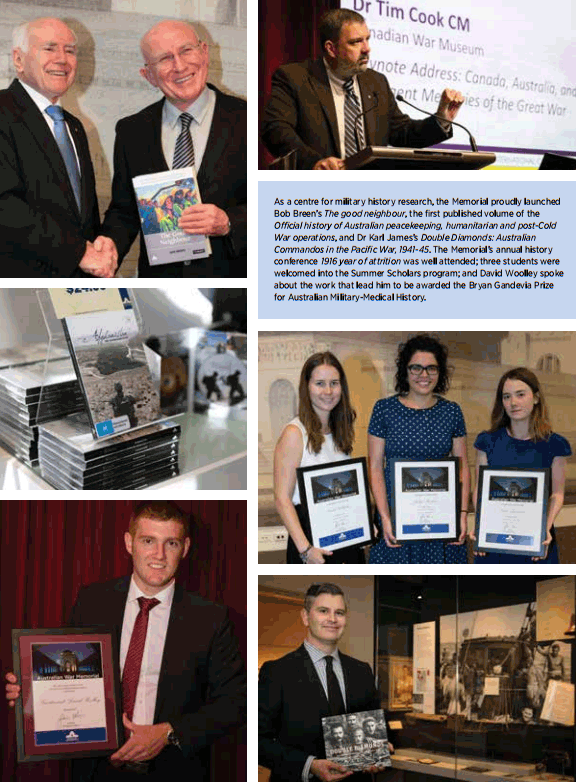
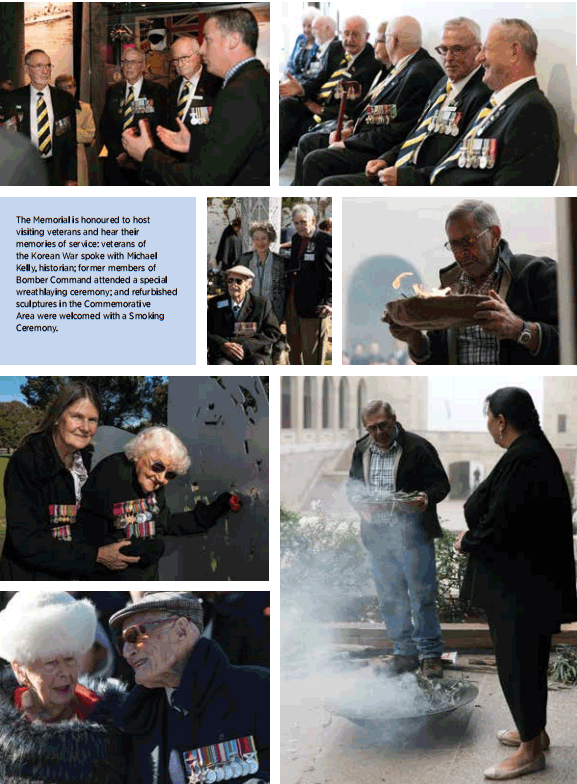
Anzac connections
The Anzac connections project is adding new collections to the Memorial website by delivering linked data, biographies of service personnel, and transcriptions of collections through crowd-sourcing tools. Collections of First World War letters and diaries continue to be digitised and published on the website. The #Daily Digger project on Twitter continues to provide a daily narrative of the First World War, with quotes and images taken from digitised diaries and letters of men and women who served in the conflict. This year the Twitter project focused on the centenary of America entering the war on 6 April 1917. A series of quotes were selected to highlight relevant comments written by Australian soldiers at the time.
Beyond Allied histories: Dayak memories of World War II in Borneo
In partnership with the Australian National University this major three-year ARC-funded research project is providing new insight into how different groups of people experienced the Second World War in Borneo. The research team combines anthropological expertise from Associate Professor Christine Helliwell of the College of Arts and Social Sciences at ANU, with curatorial expertise from Robyn van Dyk, Head of the Research Centre at the Memorial. As well as a scholarly ook and articles, the project will generate an exhibition, which will be opening on the Anzac Hall Mezzanine area on 18 March 2018. Stories will be based on items from the Memorial’s archive, including original letters and diaries, and research developed from the ARC linkage project, with an accompanying digitisation/web program to promote the archival collections in the online environment.
Family history
The Research Centre continues to offer a training program for researching family history. Workshops focus on how visitors can use the collections and services of the Australian War Memorial (and other institutional collections that relate to Australian military service) to discover their families’ military service stories. A regular program of family history talks and workshops has been held in the Reading Room, attracting small but consistent audiences.
Honour Rolls
A number of Roll of Honour and Commemorative Roll research projects were undertaken, including enhancements of data to commemorate the 50th anniversary of significant events during the Vietnam War; the 75th anniversary of the Kokoda campaign; and the commemoration of nurses who died following the fall of Singapore. Three names were approved for addition to the Roll of Honour. The Commemorative Roll has been expanded by the addition of eight names.
The centenary of the establishment of the Australian War Records Section
The anniversary of the inception of the Australian War Records Section (AWRS) was celebrated on 16 May 2017. In 1917, the AWRS began collecting the relics, artworks, photographs, and documents that would become the foundation of the Australian War Memorial. Without the work of the AWRS, Australia’s military history would have been collected by the British and recorded as a side note of the Imperial force. The opportunity to reflect upon and study our part in the global wars has helped build a sense of nationhood and identity. One hundred years on, the Memorial continues to collect, preserve, and commemorate the relics of the menand women who sacrifice themselves for our nation. The Memorial marked this anniversary on 16 May 2017 with a Last Post Ceremony commemorating Corporal Ernest Bailey, who died in the service of the AWRS. Wreaths were laid by the Memorial and on behalf of the descendants of Charles Bean and John Linton Treloar. A social media campaign featuring posts from Memorial curators discussing their favourite items from the collection drew attention to the AWRS centenary, and a number of Memorial exhibitions relating to the work of the AWRS, such as A good little chap and To heal the nation.
Copyright Amendment (Disability Access and Other Measures) Bill 2017
This year saw successful changes to the Copyright Act 1968 in the passing of the Copyright Amendment (Disability Access and Other Measures) Bill 2017. The new act introduces a standard term of protection for the life of the author plus 70 years, does not differentiate between published and unpublished works, and consolidates the exceptions, allowing libraries and archives (and other cultural institutions) to make copies of copyright material for preservation purposes. These changes to the act will result in significant efficiencies for the Memorial in digital preservation and assist in unlocking orphan works for broader public use.
PORTFOLIO BUDGET STATEMENTS
PERFORMANCE TARGET
The number of visitors to the Research Centre’s Reading Room.
RESULT Met
The Memorial’s Research Centre continued to attract large numbers of visitors. 45,869 people visited the Reading Room during the period, approximately 12,000 more than in 2015–16, with 15,459 requests made for collection items.
The increase in visitors can be attributed to a number of factors: the Family History Area volunteers were relocated into the Reading Room from their previous space adjacent to the Conflicts 1945 to today galleries; and a number of researchers are working on projects associated with significant anniversaries in 2018, particularly the centenary of the Armistice in November 2018.
PORTFOLIO BUDGET STATEMENTS
PERFORMANCE TARGET
The number of items retrieved for and accessed by Reading Room clients.
RESULT Met
A total of 15,549 collection items were requested by Reading Room clients this year, a decrease from 18,374 in 2015–16.
This may be due to the increasing number of digitised collections available on the Memorial’s website.
PORTFOLIO BUDGET STATEMENTS
PERFORMANCE TARGET
The number of page views accessing the Memorial’s online research facilities.
RESULT Met
Facilitating broad access to collections through the provision of digitised content is a high priority for the Memorial. Data clean-up has continued in 2016–17, creating cleaner and more accurate search results.
The Memorial’s online encyclopaedia continues to be a popular source of support for independent research by the public, as well as assisting staff answering frequently asked questions. Encyclopaedia pages received over 785,700 views during 2016–17. The single most viewed page was the Anzac biscuit recipe page, with a total of 24,727 views. The most heavily used pages are those relating to conscription in the Australian military, with 66,533 page views.
PORTFOLIO BUDGET STATEMENTS
PERFORMANCE TARGET
The number of research enquiries answered by Memorial staff.
RESULT Met
During 2016–17 Research Centre staff answered 12,753 enquiries made online, by telephone, email, or through the mail. Email and online enquiries are the most popular form of contact with figures that more than double those received by telephone and letter.
During 2016–17 Military History Section staff answered 3,004 research enquiries made online, by telephone, and via mail from the public and the media, and through the offices of the minister, prime minister, and other government agencies.
PORTFOLIO BUDGET STATEMENTS
PERFORMANCE TARGET
Total attendance at the annual military history conference.
RESULT Met
| Conference attendance and online presence | Qty |
|---|---|
| Conference registrations | 184 |
| Unique online viewers of the live stream | 298 |
The annual Australian War Memorial conference.
The Memorial’s annual history conference, 1916: the cost of attrition, was held at the Memorial from 20 to 22 July 2017, and was an outstanding success. The conference marked the centenary of major events of the First World War in 1916 and was framed by two significant commemorations at the Memorial: the centenary of the battle of Fromelles on 19 July 1916, and the centenary of the battle of Pozières on 23 July 1916.
The conference attracted 184 registrations, with attendees from schools and historical societies, veterans, ex-service organisations, universities, and museums. Over 100 conference delegates attended the welcome reception kindly hosted by the Ambassador of France, His Excellency M. Christophe Lecourtier, at the French Embassy Residence on the evening of 19 July 2017.
The conference provided an absorbing program for a near-capacity audience, with a total of 18 speakers from the United Kingdom, Canada, New Zealand, and Australia.
Highlights of the conference included the opening keynote address by Dr Tim Cook from the Canadian War Museum, who delivered an illuminating and challenging talk on the parallel experiences of Australia and Canada in the Great War, and divergences in national and popular memories. Delegates who attended the conference dinner in Anzac Hall were engaged by an address, 1916: brothers in arms, by First World War historian and author Dr Peter Pedersen who linked events on the Western Front in 1916 to the solidarity of soldiers of the British Empire and shared memories during commemorations on the former battlefields in 2016.
The conference audience participated in question and answer sessions, and panel discussions produced some original and lively debate. The conference organisers received enthusiastic feedback from delegates and speakers, many of whom stated it was the best conference they had attended.
For the first time since the Memorial’s annual history conferences commenced in 1981, the conference was livestreamed online to encourage wider participation. The streaming reached some 300 unique viewers, with an average viewing duration of nearly 2.5 hours, most viewing more than one session at a time. Viewers were located in 17 cities across five countries.
The conference program, speakers’ profiles, and abstracts of papers are posted on the Memorial website: http://www.conferenceco.com.au/awm_1916/index.html
PORTFOLIO BUDGET STATEMENTS
PERFORMANCE TARGET
The number of talks, lectures, speeches and conference papers delivered by Memorial staff.
RESULT Met
Table column headings
| Form of article | Qty |
|---|---|
| Articles | 31 |
| Books | 2 |
| Book Chapter | 4 |
| Book Review | 5 |
| Conference Paper | 14 |
| Interview | 72 |
| Lecture | 20 |
| Talk off-site | 33 |
| Talk on-site | 226 |
| TOTAL | 407 |
Full details of the talks, lectures, speeches conference papers etc. delivered by Memorial staff, can be found at Appendix 4.
PORTFOLIO BUDGET STATEMENTS
PERFORMANCE TARGET
Sales figures for Wartime and other publications produced by the Memorial.
RESULT Met
Sales of Memorial publications remained strong.
| Publication type | 2016–17 | 2015–16 |
|---|---|---|
| Wartime | 24,605 | 23,231 |
| Books | 3,528 | 1,975 |
| Exhibition catalogues | 258 | 346 |
| Souvenir publications | 11,042 | 13,233 |
Wartime magazine
Production of the Memorial’s popular military history magazine, Wartime, continued during 2016–17. Featuring highquality, popular, and engaging articles written by Memorial staff and eminent historians from Australia, Britain, and the United States, the magazine continued the successful practice of themed issues, featuring: the Vietnam War, including personal accounts by Australian veterans (issue 75, winter 2016); Indigenous service, complementing the new exhibition For Country, for Nation (issue 76, spring 2016); the rise of the Axis powers in the Second World War in 1940 and survivors of the Holocaust (issue 77, summer 2017), coinciding with the Memorial’s new permanent exhibition The Holocaust: witnesses and survivors; and current and recent conflicts in the Middle East, (issue 78, autumn 2017).
Memorial staff have also published, edited, and contributed to the following publications:
- Australia’s war crimes trials 1945–51, edited by Professor Tim McCormack and Narrelle Morris of University of Melbourne under ARC Linkage Grant with the Memorial, published by Martinus Nijhoff, Netherlands, in November 2016
- Australian War Memorial guide book, revised edition 2017
- Comradeship: stories of friendship and recreation in wartime, by Kathleen Cusack, published by Department of Veterans’ Affairs, May 2017
- Double diamonds: Australian commandos in the Pacific war, by Karl James, published by NewSouth Publishing, launched in August 2016
- Kokoda: beyond the legend, edited by Karl James, published by Cambridge University Press in April 2017
- A place to remember, the Australian War Memorial’s souvenir publication, revised edition 2017
CORPORATE PLAN
STRATEGIC PRIORITY:
Increasing partnerships and organisational sustainability.
PORTFOLIO BUDGET STATEMENTS
PROGRAM COMPONENT 1.8
VISITOR SERVICES
assist Australian remember the Australian experience of war and its enduring impact on society.
PORTFOLIO BUDGET STATEMENTS
PERFORMANCE TARGET
Front-of-house staff trained to deliver high level customer service and voluntary guides trained to an introductory level of military history and to deliver high level customer service.
RESULT Met
The Memorial continues to up-skill and train its permanent front-of-house staff, most of whom are qualified first aid providers.
PORTFOLIO BUDGET STATEMENTS
PERFORMANCE TARGET
High quality and suitable public facilities such as restrooms, café, and way-finding signs.
RESULT Met
The Memorial is safe and well-presented, with appropriate public facilities including restrooms, a first aid room, and parents’ rooms.
During 2016–17, the Memorial and its contracted catering company Create Consultants undertook a series of staff and visitor surveys to determine the level of satisfaction with the overall catering experience, with particular focus on coffee. In response to the feedback provided, Create Consultants is proud to now partner with local Canberra coffee company ONA. Founder of ONA and 2015 World Barista Champion Sasa Sestic and his team have worked closely with Create staff at Poppy’s and The Landing Place cafés to develop a team of skilled and passionate baristas to bring an excellent coffee experience to the Memorial.
Further enhancements are planned for external signage to assist visitor with way-finding and outline conditions of entry.
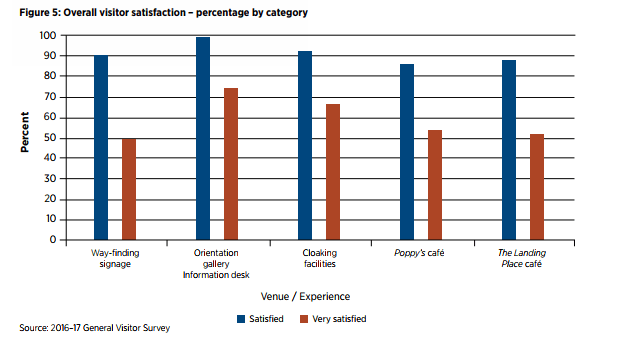
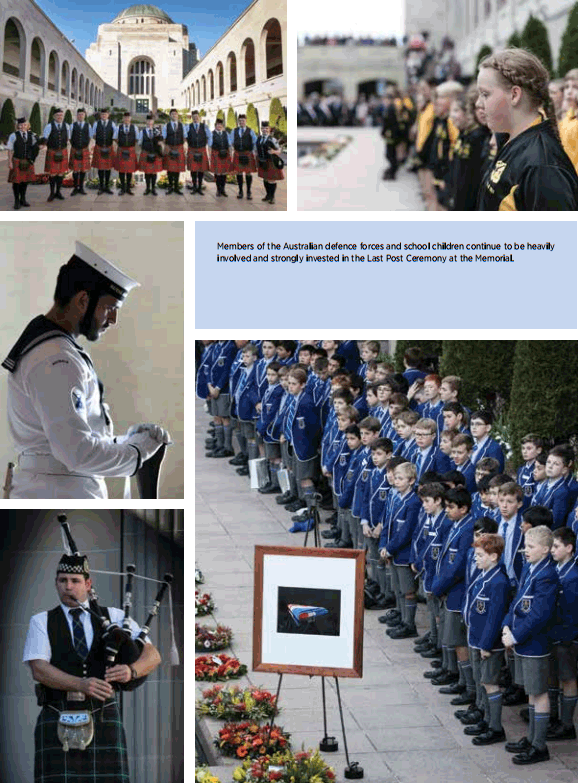
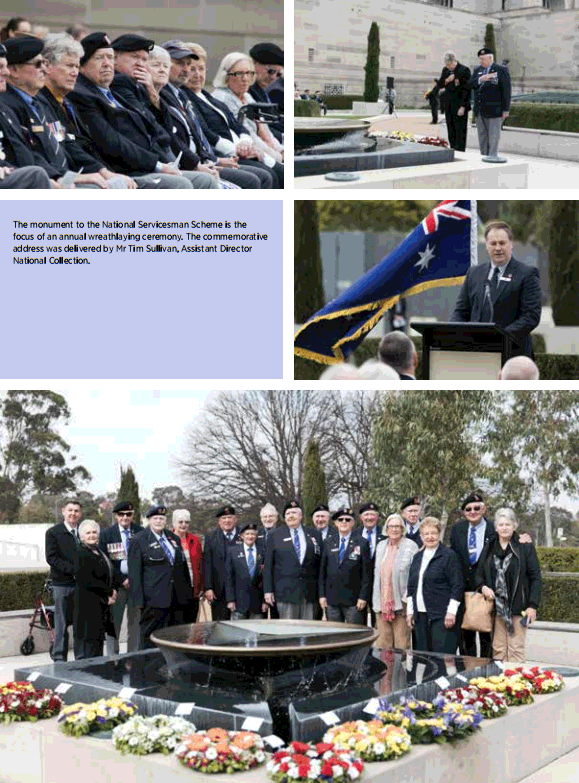
PORTFOLIO BUDGET STATEMENTS
PERFORMANCE TARGET
Opportunities for visitor feedback such as Service Charter, Visitors’ Book and evaluation services.
RESULT Met
In addition to the visitors’ book and café feedback cards, the Memorial invited general visitors to contribute their views in the following audience research surveys: In addition to the visitors’ book and café feedback cards, the Memorial invited general visitors to contribute their views in the following audience research surveys:
- general visitor exit
- cafés exit
- Reality in flames: modern Australian art and the Second World War and For Country, for Nation special exhibition exit
- concept development survey exploring the subject of the consequences of war.
PORTFOLIO BUDGET STATEMENTS
PERFORMANCE TARGET
At least 90 per cent of surveyed visitors state that the Memorial has maintained or improved its standard of service since their last visit.
RESULT Met
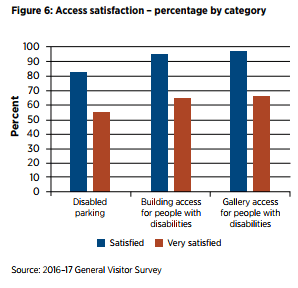
INTERNAL OUTPUT
PROGRAM COMPONENT 1.9
CORPORATE GOVERNANCE
The Council of the Australian War Memorial provides a strategic framework of policy and direction that guides the achievement of the Memorial’s outcome.
In accordance with its planned schedule, Council and the Finance, Audit, and Compliance Committee each met four times during the year. The Remuneration Committee and the Roll of Honour Committee each met once.
The Chair of Council and the Director of the Memorial provided a briefing to the Minister for Veterans’ Affairs after each meeting. The Memorial’s senior management team met with senior representatives of the Department of Veterans’ Affairs to discuss matters relevant to both parties.
Through the process of Council and committee meetings, detailed papers and recommendations were presented by the Memorial’s management. The major considerations and decisions undertaken by Council related to:
- a program of events for the end of the centenary of the First World War
- progress in relation to the Official history of Australian peacekeeping, humanitarian, and post–Cold War operations, the Official histories of East Timor, Iraq and Afghanistan, and the Independent history of the medicallegacies of the Vietnam War
- progress of the Spirit of Anzac Centenary Experience
- further development of a Memorial Master Plan, including implementation of long-term storage solutions for the National Collection
- development and implementation of a new branding position for the Memorial
- implementation of a Digital Experience Framework and strategy.
PricewaterhouseCoopers (PwC) continued as the Memorial’s internal auditor. Members of the Australian National Audit Office (ANAO) and PwC attended each of the Finance, Audit, and Compliance Committee meetings. A program of audits was approved by Council for the 2016–17 financial year and the outcomes of reviews undertaken were presented at each meeting.
INTERNAL OUTPUT
PROGRAM COMPONENT 1.10
EXECUTIVE STRATEGIC MANAGEMENT
Effective leadership and management of the Memorial in accordance with the requirements of the Australian War Memorial Act 1980.
EXECUTIVE LEADERSHIP
The Memorial’s executive leadership and management framework includes a Corporate Management Group (CMG), consisting of the Director and three assistant directors; and a Senior Management Group (SMG) comprising all section heads and members of the CMG.
During this past year, there were a number of important changes to SMG. Kristy Gosang commenced as acting Head of Finance on 29 August 2016, and Stephen Kay commenced as Head of Information Technology on 12 December 2016. Ms Gosang elected not to continue her contract with the Memorial, and Mr Chris Chapman, the Memorial’s Manager Budgets and Financial Policy, has again stepped into the role of acting Head of Finance while the recruitment process is completed.
The substantive Assistant Director of Corporate Services (ADCS), Ms Rhonda Adler, formally retired from her position in June 2017. Ms Leanne Patterson, who has been acting ADCS since 11 January 2016 while maintaining her responsibilities as Chief Finance Officer (CFO), has continued in role for the reporting period. At the time of preparing this report, a formal recruitment process was underway, the results of which will be reported in the 2017–18 Annual Report.
The CMG meets weekly and considers a wide range of matters brought forward by its members or via papers from section heads. Quarterly reports are presented to monitor the Memorial’s performance against a range of criteria. The CFO presents a set of financial statements on a regular basis and is able to provide direct advice to senior management. A corporate reserve was established to provide additional resources to deliver and support programs associated with the centenary period and other key commemorative activities. Funding from the general appropriation has been quarantined for this purpose.
The Priority Projects Steering Group continues to have strategic oversight of a range of corporate priorities and programs, monitoring resource management, and project delivery against the key indicators of scope, budget schedule, quality, and risk.
The Information Management Steering Group (IMSG) meets monthly and is key to determining the strategic direction of information management, information and communications technology (ICT), and web initiatives. This area of business continues to grow and underpins many of the Memorial’s corporate objectives. The prioritisation of available resources is a major focus of IMSG. During 2016–17 the Memorial was granted additional funding of $6.4 million to modernise its IT capability. Program planning is underway for the implementation of this project over three years.
The Assistant Director, National Collection, chairs the Reconciliation Action Plan (RAP) Working Group, which has produced the Memorial’s Reflect RAP. The Reflect RAP is designed to identify and implement initiatives to help provide services to Aboriginal and Torres Strait Islander stakeholders, visitors, and users of our services. It provides a framework for further development of information resources and services, employment strategies, and engagement with the diversity of Aboriginal and Torres Strait Islander histories, cultures, and military service.
The Memorial continued its efforts to secure corporate sponsorship and support through grants. A number of corporate sector partnerships have been secured or are in the process of being negotiated, including significant longterm partnerships with existing supporters such as Boeing, BAE Systems, Lockheed Martin, Qantas, Thales, RSL andServices Clubs NSW, RSL Victoria, and RSL Queensland. These organisations have partnered with the Memorial to deliver programs for Memorial visitors and students. Other individual supporters continue to provide financial support for the Memorial’s projects and public programs. A full revenue generation report is at section 1.12 “Revenue Generation”.
The SMG meets weekly and is a forum for the exchange of information and discussion of corporate issues. Feedback from CMG and SMG meetings is provided to staff through weekly section meetings.
In addition to weekly CMG meetings, a number of Project Control Groups (PCG) met on a monthly basis to monitor the performance of major projects. The focus of PCGs is to ensure projects are delivered according to their objectives, timeframes, and budgets.
STRATEGIC MANAGEMENT
The Memorial’s strategic planning framework encourages participation by all staff, promoting the concept of one team working to achieve common goals and recognising the importance of communication and ownership of decisions. Annual business plans and accompanying budgets are developed to support Council directions and corporate plan priorities. Once developed, annual business plans influence day-to-day operations. Achievements are monitored and reported quarterly to CMG and Council.
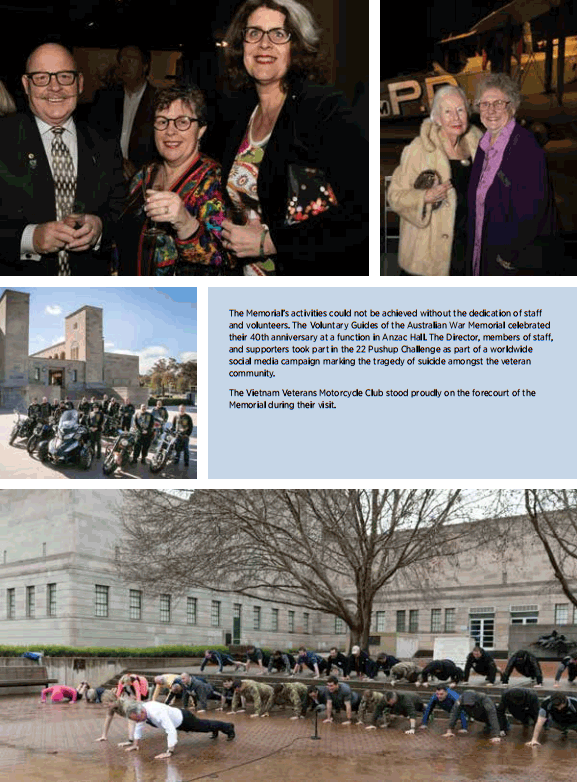
RISK MANAGEMENT AND BUSINESS CONTINUITY PLANNING
Fraud risk
The Commonwealth Fraud Control Framework outlines the Australian Government’s requirements for fraud control, including that government entities put in place a comprehensive fraud control program that covers prevention, detection, investigation, and reporting strategies. In January 2017 the Memorial undertook its triennial re-assessment of its fraud control framework. The resulting report and plan identified:
- no risks above moderate
- seven moderate risks
- seven low risks
- five very low risks
Risks rated moderate to very low are managed within existing resources and are monitored and reported as part of the Memorials existing quarterly risk management framework.
Business risk
In October 2016 the Memorial undertook its triennial Business Risk Assessment. Senior management, with the assistance of PricewaterhouseCoopers, undertook a comprehensive analysis of the threats to the Memorial’s ability to meet its objectives, and identified appropriate controls and mitigation strategies.
Management of these key business risks have been incorporated into corporate and annual business planning processes. Progress against the proposed actions to address the high and significant risks are monitored by senior management and reported quarterly to Council.
Risk benchmarking
Each year the Memorial participates in Comcover’s annual risk management benchmarking survey, which provides a basis to measure our performance against similar government agencies and identifies areas for possible improvement.
In the March 2016 survey, the Memorial achieved an overall risk maturity rating of “integrated”, which aligned with the results of the majority of Commonwealth agencies. The report also highlighted areas of potential improvement in the Memorial’s overall risk management framework.
In response, the existing risk management framework was reviewed and enhanced to incorporate current best-practice and risk management methodologies. A revised Director’s Instruction was developed to consolidate various risk-related policies and documentation, and to inform staff of the organisation’s underpinning appetite and tolerance in relation to the range of business risks.
The results from the March 2017 survey, shows significant improvement in the Memorial’s overall rating, moving from “integrated” to “advanced” as a result of the work undertaken since the 2016 survey.
Evaluation and visitor research
This year Evaluation and Visitor Research section completed a revision of the Memorial’s domestic audience segmentation profile. Last undertaken in 2003, the psychographic study examines the existing and potential general public audience according to values, attitudes, and motivations. It provides an integrating framework for demographic and qualitative information collection in-house by the Memorial. Roy Morgan Research was engaged to perform this year’s study. The study utilised focus groups, on-site exit surveying, a large online national survey, and current and retrospective profiling of the Memorial’s exit surveys according to their proprietary profiling systems. The updated audience profile will be used to ensure that varying audience types are considered and targeted effectively through the variety of programs provided by the Memorial.
The General Visitor Survey was conducted again in 2017. This year 725 respondents completed the survey as they exited the Memorial. The results set the benchmarking information used throughout this report.
The section maintained its standard audience research priorities relating to café catering customer service survey; Big things in store; and exhibition evaluations. Summative surveys were concluded for the Mephisto: the devil’s chariottemporary display and Reality in flames: modern Australian art and the Second World War special exhibition. A concept exploration survey was conducted for an exhibition on the consequences of war to inform the project team of visitor understanding and interests. The For Country, for Nation special exhibition exit survey commenced and is in progress for the duration of the exhibition.
The combination of in-house studies and the external segmentation profile will help the Memorial to build on its strengths and overcome barriers to visitor engagement in the post centenary period.
INTERNAL OUTPUT
PROGRAM COMPONENT 1.11
RESOURCE MANAGEMENT
Management of the Memorial’s buildings and grounds, and its financial, human, and general service resources to the best advantage of external outputs.
BUILDINGS AND SERVICES
Buildings
Energy management continues to be a priority for the Memorial, and technical initiatives have maintained efficient energy consumption on the site. The refinement of strategy for building climate control continues, with an emphasis on managing temperature and humidity parameters to meet the needs of collection material and energy efficiency. The Memorial partnered with ACTEW to conduct monitoring of the Building Management Control Systems in all buildings, with monthly performance reports on performance providing focus on maintenance and repair work for critical systems that are not operating as efficiently as their design and specifications allow. This project saw improved controls and collection storage conditions and highlighted several capital control upgrades required to provide ongoing energy savings. Replacement of fluorescent and conventional lighting with energy efficient bulbs and LED technologies was undertaken in the Campbell and Mitchell precincts, including a full upgrade to the Treloar C workshop high bay lighting, which is expected to produce additional savings and increased lighting levels.
The next stage of the Mitchell Site Development Plan to determine long-term site development and corporate storage priorities for the Memorial’s future growth and acquisitions has progressed. The concept design for the first stage large technology object storage building is well underway. The Memorial’s Mitchell properties comprise land belonging to both the Australian Capital Territory and the Commonwealth, and discussions are underway to resolve any potential titleissues which may impact the long-term redevelopment plans of the site.
Major accommodation projects have been undertaken in Campbell and Mitchell. The design and construction of new secure office space to accommodate the official histories project was completed on the Campbell site, with staff relocated into the new accommodation from early December 2016.
Several other projects were completed, including a new concrete path adjacent bus drop off on the east road, installation of a platform in the Commemorative Area to allow disabled access, and the upgrade to current standards of the Administration Building lift.
Grounds
Grounds maintenance contracts are managed to ensure outstanding grounds presentation at all times. Detailed grounds maintenance and horticulture contracts are managed separately to ensure professional services are delivered. A specialist gardener is contracted for garden maintenance of the Commemorative Area, Eastern Precinct, and memorials and sculptures throughout the Western Precinct, to ensure these locations are presented at a high standard.
Additional underground electrical infrastructure for Anzac Day and Remembrance Day ceremonies was installed to improve the Memorial’s ability to support audio-visual presentations and broadcast media involvement in on-site events. This work has reduced the potential risk to staff and visitors from accidents due to cables across roads and pathways.
A regular maintenance regime for the Lone Pine tree (Pinus halepensis) continues to assist with its longevity, a replacement pine, grown from a seed taken from the original Lone Pine tree, was planted by Their Royal Highnesses The Duke and Duchess of Cambridge on Anzac Day 2014. It is anticipated that this tree will have grown to a suitable size when the original Lone Pine reaches senescence. The new tree is in a healthy state, and this is assisted by the fence and bird netting.
The official opening and dedication of the Flanders Memorial Garden occurred in May and a new bronze dog water bowl was added to the explosive detection dogs’ memorial, Elevation of the senses, in the Eastern Precinct.
A major upgrade of the plantings around the Memorial’s Administration Building was completed in early 2017, including rabbit-proofing of the garden bed and the rectification of concrete plinths around the building’s façade.
Planning for additional footpath behind Anzac Hall is underway to assist school group access, reduce slip hazards, and decrease the red gravel wash-off onto roads and into drains during heavy rain.
Security
Regular security risk reviews are undertaken to ensure a strengthened focus on Memorial security arrangements
Liaison with the Australian Federal Police (AFP) occurs for all high-profile visits and events. There is a particularly positive relationship with AFP (ACT Policing) for liaison, coordination, and the AFP’s role in the Memorial’s high-profile events and ceremonies such as Anzac Day and Remembrance Day
Site vehicle access mitigation strategies and planning is underway in line with the Site Development Plan to include controls such as vehicle bollards and boulders.
The upgrade of electronic security infrastructure continues. This includes closed circuit television (CCTV) and site lighting enhancements throughout the Memorial grounds. Proliferation of CCTV throughout the galleries and Memorial buildings continues.
New baggage inspection and cloaking arrangements were introduced in May 2016. Inspections are conducted by security staff with a focus on the Main Building public entry points. The Emergency Planning Committee (EPC) met four times during 2016–17. Planning and conducting emergency evacuation drills for all Memorial buildings has continued, with improvements identified and implemented.
Workshop services
The Memorial’s workshop supports a wide range of Memorial activities. Work this year included trades support for the For Country, for Nation, Home on a southern hill and The deceiving eye exhibits. Workshop staff were also responsible for the design and creation of the ceremonial soil boxes used in the dedication ceremony of the Flanders Memorial Garden, with the soil box for each state and territory of Australia made from timbers indigenous to that area. Each soil box was hand-crafted by our highly-skilled team of tradesmen. The Memorial’s Workshop provides technical trades-based support and advice to all sections of the Memorial. The Workshop is also responsible for a wide range of building works, preparations for ceremonies, gallery maintenance, furniture construction, the installation of commemorative plaques and signage, and general building and grounds maintenance works.
Records management
Mail Room duties include records management, retrieval and rehousing of physical paper files, and the scanning of incoming mail.
A review of records management processes and security risks has identified an opportunity to further centralise scanning of incoming mail.
Mailroom and loading dock security is an ongoing focus, particularly in relation to potential security threats arising from incoming mail and deliveries. Development and review of mailroom policies and procedures ensures best practice mail tracking and receipt, while addressing security requirements.Mailroom and loading dock security is an ongoing focus, particularly in relation to potential security threats arising from incoming mail and deliveries. Development and review of mailroom policies and procedures ensures best practice mail tracking and receipt, while addressing security requirements.
INFORMATION TECHNOLOGY
Corporate systems
The Information Technology (IT) section supports a broad range of information and communication technology-based systems underpinning operations such as administration; collection management; public access; gallery information and experience; retail; and online services. There is an excellent record of systems availability, achieved through dedicated attention to systems monitoring and timely, well-planned upgrades.
Significant application and database changes were implemented for the Memorial website redevelopment project. This included a re-architecture of media storage to improve accessibility and maintenance, and a significant increase in data to improve search functionality.
Continued support was provided for a number of initiatives associated with the centenary of the First World War, particularly in relation to the Last Post Ceremony, the Roll of Honour name projections, and Roll of Honour soundscapes.
The year saw the conclusion of a project to upgrade the Digital Asset Management System (DAMS). The DAMS solution is a centralised repository for archival quality storage of digitised collection materials. The upgrade included the implementation of an out-of-the-box web client which reduced reliance on complex system customisations. Subsequent work has expanded the capability of the DAMS and introduced additional automated workflows to share information with the collection management system.
The SharePoint-based electronic documents management system continues to support corporate information management and recordkeeping requirements. The system was further enhanced with additional workflows to transform paper-based approvals to digital processes to achieve organisational efficiencies and meet the implementation targets identified in the government’s “Digital Continuity2020 Plan”.
The retail system used by the Memorial’s shop was upgraded. This included enhancements to the portable till, stocktake tools, and an upgrade of shop computers.
The IT service management application was upgraded in order to maintain vendor support, technical currency, and integration compatibility. The upgrade enabled better system performance, reliability, and scalability.
The section continues the upgrade and development of solutions to support management of the National Collection. These solutions support information management and enhance preservation, conservation and curatorial tasks, which enables the Memorial to make the collection and information accessible to the public.
IT infrastructure
The Information Technology section develops and maintains an in-house IT platform which supports its systems, including those referred to above. In addition to meeting the workload generated by the implementation or upgrade of system application projects, the infrastructure team also achieved the following:
- Establishment of a security certified network and solution to support the IT requirements for the writing of the official history volumes relating to Australia’s involvement in the conflicts of Iraq, Afghanistan, and East Timor.
- Upgrade of hardware for recording and live streaming of the daily Last Post Ceremony. The new hardware provides a simplified solution with increased resilience.
- Expansion of storage infrastructure to support the increasing needs of the Digital Asset Management System. The infrastructure provides scalability, simplicity, efficiency, and security.
- Replacement of corporate printers and multi-function devices. The new equipment includes advanced functions to enable secure printing, help people work more efficiently, and reduce paper waste.
- The fleet of old laptop computers were replaced and included a Windows 10-based system, delivering performance improvements, increased security, and resource efficiencies.
- An upgrade to the desk phone system and backend servers, and implementation of a disaster recovery procedure.
- Implementation of a diverse path for internet connectivity and upgraded to a high-availability infrastructure. This was following a review of our current internet infrastructure, and possible supply route changes for the Light Rail Project.
Strategic planning and governance
Implementation of a diverse path for internet connectivity and upgraded to a high-availability infrastructure. This was following a review of our current internet infrastructure, and possible suThe Information Management Steering Group (IMSG) continues its oversight of information management, and IT strategy and policy.pply route changes for the Light Rail Project.
The Chief Information Officer (CIO) has represented the Memorial at meetings of the whole-of-government CIO forum and the Commonwealth Managers Forum on IT.
FINANCE
Financial planning and monitoring
The Memorial has a well-established internal budget development and management process which ensures corporate priorities are funded to an appropriate level. Many new projects and activities related to the centenary of the First World War were funded from an internal reserve, with potential allocations forecast over several years to ensure adequate resourcing during the centenary period 2014–18.
Funding strategies were also developed for a range of capital projects planned over the next ten years, including National Collection storage, gallery refurbishments, building works, site development, software upgrades, and IT hardware replacement.
Regular financial reporting to senior management, Council, and the Department of Finance throughout the year included Memorial-wide financial results, budget review and analysis, cash balance reporting, capital management planning, and commercial operations.
Financial policy
The Head of Finance and the Chief Finance Officer (CFO) continued to participate in the development of wholeof-government reforms through developing input to key discussion papers and consultation processes, including review of valuation methodology for heritage and cultural assets.
The CFO was also involved in activities to ensure that funding strategies for major projects and programs are achieved, including resource planning and forecasting for projects associated with collection development and long-term accommodation and storage needs.
HUMAN RESOURCES
Strategic people management/workforce planning
The Memorial has identified the following strategic workforce priorities:
- alignment of people and our business through positive performance culture
- The fleet of old laptop computers were replaced and included a Windows 10-based system, delivering performance improvements, increased security, and resource efficiencies.
- building leadership and management capability
- attracting and retaining the right people
- encouraging innovation and agility
Workforce planning continues to evolve within the Memorial to build and sustain a diverse workforce. This will deliver current and future business objectives and provide greater opportunity to attract, develop, and retain skilled, engaged, and committed employees. Critical capability gaps are being identified to enable the development of tailored strategies to assist in mitigating future workforce risk. This will lead to greater linkages and alignment with business to achieve the Memorial’s strategic objectives.
Workforce development
The Memorial fosters a culture of professional development and continuous learning in building capability, capacity, and bench strength for the future.
Initiatives for 2017 included the continuation of:
- a Leadership Development Program for leaders at the APS5–EL1 levels. The program provides leaders with a common language and understanding in fostering a culture of high performance and of staff being more fully engaged. The cohort structure of representatives from each business section supports networking and cross collaboration.
- “Learnhub”, the Memorial’s online e-learning program where all staff can participate in a diverse range of training by participating in or registering to attend in-house face-toface training.
- specialist training programs, conferences and seminars continue to be a hallmark of the annual Learning and Development Plan in supporting the development of the range of expertise required within the Memorial.
- accreditations provide currency in licensing and skills required for the job.
- the Memorial’s Studies Assistance Scheme continues to provide support to staff enabling them to undertake formal qualifications relevant to their expertise and career progression.
People management and services
Work is currently underway on improving and simplifying the annual performance assessment process, with focus on embedding regular feedback between staff and managers.
The Workplace Relations Committee met regularly throughout the year and continues to be an important forum for staff consultation and policy development.
Enterprise bargaining concluded in May 2017 with the majority of staff supporting a new agreement for approval by the Fair Work Commission in June 2017.
The Memorial Security Team was presented with certificates in Government Security by senior members of the Attorney General's Department.
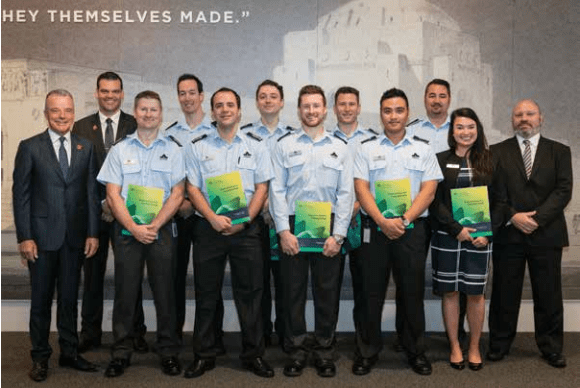
STAFFING OVERVIEW
Following is an overview of the metrics of the staff at the Memorial, as at 30 June 2017
The staff of the Memorial are appointed or employed under the Public Service Act 1999.
Ongoing and non-ongoing staff by gender
(excludes Statutory Officer)
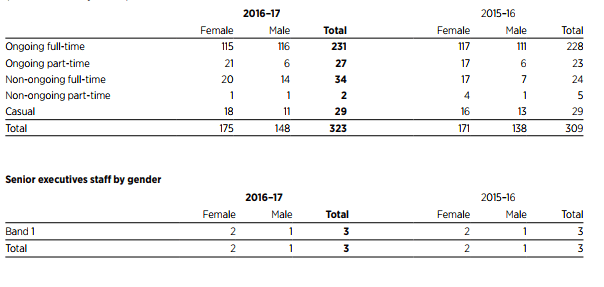
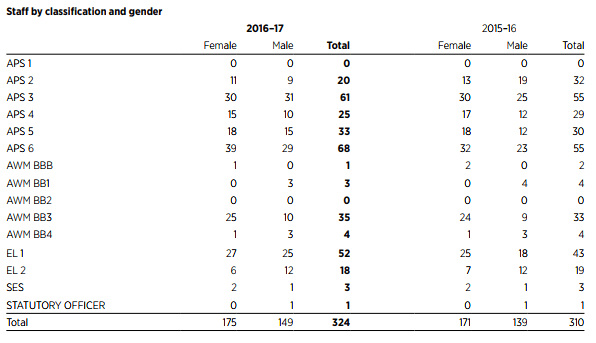
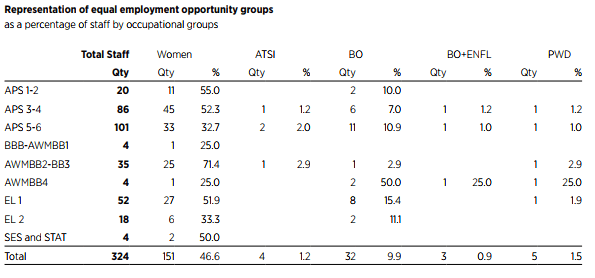
Notes:
ATSI = Aboriginal and Torres Strait Islander;
BO = born overseas;
BO+ENFL = born overseas and did not speak English as a first language;
PWD = people with a disability.
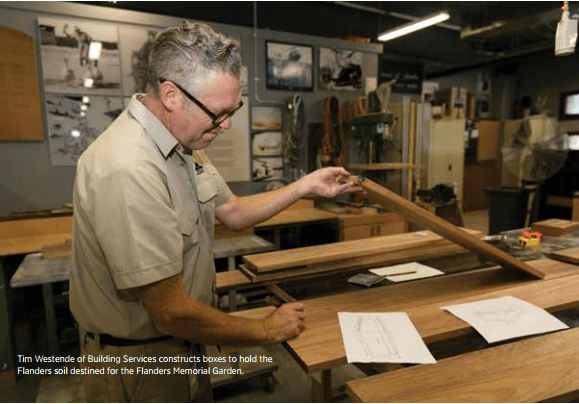
INTERNAL OUTPUT
PROGRAM COMPONENT 1.12
REVENUE GENERATION
Generation of revenue in support of the Memorial’s mission and purpose.
MEMORIAL SHOP
Memorial Shop revenue was $2,072,158 in 2016–17 against a target of $1,855,488. Net profit was $492,798, compared to last year’s $454,265, before notional overhead costs.Memorial Shop revenue was $2,072,158 in 2016–17 against a target of $1,855,488. Net profit was $492,798, compared to last year’s $454,265, before notional overhead costs.
Wage to sales, a key metric of retail performance, finished this year at 27 per cent, compared to 31 per cent in the previous ear. Cost of goods finished flat on last year. Combined transactional activity for the shop and Orientation Gallery totalled 116,943, with the shop’s average sale decreasing $0.57 to $20.62, driven by an increase in sales of lower-priced items. Net operating profit percentage finished at 24 per cent, compared to 21 per cent in the previous year. This was achieved by benchmarking the shop’s operations to external retailers, training staff in retail metrics, and changing the supply chain to more economical suppliers.
The majority of sales were merchandise developed by the Memorial and items produced under license with other suppliers, including the Royal Australian Mint and Australia Post. The centenary range included:
- 2017 medallion featuring a prominent image of troops on the Western Front
- limited edition Digger bear
- circulating and non-circulating coins commemorating key events in Australian military history
- apparel and souvenir products featuring the Memorial’s centenary logo.
The Memorial expanded on its core range of products around the military services, poppy range, and educational items for school groups.
The Memorial launched a number of publications, including The Good neighbour: Australian peace support operations in the Pacific Islands 1980–2006 by Bob Breen, One woman’s war and peace by Sharon Bown, Fighting monsters by Richard Braithwaite, High in the sunlit silence by Tony Vine, and Secret code-breakers of central bureau: how Australia’s signals-intelligence network helped win the Pacific war by David Dufty. Memorial souvenir publications sold through the Orientation Gallery and Memorial Shop, including an updated A place to remember, Hall of Memory, and Australian War Memorial guide book, all sold well.
E-BUSINESS
The Memorial’s e-business revenue for 2016–17 was $1,029,570 (including the value of waivers and stock received free of charge) against a target of $1,072,497. Revenue is generated from:
- costs associated with reproductions from the National Collection
- user fees associated with commercial use of the material
- the value of fees waived for use of materials for educational, private, or commemorative purposes
- Memorial Shop products sold online.
BEQUESTS AND PARTNERSHIPS
The Memorial, like most cultural institutions, supplements its government budget allocation with partnership and fundraising programs. These programs aim to assist the Memorial to engage in new and innovative approaches to telling the stories of those who have served our nation.
During this reporting period, the Memorial sought support to deliver a number of new and existing activities, publications, and exhibitions. To assist in this process, the Memorial has launched a focused, strategic program of partnership and fundraising activity, the Giving Campaign, focused on bequests and major gifts.
During the reporting period, the Memorial generated $13,018,049 in partnerships, major donations, and bequests.
The Australian War Memorial gratefully acknowledges the generous support of the following organisations, families and individuals, without whom much of our work could not be achieved:
ActewAGL
Australia and New Zealand Banking Group Ltd
Australia Remembers – ACT Committee
Australian Capital Territory Government
Australian Submarine Corporation
The Australian Women’s Weekly
Aviation Art
BAE Systems Australia
Sir James Balderstone AC
The Balgownie War Memorial Fund
Bearcage Productions
Dame Beryl Beaurepaire AC DBE and the late Mr Ian Beaurepaire CMG
BHP Billiton Sustainable Communities
Estate of the late James Frederick Blythe
Boeing Australia
Burmah Castrol
Casinos Australia International
Estate of the late Kingsley Juan Clark
Estate of the late Ella Maud Clarke
Coles Myer Ltd
Commonwealth Bank of Australia
Commonwealth Government of Australia
Estate of the late Stanley Condon
CSR Limited
Sir William Durrant and Lady Durrant AM
Estate of the late Mr Bruce R. Ellis
Mr T.V. Fairfax
Vincent Fairfax Family Foundation
Foster’s Brewing Group Ltd
General Dynamics Land Systems Australia
Google Ireland Limited
Gordon Darling Foundation
Government of the Northern Territory
Dr Ron Houghton DFC and Mrs Nanette Houghton
Howard Smith Ltd
Incapacitated Servicemen and Women’s Association of Queensland
Estate of the late Mrs Ruth Margaret Jenkins
Estate of the late Mr Edgar Henry King
Kingold
Lambert Vineyards
Mrs Ruth and Mr Steve Lambert
The Laminex Group
Lockheed Martin Australia Pty Ltd
Macquarie Bank Foundation
Mr Dugald Mactaggart
Estate of the late Mrs Beryl Martin
Estate of the late Mrs Elsie Ada McGrath
Estate of the late Mr William McHatton
Estate of the late Mr J.S. Millner AM
The Sidney Myer Fund
National Australia Bank Ltd
National Roads and Motorists’ Association
Newcrest Mining Ltd
News Limited
Northrop Grumman
OPSM
Oracle Corporation
Origin Energy
Pacific Dunlop
Mr Kerry Packer AC
Estate of the late Mr Richard Pratt AC
The Pratt Foundation
PricewaterhouseCoopers
Qantas
Lady C. Ramsay
Raytheon Australia Pty Ltd
The Bruce and Joy Reid Foundation
John T. Reid Charitable Trusts
Renison Goldfields Consolidated Ltd
Returned and Services League of Australia (Victorian Branch) Inc
Mr Michael and Mrs Katherine Ribot de Bressac
Rio Tinto Ltd
Rosebank Engineering Pty Ltd
Mrs Margaret Ross AM
RSL and Services Clubs Association Ltd
SEDCOM Communications Pty Ltd
Seven Group Holdings Ltd
Seven Network (Operations) Ltd
Shaw Vineyard Estate
Shell Company of Australia
Mr John and Mrs Betty Skipworth
Mr Dick Smith AO and Mrs Pippa Smith
Spicers Paper
State Government of New South Wales
State Government of Queensland
State Government of South Australia
State Government of Tasmania
State Government of Victoria
State Government of Western Australia
Mr Kerry Stokes AC
Mr Robert Strauss MBE
Tattersall’s
Telstra
Tenix Pty Ltd
Teys Bros (Holdings) Pty Ltd
Thales Australia
Thyne Reid Foundation
TransACT
Mr Harry O. Triguboff AO
Virgin Australia
Sir Bruce and Lady Watson
Wesfarmers Limited
WESFI Limited
Weta Digital
Mr John Wicking AM
Wingnut Films
INTERNAL OUTPUT
PROGRAM COMPONENT 1.13
TEAM MANAGEMENT
Sections/teams are managed and administered to achieve Memorial outputs and foster equity, teamwork, and open communication.
This is a common output that recognises the importance of promoting teamwork to achieve corporate priorities. The Performance Assessment Framework is a key strategy for ensuring individual work plans are aligned with the Memorial’s business plan.
This year saw the introduction of the Memorial’s staff rewards and recognition program. Each month all staff are invited to nominate individuals or teams for their outstanding efforts and contribution. Each branch’s achievements are recognised in each work group and shared with staff through regular updates.
Regular senior management and section meetings continue to provide vehicles for effective communication across the Memorial. All-staff meetings are held periodically to provide updates from senior management on key strategic issues and major project developments. Specialist committees such as Workplace Relations; Work Health and Safety; Exhibition Planning; Emergency Planning and Evacuation; and Environment and Energy are essential forums for addressing cross-branch matters of importance.
The Memorial’s Employee Assistance Program, which provides counselling and support to staff and their immediate families, was accessed by a small number of staff. The majority of matters referred to this service continue to be of a non-work related nature.
One indicator of the effectiveness of teamwork at the Memorial is the willingness of staff to contribute to major events such as Anzac Day and Remembrance Day on a voluntary basis. The involvement of staff is fundamental to the success of those events. This cross-organisational support is good for building teamwork across all areas of the Memorial.
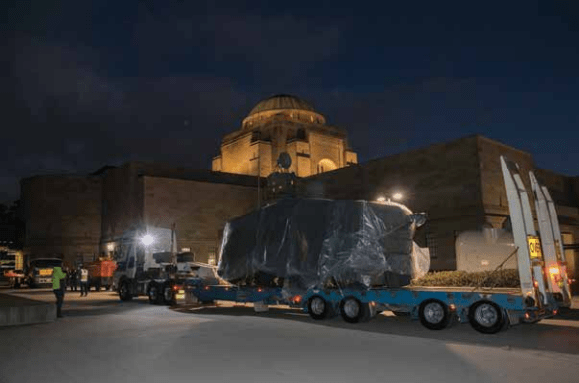
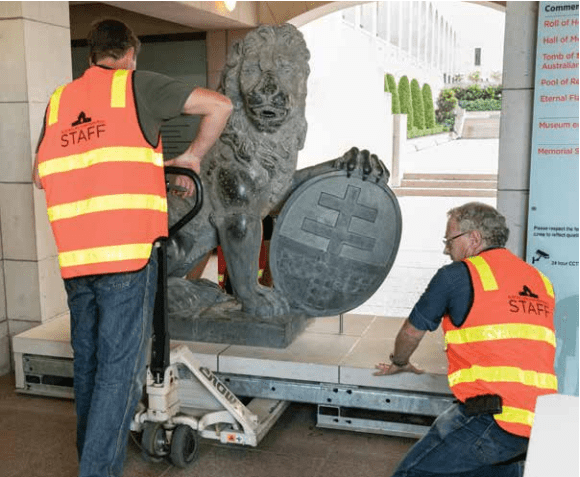
The Menin Gate Lions, originally given to Australia in 1936, returned to stand on the bridge in front of the Menin Gate as part of First World War centenary commemorations.
Legislative Framework and External Scrutiny
ENABLING LEGISLATION
The Australian War Memorial is established as a corporation by the Australian War Memorial Act 1980 (the Act). The Memorial’s functions and powers, its ministerial oversight, and the role and functions of its Council, Chair, and Director are outlined in the Act.
FUNCTIONS AND POWERS OF THE MEMORIAL
The functions and powers of the Memorial are detailed in sections 5 and 6, respectively, of the Act and provide the framework around which the Memorial undertakes its core functions of commemoration, education, and research. As the custodian of Australia’s military history, the Memorial works to maintain a place for solemn reflection; develop, maintain and exhibit a collection of historically significant material; provide an authoritative reference facility; conduct, disseminate and assist with research into Australia’s military history.
EFFECTS OF MINISTERIAL DIRECTIONS
Under section 22 of the Public Governance, Performance and Accountability Act 2013, Council must ensure that the Memorial complies with the Government Policy Order to the extent that the Order applies to the authority. There are no General Policy Orders currently in effect.
RESPONSIBLE MINISTER
The Minister for Veterans’ Affairs has portfolio responsibility for the Memorial. The Honourable Dan Tehan was the minister responsible for the Memorial for 2016–17. During the reporting period, Minister Tehan held the following concurrent portfolio responsibilities:
- Minister for Veterans’ Affairs
- Minister Assisting the Prime Minister for the Centenary of Anzac
- Minister Assisting the Prime Minister for Cyber Security
- Minister for Defence Personnel.
INTERNAL AND EXTERNAL AUDITS
Internal audit
The Memorial’s internal audit services are outsourced to PricewaterhouseCoopers (PwC). The Internal Audit Plan 2016–17 was approved by Council in May 2016 and work was completed as follows:
- Review of e-business product costing and pricing model
- Review of the 2017–20 Business Risk Assessment
- Review of 2017–20 Fraud Risk Assessment and Fraud Control Plan
- Review of 2017–20 Strategic Internal Audit Plan
No major concerns or weaknesses were identified. Minor recommended actions have been addressed or incorporated into the 2017–18 Business Plan.
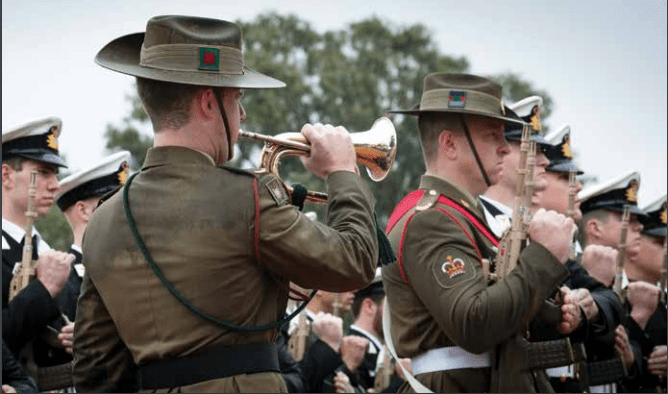
External audit
The audit of the 2016–17 financial statements was undertaken by Ernst & Young on behalf of the ANAO and resulted in a favourable report and unqualified audit opinion.
INDEMNITIES AND INSURANCE PREMIUMS
The property insurance premium for 2016–17 was $335,376 (excluding GST), an increase of $13,567 or 4.3 per cent on the 2015–16 premium of $321,809. The slight increase is mainly due to increased cover over property and the National Collection. The policy provided comprehensive cover for the National Collection and property, and general liability (including professional indemnity), with premiums of $162,236 and $167,809 respectively. The policy also provides motor vehicle coverage for those vehicles not covered by government fleet insurance, and insurance for overseas travellers. Council members are provided with indemnity insurance through directors’ and officers’ liability cover.
LEGAL ACTIONS
There were no legal actions taken against the Memorial during 2016–17.
OMBUDSMAN
No issues were referred to the Commonwealth Ombudsman during 2016–17.
SOCIAL JUSTICE AND EQUITY
The Memorial is committed to social justice and equity, and aims to provide a high level of public access to its physical grounds, commemorative ceremonies, and public programs. The Memorial undertakes regular research to ensure it is informed of the changing needs of its diverse national and international audience.
The Memorial identifies specific needs through visitor research and evaluation and regularly surveys visitors to identify and monitor how well needs are being met. Results for 2016–17 indicate:
- About 4 per cent of the Memorial’s general visitors have a disability**
- Among the visitors who rated facilities and services for people with disabilities, the following proportions gave a rating of satisfied or very satisfied:
- 96 per cent – mobility-impaired access into the building
- 97 per cent – mobility-impaired access within galleries and between floors
- 89 per cent – accessible toilets
- 85 per cent – free wheelchairs and walkers
- 83 per cent – mobility-impaired parking.
- The percentage of Australian visitors identifying as Aboriginal or Torres Strait Islander (3 per cent of the Australian population) was just under 1 per cent. ** Indigenous Australians were just as satisfied (100 per cent satisfaction rating) by their visit to the Memorial as non– Indigenous Australians (99.8 per cent satisfaction rating).
- Almost 34 per cent of Australian visitors were born overseas, representing a higher proportion than that found in the Australian population (26 per cent). Satisfaction levels remained equal overall, although overseas-born visitors were less likely to be very satisfied than Australian born visitors.
- About 19 per cent of Australian visitors speak a language other than English at home (down 1 per cent), a lower percentage than that found in the Australian population (21 per cent). Those Australians who spoke solely English at home were more likely to be very satisfied (89 per cent) with their visit than those visitors who spoke another language at home (75 per cent).
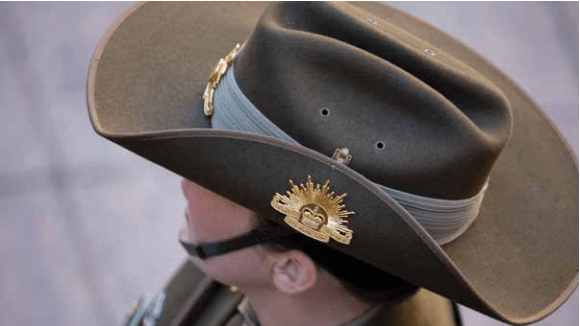
**Sample size considered too small for definitive comparisons.
ADVERTISING AND MARKET RESEARCH EXPENDITURE
In accordance with section 311A of the Commonwealth Electoral Act 1918, the following is a summary of amounts paid by the Memorial to advertising agencies, market research organisations, and media advertising organisations. As required, particulars of payments of less than $13,000 have not been included. The Memorial did not pay for the services of any polling or direct mail organisations.
The following table shows all monies paid for general advertising in the 2016–17 financial year.
Services Provided
| Name | Total Amount Paid inc GST |
General Advertising |
Market Research |
|---|---|---|---|
| With Collective | $302,002 | $302,002 | |
| FairFax Media | $117,546 | $117,546 | |
| Nationwide News Pty Ltd | $68,437 | $68,437 | |
| Prime Media Group Limited | $44,559 | $44,559 | |
| Dentsu Mitchell Media Australia | $38,615 | $38,615 | |
| McNair Ingenuity Research | $29,275 | $29,275 | |
| Roy Morgan Research Ltd | $26,366 | $26,366 | |
| Canberra FM Radio Pty Ltd | $23,234 | $23,234 | |
| KWP Advertising Pty Ltd | $21,978 | $21,978 | |
| Hardie Grant Magazines | $21,010 | $21,010 | |
| Radio Canberra Pty Ltd | $18,317 | $18,317 | |
| City of Sydney | $17,546 | $17,546 | |
| Screenmakers | $16,247 | $16,247 | |
| Southern Cross Austereo | $13,431 | $13,431 | |
| TOTAL | $758,568 | $702,925 | $55,642 |
FREEDOM OF INFORMATION
In compliance with the Information Publication Scheme (IPS), which was established under Part 2 of the Freedom of Information Act 1982 (the FOI Act) the Memorial publishes a range of information on its website, accessible at: www.awm.gov.au/about/organisation/corporate/ information-publication-scheme.
ENERGY CONSUMPTION AND ENVIRONMENTAL MANAGEMENT
The Energy and Environment Committee (EEC) oversees and monitors the Memorial’s energy use and the resultant impact upon the environment. The EEC meets quarterly and reports to the Corporate Management Group, providing focus and continuous improvement in managing water consumption; energy efficiency; waste disposal including chemicals; and the appropriate control of asbestos and radioactive materials.
Environmental Protection and Biodiversity Conservation (EPBC) Act 1999, Section 516A Statement
In accordance with section 516A of the Environmental Protection and Biodiversity Conservation Act 1999 (the EPBC Act), Australian government agencies are required to include in their annual reports information detailing the environmental performance of the organisation and the organisation’s contribution to ecologically sustainable development. This remains a key objective for the Memorial and is applied to the development of plans for the enhancement and maintenance of the Memorial’s buildings and operations. The Memorial does not administer any legislation or have any appropriation directly related to the principles of environmental sustainability and development.
Energy consumption
Monitoring of the energy produced by the Memorial is conducted by the Building and Services section and reported quarterly to the Energy and Environment Committee.
Consumption of electricity and gas is monitored closely and remains close to trend. The refinement of the control strategy for building climate control continues, with an emphasis on managing temperature and humidity parameters to efficiently achieve material conservation and energy efficiency needs.
The Memorial partnered with ACTEW to conduct monitoring of the Building Management Control Systems in all buildings, with monthly performance reports providing focus on maintenance and repair work for critical systems that are not operating as efficiently as their design and specifications allow. This project saw improved controls and collection storage conditions and highlighted several capital control upgrades required to provide ongoing energy savings.
Building refurbishments and enhanced external lighting upgrades conducted in 2016–17 have included the installation of LED light technologies which provide electricity and maintenance savings to the Memorial while enhancing safety. The replacement of the original mercury vapour high bay lights with LED lighting in the Memorial’s Mitchell workshop has improved the light levels for sensitive restoration works, and will achieve a reduction in energy usage by more than 50 per cent.
Water management
Water consumption is monitored closely and any anomalies are promptly investigated and addressed.
The Memorial is committed to continual lifecycle improvement for irrigation infrastructure utilising the latest technology to control and monitor consumption. The Memorial proactively manages the watering of gardens and grounds by scheduling irrigation according to seasonal changes and rainfall.
Water saving measures are implemented for new building infrastructure, for example, improved irrigation control systems with leak detection and rain shut-off sensors; and upgrading to more efficient air-conditioning equipment including chillers, cooling towers, and humidifiers. Such measures water consumption and contribute to environmental sustainability.
Waste management
Waste management is reported to address and target waste awareness. The Memorial uses dedicated waste streams, comingled recycling, cardboard, classified, and general waste to reduce landfill. The introduction of follow-me-printing on all printers during the reporting period has led to quantifiable savings. Recycling of small cell batteries is ongoing at the Campbell and Mitchell sites, further extending the Memorial’s commitment to being environmentally responsible.
Wherever possible, the Memorial is committed to recycling waste produced from its sites. Non-general waste such as chemicals, paints, and solvents, are managed and disposed of appropriately by licenced service providers.
Heritage management
The Memorial’s endorsed Heritage Management Plan guides management of the Memorial’s heritage precinct. When required, heritage specialists provide advice regarding proposed building works in heritage-sensitive areas.
Bird-deterrent installations around the Main Building continue to be refined and assessed for effectiveness
Maintenance of the Memorial building fabric is ongoing, including minor repairs to stonework and the implementation of a regular stonework-cleaning regime.
Other general heritage conservation activities include regular conservation and cleaning of key sculptural elements. Before Anzac Day a major clean of sculptures and plinths was undertaken, the stonework in the Commemorative Area was re-grouted, and Parade Ground steps were cleaned.
Improvements to the way-finding and presentation of the Commemorative Roll were completed late 2016.
In order to assist with its longevity, regular maintenance of the Lone Pine tree (Pinus halepensis) continues. The new Lone Pine tree, planted by Their Royal Highnesses The Duke and Duchess of Cambridge on Anzac Day 2014, remains in a healthy state, assisted by fencing and bird netting. The new tree has already outgrown the original bird netting framework which will be enhanced next year as the tree grows. It is anticipated that this tree will have developed significantly when the original tree reaches senescence.
WORKPLACE HEALTH AND SAFETY
The Memorial is committed to safeguarding the health and safety of its employees, workers, and visitors by providing and maintaining a safe working environment. The Memorial aims to eliminate all preventable work-related injuries and illnesses through systematic risk management. The Memorial is committed to supporting and promoting the holistic wellbeing of its employees.
The Memorial’s work health and safety (WHS) function is managed through Human Resources, with assistance from a WHS Manager and WHS Advisor who provide advice to the WHS committee, assist with hazard and incident investigations and case management, and provide relevant training.
This year the Memorial’s workers compensation premium has seen a 31.7 per cent reduction. Factors driving this include early intervention programs, reduced claim numbers and costs, and the improved overall performance of the Comcare scheme.
During the year, the Memorial’s Rehabilitation Management System (RMS) was audited by Comcare. Areas for improvement are integrated into the annual Early Intervention, Rehabilitation and Workers Compensation Plan.
In accordance with Schedule 2, Part 4 of the Work Health and Safety Act 2011 (WHS Act), the Memorial is required to provide details of the following matters in its annual report:
Initiatives and programs
A range of WHS initiatives and programs were conducted in the reporting period, including:
- introduction of hazard labelling for the National Collection, enabling staff to identify the hazard profile of items and implement appropriate safe handling controls
- continued growth of online information resources to help staff understand their responsibilities under the WHS Act, including child safety, electrical safety, inspection programs, and hazardous materials management
- providing staff with appropriate training to support visitor emotion and distress
- fostering a happy, healthy, and resilient workforce with delivery of a “creating a positive workplace culture” seminar for staff
- significant uptake of voluntary flu vaccination programs for staff and volunteers
- promotion of the Employment Assistance Program
- implementation of a Domestic and Family Violence awareness policy to support staff
- a Comcare briefing to Senior Management to explain premium results and enhance understanding of factors driving performance and trends
- implementation of staff training workshops related to chemical handling and risk management, weapons handling, and disaster recovery for the National Collection.
The Work Health and Safety Committee meets four times per year and assists the Memorial in developing, implementing, and reviewing measures designed to protect the health and safety of workers and visitors. The committee is made up of worker and management representatives, and provides a key consultation mechanism in accordance with relevant legislation.
First aid officers are located throughout the Memorial buildings to ensure immediate assistance is available when required. Emergency response support includes cardiac defibrillators being available at both the Campbell and Mitchell sites.
The Memorial has a zero tolerance approach to bullying and harassment, and has a number of contacts available should an employee or manager require advice regarding an instance of bullying or harassment. Contacts include trained HR professionals, harassment contact officers across all business areas, and the Employee Assistance Program. The Memorial addresses formal and informal allegations of bullying or harassment promptly and sensitively.
The Memorial maintains a positive reporting culture. During 2016, 334 incidents were reported related to visitors, staff, contractors, and hazards. Visitor incidents are the area of highest frequency and continue to be less than 1 per cent of total visitor numbers. Visitor incidents are showing a downward trend.
Initiatives and outcomes
Risk reduction strategies implemented during 2016–17 included an enhanced focus on slip, trip, and fall incidents. This resulted in installation of a platform to the Commemorative Area, application of non-slip edging to steps and stairs, increased lighting levels, and enhanced workplace inspection programs. Success of these initiatives is shown with the rate of incidents trending downward for visitors and staff.
Investigations and WHS Act Part 10 notices
During 2016–17, one incident was reported to Comcare that met the notifiable incident provisions of the WHS Act. This incident related to a worker sustaining an electric shock from a power point. Comcare did not investigate this incident. The table below includes a summary of notifiable incident numbers and investigations for the past three years.
There were no notices issued to the Memorial under Part 10 of the WHS Act.
Statistics
| 2016–17 | 2015–16 | 2014–15 | |
|---|---|---|---|
| Workplace incidents | 334 | 387 | 303 |
| Notifiable incidents | 1 | 1 | 1 |
| Incidents investigated by Comcover |
0 | 1 | 1 |
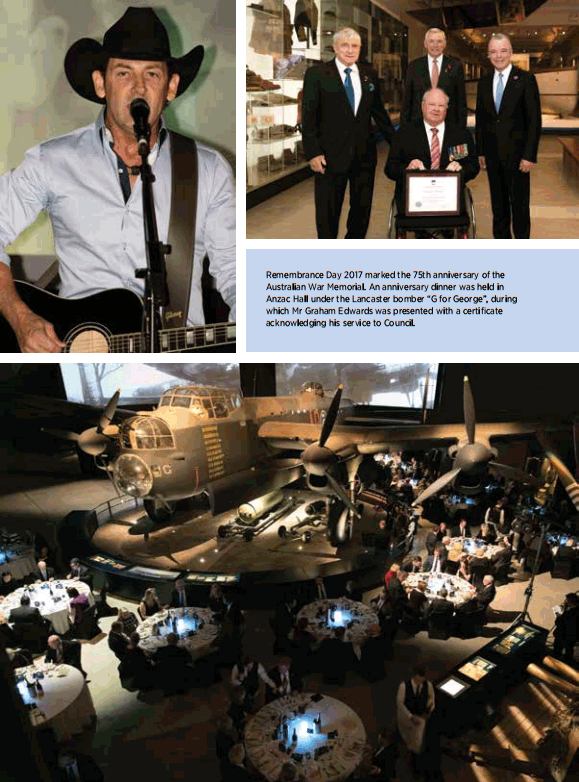
Report by the Auditor-General and Annual Financial Statements
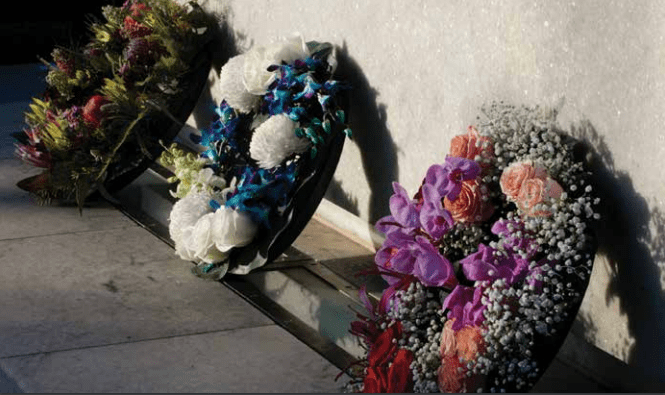
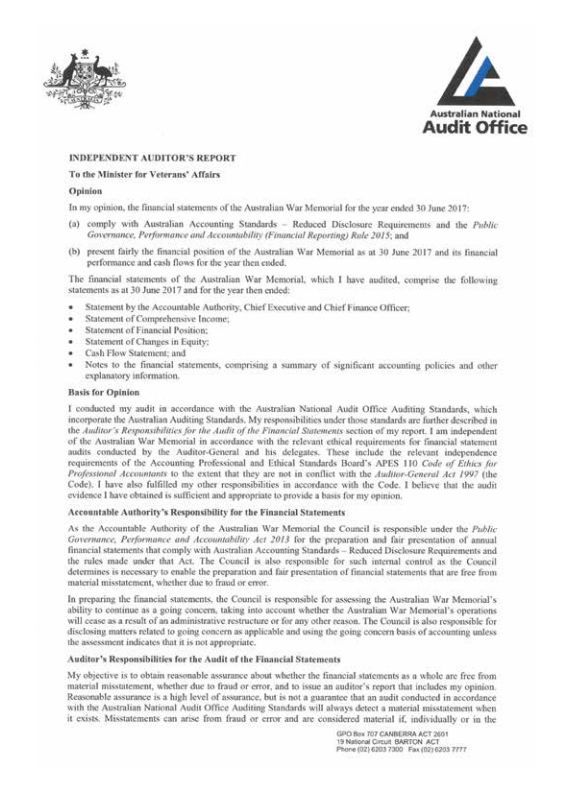
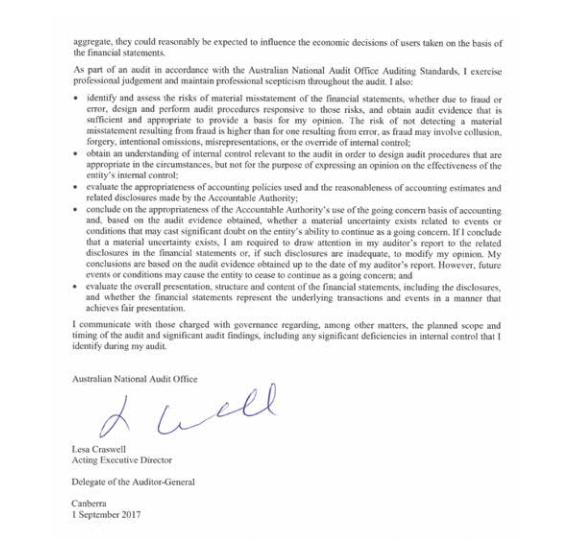
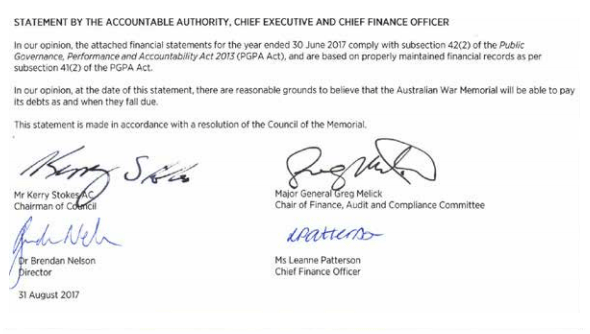
Statement of Comprehensive Income
for the period ended 30 June 2017
| 2017 | 2016 | Original Budget |
|||
|---|---|---|---|---|---|
| Notes | $'000 | Ref | $'000 | ||
| NET COST OF SERVICES | |||||
| Expenses | |||||
| Employee Benefits | 1.1A | 24,680 | 22,673 | 23,397 | |
| Suppliers | 1.1B | 29,435 | 21,461 | i | 22,004 |
| Depreciation and amortisation | 2.2A | 21,701 | 20,066 | ii | 28,616 |
| Write-Down and Impairment of Assets | 1.1C | 19 | 12 | - | |
| Losses from asset sales | 62 | 47 | - | ||
| Total expenses | 75,897 | 64,259 | 74,017 | ||
| Own-Source Income | |||||
| Own-source revenue | |||||
| Sale of Goods and Rendering of Services | 1.2A | 4,389 | 4,471 | 4,210 | |
| Interest | 1.2B | 2,243 | 2,211 | 2,140 | |
| Donations and sponsorships | 1.2C | 14,623 | 16,164 | i | 4,427 |
| Other Revenue | 1.2D | 1,085 | 1,499 | iii | 1,421 |
| Total own-source revenue | 22,340 | 24,345 | 12,198 | ||
| Gains | |||||
| Gains from sale of assets | 33 | 7 | - | ||
| Total gains | 33 | 7 | - | ||
| Total own-source income | 22,373 | 24,352 | 12,198 | ||
| Net costs of services | (53,526) | (39,907) | (61,819) | ||
| Revenue from Government | 1.2E | 42,720 | 42,473 | 42,720 | |
| (Deficit)/Surplus on continuing operations | (10,806) | 2,566 | (19,099) | ||
| OTHER COMPREHENSIVE INCOME | |||||
| Items not subject to subsequent reclassification to net cost of services | |||||
| Changes in asset revaluation surplus | 1.2E | 1 14,888 | 33,687 | - | |
| Total other comprehensive income | 1 14,888 | 33,687 | - | ||
| Total comprehensive income | 104,082 | 36,253 | (19,099) |
The above statement should be read in conjunction with the accompanying notes.
Statement of Financial Position
as at 30 June 2017
| 2017 | 2016 | Original Budget |
|||
|---|---|---|---|---|---|
| Notes | $'000 | Ref | $'000 | ||
| ASSETS | |||||
| Financial assets | |||||
| Cash and Cash Equivalents | 2.1A | 1,811 | 2,943 | iv | 2,604 |
| Trade and Other Receivables | 2.1B | 846 | 756 | v | 1,080 |
| Investments | 2.1C | 71,000 | 71,000 | vi | 64,000 |
| Accrued Interest | 930 | 727 | vii | 1,191 | |
| Total financial assets | 74,587 | 75,426 | 68,875 | ||
| Non-financial assets | |||||
| Land and buildings | 2.2A | 139,549 | 140,466 | 144,408 | |
| Heritage and cultural | 2.2A | 1,175,018 | 1,059,729 | ii | 1,400,640 |
| Plant and equipment | 2.2A | 5,220 | 6,143 | ii | 5,564 |
| Exhibitions | 2.2A | 40,411 | 41,344 | 43,222 | |
| Intangibles | 2.2A | 4,359 | 3,935 | ii | 3,376 |
| Inventories | 2.2B | 794 | 899 | 734 | |
| Other Non-Financial Assets | 2.2C | 618 | 598 | 657 | |
| Total non-financial assets | 1,365,969 | 91,253,114 | 1,598,601 | ||
| Total assets | 1,440,556 | 1,328,540 | 1,667,476 | ||
| LIABILITIES | |||||
| Payables | |||||
| Suppliers | 2.3A | 1,065 | 1,015 | iv | 1,516 |
| Other Payables | 2.3B | 357 | 388 | viii | 100 |
| Total payables | 1,422 | 1,403 | 1,616 | ||
| Provisions | |||||
| Employee Provisions | 4.1A | 8,978 | 8,217 | 9,930 | |
| Total provisions | 8,978 | 8,217 | 9,930 | ||
| Total liabilities | 10,400 | 9,620 | 11,546 | ||
| Net assets | 1,430,156 | 1,318,920 | 1,655,930 | ||
| EQUITY | (10,806) | 2,566 | (19,099) | ||
| Contributed equity | 110,778 | 103,624 | 110,778 | ||
| Reserves | 769,055 | 654,167 | ii | 1,017,712 | |
| Retained surplus | 550,323 | 561,129 | 527,440 | ||
| Total equity | 1,430,156 | 1,318,920 | 1,655,930 |
The above statement should be read in conjunction with the accompanying notes.
Statement of Changes in Equity
for the period ended 30 June 2017
| 2017 | 2016 | Original Budget |
||
|---|---|---|---|---|
| Notes | $'000 | $'000 | $'000 | |
| CONTRIBUTED EQUITY | ||||
| Opening balance | ||||
| Balance carried forward from previous period | 103,624 | 96,152 | 103,624 | |
| Adjusted opening balance | 103,624 | 96,152 | 103,624 | |
| Contributions by owner | ||||
| Equity injection - Appropriations | 7,154 | 7,472 | 7,154 | |
| Total transactions with owners | 7,154 | 7,472 | 7,154 | |
| Closing balance as at 30 June | 110,778 | 103,624 | 110,778 | |
| RETAINED EARNINGS | ||||
| Opening balance | ||||
| Balance carried forward from previous period | 561,129 | 558,563 | 546,539 | |
| Adjusted opening balance | 561,129 | 558,563 | 546,539 | |
| Comprehensive income | ||||
| (Deficit)/Surplus for the period | (10,806) | 2,566 | (19,099) | |
| Total comprehensive income | (10,806) | 2,566 | (19,099) | |
| Closing balance as at 30 June | 550,323 | 561,129 | 527,440 | |
| ASSET REVALUATION RESERVE | ||||
| Opening balance | ||||
| Balance carried forward from previous period | 654,167 | 620,480 | 1,017,712 | |
| Adjusted opening balance | 654,167 | 620,480 | 1,017,712 | |
| Comprehensive income | ||||
| Other comprehensive income | 114,888 | 33,687 | - | |
| Total comprehensive income | 114,888 | 33,687 | - | |
| Closing balance as at 30 June | 769,055 | 654,167 | 1,017,712 | |
| TOTAL EQUITY | ||||
| Opening balance | ||||
| Balance carried forward from previous period | 1,318,920 | 1,275,195 | 1,667,875 | |
| Adjusted opening balance | 1,318,920 | 1,275,195 | 1,667,875 | |
| Comprehensive income | ||||
| (Deficit)/Surplus for the period | (10,806) | 2,566 | (19,099) | |
| Other comprehensive income | 114,888 | 33,687 | - | |
| Total comprehensive income | 104,082 | 36,253 | (19,099) | |
| Transactions with owners | ||||
| Contributions by owners | ||||
| Equity injection - Appropriations | 7,154 | 7,472 | 7,154 | |
| Total transactions with owners | 7,154 | 7,472 | 7,154 | |
| Closing balance as at 30 June | 1,430,156 | 1,318,920 | 1,655,930 |
The above statement should be read in conjunction with the accompanying notes.
Accounting Policy
Equity injections
Amounts appropriated which are designated as 'equity injections' for a year (less any formal reductions) and the Collection Development Acquisition Budget (CDAB) are recognised directly in contributed equity in that year.
Cash Flow Statement
for the period ended 30 June 2017
| 2017 | 2016 | Original Budget |
|||
|---|---|---|---|---|---|
| Notes | $'000 | Ref | $'000 | ||
| OPERATING ACTIVITIES | |||||
| Cash received | |||||
| Receipts from Government | 42,720 | 42,473 | 42,699 | ||
| Sale of goods and rendering of services | 4,288 | 4,331 | v | 4,425 | |
| Interest | 2,038 | 2,676 | 2,140 | ||
| Net GST received | 2,107 | 2,237 | - | ||
| Donations and sponsorships | 13,773 | 5,510 | i | 4,533 | |
| Other | 362 | 198 | - | ||
| Total cash received | 65,288 | 57,425 | 53,797 | ||
| Cash used | |||||
| Employees | (23,921) | (23,460) | (23,397) | ||
| Suppliers | (30,723) | (23,191) | i | (21,183) | |
| Total cash used | (54,644) | (46,651) | (44,580) | ||
| Net cash from operating activities | 10,644 | 10,774 | 9,217 | ||
| INVESTING ACTIVITIES | |||||
| Cash received | |||||
| Proceeds from sales of property, plant and equipment | 33 | 7 | - | ||
| Investments | 115,500 | 7107,727 | vi | 87,000 | |
| Total cash received | 115,533 | 107,734 | 87,000 | ||
| Cash used | |||||
| Purchase of property, plant and equipment | (18,964) | (12,420) | (18,428) | ||
| Investments | (115,500) | (117,727) | vi | (85,000) | |
| Total cash used | (134,464) | (130,147) | (103,428) | ||
| Net cash (used by) investing activities | (18,931) | (22,413) | (16,428) | ||
| FINANCING ACTIVITIES | |||||
| Cash received | |||||
| Contributed equity | 7,154 | 7,472 | vi | 7,154 | |
| Total cash received | 7,154 | 7,472 | 7,154 | ||
| Net cash from financing activities | 7,154 | 7,472 | 7,154 | ||
| Net (decrease) in cash held | (1,132) | (4,167) | (57) | ||
| Cash and cash equivalents at the beginning of the reporting period | 2,943 | 7,110 | 2,661 | ||
| Cash and cash equivalents at the end of the reporting period | 1,811 | 2,943 | 2,604 |
The above statement should be read in conjunction with the accompanying notes
Budget Variances Commentary
for the period ended 30 June 2017
| Ref | Variance | Affected Line items (and statement) | Explanation of major variances |
|---|---|---|---|
| I | 230% | Own-Source Revenue - Donations and sponsorships (Statement of Comprehensive Income) | Receipts and costs associated with the Spirit of Anzac Centenary Experience (SACE) project. The final result reflects the timing of pass through payments to project partners. |
| 204% | Operating Activities - Cash Received - Donations and sponsorships (Cash Flow Statement) | ||
| 45% | Operating Activities - Cash Used - Suppliers (Cash Flow Statement) | ||
| 34% | Expenses - Suppliers (Statement of Comprehensive Income) | ||
| II | 29% | Non-Financial Assets - Computer software (Statement of Financial Position) | In 2016-17 independent revaluations of the National Collection and Property, Plant and equipment were undertaken. The impact of non-financial asset revaluations is not budgeted due to the variable nature of inputs into the valuation process. |
| -6% | Non-Financial Assets - Plant and equipment (Statement of Financial Position) | ||
| -16% | Non- Financial Assets - Heritage and cultural (Statement of Financial Position) | ||
| -24% | Net Cost of Services - Expenses - Depreciation and Amortisation (Statement of Comprehensive | ||
| -24% | Equity - Reserves (Statement of Financial Position) | ||
| III | -24% | Own-Source Revenue - Other Revenue (Statement of Comprehensive Income) | Other revenue includes donated National Collection items, royalties revenue and Friends of the Memorial memberships. Royalties and Friends memberships collected were less than forecast |
| IV | -30% | Financial Assets - Cash and cash equivalents (Statement of Financial Position) | The final result reflects the timing and total value, excluding GST, of supplier invoices on hand at year's end. |
| -30% | Liabilities - Payables - Suppliers (Statement of Financial Postion) | ||
| V | -22% | Financial Assets - Trade and Other receivables (Statement of Financial Position) | Reduced debtor days with payments being received within trading terms slightly offset by an increase in customer prepayments. |
| VI | 36% | Investing Activities - Cash used - Investments (Cash Flow Statement) | Cash on hand transitions between operating accounts and decisions to place investments depend on cash liquidity requirements, and fluctuate during the period. |
| 33% | Investing Activities - Cash received - Investments (Cash Flow Statement) | ||
| 11% | Financial Assets - Investments (Statement of Financial Position) | ||
| VII | -22% | Financial Assets - Accrued interest (Statement of Financial Position) | Accrued interest is impacted by the timing and duration of investments made since the framing of the budget and the actual investment. |
| VIII | 257% | Liabilities - Other payables (Statement of Financial Position) | Accrued salary and wages for the last two days of the financial year (2016: one day accrued). No budget is included for accrued salaries and wages. |
Overview
Objectives of the Australian War Memorial (the Memorial)
The Memorial was established by section 4 of the Australian War Memorial Act 1980 and is a not-for-profit Australian Government controlled entity.
The objective and outcome of the Memorial is to assist Australians remembering, interpreting, and understanding the Australian experience of war and its enduring impact through maintaining and developing the National Memorial, its collection and exhibition of historical material, commemorative ceremonies and research.
The continued existence of the Memorial in its present form and with its present programs is dependent on Government policy and on continued funding by Parliament for the Memorial's administration and programs.
The Basis of Preparation
The financial statements are general purpose financial statements and are required by section 42 of the Public Governance, Performance and Accountability Act 2013.
The financial statements have been prepared in accordance with:
a) Public Governance, Performance and Accountability (Financial Reporting) Rule 2015 (FRR) for reporting periods ending on or after 1 July 2015; and
b) Australian Accounting Standards and Interpretations issued by the Australian Accounting Standards Board (AASB) that apply for the reporting period.
The financial statements have been prepared on an accrual basis and in accordance with the historical cost convention, except for certain assets at fair value. Except where stated, no allowance is made for the effect of changing prices on the results or the financial position.
The financial statements are presented in Australian dollars and, where specified, values are rounded to the nearest thousand.
New Accounting Standards
Of the new standards, amendments to standards and interpretations issued by the Australian Accounting Standards Board that are applicable to the current reporting period, none has had a material financial impact on the Memorial.
All new, revised or amended standards and/or interpretations that were issued prior to the sign-off date and are applicable to the current reporting period did not have a material impact on the Memorial's financial statements.
Taxation
The Memorial is exempt from all forms of taxation except Fringe Benefits Tax (FBT) and the Goods and Services Tax (GST).
Revenues, expense and assets are recognised net of GST except:
where the amount of GST incurred is not recoverable from the Australian Taxation Office; and
for receivables and payables
Events After the Reporting Period
There are no events occurring after reporting date that materially affect the financial statements.
Financial Performance
This section analyses the financial performance of the Memorial for the year ended 2017.
1.1 Expenses
| 2017 | 2016 | |
|---|---|---|
| $'000 | $'000 | |
| 1.1A: Employee Benefits | ||
| Wages and salaries | 18,587 | 17,428 |
| Superannuation | ||
| Defined contribution plans | 2,339 | 1,808 |
| Defined contribution plans | 2,339 | 1,808 |
| Leave and other entitlements | 2,343 | 1,600 |
| Leave and other entitlements | 134 | (138) |
| Total employee benefits | 24,680 | 22,673 |
Accounting Policy
Accounting policies for employee related expenses is contained in the People and Relationships section (Note 4.1A).
1.1B: Suppliers
Goods and services supplied or rendered
| Exhibitions | 1,592 | 4,268 |
| Property and Support Services | 5,778 | 5,13 3 |
| Staff Support Costs | 2,769 | 2,838 |
| Professional Services | 2,561 | 2,993 |
| Other | 1,876 | 1,591 |
| Cost of goods sold | 1,271 | 1,290 |
| Advertising and promotions | 1,211 | 1,397 |
| Information Technology | 996 | 843 |
| Travel | 718 | 604 |
| Total goods and services supplied or rendered | 28,772 | 20,957 |
| Goods supplied | 2,195 | 2,098 |
| Services rendered | 26,577 | 18,859 |
| Total goods and services supplied or rendered | 28,772 | 20,957 |
Other suppliers
| Operating lease rentals | 202 | 163 |
| Workers compensation expenses | 461 | 341 |
| Total other suppliers | 663 | 504 |
| Total suppliers | 29,435 | 21,461 |
Leasing commitments
The Memorial in its capacity as lessee holds operating leases for motor vehicles and IT equipment.
Commitments for minimum lease payments in relation to non-cancellable
operating leases are payable as follows:
| Within 1 year | 332 | 302 |
| Between 1 to 5 years | 385 | 548 |
| More than 5 years | - | - |
| Total operating lease commitments | 717 | 850 |
Accounting Policy
Operating lease payments are expensed on a straight-line basis which is representative of the pattern of benefits derived from the leased assets.
| 2017 | 2016 | |
|---|---|---|
| $'000 | $'000 | |
| 1.1C: Write-Down and Impairment of Assets | ||
| Impairment of receivables | (20) | 11 |
| Impairment of inventories | 39 | 1 |
| Total write-down and impairment of assets | 19 | 12 |
1.2 Own-Source Revenue and gains
| 2017 | 2016 | |
|---|---|---|
| $'000 | $'000 | |
| Own-Source Revenue | ||
| 1.2A: Sale of Goods and Rendering of Services | ||
| Sale of goods | 2,739 | 2,687 |
| Rendering of services | 1,650 | 1,784 |
| Total sale of goods and rendering of services | 4,389 | 4,471 |
Accounting Policy
Revenue from the sale of goods is recognised when:
a) the risks and rewards of ownership have been transferred to the buyer;
b) the Memorial retains no managerial involvement or effective control over the goods;
c) the revenue and transaction costs incurred can be reliably measured; and
d) it is probable that the economic benefits associated with the transaction will flow to the entity.
Revenue from rendering of services is recognised by reference to the stage of completion of contracts at the reporting date. The stage of completion of contracts at the reporting date is determined by reference to the proportion that costs incurred to date bear to the estimated total costs of the transaction.
Receivables for goods and services, which have 30 day terms, are recognised at the nominal amounts due less any impairment allowance account. Collectability of debts is reviewed at end of the reporting period. Allowances are made when collectability of the debt is no longer probable.
1.2B: Interest
| Deposits | 2,243 | 2,211 |
| Total interest | 2,243 | 2,211 |
Accounting Policy
Interest revenue is recognised using the effective interest method as set out in AASB 139 Financial Instruments: Recognition and Measurement.
1.2C: Donations and sponsorships
| Donations | 1,288 | 1,612 |
| Sponsorships | 12,485 | 3,898 |
| Donated Heritage and Cultural items | 850 | 10,654 |
| Total donations and sponsorships | 14,623 | 16,164 |
Accounting Policy
Sponsorship
Project-specific sponsorship funding which meets the requirements of a contribution in accordance with AASB 1004 Contributions is recorded as revenue when the Memorial obtains control of the contribution or right to receive the contribution, it is probable that the economic benefits comprising the contribution will flow to the Memorial, and the amount can be measured reliably.
Donated Heritage and Cultural items
Contribution of assets at no cost of acquisition or for nominal consideration are recognised as income at their fair value when the asset qualifies for recognition.
| 2017 | 2016 | |
|---|---|---|
| $'000 | $'000 | |
| 1.2D: Other Revenue | ||
| Royalties | 10 | 51 |
| Resources received free of charge | 723 | 1,082 |
| Friends of the Memorial | 131 | 147 |
| Rental income | 221 | 218 |
| Other | - | 1 |
| Total other revenue | 1,085 | 1,499 |
Accounting Policy
Resources Received Free of Charge
Resources received free of charge are recognised as revenue when, and only when, a fair value can be reliably determined and the services would have been purchased if they had not been donated. Use of those resources is recognised as an expense.
Resources received free of charge are recorded as either revenue or gains depending on their nature.
1.2E: Revenue from Government
| Department of Veterans' Affairs | ||
|---|---|---|
| Corporate Commonwealth entity payment item | 42,720 | 42,473 |
| Total revenue from Government | 42,720 | 42,473 |
Accounting Policy
Revenue from Government
Funding received or receivable from non-corporate Commonwealth entities (appropriated to the non-corporate Commonwealth entity as a corporate Commonwealth entity payment item for payment to the Memorial) is recognised as revenue from government by the corporate Commonwealth entity unless it is in the nature of an equity injection or a loan.
Financial Position
This section analyses the Memorial's assets used to conduct its operations and the operating liabilities incurred as a result.
Employee related information is disclosed in the People and Relationships section.
2.1 Financial Assets
| 2017 | 2016 | |
|---|---|---|
| $'000 | $'000 | |
| 2.1A: Cash and Cash Equivalents | ||
| Cash on hand | 7 | 8 |
| Deposits | 1,804 | 2,935 |
| Total cash and cash equivalents | 1,811 | 2,943 |
Accounting Policy
Cash is recognised at its nominal amount. Cash and cash equivalents includes:
a) cash on hand; and
b) deposits in bank accounts with an original maturity of 3 months or less that are readily convertible to known amounts of cash and subject to insignificant risk of changes in value.
2.1B: Trade and Other Receivables
Goods and services receivables
| Goods and services | 845 | 670 |
| Total goods and services receivables | 845 | 670 |
| Other receivables | ||
| GST receivable from the Australian Taxation Office | - | 106 |
| Other | 1 | 1 |
| Total other receivables | 846 | 777 |
| Less impairment allowance | - | (21) |
| Total trade and other receivables (net) | 846 | 756 |
Receivables are expected to be recovered in no more than 12 months (2016: no more than 12 months).
Current terms for receivables are net 30 days (2016: 30 days).
Accounting Policy
Receivables
Trade receivables and other receivables that have fixed or determinable payments and that are not quoted in an active market are classified as 'receivables'. Receivables are measured at amortised cost using the effective interest method less impairment. Interest is recognised by applying the effective interest rate.
Reconciliation of the Impairment Allowance
| Goods and services |
Goods and services |
|
| 2017 | 2016 | |
| $'000 | $'000 | |
| As at 1 July | (21) | (19) |
| Amounts written off | 20 | 9 |
| Amounts recovered and reversed | (41) | 63 |
| Increase/(Decrease) recognised in net cost of services | 42 | (74) |
| Total as at 30 June | - | (21) |
Accounting Policy
Financial assets are assessed for impairment at the end of each reporting period.
2.1C: Investments
The Memorial's investments represent term deposits held with Australian banks with terms greater than 90 days. Maturity dates range from July 2017 to May 2018. Effective interest rates range from 2.53 per cent to 2.80 per cent (2016: 2.70 per cent to 3.15 per cent).
2.2 Non-Financial Assets
2.2A: Reconciliation of the Opening and Closing Balances of Property, Plant and Equipment and Intangibles
Reconciliation of the opening and closing balances of property, plant and equipment for 2017
| Land | Buildings | Heritage and cultural |
Plant and equipment |
Exhibitions | Intangibles | Total | |
|---|---|---|---|---|---|---|---|
| $'000 | $'000 | $'000 | $'000 | $'000 | $'000 | $'000 | |
| As at 1 July 2016 | |||||||
| Gross book value | 12,386 | 140,072 | 1,065,785 | 9,763 | 45,502 | 11,628 | 11,628 |
| Accumulated depreciation, amortisation and impairment | - | (11,992) | (6,056) | (3,620) | (4,158) | (7,693) | (33,519) |
| Total as at 1 July 2016 | 12,386 | 128,080 | 1,059,729 | 6,143 | 41,344 | 3,935 | 1,251,617 |
| Additions | |||||||
| Purchase | - | 3,635 | 10,489 | 1,153 | 2,349 | 419 | 18,045 |
| Internally developed | - | - | - | - | - | 697 | 697 |
| Donation/Gift | - | - | - | - | - | - | - |
| Revaluations and impairments recognised in other comprehensive income | |||||||
| - | - | 115,632 | (744) | - | - | 114,888 | |
| Depreciation and amortisation | - | (4,552) | (11,644) | (1,270) | (3,282) | (953) | (21,701) |
| Other movements | - | - | 812 | - | - | 261 | 1,073 |
| Disposals | - | - | - | - | - | - | (62) |
| Total as at 30 June 2017 | 12,386 | 127,163 | 1,175,018 | 5,220 | 40,411 | 4,359 | 1,364,557 |
| Total as at 30 June 2017 represented by | |||||||
| Gross book value | 12,386 | 143,708 | 1,183,644 | 5,269 | 47,913 | 4,438 | 1,397,358 |
| Accumulated depreciation, amortisation and impairment | - | (16,545) | (8,626) | (49) | (7,502) | (79) | (32,801) |
| Total as at 30 June 2017 | 12,386 | 127,163 | 1,175,018 | 5,220 | 40,411 | 4,359 | 1,364,557 |
No indicators of impairment were found for non-financial assets
No non-financial assets are expected to be sold or disposed of in the next 12 months
Revaluations of non-financial assets
All revaluations were conducted in accordance with the revaluation policy stated at Note 2.2A. Independent valuers conducted revaluations of heritage and cultural assets and property, plant and equipment, effective 30 June 2017.
Contractual commitments for the acquisition of property, plant, equipment and intangible assets
The Memorial has entered into net future commitments for the acquisition of buildings, heritage and cultural, plant and equipment, exhibition and intangible assets of $4,735,496 (2015-16; $3,438,000). Significant individual commitments relate to the National Collection, with commitments for fees, until 2063, for a cold storage facility to stabilise nitrate film ($1,521,000), sculpture commissions ($690,000) and commitments associated with the writing of the independent history of the medical legacies of the Vietnam War which will be accessioned into the National Collection when completed ($485,100).
Accounting Policy
Assets are recorded at cost on acquisition except as stated below. The cost of acquisition includes the fair value of assets transferred in exchange and liabilities undertaken. Non-financial assets are initially measured at their fair value plus transaction costs where appropriate.
Assets acquired at no cost, or for nominal consideration, are initially recognised as assets and income at their fair value at the date of acquisition. Significant donated Heritage and Cultural (Collection) assets are recognised at the time of acquisition, and other donated collection items are brought to account at the time of revaluation.
Asset Recognition Threshold
Purchases of property, plant and equipment are recognised initially at cost in the statement of financial position, except for purchases costing less than $2,000, which are expensed in the year of acquisition (other than where they form part of a group of similar items which are significant in total).
The initial cost of an asset includes an estimate of the cost of dismantling and removing the item and restoring the site on which it is located.
Revaluations
Following initial recognition at cost, property, plant and equipment are carried at fair value less subsequent accumulated depreciation and accumulated impairment losses. Valuations are conducted with sufficient frequency to ensure that the carrying amounts of assets did not differ materially from the assets fair values as at the reporting date. The regularity of independent valuations depended upon the volatility of movements in market values for the relevant assets.
Revaluation adjustments are made on a class basis. Any revaluation increment is credited to equity under the heading of asset revaluation reserve except to the extent that it reverses a previous revaluation decrement of the same asset class that was previously recognised in the surplus/deficit.
Revaluation decrements for a class of assets are recognised directly in the surplus/deficit except to the extent that they reverse a previous revaluation increment for that class. Any accumulated depreciation as at the revaluation date is eliminated against the gross carrying amount of the asset and the asset restated to the revalued amount.
Depreciation
Depreciable property, plant and equipment assets are written-off to their estimated residual values over their estimated useful lives to the entity using, in all cases, the straight-line method of depreciation.
Depreciation rates (useful lives), residual values and methods are reviewed at each reporting date and necessary adjustments are recognised in the current, or current and future reporting periods, as appropriate.
Depreciation rates applying to each class of depreciable asset are based on the following useful lives:
| 2017 Years |
2016 Years |
|
|---|---|---|
| Buildings and building improvements | 1 to 162 | 1 to 162 |
| Plant and equipment | 1 to 50 | 1 to 48 |
| Exhibitions | 1 to 20 | 2 to 20 |
Impairment
All assets were assessed for impairment at 30 June 2017. Where indications of impairment exist, the assets's recoverable amount is estimated and an impairment adjustment made if the asset's recoverable amount is less than its carrying amount.
The recoverable amount of an asset is the higher of its fair value less costs of disposal and its value in use. Value in use is the present value of the future cash flows expected to be derived from the asset. Where the future economic benefit of an asset is not primarily dependent on the asset's ability to generate future cash flows, and the asset would be replaced if the entity were deprived of the asset, its value in use is taken to be its depreciated replacement cost.
Derecognition
An item of property, plant and equipment is derecognised upon disposal or when no further future economic benefits are expected from its use or disposal.
Significant accounting judgements and estimates
The fair value of land and buildings is considered to be the market value of similar assets, taking into account the heritage aspects of the buildings where appropriate, and using depreciated replacement cost if no active market is identified.
Heritage and Cultural (Collection) assets
The Memorial's collection of heritage and cultural assets comprises a wide range of objects relating to Australia's military history, including but not limited to:
Works of art (various media) - Film
Large technology objects - Audio
Military heraldry and technology items - Photographs
Official and private records - Ephemera
Pursuant to section 8 of the Australian War Memorial Act 1980, the Memorial has the authority to dispose of heritage and cultural items which are not required as part of the National Collection, or are unfit for inclusion. Section 8 of the Australian War Memorial Act 1980 dictates the appropriate approvals to dispose of National Collection assets.
The decision whether or not to acquire or retain an item for the National Collection is based on two criteria:
1. Assessment to establish that the item is of significance to Australian military history.
2. Assessment that the benefit and resource implications of acquiring or retaining the item are acceptable.
The evaluation process ensures that the history and provenance of objects is recorded at the time of acquisition and records the significance of the item to the Australian community, provides a systematic assessment of the values of objects against the existing collection and other collecting institutions, and assists in settling priorities for collection management and conservation resources.
The Memorial's Collection Development Plan for heritage and cultural assets can be found at: https://www.awm.gov.au/sites/default/files/collection_development_plan.pdf
The Memorial's preservation and curatorial policies for heritage and cultural assets can be found at: https://www.awm.gov.au/about/our-work/projects/conservation
Revaluations
Heritage and Cultural (Collection) Assets are carried at fair value, which is measured at depreciated replacement cost or market selling price (for items where a market exists).
Following initial recognition at cost, Heritage and Cultural (Collection) Assets are carried at fair value less accumulated depreciation and accumulated impairment losses. Valuations are conducted with sufficient frequency such that the carrying amounts of assets do not differ materially from the assets' fair values at the reporting date. The regularity of independent valuations depends upon the volatility of movements in market values for the relevant assets.
Depreciation
All Heritage and Cultural (Collection) Assets are written off over their estimated useful life to the Memorial using the straight-line method of depreciation.
Depreciation rates (useful lives) have been estimated based on the condition and physical composition of items in each sub-class, and range from 5 to 600 years. Rates and methods are reviewed at each reporting date and necessary adjustments are recognised in the current, or current and future reporting periods, as appropriate.
Significant accounting judgements and estimates
The fair value of Heritage and Cultural (Collection) Assets is considered to be market selling price (where such a market exists), or depreciated replacement cost, taking into consideration the intrinsic value of historically significant objects.
Owing to the size of the National Collection, a representative sample of major categories is selected and valued, and the results are used to determine a total fair value.
Intangibles
The Memorial's intangibles comprise purchased software, which are carried at cost less accumulated amortisation and accumulated impairment losses.
Software is amortised on a straight-line basis over its anticipated useful life. The useful lives range from 1 to 11 years (2016: 2 to 10 years).
All software assets were assessed for indications of impairment as at 30 June 2017.
| 2017 | 2016 | |
|---|---|---|
| $'000 | $'000 | |
| 2.2B: Inventories | ||
| Inventories held for sale | ||
| Work in progress | - | 82 |
| Finished goods | 794 | 817 |
| Total inventories held for sale | 794 | 899 |
Accounting Policy
The Memorial holds inventory for sale only, and this is reported at the lower of cost and net realisable value. Costs incurred in bringing each item of inventory to its present location and condition are assigned as follows:
- stores average purchase cost; and
- finished goods and work-in-progress cost of direct materials and labour plus attributable costs that are capable of being allocated on a reasonable basis.
Inventories acquired at no cost or at nominal consideration are initially measured at current replacement cost at the date of acquisition.
2.3 Payables
2.3A: Suppliers
| Trade creditors and accruals | 1,065 | 1,015 |
| Total suppliers | 1,065 | 1,015 |
Settlement was usually made within 30 days (2016: 30 days).
2.3B: Other Payables
| Salaries and wages | 254 | 103 |
| Prepayments received/unearned income | 99 | 283 |
| Paid Parental Leave | 254 | 103 |
| Total suppliers | 4 | 2 |
| Total other payables | 357 | 388 |
3.1 Net Cash Appropriation Arrangements
| Total comprehensive income less depreciation/amortisation expenses previously funded through revenue appropriations |
115,726 | 46,744 |
| Plus: depreciation/amortisation expenses previously funded through revenue appropriation | 11,644 | 10,491 |
| Total comprehensive income - as per the Statement of Comprehensive Income |
104,082 | 36,253 |
From 2010-11 the Government introduced net cash appropriation arrangements where revenue appropriations for the National Collection depreciation expenses ceased. The Memorial now receives a separate capital budget provided through equity appropriations.
People and relationships
This section describes a range of employment and post employment benefits provided to our people and our relationships with other key people.
4.1 Employee Provisions
| 2017 | 2016 | |
|---|---|---|
| $'000 | $'000 | |
| 4.1A: Employee Provisions | ||
| Leave | 8,978 | 8,217 |
| Total employee provisions | 8,978 | 8,217 |
Accounting policy
Liabilities for short-term employee benefits and termination benefits expected within twelve months of the end of reporting period are measured at their nominal amounts.
Leave
The liability for employee benefits includes provision for annual leave and long service leave. No provision has been made for sick leave as all sick leave is non-vesting and the average sick leave taken in future years by employees of the Memorial is estimated to be less than the annual entitlement for sick leave.
The leave liablilities are calculated on the basis of employees remuneration at the estimated salary rates that will be applied at the time the leave is taken, including the Memorial's employer superannuation contribution rates to the extent that the leave is likely to be taken during service rather than paid out on termination.
The liability for long service leave is recognised and measured at the net present value of the estimated future cash flows to be made in respect of all employees at reporting date. In determining the present value of the liability, including related on-costs, attrition rates and pay increases through promotion and inflation have been taken into account.
Separation and Redundancy
Separation and RedundancyProvision is made for separation and redundancy benefit payments. The Memorial recognises a provision for termination when it has developed a detailed formal plan for the terminations and has informed those employees affected that it will carry out the terminations.
Superannuation
The Memorial's staff are members of the Commonwealth Superannuation Scheme (CSS), the Public Sector Superannuation Scheme (PSS), or the PSS accumulation plan (PSSap), or other superannuation funds held outside the Australian Government.
The CSS and PSS are defined benefit schemes for the Australian Government. The PSSap is a defined contribution scheme.
The liability for defined benefits is recognised in the financial statements of the Australian Government and is settled by the Australian Government in due course. This liability is reported in the Department of Finance's adminstered schedules and notes
The Memorial makes employer contributions to the employees' defined benefit superannuation scheme at rates determined by an actuary to be sufficient to meet the current cost to the Government. The Memorial accounts for the contributions as if they were contributions to defined contribution plans.
The liability for superannuation recognised as at 30 June represents outstanding contributions for the final fortnight of the quarter.
In line with the government's 'Stronger Super' reforms, the Memorial has completed a software upgrade to meet compliance obligations under SuperStream.
Accounting judgements and estimates
Employee provisions includes an estimation component in respect of long-term employee benefits measured as the present value of estimated future cash outflows.
This accounting estimate has been identified to have minimal risk of causing a material adjustment to the carrying amount of the provision in the next accounting period.
4.2 Key Management Personnel Remuneration
Key management personnel are those persons having authority and responsibility for planning, directing and controlling the activities of the Memorial, directly or indirectly, including any director (whether executive or otherwise). The Memorial has determined the key management personnel to be the Director, Chairman, Council Members and Assistant Directors. Key management personnel remuneration is reported in the table below:
| 2017 | 2016 | |
|---|---|---|
| $'000 | $'000 | |
| Short-term employee benefits | 1,536 | 1,429 |
| Post-employment benefits | 213 | 224 |
| Other long-term employee benefits | 213 | 224 |
| Total employee provisions | 508 | (19) |
| Termination benefits | - | 23 |
| Total key management personnel remuneration expenses1 | 2,257 | 1,657 |
The total number of key management personnel that are included in the above table is 19. They include the Chairman and members of Council and senior executive personnel. (2016: 19). When senior executives are on extended leave, or act for the Director, their positions are back-filled. The above figures include payments made to staff acting in senior executive positions
1. The above key management personnel remuneration excludes the remuneration and other benefits of the Portfolio Minister. The Portfolio Minister's remuneration and other benefits are set by the Remuneration Tribunal and are not paid by the Memorial.
4.3 Related Party Disclosures
Related party relationships:
The Memorial is an Australian Government controlled entity. Related parties to this entity are Directors, Key Management Personnel and other Australian Government entities.
Transactions with related parties:
Given the breadth of Government activities, related parties may transact with the government sector in the same capacity as ordinary citizens. Such transactions include the payment or refund of taxes, receipt of a Medicare rebate or higher education loans. These transactions have not been separately disclosed in this note.
Significant transactions with related parties can include:
purchases of goods and services;
Giving consideration to relationships with related entities, and transactions entered into during the reporting period by the Memorial, it has been determined that there are no related party transactions to be separately disclosed.
Managing uncertainties
This section analyses how the Memorial manages financial risks within its operating environment
5.1 Contingent Assets and Liabilities
Contingent assets and liabilities are not recognised in the statement of financial position but contingent assets are disclosed when settlement is probable but not virtually certain and contingent liabilities are disclosed when settlement is greater than remote.
The Memorial has one quantifiable contingent asset in respect of a bequest $18,500 (2016: $113,300). This amount represents a distribution after the sale of shares and other assets. There were no contingent liabilities in the current reporting period (2016: nil).
5.2 Financial Instruments
| 2017 | 2016 | |
|---|---|---|
| $'000 | $'000 | |
| 5.2A: Categories of Financial Instruments | ||
| Financial Assets | ||
| Held-to-maturity investments | ||
| Deposits on short-term investments | 71,000 | 71,000 |
| Total held-to-maturity investments | 71,000 | 71,000 |
| Loans and receivables | ||
| Cash at bank | 1,811 | 2,935 |
| Trade and other receivables | 846 | 756 |
| Accrued interest revenue | 930 | 727 |
| Total loans and receivables | 3,587 | 4,418 |
| Total financial assets | 74,587 | 75,418 |
| Financial Liabilities | ||
| Financial liabilities measured at amortised cost | ||
| Trade creditors | 1,065 | 1,015 |
| Total financial liabilities measured at amortised cost | 1,065 | 1,015 |
| Total financial liabilities | 1,065 | 1,015 |
Accounting Policy
Financial assets
The Memorial classifies its financial assets in the following categories:
- held-to-maturity investments; and
- receivables.
The classification depends on the nature and purpose of the financial assets and is determined at the time of initial recognition. Financial assets are recognised and derecognised upon trade date.
Effective Interest Method
Income is recognised on an effective interest rate basis except for financial assets that are recognised at fair value through profit or loss.
Held-to-maturity Investments
Non-derivative financial assets with fixed or determinable payments and fixed maturity dates that the Memorial has the positive intent and ability to hold to maturity are classified as held-to-maturity investments. Held-to-maturity investments are recorded at amortised cost using the effective interest method less impairment, with revenue recognised on an effective yield basis.
Receivables
Trade receivables and other receivables that have fixed or determinable payments that are not quoted in an active market are classified as "receivables". Receivables are measured at amortised cost using the effective interest method less impairment. Interest is recognised by applying the effective interest rate.
Impairment of Financial Assets
Financial assets are assessed for impairment at the end of each reporting period.
Financial assets held at amortised cost
If there is objective evidence that an impairment loss has been incurred for receivables or held to maturity investments held at amortised cost, the amount of the loss is measured as the difference betwwen the asset's carrying amount and the present value of estimated future cash flows discounted at the asset's original effective interest rate. the carrying amount is reduced by way of an allowance account. The loss is recognised in the Statement of Comprehensive Income.
Financial liabilities
The Memorial classifies its financial liabilities as other financial liabilities. Financial liabilities are recognised and derecognised upon 'trade date'.
Other Financial Liabilities
Supplier and other payables are recognised at amortised cost. Liabilities are recognised to the extent that the goods or services have been received (and irrespective of having been invoiced).
| 2017 | 2016 | |
|---|---|---|
| $'000 | $'000 | |
| 5.2B: Net Gains or Losses on Financial Assets | ||
| Held-to-maturity investments | ||
| Interest revenue | 2,054 | 2,040 |
| Net gains on held-to-maturity investments | 2,054 | 2,040 |
| Loans and receivables | ||
| Interest revenue | 189 | 170 |
| Impairment | - | (21) |
| Net gains on loans and receivables | 189 | 149 |
| Net gains on financial assets | 2,243 | 2,189 |
The net interest income from financial assets not at fair value through profit or loss is $2,243,004 (2016: $2,210,634)
5.3 Fair Value Measurement
Accounting Policy
The Memorial procured independent valuation services from Pickles Valuations for property, plant and equipment and Asset Valuations for those heritage and cultural assets scheduled for revaluation this year. The Memorial has relied on valuation models provided by these valuers and external actuaries. The Memorial tests the procedures of the valuation model at least once every 12 months.
The significant unobservable inputs used in the fair value measurement of the Memorial's heritage and cultural assets are identical or similar items through recorded auction sales, catalogues and known private collections. Significant increases (decreases) in any of those inputs in isolation would result in a significantly higher (lower) fair value measurement.
Generally, a change in the assumption used for professional appraisals of similar iconic items is accompanied by a directionally similar change in the assumption used for private sales of similar iconic items.
No assets were transferred between Levels 1 and 2 during the reporting period. The highest and best use of all nonfinancial assets is the same as their current use.
5.3A: Fair Value Measurement
| 2017 | 2016 | |
|---|---|---|
| $'000 | $'000 | |
| Non-financial assets | ||
| Land | 12,386 | 12,386 |
| Buildings on freehold land | 127,163 | 127,329 |
| Exhibitions | 40,411 | 41,238 |
| Heritage and Cultural (Collection) | 1,175,018 | 1,059,397 |
| Other property, plant and equipment | 9,579 | 6,143 |
| 1,364,557 | 1,246,493 |
There were no liabilities measured at fair value in the Statement of Financial Position.
Other information
6.1 Assets Held in Trust
The following monies are not available for other purposes of the Memorial and are not recognised in the financial statements.
6.1A: Florance Foundation Trust Fund - monetary asset
During 1979-80 an amount of $3,000 was provided by Mrs D Florance of Bowral, NSW, on condition that it is invested and the interest used to bring disadvantaged children to the Memorial. To this, the Memorial added $5,000, bringing the total of the Florance Foundation to $8,000. In 1985-86 the Australian War Memorial Fund paid a further $10,000 into the Florance Foundation so that sufficient interest is generated to ensure the purpose of the Florance Foundation can continue. The Florance Foundation's current financial position, which is reported on a cash basis, is as follows:
| 2017 | 2016 | |
|---|---|---|
| $'000 | $'000 | |
| Donations and bequests | ||
| As at 1 July | 21 | 21 |
| Receipts | - | - |
| Payments | - | - |
| Total as at 30 June | 21 | 21 |
| Total monetary assets held in trust | 21 | 21 |
The current policy is for the trust fund to contribute the interest earned on the account towards the cost of fares associated with the transportation of disadvantaged children to the Memorial, as part of the ANZAC Day commemorations. The Legacy Co-ordinating Council and the Memorial together meet the balance of the fares cost
6.1B: Australian War Memorial Krait Fund - monetary asset
In April 1985, the Memorial received the MV Krait and $50,000 from the Z Special Unit Association Krait Public Museum Fund. The monies, together with interest, are held in a separate bank account, as provided for in the agreement with the trustees of the Krait Fund. These funds are for the conservation of the MV Krait . The interest earned is transferred to the National Maritime Museum of Australia for maintenance work on the MV Krait . The financial position of the Fund, which is reported on a cash basis, is as follows:
| 2017 | 2016 | |
|---|---|---|
| $'000 | $'000 | |
| Donations and bequests | ||
| As at 1 July | 41 | 41 |
| Receipts | 1 | 1 |
| Payments | (1) | (1) |
| Total as at 30 June | 41 | 41 |
| Total monetary assets held in trust | 41 | 41 |
Appendices
APPENDIX 1

Vice Admiral Tim Barrett AO CSC RAN joined Council in July 2014 when he assumed command of theRoyal Australian Navy. His career with the Royal Australian Navy began in 1976 as a Seaman Officer and he later specialised in aviation. He assumed command of the Royal Australian Navy on 1 July 2014. A dual-qualified officer, Vice Admiral Barrett served in Her Majesty’s Australian (HMA) Ships Melbourne, Perth and Brisbane, HMS Orkney as a seaman officer and then as flight commander in HMA Ships Stalwart, Adelaide and Canberra. His staff appointments include Deputy Director Air Warfare Development, Director Naval Officer’s Postings, and Director General of Defence Force Recruiting. Vice Admiral Barrett has served as Commanding Officer 817 Squadron, Commanding Officer HMAS Albatross, Commander Australian Navy Aviation Group, Commander Border Protection Command, and Commander Australian Fleet. Vice Admiral Barrett was awarded a Conspicuous Service Cross in 2006 for outstanding performance as Commanding Officer HMAS Albatross and Chief of Staff Navy Aviation Force Element Group Headquarters. Vice Admiral Barrett was appointed as a Member of the Order of Australia in 2009 and promoted to Officer of the Order of Australia in 2014 for his leadership of Border Protection Command and the Australian Fleet. Vice Admiral Barrett holds a Bachelor of Arts in Politics and History, and a Masters of Defence Studies, from the University of New South Wales, and has completed the Advanced Management Program at Harvard Business School. He recentlypublished The Navy and the nation: Australia’s maritime power in the 21st century in which he outlines the extensive opportunities for the navy and Australia as steps are taken to implement the planned investment in naval capability outlined in the Defence White Paper 2016 and the National Shipbuilding Plan over the coming decades.

Wing Commander Sharon Bown(Retd) was appointed to Council in June 2016 for a three-year term. Wing Commander Bown served as a nursing officer in the Royal Australian Air Force for 16 years, discharging from service in 2015. Wing Commander Bown deployed to Timor-Leste in 2000 and 2004; Afghanistan in 2008 as Officer-in-Charge of the Australian Medical Task Force in Tarin Kowt, Afghanistan; and on various aeromedical evacuation tasks, including Papua New Guinea in 2001, Solomon Islands in 2003, and Bali following the terrorist bombings in 2005. Having cared for Australian Defence Force personnel and their families in Australia and overseas, Wing Commander Bown isa passionate advocate within the field of military and veterans’ health, and demonstrates a unique insight into the welfare and healthcare needs of those adversely affected by their service. Wing Commander Bown is currently undertaking a Bachelor of Psychological Science, pursuing her interest in exploring the effects of service. Wing Commander Bown is the author of One woman’s war and peace: a nurse’s journey in the Royal Australian Air Force, a service ambassador for Soldier On; and a member of the Board of the Veterans’ Film Festival.
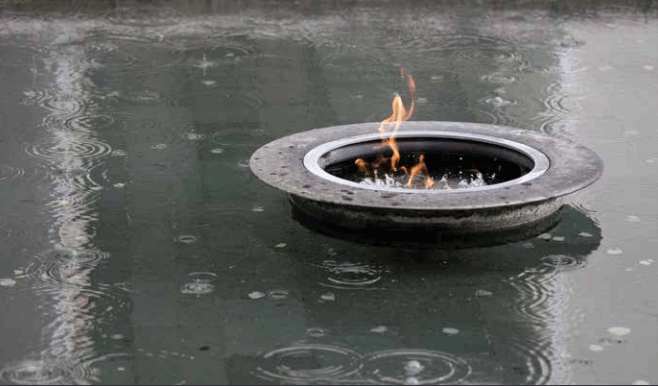

Lieutenant General Angus Campbell AO DSC was appointed to Council in May 2015. He joined the Australian Army in 1981, graduating from the Royal Military College – Duntroon in 1984. He was assigned to the Royal Australian Infantry Corps and initially served as a platoon commander in the 3rd Battalion (Parachute), The Royal Australian Regiment (3RAR).He then served in troop and squadron command appointments within the Special Air Service Regiment. In 2001 he was appointed the Commanding Officer of the 2nd Battalion, The Royal Australian Regiment (2RAR). While in command, the battalion group deployed to East Timor as a component of the United Nations Transitional Administration East Timor. Lieutenant General Campbell has also served in a range of staff appointments, including as Aide-de-Camp to the Chief of Army, as a strategic policy officer in Army Headquarters, an instructor at the Australian Command and Staff College, and as Chief of Staff to the Chief of the Defence Force. In late 2005, he joined the Department of Prime Minister and Cabinet as a First Assistant Secretary to head the Office of National Security. He was subsequently promoted to Deputy Secretary and appointed to the position of Deputy National Security Adviser. In these roles Lieutenant General Campbell was responsible for the preparation of advice to the prime minister on national security matters and coordinating the development of whole-of-government national security policy. Upon his return to the Australian Defence Force in early 2010 Lieutenant General Campbell was appointed to the rank of major general and led the Military Strategic Commitments staff in Defence Headquarters until January 2011, when he assumed command of Australian forces deployed in the Middle East Area of Operations. Lieutenant General Campbell subsequently served as Deputy Chief of Army from February 2012 to September 2013, when he was promoted to his current rank to command the Joint Agency Task Force responsible for the implementation of Operation Sovereign Borders. Lieutenant General Campbell was appointed Chief of the Australian Army on 16 May 2015.He holds a Bachelor of Science (Honours) from the University of New South Wales, a Master of Philosophy in International Relations from Cambridge University, and is a graduate of the Australian Army Command and Staff College. Lieutenant General Campbell was made an Officer in the Military Division of the Order of Australia in June 2017 for distinguished service as Head Military Strategic Commitments, Deputy Chief of Army, and Chief of Army

Mr Les Carlyon AC was reappointed to Council in June 2017 for a three-year term. He has previously served three-year terms on Council from June 2014, May 2006, and April 2009. Mr Carlyon has been editor of the Age, editor-in-chief of the Herald and Weekly Times group, and visiting lecturer in journalism at RMIT. He has received the Walkley Award (1971 and 2004) and the Graham Perkin Journalist of the Year Award (1993). Mr Carlyon is the author of Gallipoli, a bestseller in Australia, New Zealand, and Britain, and winner of the Queensland Premier’s History Prize. His The Great War, published in 2006, was the joint winner of the Prime Minister’s Prize for Australian History and was voted book of the year at the Australian Publishers’ Book Industry Awards. Mr Carlyon holds a Bachelor of Commerce degree from the University of Melbourne.

Brigadier Alison Creagh CSC (Retd) was appointed to Council in March 2015 for a three-year term. Brigadier Creagh is a Non-Executive Director of the Hospital Research Foundation and the Road Home-the Repat Foundation, Vice Chair of the Board of Governors for the Road Home, Vice Chair of the Australian Peacekeeping Memorial Project, and member of the Australian Capital Territory’s Defence Industry Advisory Board. Brigadier Creagh is an Adjunct Lecturer and research academic at the Australian Centre for Cyber Security at the University of New South Wales, Canberra. Brigadier Creagh retired from the Australian Regular Army in March 2015 after a 30-year career and continues to serve in the Army Reserve. She joined the Army in 1985 and graduated from the Officer Cadet School, Portsea, to the Royal Australian Corps of Signals. Brigadier Creagh served on operations in Cambodia in 1993 as Quartermaster of the Force Communications Unit as part of the United Nations Transitional Authority Cambodia; in East Timor in 1999–2000 where she was Second-in-Command of the 1st Joint Support Unit and then commanded 145th Signal Squadron as part of the International Force East Timor; in Iraq in 2006 and Afghanistan in 2008–09 as the Chief of Personnel (CJ1) in Headquarters International Security Assistance Force. Brigadier Creagh commanded the Defence Force School of Signals. Her senior military appointments included Director-General Public Affairs, Director-General Strategic Communication, and Director-General ADF Theatre Project (The Long Way Home). Brigadier Creagh was awarded the Conspicuous Service Cross in 1994 for her work in Cambodia, the NATO Meritorious Service Medal in 2008 for her work in Afghanistan, received a Chief of Defence Force Commendation in 2014, and the Meritorious Unit Citation as a member of the Force Communications Unit in Cambodia. Brigadier Creagh holds a Master of Management Studies, a Master of Defence Studies, a Graduate Diploma in Strategic Studies, a Graduate Diploma in Communications and Information Systems Management, and was awarded a scholarship to attend the Women’s Leadership Forum,Harvard Business School, in 2014.

Air Marshal Leo Davies AO CSC joined the Royal Australian Air Force as a cadet navigator in 1979 and graduated to fly P-3B and P-3C Orion aircraft with Number 11 Squadron at Edinburgh in South Australia. Air Marshal Davies completed pilot training in 1987 and after completing F-111 conversion course was posted to Number 1 Squadron at RAAF Base Amberley in 1988. In 1990, Air Marshal Davies was posted to Cannon Air Force Base, New Mexico, to fly F-111D aircraft on exchange with the United States Air Force. On return to Australia in 1993, Air Marshal Davies was posted to Number 1 Squadron as the Operations Flight Commander, followed by a year as Operations Officer at Headquarters Number 82 Wing during 1996. After a posting in 1997–98 as the Executive Officer at Number 1 Squadron, Air Marshal Davies completed RAAF Command and Staff Course. In 2000, he commenced two years in Capability Systems within Defence Headquarters. In 2002 and 2003, Air Marshal Davies’ long association with Number 1 Squadron was rekindled when he returned as Commanding Officer and achieved 2,000 hours flying the F-111. He was the Staff Officer to the Chief of Air Force during 2004, before taking up the post of Officer Commanding Number 82 Wing at RAAF Base Amberley, where he was awarded a Conspicuous Service Cross for outstanding achievement. Air Marshal Davies worked as Director Combat Capability within Air Force Headquarters in 2006 and 2007, during which time he was deployed to the Middle East to work in the Combined Air Operations Centre. Between 2008 and 2010, Air Marshal Davies was the Director General Capability Planning within Air Force Headquarters. He was then posted to Washington as the air attaché, where he was awarded the United Stated Legion of Merit – Officer. Air Marshal Davies returned from Washington in January 2012 to take up his appointment as Deputy Chief of Air Force. Air Marshal Davies was appointed an Officer of the Order of Australia in 2014 for distinguished service to the Australian Defence Force in senior command and staff appointments. He was promoted to Air Marshal and appointed Chief of Air Force on 4 July 2015.

Rear Admiral Ken Doolan AO RAN (Retd) was appointed to Council on 11 November 2009, and reappointed for a further term on 11 November 2012. Admiral Doolan was elected Chairman of Council on 6 March 2012, serving in that position until 11 November 2015. On 26 November 2015 he was appointed for another three-year term as a member of Council. Admiral Doolan joined the Royal Australian Navy as a 13-year-old cadet midshipman in January 1953 and completed full-time service in December 1993 with the rank of rear admiral. Admiral Doolan served in the destroyer HMAS Vampire during Confrontation with Indonesia in 1966, and in the guided-missile destroyer HMAS Perth during the Vietnam War. He was the first Commanding Officer of the Amphibious Heavy Lift Ship HMAS Tobruk and later commanded the guided-missile destroyer HMAS Brisbane. During the Gulf Crisis and Gulf War of 1990–1991 Admiral Doolan was Maritime Commander, Australia, and was appointed Operational Commander of all Australian combatant forces deployed to that conflict (Operation Damask). Admiral Doolan was appointed an Officer in the Military Division of the Order of Australia in January 1991. Since ceasing full-time naval service Admiral Doolan has held several remunerated and honorary positions including membership of the Defence Force Remuneration Tribunal, National Secretary of the Order of Australia Association, National President of the Australian Institute of Navigation, Chairman of the Forces Entertainment Board, Member of the Board of the Hoc Mai Foundation, member of the National Commission for the Centenary of Anzac, and member of the Defence Reserve Support Council. Admiral Doolan has written several books and in 2006 established a publishing company. After serving for many years as a member of the National Defence Committee of the Returned and Services League of Australia (RSL) he was elected RSL National President in September 2009, a position he held until June 2016. On 11 November 2016, he was inducted as a Fellow of the Australian War Memorial.

Ms Margaret Jackson AC was appointed to Council for a three-year term from 27 June 2017. Ms Jackson is Chairman of Ansett Aviation Training Limited and Prince’s Charities Australia and is also a Director of the Melbourne Symphony Orchestra, Barefoot to Boots, and a member of Monash University’s Industry Council of Advisors. Ms Jackson has served as Chairman of Spotless, Qantas, FlexiGroup Ltd, and the Victorian Transport Accident Commission, and a Director of the Broken Hill Proprietary Company Limited, the Australian and New Zealand Banking Corporation, Pacific Dunlop Limited, John Fairfax Holdings Limited, Billabong International Ltd, Telecom Australia,and West Gippsland Healthcare Group, and President of Australian Volunteers International. She is a former partner of KPMG Advisory and BDO Nelson. Ms Jackson was awarded Companion of the Order of Australia in the General Division (AC) in June 2003 for service to business in leading Australian corporations and to the community in the area of support for edical research, the arts and education. She was awarded the Centenary Medal in 2001 for service to Australian society in business. Ms Jackson holds an Honorary Doctorate of Laws from Monash University. She is the former Chairman of the Advisory Board for the Salvation Army Southern Territory, the Playbox Theatre Company, and Methodist Ladies’ College.

Corporal Daniel Keighran VC was appointed to Council in June 2016 for a three-year term. Corporal Keighran enlisted in the Australian Army at the age of 17 and served his country as part of the 6th Battalion, The Royal Australian Regiment (6RAR), discharging from full-time service in 2011. Corporal Keighran deployed to Rifle Company Butterworth, Malaysia, in 2001 and 2004; Timor-Leste (East Timor) in 2003–04; Iraq in 2006; and Afghanistan in 2007 and 2010. Corporal Keighran is the only Victoria Cross recipient from the Royal Australian Regiment in its proud 67-year history, with his citation reading: “For the most conspicuous acts of gallantry and extreme devotion to duty in action in circumstances of great peril at Derapet, Uruzgan province, Afghanistan, as part of the Mentoring Task Force One on Operation Slipper.” Since completing full-time service, Corporal Keighran has held various private sector roles including his current role as a brand ambassador to Australian Defence Apparel (ADA), working on military and tactical apparel and load carriage with the Research, Development and Innovations Team. Corporal Keighran continues to serve his country as an active reservist with the Australian Army and donates his time as an ambassador to Mates4Mates.

Major General Greg Melick AO RFD FANZCN SC was appointed to Council in March 2015. He is a Hobart-based senior counsel who has been a member of the ADF Reserves since 1966. Major General Melick commanded at all levels from section to brigade before becoming Australia’s most senior Reserve officer in 2007, and then the ADF’s Head of the Centenary of Anzac Planning Team in 2011. Units in which Major General Melick has served include the 2nd Battalion, Royal New South Wales Regiment, and One Commando Company. He has commanded the 12th/40th Battalion, Royal Tasmanian Regiment, and 8 Brigade. Major General Melick is the Colonel Commandant of 1st Commando Regiment. He has been a Principal Crown Counsel in the Tasmanian Crown Law Office, and a Statutory Member of the National Crime Authority and the NSW Casino Control Authority. He was appointed a part-time Deputy President of the AAT in September 2014 and part-time Chief Commissioner of the Tasmanian Integrity Commission in 2015. Major General Melick has conducted several investigations including one into the Beaconsfield mine collapse, and is Cricket Australia’s anticorruption special investigator. He is a member and former chairman of the board of St John Ambulance (Tasmania).

Ms Jillian Segal AM was appointed to Council in June 2014 for a three-year term. Ms Segal is a Non-Executive Director of the Garvan Institute of Medical Research, and Chair of the Australia–Israel Chamber of Commerce (NSW). She is Deputy Chancellor of UNSW Australia, and Chair of the General Sir John Monash Foundation, a national scholarship organisation. Ms Segal is a Trustee of the Sydney Opera House Trust, and a Director of the Grattan Institute. She was appointed Chair of the Independent Parliamentary Expenses Authority in July 2017. Ms Segal has previously held a range of other corporate and government board positions, including Non-Executive Director of ASX Limited, Non-Executive Director of the National Australia Bank, member of the federal government’s Remuneration Tribunal, Chair of Administration Review Council, and Chair of the Banking Industry Ombudsman Board (now FOS). From October 1997 to June 2002, Ms Segal was a Commissioner and later Deputy Chair of the Australian Securities and Investments Commission. Prior to this, Ms Segal was a partner at Allen, Allen & Hemsley (now Allens Linklaters). Ms Segal has a BA/LLB from the University of New South Wales, and an LLM from Harvard Law School. Ms Segal was awarded a Centenary Medal in 2003 for services to society through business leadership, and appointed a Member of the Order of Australia in 2005 for services to business law, particularly in the areas of financial services reform and market regulation.

Mr Kerry Stokes AC was elected as Chairman of the Australian War Memorial on 10 November 2015 with his term commencing on 12 November 2015. He was reappointed to Council in June 2017 for a further three-year term commencing in August 2017. Mr Stokes has previously been appointed to Council in August 2007, April 2011, and in August 2014. On 11 November 2015, he was inducted as a Fellow of the Australian War Memorial. Mr Stokes is Chairman of Seven West Media, a company which brings together a market-leading presence in broadcast television through the Seven Network, magazines and newspaper publishing through Pacific Magazines and West Australian Newspapers, and online through Yahoo!7 and other expanding new communications platforms. Mr Stokes is Chairman of Seven Group Holdings, a leading Australian diversified operating and investment group with market leading businesses and investments in industrial services and media. SGH has a major shareholding in Seven West Media. In industrial services, WesTrac Group is the sole authorised Caterpillar dealer in Western Australia, New South Wales, and the Australian Capital Territory in Australia, and in northeastern China. WesTrac Group is one of Caterpillar’s top five dealers globally. SGH Energy is developing an expanding presence in oil and gas projects in Australia and the United States. Through his private holdings, Australian Capital Equity, Mr Stokes has broad business interests and investments in a range of major business sectors: property, construction, mining, resources, and oil and gas exploration. Mr Stokes is a recipient of Australia’s highest honour, the Companion in the General Division in the Order of Australia (AC) in 2008, having earlier been awarded the Officer in the General Division of the Order of Australia (AO) in 1995. He holds a Centenary Medal for Corporate Governance, and presented the Boyer Lectures in 1994 and the Andrew Olle Lecture in 2001. Mr Stokes holds an honorary life membership of the Returned and Services League of Australia, and received an RSL Commendation Award for outstanding service rendered to the ex-service community. He is a recipient of the Rotary Paul Harris Fellow Award and is a former Chairman of the National Gallery of Australia.

Mrs Josephine Stone AM was appointed to Council on 26 February 2015 for a three-year term. Mrs Stone is a graduate of Melbourne Law School and has worked in a number of legal institutions, both public and private, in Victoria and the Northern Territory of Australia. Her previous professional involvements include being a statutory member of the Regional Telecommunications Independent Review Committee (CWTH), Professional Standards Manager at the Northern Territory Law Society, Assignments Director at the Northern Territory Legal Aid Commission, and solicitor with the Australian Government Solicitor and with private firms in Melbourne, Alice Springs, and Darwin. Mrs Stone is a director of a private family company. Her community engagements include Zonta Alice Springs, Darwin Private Hospital Advisory Board, NT Women’s Advisory Board, and Chairman of the Red Cross (Katherine) Flood Appeal, together with a number of roles in school parents and friends committees and boards in Darwin and Brisbane. Her personal interests have included instigating the 100-year history of St Mary’s Primary School in Darwin and the political advancement of women, which has involved appearances at international conferences as moderator and speaker. Mrs Stone was made a Member of the Order of Australia in 2006 for services to the law and the community.
APPENDIX 2
Senior staff profiles
Ms Anne Bennie was appointed Assistant Director, Branch Head Public Programs in January 2015. She joined the Memorial in 2003 as e-Business Manager and in 2004 was appointed Head, Retail and Online Sales, pursuing licensing and partnership opportunities with a number of commercial entities. Ms Bennie commenced planning and delivery of the Memorial’s program of First World War centenary projects in 2013 and has continued to manage the projects within the branch. Ms Bennie’s career prior to the Memorial was in market research, where she held numerous analytical roles within Nielsen Market Research, followed by senior account management roles in advertising agencies working withlarge consumer brands. Diverging into web projects, she delivered strategic direction across a number of websites and e-commerce initiatives with a strong focus on web integration, usability, and business outcomes. Ms Bennie has completed the Cultural Management Development Program and holds a Graduate Certificate in Public Sector Management.
Mr Mark Campbell was appointed Head, Retail and Online Sales in November 2014. He has over 20 years’ experience in retail, specifically in product development, buying, and retail operations. Mr Campbell was responsible for running multi-million retail operations consisting of 20 shops across numerous locations, and for developing the full retail operation for the then new Wet’n’Wild theme park in Sydney. Mr Campbell has won a number of Worldwide Industry Awards for developing products and is completing his MBA through Southern Cross University.
Mr Chris Chapman was the acting Head of Finance at various times during 2016–17. He joined the Memorial in December 2008 as Manager, Budgets and Financial Policy. Prior to working at the Memorial, Mr Chapman gained financial and management accounting expertise across a range of private enterprises and state-owned corporations. He has a Bachelor of Business (Accounting), and is a member of Chartered Accountants Australia and New Zealand. He completed the Cultural Management Development program in 2011.
Major General Brian Dawson AM CSC is the Head of Collection Services responsible for registrar and conservation functions within National Collections Branch. He was the Memorial’s Executive Manager for the Spirit of Anzac Centenary Exhibition travelling exhibition from December 2013 to June 2017. In April 2013 he retired from the Australian Regular Army with the rank of Major General, having completed 40 years’ service. During his time in the army Major General Dawson held senior appointments such as Australia’s first military representative to NATO and the European Union (2010–13); Head of the Australian Department of Defence Public Affairs (2008–10); Deputy Commander of the Australian Joint Task Force in Iraq based in Baghdad (2007–08); Commandant of the Australian Defence Force Academy (2006–07); and Chief of Staff Land Headquarters (2002–05). Major General Dawson was appointed a Member of the Order of Australia in 2000 for his work in Defence logistics, and was awarded the Conspicuous Service Cross for service in Somalia in 1995.
Mr Ashley Ekins has worked as a military historian at the Memorial since 1990 and has been Head of the Military History Section since 2007. A graduate of the University of Adelaide, Mr Ekins specialises in the history of the First World War and the Vietnam War. He has published widely, presented his research at international conferences, and led the Memorial’s battlefield tours to Gallipoli. His publications on the First World War include: 1918 year of victory: the end of the Great War and the shaping of history (2010, shortlisted for theTempler Medal); War wounds: medicine and the trauma of conflict (with Elizabeth Stewart, 2011); Gallipoli: a ridge too far (2013, second revised edition 2015); and he compiled and wrote the introduction to a special third edition of The Anzac Book, the classic anthology of soldiers’ writings and art from Gallipoli (2010). In his other major research area, the Vietnam War, Mr Ekins researched and wrote two volumes of the Official history of Australian involvement in Southeast Asian conflicts 1948–1975: Volume VIII, covering Australian ground operations in Vietnam, On the offensive: the Australian Army in the Vietnam War, 1967–1968, with the late Dr Ian McNeill (2003); and Volume IX Fighting to the finish: the Australian Army and the Vietnam War 1968–1975 (2012).
Mr David Fitzgerald joined the Memorial in 2006 as Manager, Buildings in the Corporate Services Branch, became acting Head of Buildings and Services in January 2013, and was promoted to this position in February 2015. Mr Fitzgerald came to the Memorial from private enterprise and has substantial facilities management experience. He has trade certificates for electrical and refrigeration services, and has completed various facilities and business management courses. Mr Fitzgerald was previously employed as building manager on Canberra Total Asset Management contracts, including the Foreign Affairs and Immigration buildings. David completed the Cultural Management Development Program in 2008.
Mr Nick Fletcher began working at the Memorial in 1995, and was appointed Head of Military Heraldry and Technology in 2009. In March 2011, he was temporarily transferred to the Exhibitions Section as Concept Leader for the redevelopment of the First World War galleries, a task which was completed with the official opening of the new galleries in February 2015. Mr Fletcher has a Bachelor of Arts (Graphic Design) and completed the Cultural Management Development Program in 2006. He became the first Memorial staff member to visit Afghanistan as an official curator in 2009, making further visits in 2011 and 2015. Mr Fletcher has been a regular leader of Australian War Memorial battlefield tours to Gallipoli and the Western Front.
Ms Kristy Gosang worked at the Memorial from 29 August 2016 until 29 June 2017 as the acting Head of Finance. She has held senior Financial Management roles across government with over 16 years’ experience. Ms Gosang is a qualified Certified Practicing Accountant and holds a Bachelor of Commerce (Accounting and Finance) from the Australian National University.
Ms Frances Henderson has been Head of Human Resources since August 2015. She joined the Memorial in May 2013 as the Manager of Performance and Employee Relations. Ms Henderson has held senior human resource roles within the public and private sectors, including ten years with the United States Department of State providing regional human resource expertise throughout the South Pacific region. She has a business degree from Monash University and is a Certified Professional of the Australian Human Resources Institute.
Ms Sarah Hitchcock joined the Memorial’s Education and Visitor Services Section in August 2008 after 12 years with Australian Capital Tourism, her final year as General Manager. From 2010 to 2012, Ms Hitchcock returned to the ACT Government and held the position of Director of the Centenary of Canberra. Working with Creative Director Robyn Archer AO, Ms Hitchcock led the formation and establishment of the Centenary of Canberra team, governance arrangements, and prepared the program of events and activities scheduled for the centenary. Ms Hitchcock rejoined the Memorial in September 2012 as Head of the Commemoration and Visitor Engagement Section where she has managed the development and implementation of the Memorial’s commemorative program and overseen programming and services provided to visitors and school groups. Ms Hitchcock is studying psychology. Ms Hitchcock’s board membership experience includes the Board of Management of the Tidbinbilla Nature Reserve and Birragai Centre, and the ACT Tourism Industry Council.
Mr Ryan Johnston was appointed Head of Art in October 2012. He and his curatorial staff oversee one of the most significant collections of Australian art, consisting of more than 37,000 artworks ranging from the 19th century to the present day. In this role he also manages Australia’s official war art scheme, through which artists are deployed to war zones and peacekeeping missions around the world. Prior to joining the Memorial, Mr Johnston was Acting Director of the Shepparton Art Museum, leading a major redevelopment of the museum and its subsequent relaunch. He has also worked as a Lecturer in the School of Creative Arts at the University of Melbourne. Mr Johnston’s research has been published in a range academic journals, books, and exhibition catalogues, and recognised with several awards, including a Yale University fellowship. Mr Johnston is Chair of Canberra Youth Theatre and a member of the board of Canberra Contemporary Art Space.
Ms Brie Lloyd was appointed as Head of Digital Experience in April 2016. She has over ten years’ experience in digital marketing, including both agency side- and marketing-side roles. Ms Lloyd has worked for one of the biggest global communications agencies, Publicis Groupe, and developed a digital offering to key multinational clients. Most recently Ms Lloyd was responsible for the strategic development and rollout of major B2C, B2B, and e-commerce digital solutions for Sanofi, a multinational company in the pharmaceutical industry.
Ms Katherine McMahon was appointed Head of Exhibitions in 2006 and has played an instrumental role in developing the strategic direction of the Memorial’s exhibitions program. Ms McMahon has overseen $70 million of major gallery redevelopment projects and delivered permanent exhibitions on the First World War, Second World War, Korea, Vietnam, peacekeeping, First Gulf War, Iraq, and Afghanistan. She most recently oversaw the $32 million redevelopment of the Memorial’s historic and heritagelisted First World War galleries. This project was a key part of the package of commemorative events and initiatives of the Australian Government’s Anzac Centenary Program 2014–18. Ms McMahon holds a Bachelor of Arts (Art History and Curatorship) from the Australian National University. Ms McMahon is on temporary transfer to the National Museum of Australia until 30 August 2018.
Ms Suzanne Myers has worked at the Australian War emorial for over 20 years and has held various positions in the Exhibitions section since 2004. As a senior member of the Exhibitions team for the past 12 years, Ms Myers has played a key role in the development and implementation of the strategic direction of the exhibitions program and played a major role in the development of large, permanent, exhibition projects including the redevelopment of the First World War galleries, Conflicts 1945 to today galleries including the Discovery Zone and C.E.W. Bean Building, and the Hall of Valour redevelopment. Ms Myers also led and managed the development, production, and installation of; Afghanistan: the Australian story, and the redevelopment of Middle East gallery.
Ms Myers was appointed as acting Head of Exhibitions in January 2017 and is responsible for the development and management of the Memorial’s galleries and exhibitions program including the planning, implementation, and maintenance of 13,000 sq m of permanent exhibitions and galleries, temporary and special exhibitions and displays, and a national touring program.
Dr Brendan Nelson AO commenced as Director of the Australian War Memorial on 17 December 2012. Prior to this, he was the Australian Ambassador to Belgium, Luxembourg, the European Union, and NATO (2009–12). Apart from overseeing a major transformation in Australia’s relationships with the European Union and NATO, Dr Nelson forged deep links with the communities of Flanders, where almost 13,000 Australians lost their lives during the First World War.
Dr Nelson studied at Flinders University, South Australia, where he graduated with a Bachelor of Medicine and Surgery. He worked as a medical practitioner in Hobart from 1985 to 1995. In 1993 he was elected unopposed as National President of the Australian Medical Association (AMA).
In 1996 Dr Nelson was elected to the Parliament of the Commonwealth of Australia. After the 2001 election, he was promoted from his role as Parliamentary Secretary for Defence to Cabinet in the senior portfolio of Minister for Education, Science and Training, driving major reforms to universities and a focus on school standards and reporting.
In 2006 he became Minister for Defence when troops were deployed to Iraq, Afghanistan, East Timor, and Solomon Islands. He oversaw major new investments in defence, including the decision to purchase 24 FA-18F Super Hornets, three air warfare destroyers, two Landing Helicopter Docks (LHDs), two additional battalions for the Australian Army, and a multi-billion dollar recruitment and retention package. In November 2007 Dr Nelson was elected leader of the Liberal Party of Australia, serving as Leader of the Opposition until September 2008. The following year he retired from federal politics before taking up his ambassadorial appointment.
Ms Leanne Patterson has been the Memorial’s Chief Finance Officer (CFO) since December 2007 and has been acting Assistant Director, Corporate Services, since January 2016. She joined the Memorial in December 1999 as Manager, Financial Reporting and Analysis, and was primarily focused on developing the framework to support the funding, valuation, and depreciation of the Memorial’s billiondollar collection of heritage and cultural assets. As CFO, Ms Patterson has successfully influenced the outcome of government-wide financial and budget reforms as they relate to the Memorial, through regular participation in formal working groups, inquiries, and other consultative processes. Ms Patterson is a Fellow of CPA Australia and has a Bachelor of Commerce (Accounting) from James Cook University. Leanne is an active member of the ACT CPA Public Sector Accountants Committee.
Mr Hans Reppin has been the Head of Photographs, Film, Sound and Multimedia Services since March 2014, and manages the Multimedia and Digital Asset Management System. His background includes a diverse range of managerial positions and technical responsibilities. Mr Reppin’s specialised professional background encompasses digital preservation management, Prolab experience within the television industry (motion picture, news, traditional film base processing, exhibition and commercial print outputs), and press and production photography experience garnered over 20 years. He is applying his expertise to digital content management and preservation within a museum environment as a digital advocate and innovator.
Mr Tim Sullivan was appointed Assistant Director Branch Head National Collection in May 2013. He graduated from the University of Sydney where he studied history, English literature, and education. Mr Sullivan has qualifications in earth sciences and a Masters in Management with a focus on museum development from the University of Technology, Sydney. His career has encompassed technical and managerial roles in the Geological Survey of NSW, the NSW Department of Mineral Resources, the Australian Museum, and the Sovereign Hill Museums Association, Ballarat. In 1999–2000, Mr Sullivan was a Visiting Fellow with the Smithsonian Institution’s National Museum of the American Indian in Washington DC. He has served on the Museums Board of Victoria and is a member of the National Cultural Heritage Committee. Mr Sullivan has served on a diverse range of committees promoting regional research and development, heritage management, commemorative projects, and museum development. He has contributed to national and international forums on museum practice and development, and has written widely on the role of museums in promoting learning and regional heritage strategies.
Ms Robyn van Dyk is Head of the Australian War Memorial’s Research Centre. Her work involves leading the Research Centre team to develop, manage, preserve, and provide access to the Memorial’s archival and published collections. Ms van Dyk has curated a variety of exhibitions, including co-curating the MAGNA award-winning Anzac voices (2014) and a joint exhibition with Australian Geospatial-Intelligence Organisation, Gallipoli to Afghanistan and the future: 100 years of mapping (2015). She is the concept leader for Anzac connections, the Memorial’s major centenary web project to enhance availability and access to digital content. Ms van Dyk has produced museum-related publications and delivered papers at national conferences. In October 2012, she travelled to Afghanistan as the Memorial’s official curator, and spent several weeks observing conditions and collecting records and objects. Ms van Dyk has recently partnered with the Australian National University in an ARC-funded project researching Australians in Borneo during the Second World War.
Mr Chris Wagner was appointed Head of Communications and Marketing at the Australian War Memorial in May 2016. He and his team are responsible for media, public relations, marketing, publications, the Friends of the Memorial, and the broader sponsorship program of the Memorial. Mr Wagner has over 15 years’ experience in the communication sector, working in ministerial offices, government departments, and for a number of not-for-profit and corporate organisations. A former journalist, Mr Wagner has a background in matters of mental health, suicide, criminal and civil justice, national security emergency management, and grassroots community liaison. He has a First Class Honours Degree in Journalism and is a White Ribbon Ambassador.
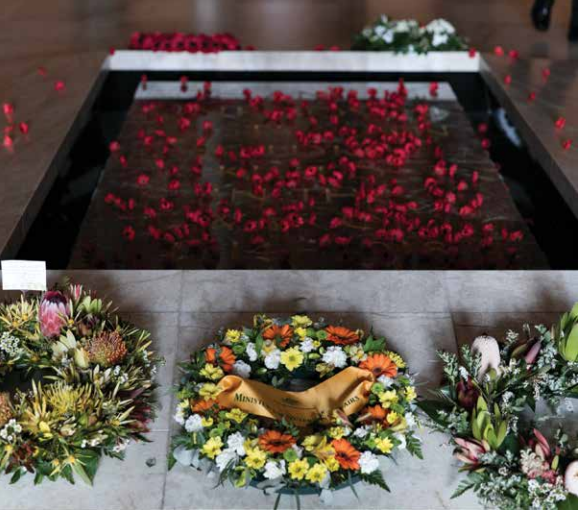
APPENDIX 3
Selected VIP visits, events and ceremonies
VIP visits
5 July 2016 - Mr Hu Minglang Director-General of Narcotics Control Bureau (NCB), People’s Republic of China
13 July 2016 - General Dalbir Singh Suhag, Chief of the Army Staff, India
16 July 2016 - Ministry of Foreign Affairs Ambassador Tibor Schlosser, Special Envoy for the Pacific Islands, Israel
20 July 2016 - Rear Admiral Jacques Cousquer, Head of International Development Division of the Directorate General of Armaments, France
20 July 2016 - Air Vice-Marshal Tony Davies, Chief of Air Force, Royal New Zealand Air Force
27 July 2016 - His Excellency Mr Kyoung-ha Woo, Ambassador Extraordinary and Plenipotentiary, Republic of Korea and delegation
1 August 2016 - Major General Melvyn Ong Su Kiat, Chief of Army, Singapore
3 August 2016 - Ambassador Jayant Prasad, Director General Institute for Defence Studies and Analysis, and His Excellency Mr. Navdeep Suri, High Commissioner of India
4 August 2016 - Major General Martin M Bricknell, Director Medical Policy, Operations and Capability, Headquarters Joint Forces Command, United Kingdom
8 August 2016 - General Jonathan Vance, Chief of Defence Staff, Canada
15 August 2016 - Lieutenant General Peng Bo, Deputy Chief of PLA Army, People’s Republic of China
17 August 2016 - Major General Peter Kelly MNZM, Chief of Army, New Zealand
18 August 2016 - Mr Kwok Fook Seng, High Commissioner, Singapore
22 August 2016 - Lieutenant General Anthony Crutchfield, US Pacific Command
4 September 2016 - Ms Elaine Ng, Chief Executive Officer, National Library Board, Singapore
5 September 2016 - Colonel Ilai Moceica, Deputy Secretary of Defence, Fiji
8 September 2016 - Vice Admiral Robert P. Burke, USN, Deputy Chief of Naval Operations, US
10 September 2016 - His Excellency Mr Hieu Van Le AC, Governor of South Australia
11 September 2016 - Major General Kanji Tanaka, Vice Commandant, JASDF Air Staff College, Japan
14 September 2016 - Mr Ze’ev Elkin, Minister for Environmental Protection, Israel
20 September 2016 - Senator Delegation, France
26 September 2016 - Air Vice-Marshal John McGarry CSC, Director, Defence Intelligence Organisation, Australia, accompanied by Major General Onno Eichelsheim, Director, Defence Intelligence and Security Service, Netherlands
29 September 2016 - His Excellency Jean Asselborn, Minister of Foreign and European Affairs of the Grand Duchy of Luxembourg
3 November 2016 - Major General Aamir Abbasi, Commandant of Command and Staff College, Quetta, Pakistan
4 November 2016 - Rear Admiral Stephanie Keck, Deputy Director for Operations, Joint Improvised-Threat Defeat Agency, US
7 November 2016 - Major General Wang, Xiaojun, People’s Republic of China
8 November 2016 - The Honourable Jody Wilson-Raybould, Minister of Justice and Attorney General, Canada
9 November 2016 - Major General Dr Ansgar Rieks, Director General, Military Aviation Authority, Germany
9 November 2016 - Mr Yang Mingsheng, Chairman, China Life Group
10 November 2016 - His Excellency János Áder President of the Republic of Hungary
12 November 2016 - Lieutenant General David Berger, Commander of US Marine Corps Forces Pacific
13 November 2016 - Dr Jamie Morin, Director, Cost Assessment and Program Evaluation, US
20 November 2016 - Mr Jean-Marc Todeschini, Minister for Veterans’ Affairs and Remembrance, France
21 November 2016 - Brigadier General Neo Hong Keat, Commander Air Power Generation Command, Republic of Singapore Air Force
23 November 2016 - Their Majesties the King and Queen of the Hashemite Kingdom of Jordan
23 November 2016 - Major General Lere Anan Timur, Chief of Defence Force, Timor-Leste
28 November 2016 - Minister Tzachi Hanegbi, Prime Minister’s Office, Israel
29 November 2016 - Mr Devin Wenig, CEO and President, eBay, USA
30 November 2016 - The Honourable Francis Awesa MP, Minister for Works and Implementation, Papua New Guinea
30 November 2016 - Lieutenant General Goro Yuasa, Vice Chief of Staff, Japanese Ground Self Defence Force
6 December 2016 - Mayor Frédéric Leturque, Mayor of Arras, France
7 December 2016 - General John. F. Kelly (Retd), US Marine Corps
12 December 2016 - Vice Admiral Thomas S. Rowden, Commander Naval Surface Forces, US Pacific Fleet
12 December 2016 - Mr Qadeer Jawad, Deputy Minister of Finance and Administration, Afghanistan
18 January 2017 - General John Hyten, Commander of US Strategic Command
23 January 2017 - Admiral Yutaka Murakawa, Chief of Staff Japan Maritime Defence Force
2 February 2017 - Colonel Mike Boger, US Pacific Command
6 February 2017 - Lieutenant General Perry Lim, Chief of Defence Force, Singapore
9 February 2017 - Sir Roy Gardner, Global Chairman Serco Group plc, UK
10 February 2017 - Commodore Phil Warwick RN, Assistant Chief of Navy Staff, UK
13 February 2017 - Mr Mohammad Shakir Murady, Chief of Staff of the National Security Adviser, Afghanistan
14 February 2017 - General Sir Adrian Bradshaw KCB OBE, Deputy Supreme Allied Commander, Europe
15 February 2017 - Professor Dr Aung Tun Thet, Member of the Peace Commission and Representative of Daw Aung San Suu Kyi, Myanmar
16 February 2017 - Mrs Patricia Adam, Chair of the National Defence and Armed Forces Committee, France
27 February 2017 - General Tom Middendorp, Chief of Defence, Kingdom of the Netherlands
28 February 2017 - Right Honourable David Carter MP, Speaker of the House of Representatives, New Zealand
1 March 2017 - Mrs Marillyn A. Hewson, CEO, Lockheed Martin Corporation, US
2 March 2017 - Mr Jean-Marc Ayarault, Minister of Foreign Affairs and International Development, France
7 March 2017 - Special Agent Andrew Traver, Director Naval Criminal Intelligence Service, US
7 March 2017 - Mr Ratu Inoke Kubuabola, Defence Minister, Fiji
8 March 2017 - His Excellency Sheikh Dr Mohammad Alsabah, Former Minister For Foreign Affairs, Kuwait
9 March 2017 - Ambassador Martin Kimani, Kenyan President’s Special Envoy for Countering Violent Extremism
13 March 2017 - Lieutenant General Gary H Cheek, Director of the Army Staff, US
20 March 2017 - Mr Ian Liddell-Grainger MP and CPA UK Parliamentary Delegation
21 March 2017 - Institute for Higher National Defence Studies, France
23 March 2017 - Mrs Gabriela Michetti, Vice President of Argentina and President of the Senate
27 March 2017 - Madam Halimah Yacob, Speaker of the Parliament of Singapore
27 March 2017 - General Pierre de Viliers, Chief of Defence Staff, France
28 March 2017 - The Right Honourable Peter Lilley MP, UK
29 March 2017 - Mr Peeni Henare, MP, Tamaki Makaurau, New Zealand
29 March 2017 - Senator Hervé Maurey, Chairman of the Committee of Land-use Planning and Sustainable Development of the French Senate
30 March 2017 - Mr Daniel Payne, Director Defense Security Service, US
1 April 2017 - Ms Cara Abercrombie, Deputy Assistant Secretary of Defense for South and Southeast Asia, US
6 April 2017 - His Excellency Gebran Bassil, Minister for Foreign Affairs and Emigrants of Lebanon
11 April 2017 - Colonel Henry Neumann, Commander of the Bundeswehr CBRN Defence Command, Germany
12 April 2017 - Delegation of Senior Advisers to Members of the US Congress and Senate
23 April 2017 - Vice Admiral Adnan Özbal, Chief Of Staff, Turkish Naval Forces
27 April 2017 - Major General Eric Wesley, Commanding General Maneuver Centre of Excellence, US Army
4 May 2017 - Ms Gabriele Lösekrug-Möller, Parliamentary State Secretary of the Federal Ministry of Labour and Social Affairs, Germany
5 May 2017 - Mr Laurent Collet-Billon, Head of the General Armament Directorate of the French Ministry of Defence
8 May 2017 - Major General Syed at Amur Gilani representing General Zubair Hayat, Chairman Joint Chiefs of Staff Committee, Pakistan
10 May 2017 - His Excellency Mr David Jalagania, Deputy Minister, Ministry of Foreign Affairs, Georgia
11 May 2017 - Mr Craig Kelly MP, Member for Hughes, New South Wales
15 May 2017 - Brigadier Phil Kimber OBE, UK
16 May 2017 - Warrant Officer Glenn Haughton, Army Sergeant Major, British Army, UK
16 May 2017 - Brigadier General Huseyin Duman, Head of the Foreign Relations Department, Turkey
17 May 2017 - Lieutenant General Konstantinos Floros, Deputy Chief of the Hellenic National Defence General Staff, Greece
19 May 2017 - Secretary Agustin Conde Bajén, Secretary of Defense, Spain
23 May 2017 - Brigadier General Donald Bolduc, Commander, US Special Operations Command, Africa
24 May 2017 - Admiral Dhowan, Former Chief of Indian Navy
24 May 2017 - Delegation from the Parliament of Malaysia
24 May 2017 - Major General Mervyn Tan, Chief of Air Force, Republic of Singapore
25 May 2017 - General Humberto Oviedo Arriagada, Commander-in-Chief, Chilean Army
25 May 2017 - The Honourable Stuart Robert MP, Member for Fadden, Queensland
29 May 2017 - Senator John McCain, US
30 May 2017 - Lieutenant General Sir John Lorimer KCB DSO MBE, Chief of Joint Operations PJHQ, UK
30 May 2017 - Mr Kim Young-woo, Member of the National Assembly and Chair of the National Defense Committee, Republic of Korea
30 May 2017 - Air Vice Marshal Arjun Subramaniam, Joint Secretary, National Defence College, India
1 June 2017 - Senator the Honourable James McGrath, Queensland
2 June 2017 - Her Excellency Ms Jane Duke, Australian Ambassador to Association of Southeast Asian Nations (ASEAN)
5 June 2017 - Major General (Retd) Udi Adam, Director General, Israeli Ministry of Defense
8 June 2017 - Air Vice-Marshal Bruno Paccagnini, Deputy Chief of Staff, Long Term Planning and Military Strategy, Joint Staff, French Armed Forces
10 June 2017 - His Excellency Dr Ajay Marotrao Gondane, High Commissioner of India to Australia
13 June 2017 - General Petr Pavel, Chairman of the Military Committee, NATO
13 June 2017 - International delegation from the Office of Cyber Security, US, UK, Canada, Australia, NZ
14 June 2017 - Vice Admiral Harish Chandra Singh Bisht, Flag Officer Commanding-In-Chief, Eastern Naval Command, Indian Navy
15 June 2017 - The Honourable Bill Shorten MP, Leader of the Opposition
16 June 2017 - His Excellency Mr Jean-Luc Bodson, Belgian Ambassador
22 June 2017 - His Imperial Highness, Prince Ermias of Ethiopia
22 June 2017 - Brigadier General Ong Tze-Ch’in, Director Military Intelligence, Singapore
26 June 2017 - Rear Admiral Viliame Naupoto, Commander Military Forces, Republic of Fiji
28 and 29 June 2017 - Lieutenant General David Berger, Commanding General US Marine Forces Pacific, US
Events and ceremonies
7 July 2016 - Farewell function for Rear Admiral Ken Doolan AO RAN (Retd)
31 July 2016 - Australian Army Training Team Vietnam wreathlaying ceremony
1 August 2016 - Z Special plaque dedication ceremony
8 August 2016 - 8 RAR 50th anniversary wreathlaying ceremony
17 August 2016 - Mr John Schumann and Mr Hugh McDonald commemorative performance for Vietnam veterans in the Hall of Memory
18 August 2016 - Vietnam Vale commemorative recitation
18 August 2016 - 50th anniversary of the battle of Long Tan and Vietnam Veterans’ Day stand to ceremony
29 August 2016 - National Launch of Legacy week
31 August 2016 - Australian National Flag Day ceremony
31 August 2016 - Centenary of 2 Squadron ceremony
1 September 2016 - Buick Car Club vehicle display
2 September 2016 - National Student Leadership Forum ceremony
5 September 2016 - Band of the 1st Regiment, Royal Australian Regiment Artillery performance
7 September 2016 - Battle for Australia wreathlaying ceremony
8 September 2016 - National Servicemen’s Association of Australia wreathlaying ceremony
10 September 2016 - Big things in store
10 September 2016 - Out of the Shadows Lifeline walk
20 September 2016 - TPI Annual Congress wreathlaying ceremony
22 September 2016 - For Country, for Nation exhibition launch
5 October 2016 - Middle East Exhibition and Afghanistan: the Australian Story DVD launch
9 October 201 - 6 ACT Solo Piping and Drumming Championship Competition
16 October 2016 - 2 Field Ambulance poppy laying ceremony
22 October 2016 - Australian Military Wives Choir performance
27 October 2016 - Campbell High School wreathlaying ceremony
11 November 2016 - Remembrance Day National Ceremony
11 November 2016 - Australian War Memorial 75th anniversary dinner
6 February 2017 - Parliamentary Last Post Ceremony
6 February 2017 - Parliamentary Last Post Ceremony
17 March 2017 - ACT RSL Congress wreathlaying ceremony
29 March 2017 - Commemorative Area smoking ceremony
29 March 2017 - Cert IV in Government Security wreathlaying ceremony
30 March 2017 - Aged Care Anzac Day wreathlaying ceremony
1 April 2017 - National Day of Prayer for Defence wreathlaying ceremony
3 April 2017 - Flanders Memorial Garden soil handover
4 April 2017 - Flanders Memorial Garden dedication ceremony
25 April 2017 - Anzac Day Dawn Service
25 April 2017 - Anzac Day National Ceremony
4 May 2017 - The Dominion Yachtsmen Scheme plaque dedication ceremony
9 May 2017 - Nurses and Midwives wreathlaying ceremony
26 May 2017 - National Sandakan Remembrance Day wreathlaying ceremony
29 May 2017 - Special Operations Command Australia plaque dedication ceremony
1 June 2017 - Australian Army Training Team Iraq plaque dedication ceremony
4 June 2017 - Annual Bomber Command commemorative ceremony
4 June 2017 - Bomber Command 75th anniversary commemorative luncheon
8 June 2017 - Canine Operational Service Medal launch
22 June 2017 - Parliamentary special exhibition viewing
Commemorative anniversary Last Post ceremonies
1 July 2016 - 100th anniversary of the Battle of the Somme
7 July 2016 - NAIDOC Week
10 July 2016 - 105th anniversary of the Royal Australian Navy
19 July 2016 - Centenary of the battle of Fromelles
23 July 2016 - Centenary of the battle of Pozières
29 July 2016 - Centenary of the battle of Mouquet Farm
5 August 2016 - 100th anniversary of the battle of Romani
11 August 2016 - 50th anniversary of the end of the Indonesia-Malaya Confrontation
15 August 2016 - 71st anniversary of the Victory in the Pacific
18 August 2016 - 50th anniversary of the battle of Long Tan
29 August 2016 - Parliamentary Last Post Ceremony
15 September 2016 - 76th anniversary battle of Britain
22 September 2016 - For Country, for nation launch Last Post Ceremony
5 October 2016 - 65th anniversary battle of Maryang San
11 November 2016 - Remembrance Day National Ceremony
19 November 2016 - 75th anniversary of the sinking of HMAS Sydney
7 December 2016 - 75th anniversary of Australia’s declaration of war against Japan
9 December 2016 - 75th anniversary of the Fall of Gona
23 December 2016 - 100th anniversary of the battle of Magdhaba
23 January 2017 - 75th anniversary of the Fall of Rabaul
3 February 2017 - 75th anniversary of the Fall of Ambon, Netherlands East Indies
6 February 2017 - Parliamentary Last Post Ceremony
14 February 2017 - 75th anniversary of the sinking of SS Vyner Brook
15 February 2017 - 75th anniversary of the Fall of Singapore
16 February 2017 - 75th anniversary of the Banka Island massacre
17 February 2017 - 50th anniversary of the battle of Bribie
19 February 2017 - 75th anniversary of the bombing of Darwin
23 February 2017 - 75th anniversary of the surrender of Australian forces (Sparrow Force) on Timor
28 February 2017 - 75th anniversary of the battle of Sunda Strait
1 March 2017 - Army birthday
4 March 2017 - 75th anniversary of the sinking of HMAS Yarra
8 March 2017 - 75th anniversary of the Fall of Java
26 March 2017 - Centenary of the First Battle of Gaza
31 March 2017 - RAAF birthday
9 April 2017 - 75th anniversary of the sinking of HMAS Vampire
11 April 2017 - Centenary of the first battle of Bullecourt
15 April 2017 - Centenary of the battle of Lagnicourt
25 April 2017 - Anzac Day
3 May 2017 - Centenary of the second battle of Bullecourt
4 May 2017 - 75th anniversary of the battle of Coral Sea
8 May 2017 - 72nd anniversary of the Victory in Europe
14 May 2017 - 74th anniversary of the sinking of AHS Centaur
16 May 2017 - Centenary Australian War Records Service
26 May 2017 - National Sandakan Remembrance Day
28 May 2017 - 115th anniversary of the end of the Boer War
31 May 2017 - 75th anniversary of the Japanese midget submarine attack on Sydney Harbour
1 June 2017 - Reconciliation Week
3 June 2017 - Bomber Command
4 June 2017 - 75th anniversary of the Battle of Midway
7 June 2017 - Centenary of the battle of Messines
16 June 2017 - 75th anniversary of the sinking of HMAS Nestor
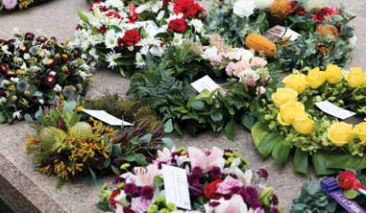
APPENDIX 4
Staff publications, talks, lectures and papers
Michael Bell
Australian War Memorial Information, talk, 3 July 2016
Unveiling of RAAF’s Indigenous Commemorative Plaque, talk, RAAF Memorial Grove, Canberra, 6 July 2016
Last Post Ceremony walkthrough, sound recording, photo shoot and donation with Aircraftsman Brodie McIntyre, talk, Australian War Memorial, 7 July 2016
Donation of Douglas Grant photograph, talk, Australian War Memorial, 7 July 2016
Gallery tour, talk, Australian War Memorial, 8, 21 July 2016; 20 October 2016
Albert Charles Leane, Indigenous Fromelles POW, interview, NITV, 21 July 2016
“Representation and policies and protocols of Aboriginal and Torres Strait Islanders images, stories and objects within the AWM and other institutions”, talk, Australian National University Centre for Heritage and Museums, 13 September 2016
Acknowledgement and Welcome to Country and overview of Aboriginal and Torres Strait Islander service and contribution to Australian Military Forces, Australian War Memorial, 13 September 2016
Australian War Memorial information stall, talk, Aboriginal Rugby League knockout, 30 September 2016
Indigenous service, Australian War Memorial update and briefing, Defence Aboriginal and Torres Strait Islander Network (DATSIN), Canberra, 5 October 2016
Gallery tour, For Country, for Nation exhibition; talk; Australian War Memorial; 2016: 6, 10, 11, 13, 18, 21 October; 3, 8, 15, 17, 21, 29, 30 November; 6, 9 December; 2017: 17, 18, 31 January; 7, 14, 15, 17 February; 21, 23, 24, 28, 29, 31 March; 18, 24 April; 1, 11, 17, 24 May; 1, 2, 20, 23 June
Last Post Ceremony, talk, Australian War Memorial, 6 October 2016
For Country, for Nation exhibition and Aboriginal and Torres Strait Islander service, interview, 4RR Bidjara Media & Broadcasting Company Ltd, Australian War Memorial, 3 November 2016
For Country, for Nation exhibition and Aboriginal and Torres Strait Islander service, interview, SBS TV, Australian War Memorial, 8 November 2016
“Recognition of Aboriginal and Torres Strait Islander service”, foreword to Too Dark To See, Western Sydney University, 9 November 2016
“Recognition of Aboriginal and Torres Strait Islander service”, talk, Australian War Memorial, 9 November 2016
Indigenous perspective on the bombing of Darwin, interview, CAAMA Aboriginal Radio Alice Springs, Australian War Memorial, 16 February 2017
“Indigenous sculpture commission”, talk, Australian War Memorial, 17 February 2017
“Colonial conflicts and Rover Thomas acquisition”, lecture, Australian War Memorial, 1 March 2017
“Rover Thomas acquisition Ruby Plain Massacre No.1”, talk, Australian War Memorial, 3 March 2017
“Cultural protocols for inclusion of Aboriginal performers, instruments and cultural symbols into the Army military bands”, talk, Australian War Memorial, 8 March 2017
“Shirley Macnamara’s Memoir”, talk, Australian War Memorial, 21 March 2017
Indigenous service, talk, Australian War Memorial, 24 March 2017
“The role of the Indigenous Liaison Officer and Australian War Memorial programs and projects relating to Indigenous service”, talk, Australian War Memorial, 28 March 2017
Ngunnawal Elders’ Welcome to Country and Smoking Ceremony, talk, Aboriginal and Torres Strait Islander Australian Defence Force personnel, Australian War Memorial, 29 March 2017
“The story of William Charles Westbury Aboriginal soldier, the Boer War and First World War”, article, https://oldsite.awm.gov.au/ blog/2017/03/30/421-william-charles-westbury-boer-war-and-world-war-1/ , 31 March 2017
“The contribution of Indigenous people to Australia’s military history”, conference paper, Townsville Public Library, 20–21 April 2017
Aboriginal & Torres Strait Islander contribution and service to Australian military history, interview, Radio 4KIG, 21 April 2017
Aboriginal and Torres Strait Islanders’ participation and role in service and how it is commemorated, interview, RTRFM 92.1, Australian War Memorial, 24 April 2017
“Aboriginal presence on Gallipoli grows”, article, https://www.awm.gov.au/articles/blog/aboriginal-presence-on-gallipoli-grows/, 25 April 2017
Aboriginal and Torres Strait Islander participation in past conflicts, interview, ABC Radio, Australian War Memorial, 27 April 2017
“Indigenous service during the Second World War”, Australian War Memorial, 2 May 2017
“Indigenous service”, Australian War Memorial, 3 May 2017
Daniel Boyd artist briefing, talk, Melbourne, 4 May 2017
“Aboriginal and Torres Strait Islander photo collection and cross-institutional exchanges”, talk, AIATSIS, 5 May 2017
Welcome to Country and overview of the role of the Australian War Memorial and the contribution of Aboriginal and Torres Strait Islander service to Australian military forces, talk, Australian War Memorial, 23 May 2017
Welcome to Country and overview of the role of the Australian War Memorial and the contribution of Aboriginal and Torres Strait Islander service to Australian military forces and For Country, for Nation exhibition, talk, Australian War Memorial, 25 May 2017
The role of the Australian War Memorial and the contribution of Aboriginal and Torres Strait Islander service to the ADF, ACT Branch of the Defence Aboriginal and Torres Strait Islander Network, Department of Defence, 31 May 2017
Acknowledgement of country and the long-standing tradition of service in the Saunders family, talk, International Cultural Week, Australian Defence Force Academy, 16 June 2017
Donation of images of First and Second World War Aboriginal servicemen, Australian War Memorial, 20 June 2017
Gallery tour and representation of Aboriginal and Torres Strait Islander personnel, objects and images within the Australian War Memorial’s galleries; For Country, for Nation exhibition and Last Post Ceremony; talk; Australian War Memorial; 26 June 2017
“Understanding the numbers: analysis of growth of identified Aboriginal and Torres Strait Islanders in the First AIF”, talk, What Tell Why exchange, Australian War Memorial, 27 June 2017
“The role of the Indigenous Liaison Officer”, talk, Corporate Induction Seminar, Australian War Memorial, 27 June 2017
Michael Bell and Garth O’Connell
“Identify and recognise: discovering the stories of indigenous service”, article, Wartime, Issue 76, 1 October 2016
Stuart Bennington
Centenary of the Australian War Records Section, interview, ABC 666 Canberra, 16 May 2017
Shelley Blakely
Food rationing during the Second World War”, talk, Australian War Memorial, 16 May 2017
Craig Blanch
“Hall of Valour”, talk, Australian War Memorial, 23 May 2017
Borella/Pearse VC handover, interview, 2CC Radio, 6 June 2017
Stephanie Boyle
“Whiskey Tango Foxtrot – deployment to Afghanistan”, talk, Australian War Memorial, 12 February 2017
“Making Mosul great again”, talk, Australian War Memorial, 7 June 2017
Peter Burness
“On the Somme with Charles Bean”, conference paper, 1916: the cost of attrition, Australian War Memorial, 22 July 2016
“Bean on the Western Front”, conference paper, Australian Centre for the Study of Armed Conflict and Society, UNSW Canberra, 29 July 2016
“Western Front diaries of Charles Bean”; lecture; Gold Museum, Ballarat, Victoria; 10 August 2016
Emma Campbell
“Behind the scenes”, article, Wartime, Issue 75, 1 July 2016
“Conflicts 1945 to today galleries – Middle East display”, Wartime, Issue 77, 1 January 2017
“Alice Chisholm”, talk, Australian War Memorial, 18 March 2017
“Collecting history as it happens”, article, Wartime, Issue 78, 1 April 2017
“The Last Post Ceremony Book”, talk, WTW forum, Australian War Memorial, 27 June 2017
Eric Carpenter
Enigma of codes and ciphers”; talk; Australian War Memorial; 6 March, 3 April, 1 May, 5 June 2017
“Australian War Memorial history and heritage”, talk, Australian War Memorial, 8 March 2017
“Codes and ciphers in the Research Centre collection”, talk, Australian War Memorial, 18 April 2017
Daniel Eisenberg
“An unfinished Front: The Department of Information films of Frank Hurley”, conference paper, SSAAANZ conference, Victoria University of Wellington, 23 November 2016
“The Australian War Memorial Film Collection”, talk, Australian War Memorial, 6 June 2017
Daniel Eisenberg and Kate Morschel
Gallery tour, A good little chap exhibition; talk; Australian War Memorial; 2017: 27 April; 11, 25 May; 8, 22 June
Ashley Ekins
“To save a village”, article, Wartime, Issue 75, 1 July 2016
"Remembering the battle of the Somme”, The Strategist, 4 July 2016
Fromelles and its significance, interview, ABC News Radio, 19 July 2016
“Breaking point: soldiers’ morale, discipline and punishment on the Western Front”, 1916: the cost of attrition, Australian War Memorial, 22 July 2016
“Fromelles: night of disaster”, article, Weekend Australian, 23 July 2016
Centenary of the Battle of Pozieres and 1916: the cost of attrition, interview, ABC 666 Canberra, 23 July 2016
The significance of the Battle of Long Tan, interview, ABC 666 Canberra, 2 August 2016
“In sight of victory: New Zealand soldiers and the battle for Chunuk Bair”; lecture; Chunuk Bair Gallipoli commemoration, Massey University, Palmerston, New Zealand; 8 August 2016
Medical Services volume of the Centenary history of New Zealand and the First World War; lecture; Massey University, Palmerston, New Zealand; 9 August 2016
“Concept and evolution of the Australian War Memorial and the Memorial’s commemorative activities”; lecture; Auckland War Memorial Museum, New Zealand; 10 August 2016
“Draw the tiger out of the jungle, attack him in the field”, article, Weekend Australian, 13 August 2016
“Long Tan 50 years on”, lecture, Australian War Memorial, 16 August 2016
“To the point: 50th anniversary of the battle of Long Tan and its legacy”, interview, Sky News, 18 August 2016
50th anniversary of the battle of Long Tan, the Vietnam War and its legacy, interview, ABC News 24, 18 August 2016
The battle of Long Tan & commemorative events, interview, 2GB, 18 August 2016
Australian military involvement in Vietnam, the battle of Long Tan and the Long Tan Cross, interview, ABC 720 Drive, 18 August 2016
Centenary of the first operational deployment of tanks on the Western Front in the battle of Flers-Courcelette 15 September 1916, interview, ABC 666 Canberra, 17 September 2016
"Charles Bean’s vision realised”, article, Wartime, Issue 76, 1 October 2016
History of the Australian War Memorial from C.E.W. Bean’s conception, to the opening on 11 November 1941, interview, Seven Network, 6 October 2016
The 99th anniversary of the battle of Beersheba, interview, ABC Radio Riverina, 31 October 2016
The 75th anniversary of the opening of the Australian War Memorial, interview, WIN Television, 8 November 2016
Centenary of the end of the battle of the Somme, interview, ABC 666 Canberra, 18 November 2016
The experience of Australian soldiers on the Western Front during the winter of 1916, interview, ABC 666 Canberra, 17 December 2016
“Origins of the Australian War Memorial”, talk, Australian War Memorial, 11 March 2017
“Hall of Memory and Commemorative Area”, talk, Australian War Memorial, 14 March 2017
“To Flanders fields – the memory of Passchendaele, 1917”, lecture, Australian War Memorial, 15 March 2017
Australian soldiers on the Western Front, 1917, interview, ABC Radio Canberra, 18 March 2017
“Gallipoli campaign”, talk, Australian War Memorial, 25 March 2017
Significant events for 2017 commemorations, interview, ABC Radio Canberra, 21 April 2017
Australian soldiers’ military discipline and punishment during the First World War, interview, ABC Radio, 25 April 2017
Kokoda campaign, major Australian battles on the Western Front and Australian soldiers and battle exhaustion, interview, Sky News, 25 April 2017
“Australian involvement in the Vietnam War”, talk, Australian War Memorial, 16 May 2017
Australian soldiers on the Western Front in 1917 and the battle of Messines, interview, ABC Radio Canberra, 27 May 2017
“The battle of Long Tan 50 years on – unravelling the riddles”; lecture; Royal Military College Duntroon, Canberra; 3 June 2017
Margaret Farmer
“The Memorial in landscape”, talk, Australian War Memorial, 28 September 2016
A home on a southern hill exhibition; talk; Australian War Memorial; 2016: 23 November; 1, 15 December; 2017: 17, 19 January; 23 February
To heal the nation exhibition; talk; Australian War Memorial; 10, 11 May 2017
Nick Fletcher
“The regimental colours of the 45th Infantry Battalion (the St George Regiment)”; talk; St Paul’s Anglican Church, Kogarah; 21 September 2016
Lachlan Grant
“The fighting Gunditjmara: indigenous people have fought for country and for nation, from frontier wars to world wars”, article, Wartime, Issue 76, 1 October 2016
“Hellships, prisoner transport and submarine warfare in the Second World War”, conference paper, Into the bag: prisoners of war 1915–1945, Camberwell RSL, 12 November 2016
The Holocaust: witnesses and survivors; interview; 2016: 2SM radio, 29 November; ABC 666 Canberra, 30 November
“Surviving the Holocaust: remembering survivors from Hitler’s Europe who made new lives in postwar Australia”, article, Wartime, Issue 77, 18 January 2017
“Surviving the Holocaust: remembering survivors from Hitler’s Europe who made new lives in postwar Australia”, article, Wartime, Issue 77, 18 January 2017
“Reflections on the Australian prisoner of war experience in Japan”; talk; Osaka University of Economics and Law, Tokyo, Japan; 26 January 2017
“Australian prisoners of war in Europe and the Pacific in World War II”; talk; Osaka University of Economics and Law, Tokyo, Japan; 26 January 2017
1942, interview, 2CC Radio, 7 February 2017
Fall of Singapore; interview; 2017: ABC TV, 10 February; ABC 666 Canberra, 14 February; ABC Radio Central West NSW, 15 February; ABC News 24, 15 February
HMAS Perth, interview, 2GB, 27 February 2017
“The Japan–Australia ex-POW grassroots exchange program”, talk, Australian War Memorial, 15 March 2017
“The Holocaust”, talk, Australian War Memorial, 10 May 2017
“Airmen sacrificed all to beat Nazis: remembering the Australians of Bomber Command”, article, Canberra Times, 3 June 2017
D-Day 6 June 1944, interview, 2CCC Radio, 6 June 2017
Lachlan Grant and Karl James
1942, interview, ABC Radio, 11 January 2017
Anthea Gunn
“Art of the First World War”; talk; Australian War Memorial; 2016: 13 July, 7 September; 2017: 15 March
“Art on Display”, talk, Australian War Memorial, 2 August 2016
“Gillespie bequest commission: Dacchi Dang”, talk, ARVN Veterans’ Association of NSW annual dinner, Canley Vale, 19 August 2016
“Art of the First World War”; talk; Maurice Callow Memorial Lecture, Watercolour Society of Victoria; Melbourne; 26 September 2016
“Art of nation: an online exhibition”; conference paper; Art Association of Australia and New Zealand conference, Australian National University, Canberra; 2 December 2016
Jack Chalker: 75th anniversary of the fall of Singapore, interview, ABC Radio National, 15 February 2017
“Art of nation: an online exhibition”, lecture, Australian War Memorial, 22 February 2017
“Australian official war art of the First World War”; talk; Australian National University, Canberra; 22 March 2017
“First World War dioramas”, talk, Australian War Memorial, 16 May 2017
“Dacchi Dang: Vietnamese–Australian experience of the Vietnam War”; talk; 4A Centre for Contemporary Asian Art, Sydney;10 June 2017
Vick Gwyn
“Cultural identity and inclusion in the museum: a personal reflection”, SIETAR conference, University of Sydney, 23 November 2016
Australian War Memorial Summer Film Screening Program – Reel conflict: journalism and war on film, interview, ABC 666 Canberra, 22 January 2017
Remember me exhibition; interview; 2017: WIN News Townsville, 22 February; ABC Open North Queensland, 22 February; Power 100, 23, 24 February; 4TO Radio, 7 March
Remember me exhibition; talk; Pinnacles Gallery, Townsville; 25 February 2017
For Country, for Nation exhibition and Aboriginal and Torres Strait Islander service, talk, Australian War Memorial, 29 November 2016
Meleah Hampton
“Gough, the Anzacs & the Somme: a descent into pointlessness”, article, British Journal for Military History, Issue 3, 1 July 2016
The battle of the Somme, interview, ABC Radio, 1 July 2016
“‘They will rise to the occasion like the heroes they are’: the failure of 1st Anzac Corps on the Somme”, conference paper, 1916: the cost of attrition, Australian War Memorial, 20 July 2016
“Tested to destruction”, article, Weekend Australian, 23 July 2016
“On the attack on Pozières”, interview, The dead Prussian, 23 July 2016
“The battle of Pozières Ridge, 23 July – 3 September 1916”, article, The Strategist, 25 July 2016
David Heness
“Letters and diaries from Pozieres”, talk, Australian War Memorial, 2 July 2016
“Last words from Fromelles”, talk, Australian War Memorial, 9 July 2016
“Voices from the Front”, talk, Australian War Memorial, 21 December 2016
Lauren Hewitt
Vignacourt collection viewing, talk, Australian War Memorial, 10 November 2016
Remember me exhibition; talk; Glasshouse Gallery, Port Macquarie; 16 December 2016
Remember me exhibition, interview, Focus Magazine, December 2016/January 2017
Stephanie Hume
Iraqi “Most Wanted” playing cards, talk, Australian War Memorial, 9 November 2016
“Recruitment referendum”, talk, Australian War Memorial, 14 December 2016
“Changi concert party programs”, talk, Australian War Memorial, 15 February 2017
“Australian War Memorial history and heritage”, Australian War Memorial, 9 March 2017
Hannah Hutchison
“Otto Dix: the war”, talk, Australian War Memorial, 25 January 2017
“The Great War: impressions in ink”, talk, Australian War Memorial, 14 June 2017
“Singapore Residency Program”, talk, Australian War Memorial, 20 June 2017
“Badhu koebu gythal: stories of the war from Badu Island”, Australian War Memorial, 30 June 2017
Hannah Hutchison and Karen and Dan Rosauer
“From Warsaw to Melbourne: Bernard Slawik artist, architect, holocaust survivor”, talk, Australian War Memorial, 1 March 2017
Karl James
“Double diamonds”, article, Wartime, Issue 76, 1 October 2016
“Unnecessary wars, by Henry Reynolds, NewSouth, 2016”, book review, Issue 76, 1 October 2016
Loss of HMAS Sydney (II), interview, ABC MidWest and Wheatbelt, 18 November 2016
The 75th anniversary of the attack on Pearl Harbor, interview, 2CC, 7 December 2016
“‘Be cunning, ruthless, and audacious’: Australia’s independent companies and commando squadrons in the Pacific war”; talk; Australian National University, Canberra; 13 December 2016
The 75th anniversary of the bombing of Darwin, interview, Talking lifestyle, 19 February 2017
The anniversary of General Douglas MacArthur’s stopping at Terowie, South Australia; interview; ABC Radio; 19 March 2017
“Kokoda: the immortal trail”, chapter in K. James (ed.), Kokoda: beyond the legend, Cambridge University Press, 28 March 2017
“Rise and fall: Lieutenant General Sir Sydney Rowell”, chapter in Craig Stockings and John Connor (eds), The shadow men: the forgotten legacies that shaped the Australian Army from the Veldt to Vietnam, NewSouth Publishing, 29 March 2017
“Australia and the Second World War”; talk; Australian War Memorial; 3, 4 April 2017
“Gallipoli and Kokoda: enduring resonances”, lecture, Australian War Memorial, 25 April 2017
“A historian at the Australian War Memorial”; lecture; Irish Club, Weston; 26 May 2017
Karl James and Lachlan Grant
“Life during the Second World War: the summer of 1941/42”, interview, ABC Radio, 11 January 2017
Ryan Johnston
“Fiona Hall ‘out of history into history’: All the king’s men”, chapter in L. Slade (ed.), Sappers and shrapnel: contemporary art and art from the trenches,
Art Gallery of South Australia, 11 November 2016
“Andy Snelgar’s carved warrior kits”, talk, Australian War Memorial, 16 November 2016
“Trent Parke: Ballarat’s Avenue of Honour”, talk, Australian War Memorial, 15 December 2016
“The official war art scheme since the First World War”; lecture; Australian National University, Canberra; 22 March 2017
“Contemporary art as commemoration”, conference paper, Art, war and humanitarian crisis 1914–2018, University of Melbourne, 7 April 2017
Rare Ottoman silk carpet acquired by the Memorial, interview, ABC News, 14 April 2017
“Australian official war art’, talk, Art Gallery of New South Wales delegation, Australian War Memorial, 25 May 2017
“Art, war and soft power in Asia”, lecture, Asialink Leadership Program, 20 June 2017
Magda Keaney
“Trent Parke – WWI Avenue of Honour”; talk; Australian War Memorial; 21 September, 8 December 2016
Trent Parke – WWI Avenue of Honour, interview, Australian, 25 October 2016
“Responses to contemporary conflict”; talk; AAANZ conference 2016; Australian National University, Canberra; 2 December 2016
Michael Kelly
“The Last Post: Corporal Kerry Michael Rooney”, article, Wartime, Issue 75, 1 July 2016
Korean War Veterans’ Day, interview, DVA Media, 21 July 2016
“Maryang San: victory against all odds”; talk; Australian War Memorial; 2 August, 4 October 2016
“On ops: lessons and challenges for the Australian Army since East Timor, Tom Frame and Al Palazzo”, book review, Wartime,Issue 76, 1 October 2016
“Vol guides basic training: colonial & Boer War”; lecture; Australian War Memorial; 21, 28 March 2017
Significance of ANZAC Day, interview, Prime 7, 18 April 2017
Why the Korean War matters to Australia today, interview, ABC Radio Central Coast, 20 April 2017
ANZAC Day National Ceremony march commentary, talk, ABC News, 25 April 2017
Korea, Malayan Emergency, Indonesian Confrontation, talk, Australian War Memorial, 3 May 2017
Bridie Macgillicuddy
“Bomber crew: the history and the portrait”, talk, Australian War Memorial, 7 June 2017
Robert McKendry
“Trent Parke – WWI Avenue of Honour”, talk, Australian War Memorial, 1 December 2016
Jennifer Milward
“Behind the scenes: Boxer uprising”; talk; Australian War Memorial; 7 December 2016, 3 May 2017
Family history basics; talk; Australian War Memorial; 15, 22 December 2016; 8 January 2017
“Boy soldiers”, talk, Bellerive Retirement Village, 28 February 2017
“Stories from the archive: Private Ernie Pinches”, talk, Australian War Memorial, 7 March 2017
Kate Morschel
"Skills for the future museum professional”, talk, Brisbane, 17 May 2017
Kerry Neale
“Trench art and Sapper Pearl”; talk; Art Gallery of South Australia, Adelaide; 6 January 2017
Gallery tour; For Country, for Nation exhibition; talk; Australian War Memorial; 10 January, 21 March, 27 June 2017
“Pecha Kucha – Sappers and shrapnel exhibition overview”, talk, Australian War Memorial, 24 February 2017
“Knitted in captivity – Duncan Carseldine’s First World War jumper”, talk, Australian War Memorial, 10 April 2017
“Facial wounds of the Great War”; talk; Australian National University Medical School, Canberra; April 2017
“Faces of war: facial wounds and the legacy of the Queen’s Hospital, Sidcup”; conference paper; The myriad faces of war: 1917 and its legacy; Museum of New Zealand Te Papa Tongarewa, Wellington, New Zealand; 26 April 2017
Shooting the past, interview, ABC Radio National, 5 May 2017
Jennie Norberry
“Australian War Memorial history and heritage”; talk; Australian War Memorial; 2017: 7, 16 March; 27 June 2017
“Research Centre collections and services”, talk, Australian War Memorial, 13 May 2017
“Research Centre behind the scenes tour”, talk, Australian War Memorial, 29 June 2017
Aaron Pegram
“‘The most valuable source of news’: Australian prisoners and German Intelligence in 1916”, article, Stand To! The Journal of the Western Front Association, Issue 106, 1 July 2016
The battle of the Somme, interview, ABC News Radio, 1 July 2016
“‘Nightly suicide operations’: trench raids and the development of the AIF”, chapter in Jean Bou (ed.), The AIF in battle: how the Australian Imperial Force fought, 1914–1918, Melbourne University Press, 1 July 2016
“Bruce Scates, Rebecca Wheatley & Laura James, World War One in 100 stories, Penguin/Viking, 2015”, book review, Wartime, Issue 74, 1 July 2016
“Rob Langford, Bloody paralyser: the giant Handley Page bombers of the First World War, Fonthill Media, 2016”, Wartime, Issue 75, 1 July 2016
“Remembering Fromelles”, article, Canberra Times, 18 July 2016
Fromelles and its significance, interview, 2SM Radio Sydney, 18 July 2016
“Fromelles: an Australian tragedy”, article, The Strategist, 19 July 2016
“‘In the hands of the Hun’: the German treatment of British prisoners on the Western Front”, conference paper, 1916: the cost of attrition, Australian War Memorial, 20 July 2016
“Back into the fray, with half his arm blown off”, article, Australian, 23 July 2016
“Engine grease and desert dust: soldiers’ impressions of Afghanistan”, talk, Australian War Memorial, 26 July 2016
Australian POWs on the Western Front, 1916–18, interview, The Dead Prussian, 18 September 2016
“Under the Kaiser’s crescent moon”, article, Wartime, Issue 76, 1 October 2016
Middle East display, Post-45 Gallery; interview; AAP, Canberra FM, 4 October 2016; ABC News 24, ABC Radio, 5 October 2016
“Charles Bean”, article in Ute Daniel, Peter Gatrell, Oliver Janz, Heather Jones, Jennifer Keene, Alan Kramer, and Bill Nasson (eds), 1914–1918-online. International Encyclopedia of the First World War, Freie Universität Berlin, Germany, 1 November 2016
Afghanistan: the Australian story, interview, Channel 7, 4 November 2016
Remembrance Day, interview, WIN News, 8 November 2016
“Bold bids for freedom: escape and Australian prisoners of war in Germany, 1916–18”; conference paper; POW conference, Military History and Heritage Victoria; Camberwell RSL; 12 November 2016
“Soldiers in residence”, talk, Australian War Memorial, 17 November 2016
Gallery tour, talk, Australian War Memorial, 24 November 2016
Australia in the First World War; talk; Australian War Memorial; 2017: 19 January; 2, 13 February; 21 March; 1 May 2017
Australians on The Western Front, 1916–1918, talk, Australian War Memorial, 25 March 2017
“Australia in the Great War”; talk; Merici College, Canberra; 28 March 2017
First battle of Bullecourt, interview, News Regional Media, 3 April 2017
Australian soldiers on the Western Front, 1917, interview, ABC 666 Canberra, 4 April 2017
Australians in the third battle of Ypres, interview, 7 News, 10 April 2017
First battle of Bullecourt, talk, Australian War Memorial, 10 April 2017
“‘A life of torture and hell’: the Bullecourt POWs”; talk; National Library of Australia, Canberra; 11 April 2017
“What happened to the Bullecourt prisoners?”, article, Canberra Times/Sydney Morning Herald, 11 April 2017
“Australia and the Great War”, talk, Australian War Memorial, 18 April 2017
“Australian prisoners of war in Europe and the Pacific in World War II”, talk, Australian War Memorial, 18 April 2017
“Australian POW in the Second World War”, talk, Australian War Memorial, 18 April 2017
“Australian in the fighting of 1917”, talk, Bungendore Memorial Hall, 21 April 2017
"Anzac Day, First World War, Indigenous service”, interview, Sky News, 25 April 2017
“The Bullecourt POWs”, talk, Australian War Memorial, 3 May 2017
“The battle of Messines”, talk, Australian War Memorial, 24 May 2017
“‘A life of torture and hell’: Australian POWs on the Western Front and the German reprisals of 1917”, article, Sabretache, Issue 2, 1 June 2017
“The battle of Hamel”, interview, 2GB Radio, 4 June 2017
“The Gulf, War, Iraq & Afghanistan”, talk, Australian War Memorial, 20 June 2017
Jane Robertson
Gallery tour, For Country, for Nation exhibition; talk; Australian War Memorial; 2016: 29 September; 4, 11, 20, 25 October; 5, 6, 13 December; 2017: 28 February; 16 May; 6 June
“For Country, for Nation: Unlocking the archives”; talk; Australian War Memorial; 7 March, 4 April, 2 May 2017
Jane Robertson, Jennifer Milward, Andrew Currey, Craig Berelle, Suzy Nunes and Stephanie Hume
Study group visit, talk, Australian War Memorial, 14 March 2017
Ally Roche
The deceiving eye exhibition; talk; Australian War Memorial; 22, 28 March 2017
Gallery tour, The deceiving eye exhibition; talk; Australian War Memorial; 2017: 4, 18, 22, 23 April; 2, 30 May; 9 June
Cameron Ross
“Fighting on the Veldt”, talk, Australian War Memorial, 6 February 2017
“The siege of Elands River”, talk, Australian War Memorial, 11 February 2017
“The mines at Messines”, talk, Australian War Memorial, 5 June 2017
Dianne Rutherford
“Ammunition drops at Hamel”, talk, Australian War Memorial, 9 January 2017
“HMVS Victoria and HMAS Parramatta“, talk, Australian War Memorial, 20 March 2017
“Australians in New York Nov 2001”; talk; Australian War Memorial; 22 May, 30 June 2017
Ron Schroer
“E-commerce at the Australian War Memorial”; conference paper; E-Commerce Summit; Corning Museum of Glass, New York; 7 October 2016
Jennifer Selby
“A didgeridoo on Mount Ainslie”, article, Wartime, Issue 76, 1 October 2016
Gallery tour, For Country, for Nation exhibition, talk, Australian War Memorial, 6 December 2016
Joanne Smedley
“Will the real Douglas Grant please stand op?”, article, Wartime, Issue 76, 1 October 2016
“Dear Miss Chomley”, conference paper, Food and War Symposium, University of Melbourne, 25 November 2016
David Sutton
“Contested legend: challenges to the Anzac legend in contemporary Australia”; conference paper; Australian Independent Schools Exploring new horizons in History Extension; AIS Conference Centre, Sydney; 1 June 2017
Craig Tibbitts
“First World War, Researching soldiers”, talk, 6 December 2016
Alex Torrens
“TASS Soviet stencilled posters in the Australian War Memorial collection”, talk, Australian National University School of Art, 11 August 2016
Gallery tour, For Country, for Nation exhibition; talk; Australian War Memorial; 2016: 18 October, 22 November, 13 December; 2017: 24 January; 21 February; 7 March; 2, 13 May
“The soldier and the artist: drawings of Hilda Rix Nicholas“, talk, Australian War Memorial, 2 November 2016
“Shirley Macnamara in conversation”, talk, Australian War Memorial, 21 March 2017
“Kowbu Gidha Kedha (World War story as it’s told)”, talk, Australian War Memorial, 18 May 2017
“For Country, for Nation exhibition and the Australian War Memorial’s Indigenous Art Commissioning program”, Art Gallery of New South Wales Indigenous and Contemporary Art Collectors Group, Australian War Memorial, 25 May 2017
“The Official War Art scheme in Korea and Vietnam”, Australian War Memorial, 20 June 2017
Robyn Van Dyk
“Behind the scenes: Z Special Unit”; talk; Australian War Memorial; 8 December 2016, 23 February 2017
“The manuscript of Alec Downer POW Changi”, interview, 2CC, 15 February 2017
“Museum curator with a secret war history – Major Tom Harrisson and his covert operations in Borneo during the Second World War with Z Special Unit”; talk; National Museum of Australia, Canberra; 28 May 2017
“Major Tom Harrisson with Z Special Unit in Borneo”, talk, Australian War Memorial, 30 May 2017
Diana Warnes
“Cure for pain”, talk, Australian War Memorial, 20 June 2017
Jessie Webb
“Military family history: where do I start?”, talk, Australian War Memorial, 27 April 2017
Emily Wubben
“Official war artist Sybil Craig: tradition meets Modernism”, talk, Australian War Memorial, 8 February 2017
“Individual or type? Portraits and their purpose”, talk, Australian War Memorial, 26 April 2017
“Mapping a digital landscape: an Australian War Memorial online exhibition”, conference paper, Museums and Galleries Australia National Conference, Brisbane, 17 May 2017
“Art of nation: an online exhibition”, talk, Australian War Memorial, 21 June 2017
Peter Yule
“Counting the cost: a new book will examine the medical legacies of the Vietnam War”, Wartime, Issue 75, 1 July 2016
GLOSSARY
AATTI - Australian Army Training Team Iraq
AC - Companion of the Order of Australia
ACT - Australian Capital Territory
ADF - Australian Defence Force
ADCS - Assistant Director, Corporate Services
ADNC - Assistant Director, National Collection
ADPP - Assistant Director, Public Programs
AFP - Australian Federal Police
AK - Knight/Dame of the Order of Australia
AM - Member of the Order of Australia
ANAO - Australian National Audit Office
ANU - Australian National University
Anzac - Australian and New Zealand Army Corps
AO - Officer of the Order of Australia
APS - Australian Public Service
APY - Anangu Pitjantjatjara Yankunytjatjara
ARC - Australian Research Council
ATSI - Aboriginal and Torres Strait Islander
AWM - Australian War Memorial
AWRS - Australian War Records Section
BO - Born overseas
BO+EFL - Born overseas and did not speak English as a first language
CASG - Capability Acquisition and Sustainment Group
CCG - Collections Coordination Group
CCTV - Closed-circuit television
CEO - Chief Executive Officer
CFO - Chief Finance Officer
CIO - Chief Information Officer
CMG - Companion of the Order of St Michael and St George
CMG - Corporate Management Group
Comcare - Commonwealth agency responsible for workplace safety, rehabilitation and compensation
Comcover - Commonwealth general insurance fund
CPA - Certified Practising Accountant
CSC - Conspicuous Service Cross
DAMS - Digital Assets Management System
DBE - Dame Commander of the Order of the British Empire
DFC - Distinguished Flying Cross
DSC - Distinguished Service Cross
DSM - Distinguished Service Medal
DVA - Department of Veterans’ Affairs
EEC - Energy and Environment Committee
EPBC Act - Environmental Protection and Biodiversity Conservation Act 1999
EPC - Emergency Planning Committee
FACC - Finance, Audit and Compliance Committee
FBT - Fringe Benefits Tax
FOI - Freedom of Information
FOI Act - Freedom of Information Act 1982
GST - Goods and Services Tax
GVS - General Visitor Survey
HMAS - His/Her Majesty’s Australian Ship
HR - Human Resources
ICT - Information and Communications Technology
IED - Improvised explosive device
IMSG - Information Management Steering Group
IPS - Information Publication Scheme
IT - Information Technology
MBE - Member of the Order of the British Empire
MC - Military Cross
MG - Medal for Gallantry
MICA - Memorial Integrated Collection Access System
MLA - Member of the legislative assembly
MP - Member of Parliament
NATO - North Atlantic Treaty Organisation
OAM - Medal of the Order of Australia
ORWG - Operational Records Working Group
PCG - Project Control Group
PGPA Act - Public Governance, Performance and Accountability Act 2013
PwC - Pricewaterhouse Coopers
PWD - People with a disability
RAAF - Royal Australian Air Force
RAN - Royal Australian Navy
RAP - Reconciliation Action Plan
RAR - Royal Australian Regiment
Retd - Retired
RFD - Reserve Force Decoration
RSL - Returned and Services League of Australia
SACE - Spirit of Anzac Centenary Experience
SC - Senior Counsel
SMG - Senior Management Group
SOCOMD - Special Operations Command
VC - Victoria Cross
VIP - Very Important Person
WHS - Workplace Health and Safety
WHS Act - Workplace Health and Safety Act 2011
COMPLIANCE INDEX
The table bellows shows compliance with Section 17BE of the Public Governance, Performance and Accountability Rule 2014
| Relevant Legislation | Description | Page | |
| PGPA Rule 2014 | The annual report for a corporate Commonwealth entity for a reporting period must include the following: | ||
| 17BE(a) | details of the legislation establishing the body | 95 | |
| 17BE(b) | both of the following: | ||
| (i) a summary of the objects and function of the entity as set out in the legislation | 95 | ||
| (ii) the purposes of the entity as included in the entity’s corporate plan for the period | 13 | ||
| 17BE(c) | the names of the persons holding the position of responsible Minister or responsible Ministers during the period, and the titles of those responsible Ministers |
95 | |
| 17BE(d) | any directions given to the entity by a Minister under an Act or instrument during the period | 95 | |
| 17BE(e) | any government policy orders that applied in relation to the entity during the period under Section 22 of the Act |
na | |
| 17BE(f) | if, during the period, the entity has not complied with a direction or order referred to in paragraph (d) or (e) – particulars of the non-compliance |
na | |
| 17BE(g) | the annual performance statements for the entity for the period in accordance with paragraph 39(1)(b) of the Act and section 16F of the Rule, which state that the following must be included: (1) Statements a. a statement that the performance statements are prepared for paragraph 39(1)(a) of the Act b. a statement specifying the reporting period for which the performance statements are prepared c. statement that, in the opinion of the accountable authority of the entity, the performance statements i accurately present the entity’s performance in the reporting period ii comply with subsection 39(2) of the Act (2) Results The results of the measurement and assessment referred to in subsection (1) of this section of the entity’s performance in the reporting period in achieving its purpose. (3) Analysis An analysis of the factors that may have contributed to the entity’s performance in achieving its purpose in the reporting period, including any changes to: a. the entity’s purpose, activities or organization capability; or b. the environment in which the entity operated that may have had a significant impact on the entity’s performance in the reporting period |
21-94 | |
| 17BE(h) | a statement of any significant issue reported to the responsible Minister under paragraph 19(1) (e) of the Act that relates to non-compliance with the finance law in relation to the entity |
na | |
| 17BE(i) | if a statement is included under paragraph (h) of this section – an outline of the action that has been taken to remedy the non-compliance |
na | |
| 17BE(j) | information on the accountable authority, or each member of the accountable authority, of the entity during the period, including: i. the name of the accountable authority or member; and |
6-7 | |
| ii. the qualifications of the accountable authority or member; and iii the experience of the accountable authority or member; and |
129-133 | ||
| iv. for a member – the number of meetings of the accountable authority attended by the member during the period; and |
6-7 | ||
| v. for a member – whether the member is an executive member or a non-executive member | 6-7 | ||
| 17BE(k) | an outline of the organisational structure of the entity (including any subsidiaries of the entity) | 15 | |
| 17BE(l) | an outline of the location (whether or not in Australia) of major activities or facilities of theentity | 14 | |
| 17BE(m) | information in relation to the main corporate governance practices used by the entity during theperiod | 81-84 | |
| 17BE(n) | the decision-making process undertaken by the accountable authority for making a decision if: i. the decision is to approve the entity paying for a good or service from another Commonwealth entity or company, or providing a grant to another Commonwealth entity or company; and ii. the entity, and the other Commonwealth entity or the company, are related entities; and iii. the value of the transaction, or if there is more than one transaction, the aggregate value of those transactions, is more than $10,000 (inclusive of GST) |
na | |
| 17BE(o) | if the annual report includes information under paragraph (n) if there is only one transaction – the value of the transaction; and if there is more than one transaction – the number of transactions and the aggregate value of the transactions. |
na | |
| 17BE(p) | any significant activities and changes that affected the operations or structure of the entity during the period |
na | |
| 17BE(q) | particulars of judicial decisions or decisions of administrative tribunals made during the period that have had, or may have, a significant effect on the operations of the entity |
na | |
| 17BE(r) | particulars of any report on the entity given during the period by: i. the Auditor-General, other than a report under section 43 of the Act (which deals with the Auditor-General’s audit of the annual financial statements for Commonwealth entities) ii. a Committee of either House, or of both Houses, of the Parliament iii. the Commonwealth Ombudsman iv. the Office of the Australian Information Commissioner |
na | |
| 17BE(s) | if the accountable authority has been unable to obtain information from a subsidiary of the entity that is required to be included in the annual report – an explanation of the information that was not obtained and the effect on the annual report of not having the information for the annual report |
na | |
| 17BE(t) | details of any indemnity that applied during the period to the accountable authority, any member of the accountable authority or officer of the entity against a liability (including premiums paid, or agreed to be paid, for insurance against the authority, member or officer’s liability for legal costs) |
na | |
| 17BE(u) | an index identifying where the requirements of this section and section 17BF (if applicable) are to be found |
156-158 |
Other legislative requirements
Environment Protection and Biodiversity Conservation Act 1999 section 516A
| 516A | The accountable authority of a Commonwealth entity must ensure that an annual report prepared under section 46 of [the PGPA Act] complies with subsection (6) of this section, which states: A report described in subsection (1), relating to a body or person for a period must: (a) include a report on how the activities of, and the administration (if any) of legislation by, the entity during the reporting period accorded with the principles of ecologically sustainable development |
na | |
| (b) identify how the outcomes (if any) specified for the entity in an Appropriations Act relating to the period contribute to ecologically sustainable development |
na | ||
| (c) document the effect of the entity’s activities on the environment | 96-98 | ||
| (d) identify an measures the entity is taking to minimise the impact of activities by the entity on the environment | 96-98 | ||
| (e) identify the mechanisms (if any) for reviewing and increasing the effectiveness of those measures | 96-98 |
Commonwealth Electoral Act 1918
| 311A | Subject to this section, the principal officer of each Commonwealth Department must attach a statement to its annual report setting out particulars of all amounts [of $10,000 or more] paid by, or on behalf of, the Commonwealth Department during the financial year to: (a) advertising agencies (b) market research organisations (c) polling organisations (d) direct mail organisations (e) media advertising organisations |
97 |
INDEX
1 Commando Regiment 34
2 Commando Regiment 34
6th Aviation Regiment 34
20 EOD Squadron 43
1916: the cost of attrition 76
A camera on Gallipoli 45
A good little chap: Herbert Baldwin 51, 75
A home on a southern hill 52, 86
A place to remember 77, 91
A Very Special Day 56, 62
Aboriginal and Torres Strait Islander Veterans and Services
Association 33
acquisitions 10, 11, 39, 40, 45, 46, 85
ACTEW 85
Áder, János 30
Adler, Rhonda 82
advertising and market research 67, 96
Afghanistan 2, 10, 11, 27, 30, 37, 39, 40, 47, 48, 71, 81, 87
Afghanistan: the Australian Story 11, 48
Aftermath: the consequences of war 52
Anangu Pitjantjatjara Yankunytjatjara (APY) Art Collective 40
ANAO see Australian National Audit Office
Ancestry: stories of multicultural Anzacs 63
Anzac Centenary Advisory Board 52
Anzac Centenary Arts and Culture Fund 40, 43
Anzac connections 40–41, 75
Anzac Day x, xiii, 10, 12, 16, 23, 27, 38, 64–67, 98
Anzac Day Dawn Service x, 23, 27, 67
Anzac Day National Ceremony x, 2, 10, 23, 27, 63, 67, 68, 85, 86, 93, 128
Anzac Hall 22, 43, 48, 51, 56, 75, 77, 85
Anzac legacy 61
Anzac spirit 51
Armistice 1, 52, 76
Art Gallery of South Australia 46
Art of nation 40
attendance x, 2, 22, 23, 27, 55, 59, 76
audience x, 12, 22, 23, 27, 30, 59, 61, 62, 64, 67, 75, 76, 81, 84, 96
Australia and the new world order: from peacekeeping to peace
enforcement, 1988–1991 72
Australia in the Great War 1914–1918 67
Australia Post 91
Australia’s Federation Guard 1, 30, 33
Australia’s war crimes trials 1945–51 77
Australian Army 34, 62
Australian Army Training Team 11
Australian Army Training Team Iraq (AATTI) 34
Australian Army Training Team Vietnam Association 34
Australian Capital Territory 14, 85
Australian Capital Territory Government 91
Australian Curriculum 56, 61
Australian Defence Force 2, 7, 16, 30, 39, 40, 48, 62
Australian Defence Force Academy 30
Australian Federal Police 71, 85–86
Australian Imperial Force 1, 8, 10, 40, 45
Australian Intelligence Community 71
Australian Light Armoured Vehicle (ASLAV) 43
Australian National Audit Office 5, 6, 81, 96
Australian National University 43, 75
Australian Public Service 13, 21
Australian Red Cross Prisoner of War Department 47
Australian Research Council (ARC) 43
Australian War Memorial Act 1980 5, 14, 82, 95
Australian War Memorial guide book 77, 91
Australian War Records Section 75
Australian Wounded and Missing Inquiry Bureau 45
Australians on the Western Front 1916–1918 52
Badhu Koewbu Kidhal, World War story as it’s told 51
Badu (Mulgrave Island) 51
Badu Art Centre 51
BAE Systems Australia 12, 82
BAE Systems Theatre 63
Bailey, Corporal Ernest 75
Baird VC MG, Corporal Cameron 40, 48, 64
Ballarat Avenue of Honour 51
Barrett AO CSC RAN, Vice Admiral Tim 2, 6
Bates, Clair 51
Bean, C.E.W. 2, 9, 39, 40, 42, 46, 52, 54, 75
Beazley AC, Kim 10
Belgium 1, 11, 22, 33, 47, 51
Bennie, Anne 3, 12, 15
BHP Billiton Sustainable Communities 12
Binskin AC, Air Chief Marshal Mark 34
Birks VC MM, Second Lieutenant Frederick 48
Boeing Australia 12, 82
Bomber Command 11
Borneo 43, 74
Bowen, Stella 51
Bown (Retd), Wing Commander Sharon 6, 7, 33, 91
Brennan AC KBE GBS, Sir Gerard 72
Broadfoot, Matthew 6
Brown, Roslyn 33
Brown, Tina 33
Bryan Gandevia Prize for Military–Medical History 72
Bullecourt 47
Bungaree, Royal Australian Navy Indigenous Group 33
Burness AM, Peter 43
Business Plan 6, 14, 93, 95
Business Risk Assessment 84, 95
Cambridge, Their Royal Highnesses the Duke and Duchess of 38, 85, 98
Campbell AO DSC, Lieutenant General Angus 2, 6, 33
Campbell, Mark 15
Canadian War Museum 76
Canberra Airport 12, 18, 19, 43
Capability and Sustainment Group (CASG) 39
Captain Reg Saunders Gallery 51
Carlyon AC, Les 2, 6
Casey AC, Baroness Ethel Marian Sumner “Maie” 45
CCG see Collections Coordination Group
Century of Service publications 63
CFO see Chief Finance Officer
Chair/Chairman of Council 95 see also Stokes AC, Kerry 6, 7, 12, 15, 81
Chapman, Chris 15, 82
Chief Finance Officer 6, 15, 82, 87
Chief of Air Force 6
Chief of Army 6
Chief of Navy 6
Children’s Book Council of Australia 63
Classroom showcase 62
CMG see Corporate Management Group
Collections Coordination Group 16, 39
Collection Development Plan 46, 47
Commemorative Area 30, 33, 37, 38, 56, 68, 85, 98, 99
Commemorative ceremonies 27
Commemorative Crosses project 61, 68
Commemorative Roll 16, 37, 75, 98
Commonwealth Bank 1, 11, 52
Commonwealth Electoral Act 1918 96
Commonwealth Fraud Control Framework 85
Commonwealth Managers Forum 87
Commonwealth War Graves Commission 40
Comradeship: stories of friendship and recreation in wartime 63, 77
Conflicts 1945 to today 47, 76
conservation 12, 14, 16, 37, 38, 39, 40, 43, 47, 86, 97, 98
Cook, Tim 76–77
Copyright Act 1968 75
Corporate Management Group 15, 82, 97
Corporate Services 12, 15, 16, 82
Corporate Summary 13–20
Cosgrove, Lady 30
Cosgrove AK MC, Governor-General Sir Peter 10, 30, 33, 34
Council vi, 1, 2, 3, 5, 5–7, 12, 14, 15, 33, 71, 81, 84, 85, 95, 96
Creagh CSC (Retd), Brigadier Alison 6, 7
Cruickshank CSC DSM, Colonel Iain 34
Cultural Gifts Program 11, 46–47
Davey, Australian Army Warrant Officer Class One Joanne 9
Davies AO CSC, Air Marshal Leo 2, 6
Dawson AM CSC (Retd), Major General Brian 11, 15, 52 de Medici, eX 11, 46, 51
Department of Defence 40, 48, 52, 71, 72
Department of Education and Training 63
Department of Environment 37
Department of Finance v, 5, 87
Department of Foreign Affairs and Trade 71
Department of Prime Minister and Cabinet 71
Department of Veterans’ Affairs 1, 12, 14, 28, 43, 52, 62, 63, 77, 81
Digital Engagement Strategy 2, 64
Ding, Debbie 40
Director 5, 6, 7, 14, 15, 82, 84, 95 see also Nelson AO, Brendan dioramas 46
Dobell, William 51
Dominion Yachtsmen Scheme 11, 34
Donaldson VC, Corporal Mark 40
Doolan AO RAN (Retd), Rear Admiral Ken 6, 10
Dorricott, Sergeant Len 46
Double diamonds: Australian commandos in the Pacific war 11, 77
Drew, Richard 46
Drysdale, Russell 51
DVA see Department of Veterans’ Affairs
Dyson, Will 40, 52
e-Business 16, 91, 95
East Timor 2, 39, 71, 81, 87
Eastern Precinct 37, 85
education programs xi, 2, 11, 16, 46, 56–59, 60–63, 67, 91, 95
Egypt 45
Ekins, Ashley 15
Elders and Knowledge Holder Guidance Group 10, 33
Ellwood, Jim 34
Emergency Planning Committee (EPC) 86
Energy and Environment Committee (EEC) 93, 97
energy and environment management 85, 97
England 45
Environmental Protection and Biodiversity Conservation Act 1999 97
Ernst & Young 96
exhibitions v, 2, 9, 10, 11, 15, 16, 21, 22, 23, 24, 33, 40, 43, 45, 46–59, 64, 67, 72, 75, 77, 81, 84, 86, 91, 93, 95
explosive detection dogs’ memorial 85
external audit 5, 6, 95, 96
FACC see Finance, Audit and Compliance Committee
Facebook xi, 12, 30, 55, 62, 67
Fair Work Commission 88
Favilla, Margaret 45, 47
Fett, Michael 71
Fighting monsters 91
finance 15, 16, 39, 82, 87
Finance, Audit and Compliance Committee 2, 6
Financial statements 82, 55, 101–28
First World War 1, 9, 10, 22, 33, 37, 39, 40, 43, 45, 46, 47, 48, 51, 52, 55, 61, 63, 68, 71, 75, 76–77, 81, 86, 87
First World War galleries 45, 46, 56
First World War Roll of Honour 1, 33
Fischer AC, Tim 52
Fitzgerald, David 15
Flanders 1, 10–11, 33, 37, 40
Flanders Memorial Garden 1, 10, 37, 10–11, 22, 33, 37, 85, 86
Fletcher, Bruce 40
Fletcher, Nick 15
Flickr xi, 12, 66
For Country, for Nation 2, 9, 10, 23, 33, 40, 51, 52, 56, 67, 77, 81, 84, 86
fraud control 14, 16, 84, 95
Freedom of Information Act 1982 97
Friends of the Memorial 68
From the shadows: Australia’s special forces 51–52
Fromelles 22, 76
Gallagher, Emily 72
Gallagher AM, Colonel Kerry 34
Gallipoli 44, 45, 47, 62
Gandevia, Bryan 72
Gandevia, Simon 72
Gant, Private Kenneth 30
Gavin, Private Luke 30
General Visitor Survey 23, 37, 59, 68, 78, 81, 84, 96
Germany 11, 22, 47, 48, 51
Gosang, Kristy 82
Governor-General see Cosgrove AK MC, Governor-General Sir Peter
Graham, Rhys 40
Grice, Thomas and Katherine 33
Griggs AO CSC, Vice Admiral Ray 10, 27
Gulf War 39, 47
Gundungurra 33
Hall of Memory 1, 2, 28, 30, 33, 38, 40, 56, 90
Hall of Valour 11, 38, 40, 48
Hamel, battle of 43
Hanson CSC MLA, Jeremy 35
Hashemite Kingdom of Jordan, Their Majesties King Abdullah
Il bin Al-Hussein and Queen Rania Al Abdullah of the 33
Hele, Ivor 40
Helliwell, Christine 75
Henderson, Frances 15
heritage management 2, 37, 38, 87, 97–98
Heritage Management Plan 37, 97–98
High in the sunlit silence 91
Hinder, Frank 51
History Teachers’ Association of Australia 63
Hitchcock, Sarah
Hopkins, Jaclyn 72
Howard OM AC, John 2
human resources 87–90, 98
Hunt, Brett 56, 63
Ieper (Ypres) 1, 22, 33, 40
Imagination (Australia) Pty Ltd 52, 55
In their time of need: Australia’s overseas emergency relief operations, 1918–2006 72
Indigenous Australians 10, 33, 40, 82, 90, 96
Indigenous Australian servicemen and women 2, 9, 10, 33, 40, 51, 77
Indonesian Confrontation 40
Information Management Steering Group (IMSG) 82, 87
information technology 14, 16, 82, 86–87
Instagram 68
insurance 96
internal audit 5, 6, 95
Iraq 2, 34, 39, 43, 47, 71, 81, 87
Jackson AC, Margaret 2, 6
James, Karl 11
Japan 46, 48, 68, 72
Jewish Holocaust Centre 48
Johnston, Ryan 15
Joint IED Task Force 43
Kay, Stephen 15, 82
Keighran VC, Corporal Daniel 6, 7, 40
Kelly AO DSC (Retd), Major General Mark 34
Kelly, Ned 45
Kennett AC, Jeff 10, 27
Kernaghan OAM, Lee 10
Kingold 12
Klippel, Robert 46
Kokoda campaign 75
Kokoda: beyond the legend 77
Korea 68
Korean War 39
Krebs-Woodward, Erika 11, 46
Lambert, Steve and Ruth 12
Last Post Ceremony 6, 8, 9, 16, 23, 27, 28, 30, 33, 67, 75, 86, 87
Latham, Chris 43
Lecourtier, His Excellency Mr Christophe 9, 77
Legacy Youth 63
legal actions 97
legislative framework 95–100
Lewer, Richard 46
Lloyd, Brie 15
Lockheed Hudson Mark IV bomber 12, 18–19, 43
Lockheed Martin 12, 82
Lone Pine 38, 85, 98
Long Tan, battle of 2, 11, 22, 30, 40
Malayan Emergency 40
Margetts, Captain Ivor 9
Masters, Chris 48
McDonald, Hugh 30, 40
McFadyen, Ken 40
McGrath OAM, Sapper Curtis 10, 27
McKenzie, Queenie 10, 40
McMahon DSC DSM, James 6, 7
McRae, John 11
media x, 64–67, 68, 71, 76, 85, 96
Melick AO RFD FANZCN SC, Major General A. Greg 6, 7
Memorial Boxes xi, 59, 61, 62
Memorial Shop 16, 86, 91
Menin Gate 1, 11, 22, 33, 40
Mephisto A7V tank 22, 51, 55, 56
Mephisto: the devil’s chariot 51, 55, 56, 84
Mephisto Visitor Survey 55, 84
Messines, battle of 46
Middle East 43, 47, 77
Middle East 64
Milne Bay, battle of 48, 72
Minister for Veterans’ Affairs 5, 95 see also Tehan MP, The Honourable Dan
Mitchell storage facility x, 2, 14, 23, 24, 39, 59, 68, 85, 97, 99
Monash, General Sir John 37
Morrison AO, Lieutenant General David 33
Mouquet Farm 22
Mudh, Badhulgaw Kuthinaw 51
Myers, Suzanne 15
National Archives of Australia 40, 71
National Ceremony Commemorative Address 10, 27
National Collection 16, 21, 22, 38, 39–43, 45, 46, 47, 48, 55, 71, 81, 82, 86, 87, 91, 96, 98
National Commission on the Commemoration of the Anzac
Centenary 52
National Museum of Singapore (NMS) 40
National Service Memorial Fountain 38
Neleman, Sergeant Nick 63
Nelson AO, Brendan 3, 6, 7, 9–12, 15, 45, 52, 64, 81
Netherlands, Their Majesties King Willem-Alexander and Queen Máxima of the 33
New Zealand 18, 27, 34, 76
New Zealand Vietnam Veterans Association 30
Ngunnawal 33
Nicholls, Glenda and Marilyne 51
Nodea, Gabriel 51
Nolan, Raymond 44
Nolan, Sidney 44–45, 46–47
North Atlantic Treaty Organisation (NATO) 71
Norton, Frank 40
Oakley, Squadron Leader Gary 33
Official History projects 2, 85
Official History of Australian peacekeeping, humanitarian and post-Cold War operations 2, 71, 72, 81, 87
Official War Art Scheme 39, 40
Ombudsman 96
One woman’s war and peace 91
Operational Records Working Group (ORWG) 40
operational service 7, 10, 13, 16, 34, 37, 39, 43, 68
Order of Australia 48
organisation chart 15
outcome and outputs structure 21–94
Parachute Training School 34
Parade Ground 30, 98
Parke, Trent 51
Passchendaele 1
Patterson, Leanne 3, 6, 12, 15, 82
Payne OAM, Florence 40
Payne VC AM, Warrant Officer Keith 40, 48
Peachey, Lance Corporal Frederick 47
Pedersen, Peter 77
performance statements 21–93
planning and reporting framework 14
Plaque Dedication Program 11, 28, 34, 37, 39, 46, 86
Pool of Reflection 37, 38
Poppy’s café 78
Portfolio Budget Statements v, 22, 27–30, 37–39, 46–47, 55–71, 77–80
Porter, Garth 10
Powell, Rohan 33
Pozières 9, 22, 76
PricewaterhouseCoopers 6, 81, 84, 95
Prime Minister see Turnbull MP, The Honourable Malcolm
Priority Projects Steering Group 82
Project Control Groups (PCG) 82
Project Security and WHS Working Group 55
Public Governance Performance and Accountability Act 2013 v, 5, 14
Public Programs x, 12, 15, 16, 59, 61, 82, 96
publications 41, 61, 63, 71, 72, 75, 76, 77, 91, 97
Puruntatameri, Patrick Freddy 51
Qantas 12, 82
Queensland Museum 22
Quilty, Ben 41, 47
Rawlings CMG, Her Excellency Mrs Menna 9
Reading Room xi, 48–51, 75, 77
Reality in flames: modern Australian art and the Second
World War 24, 51, 56, 81, 84
Reconciliation Action Plan 2, 82
Remember me: the lost diggers of Vignacourt 52
Remembrance Day 1, 9, 10, 22, 30, 52, 64, 67
Remembrance Day Ceremony 2, 10, 16, 23, 27, 30, 68, 85, 86, 93
Remuneration Committee 6, 7, 81
Reppin, Hans 15
research v, xi, 7, 11, 16, 21, 22, 23, 40, 43, 47, 51, 61, 63, 64, 71–76, 95
Research Centre 15, 16, 23, 47, 61, 71, 75, 76
resource management v, vi, 16, 22, 82, 85–86
Returned and Services League of Australia 33, 71
revenue vi, 22, 82, 91
risk management 5, 6, 16, 39, 82, 84, 98, 99
Roberts-Smith VC MG, Corporal Ben 40, 48
Roll of Honour 16, 27, 37, 39, 75, 86
Roll of Honour Committee 6, 7, 81
Roll of Honour soundscapes 69, 86
Romani 22
Royal Australian Air Force 34, 40
Royal Australian Mint 91
Royal Australian Navy 33, 40
Royal Australian Navy Volunteer Reserve 34
Royal Military College Duntroon 30
RSL Victoria 12
RSL Queensland 12
RSL New South Wales 12
Ryan, Sir Charles Snodgrass 45
Sandakan 46
Sappers and shrapnel: contemporary art and the art of the trenches 46
SAS Regiment 10, 34
Schuler, Philip 46
Schumann, John 2, 30, 33, 40
Second World War 10, 11, 12, 24, 27, 34, 39, 40, 43, 44, 46, 48, 51, 56, 72, 75, 77
Second World War galleries 11, 48
Secret code-breakers of Central bureau: how Australia’s signals-intelligence network helped win the Pacific war 91
security 14, 16, 38, 39, 55, 71, 85–87
Segal AM, Jillian 2, 6
Sengelman DSC AM CSC, Major General Jeffrey 34
Senior Management Group 81, 82
Service Charter 81
Services Reconnaissance Department (SRD) 43
Seven Group Holdings 12
Seven Network 12
Shorten MP, Bill 33
Simpson Prize 63
Singapore, fall of 40, 75
Sinodinos AO, Senator Arthur 33
Site Development Plan (SDP) 37, 38, 85, 86
SMG see Senior Management Group
Smith, Dick and Pippa 43
Snelgar, Andrew 51
social justice and equity 96
social media 13, 16, 64, 67, 75
Soldiers in Residence 62
Solomon Islands 39
Special Exhibitions Gallery 16, 47, 51, 56
Special Forces Training Centre 34
Special Operations Command 34, 51–52
Special Operations Engineer Regiment 34
Special Operations Logistics Squadron 34
Spinks OAM, Warrant Officer Don 33
Spirit of Anzac Centenary Experience (SACE) xiii, 1, 11, 15, 43, 52–55, 81, 109
Stokes AC, Kerry 1–3, 6, 7, 12, 15, 81
Stone AM, Josephine 6, 7
Stone of Remembrance 30
Sullivan, Tim 3, 12, 15
Summer Scholars program 72
Tehan MP, The Honourable Dan 12, 81, 95
Telling their stories 52
Telstra 1, 11, 52
temporary exhibitions 12, 16, 47, 51–52, 56, 67, 84
Thales Australia 12, 82
The Dead Prussian 64
The deceiving eye 11, 51, 86
The First World War now 51
The good international citizen: Australian peacekeeping in Asia, Africa and Europe, 1991–1993 72
The good neighbour: Australian peace support operations in the Pacific Islands 1980–2006 72, 91
The Holocaust: witnesses and survivors 11, 50, 77
The Landing Place café 78
The limits of peacekeeping: Australian missions in Africa and the Americas, 1993–2006 72
The long search for peace: observer missions and beyond, 1947–2006 72
The Memorial in landscape 52
Third Battle of Ypres 1
Thomas, Rover 10, 11, 40
To Flanders fields, 1917 52
To heal the nation 52, 75
Tomb of the Unknown Australian Soldier 1, 30, 33
Torres Strait Islander people 2, 10, 33, 40, 51, 82, 90, 96 touring exhibitions see travelling exhibitions
Townsend, Nicole 72
travelling exhibitions x, 16, 23, 24, 43, 52–55
Tredea MM, Jack 34
Treloar, John 39, 75
Treloar A 39
Treloar C 85
Tucker, Albert 51
Turnbull MP, The Honourable Malcolm 10, 33
Twitter 12, 75
Understanding Gallipoli 62
United Ngunnawal Elders Council 33
University of Melbourne 71, 72, 77
Van Dyk, Robyn 15, 74
Verlaeckt, Koen 33
Victoria Cross 11, 40, 48
Victoria Cross Centenary Project 11, 40, 48
Vietnam Roll of Honour 30, 75
Vietnam Veterans Association of Australia 30
Vietnam Veterans Day 11, 30, 40, 48
Vietnam Veterans Federation of Australia 30
Vietnam War 2, 3, 30, 39, 40, 43, 56, 71, 75, 77, 81
Virgin Australia 12, 43
Wagner, Chris 15
Wartime 77
website xi, 11, 12, 16, 22, 23, 34, 42, 46, 47, 61, 62, 64, 67, 71, 72, 75, 76, 77, 87, 97
West, Vicki 51
Western Front 22, 43, 52, 55, 71, 72, 77, 91
Western Precinct Sculpture Garden 37, 85
Witnesses and Survivors 11
Woolley, Lieutenant David 72
Work Health and Safety 93, 98–99
Work Health and Safety Act 2011 98–99
Workshop services 85, 86, 97
World Trade Centre 46
wreathlaying xi, 23, 28, 30, 75
WW1 Avenue of honour: Trent Parke 51
YouTube 30
Yule, Peter 71
Z Special Unit, Special Operations Australia 10, 11, 34, 42
Zenadh Kes (Torres Strait) 51